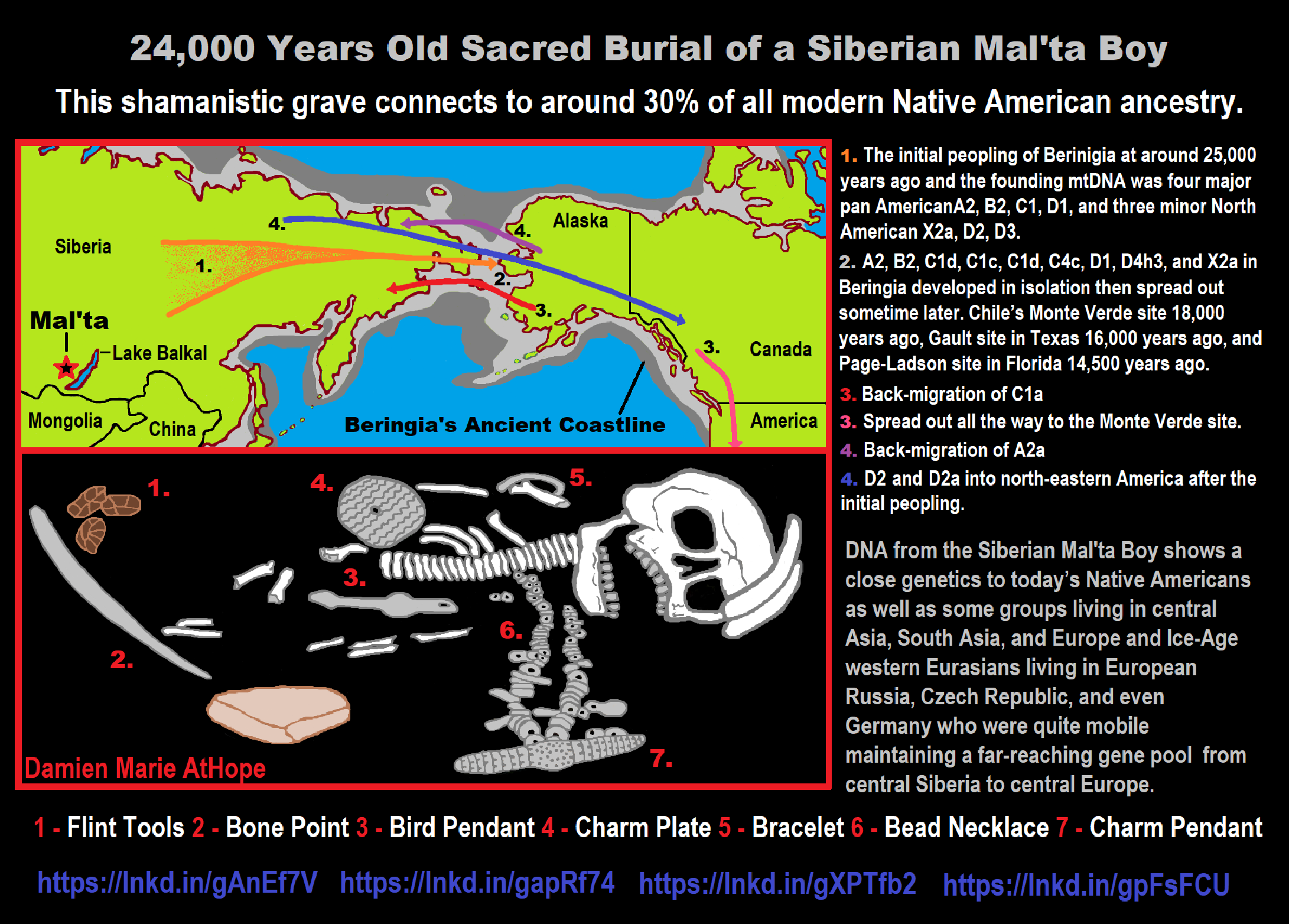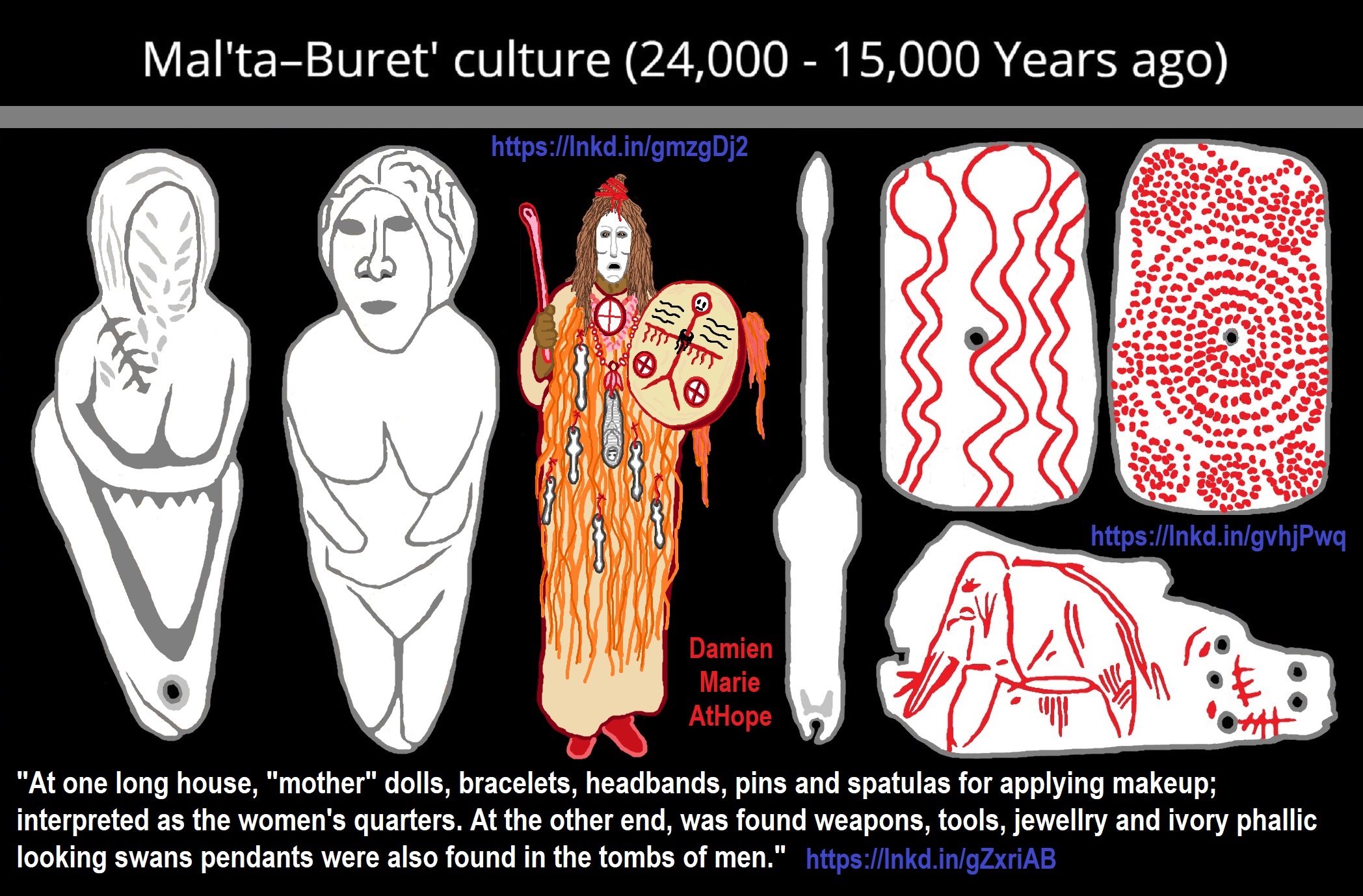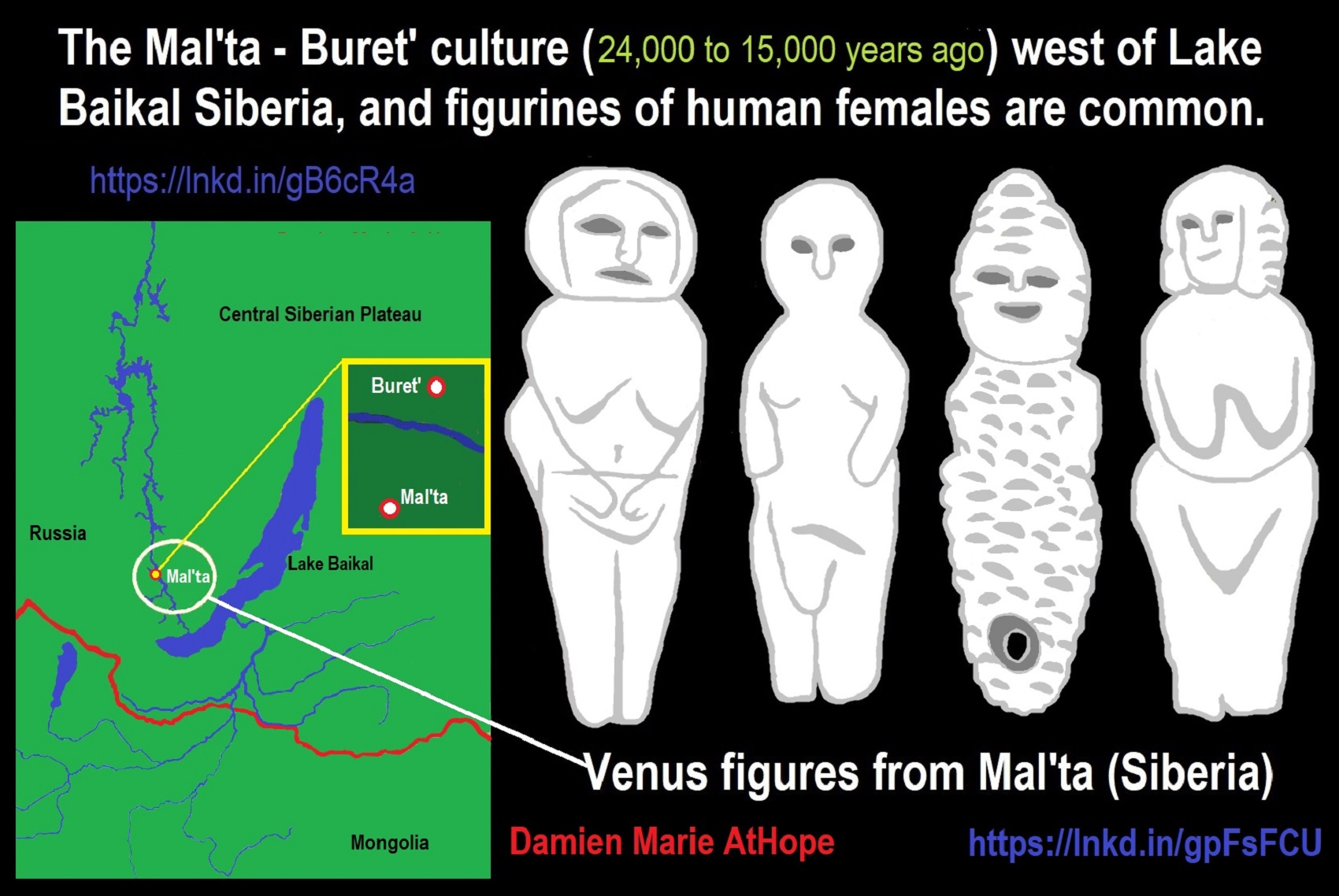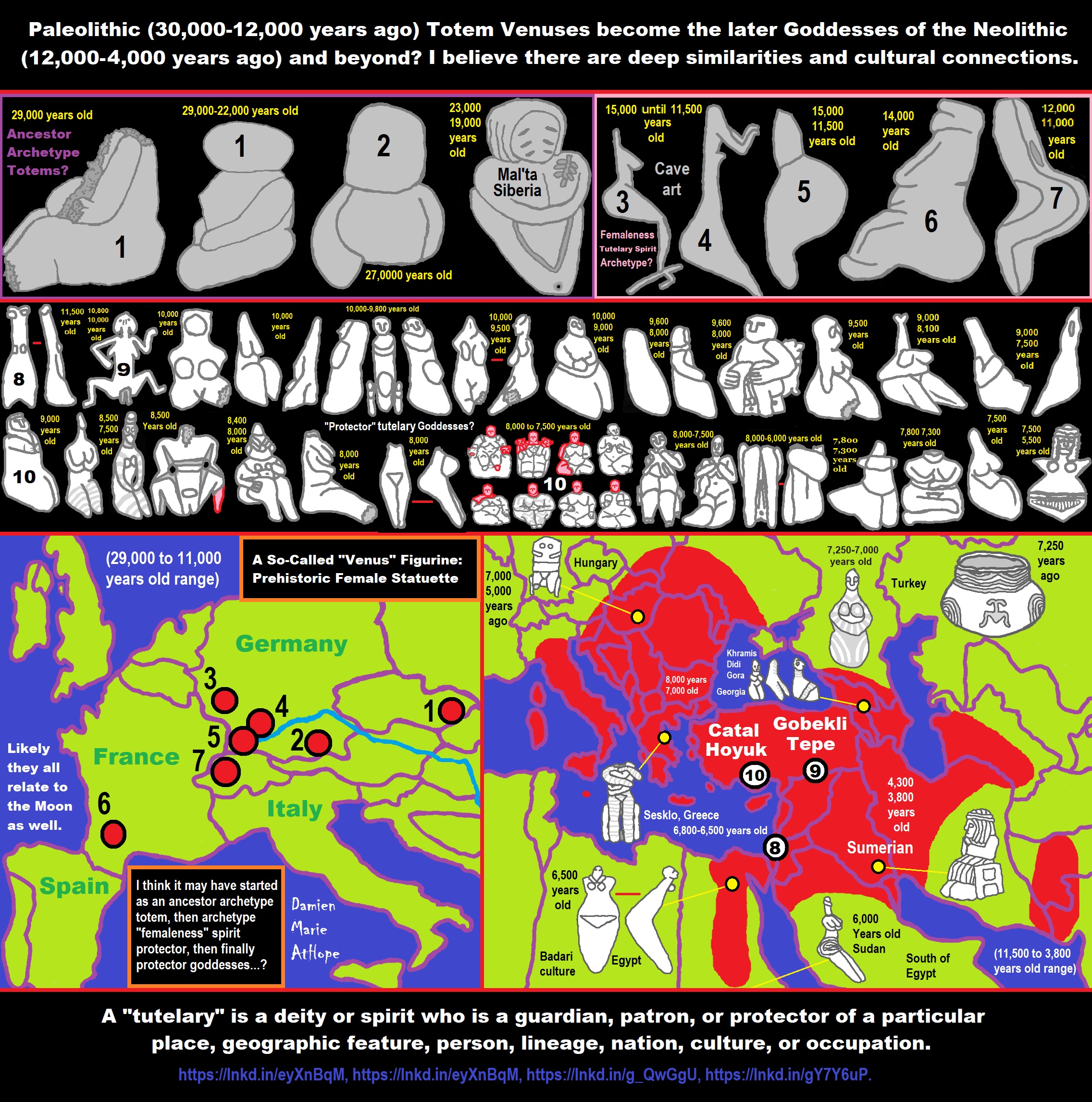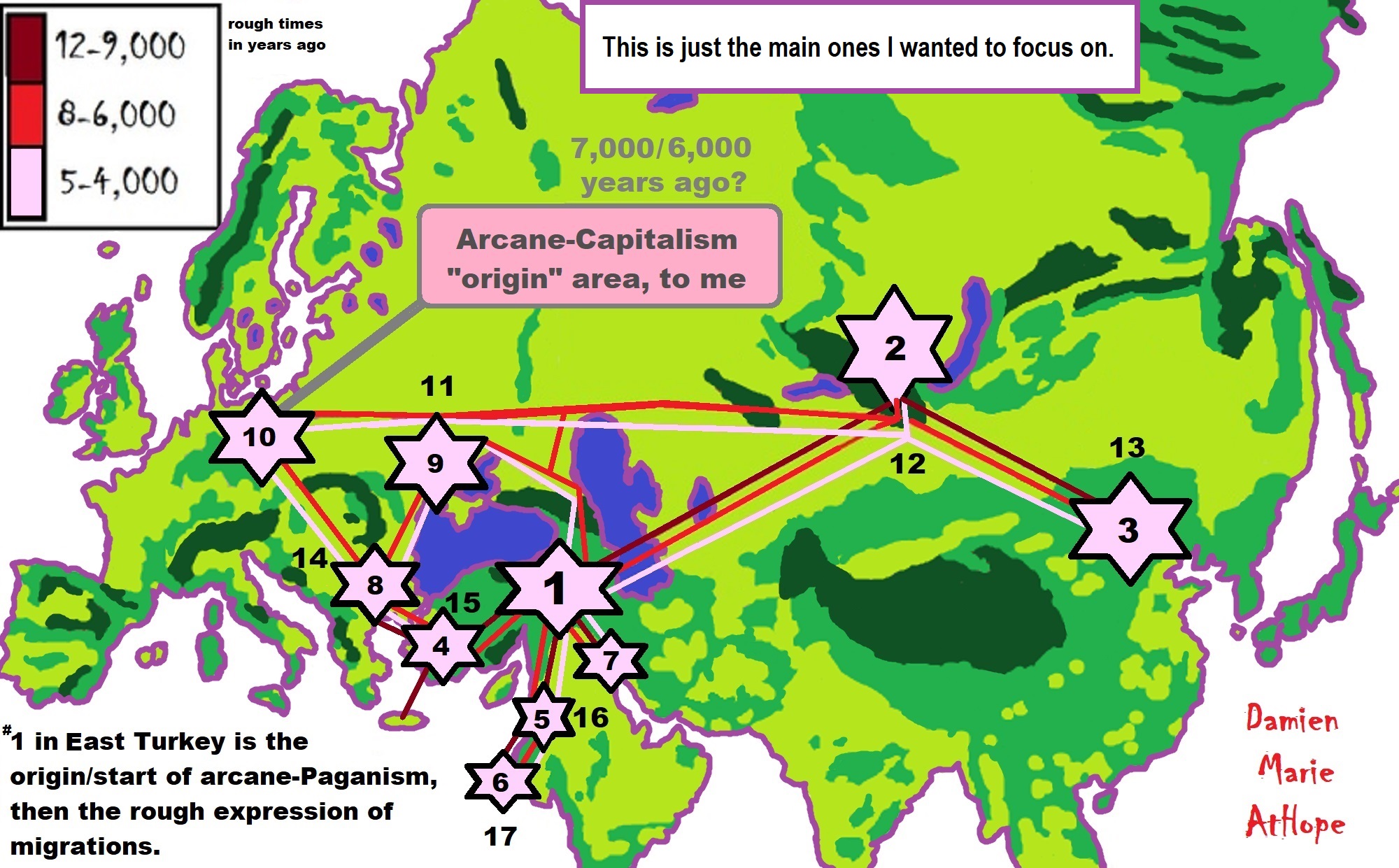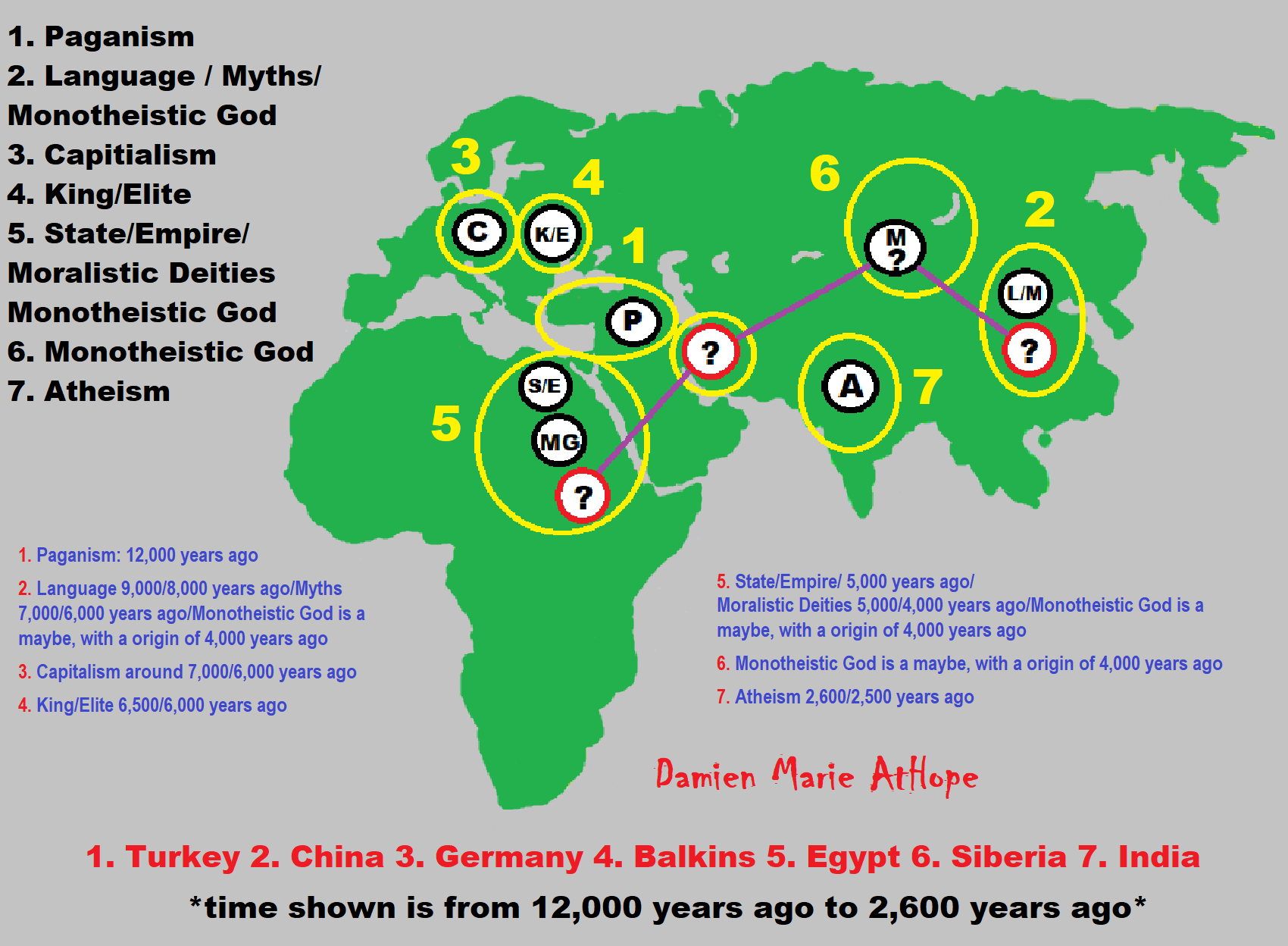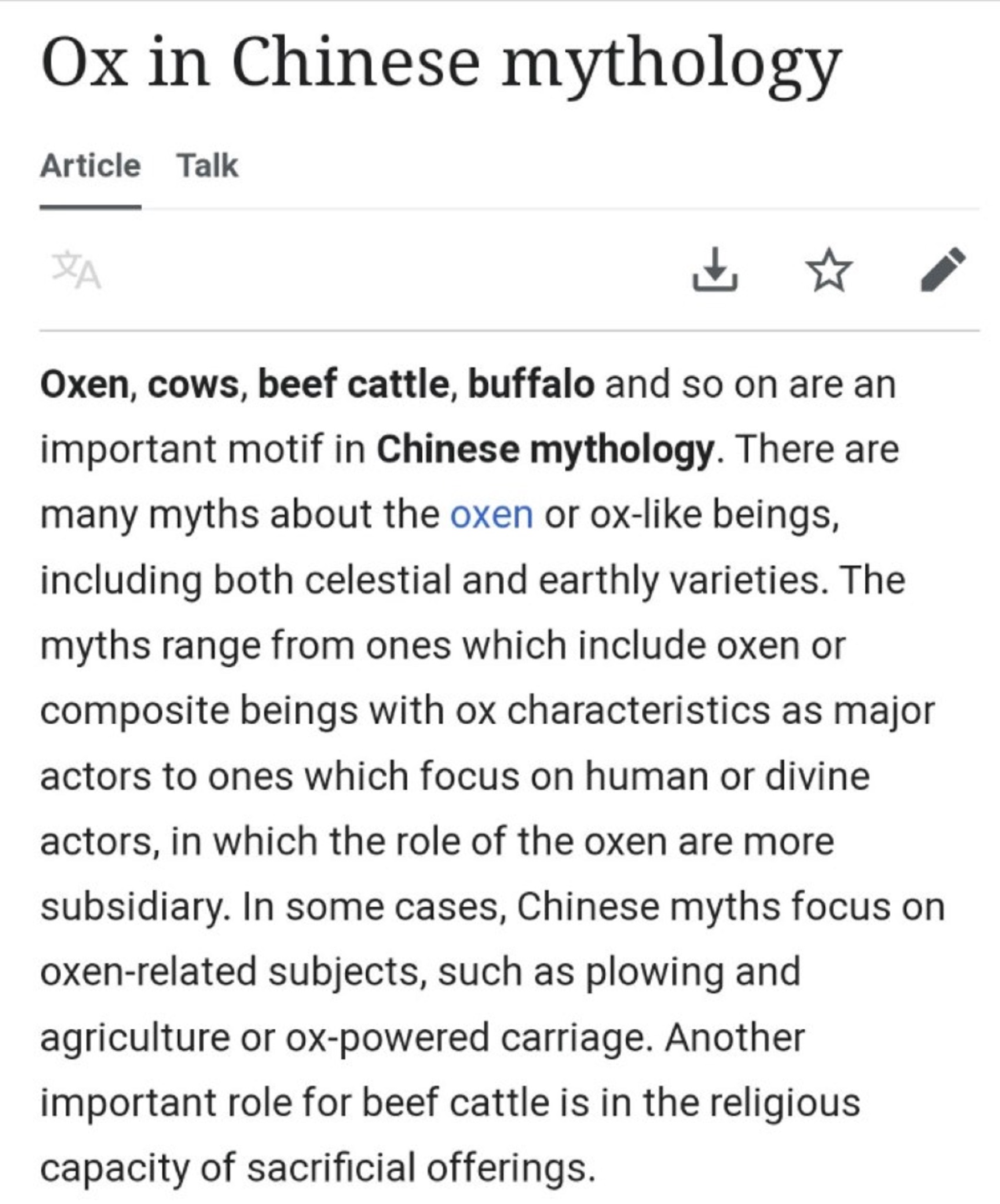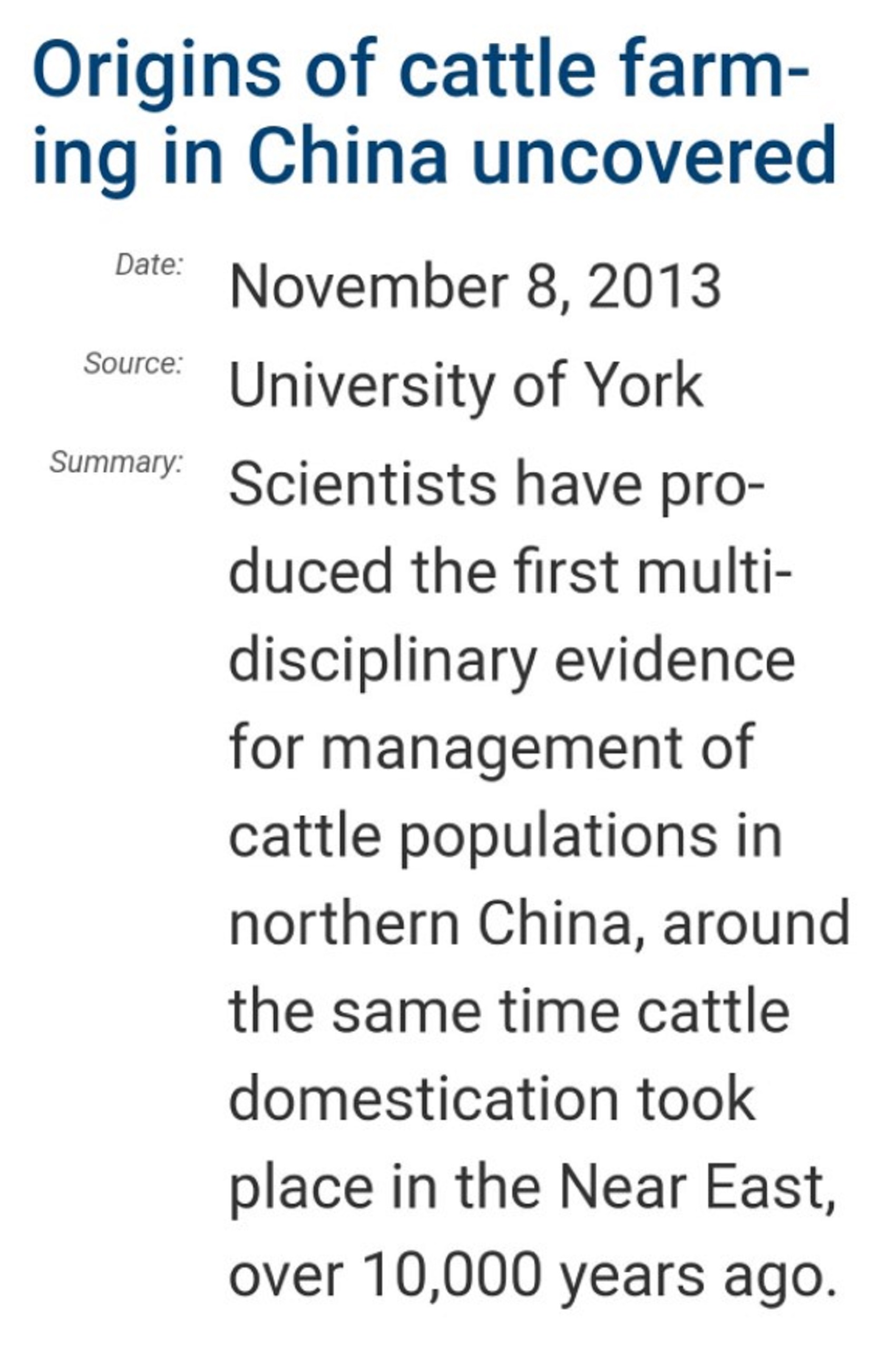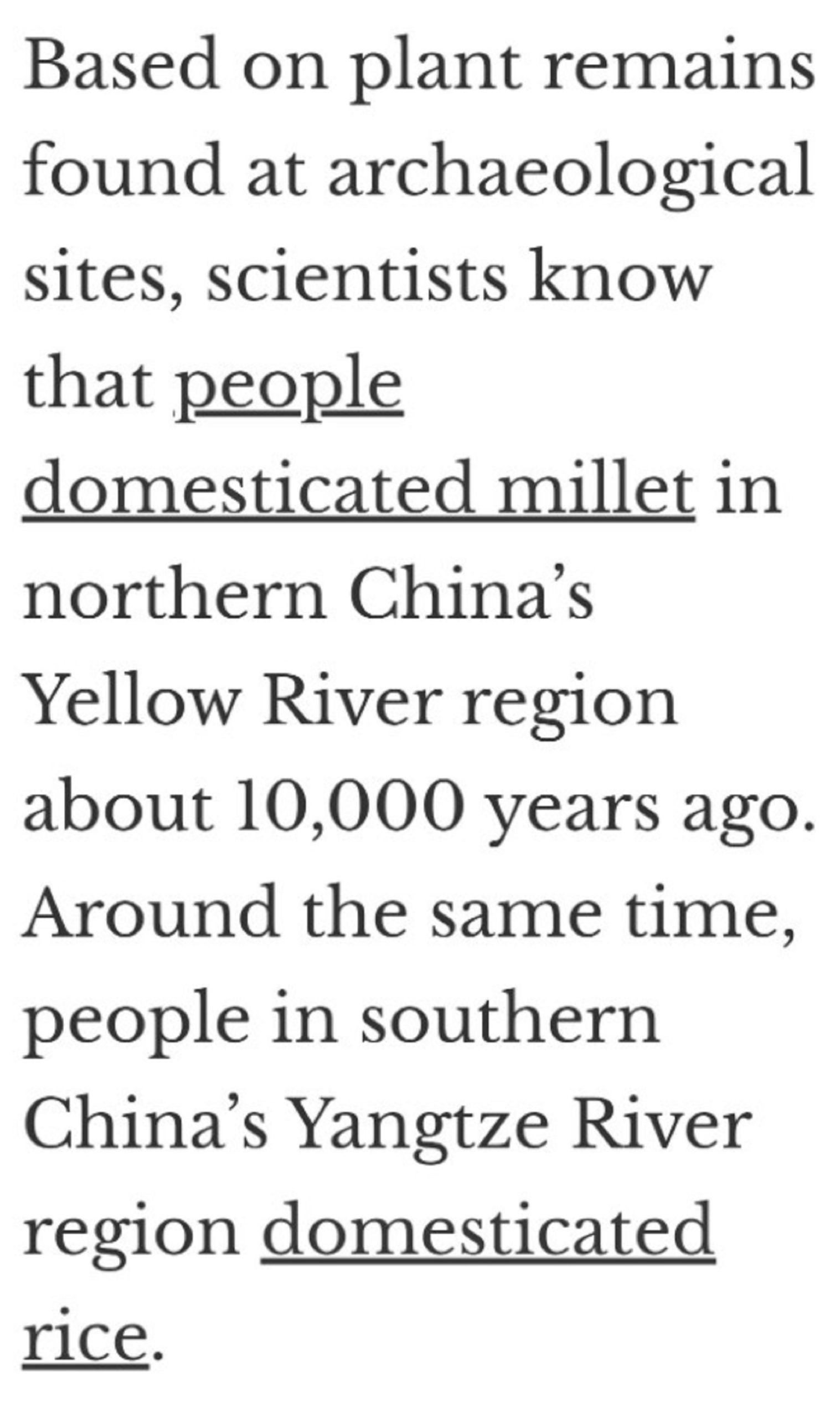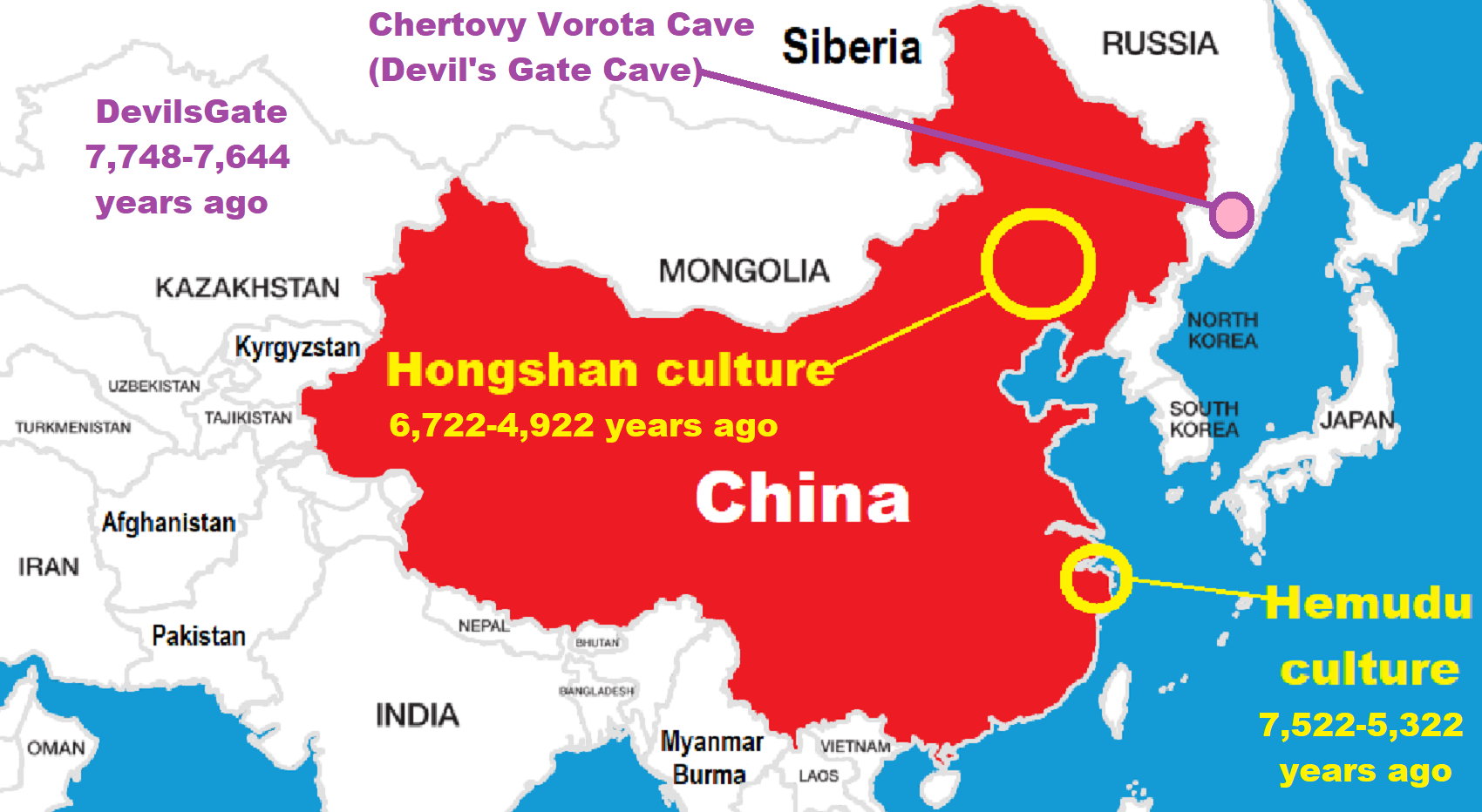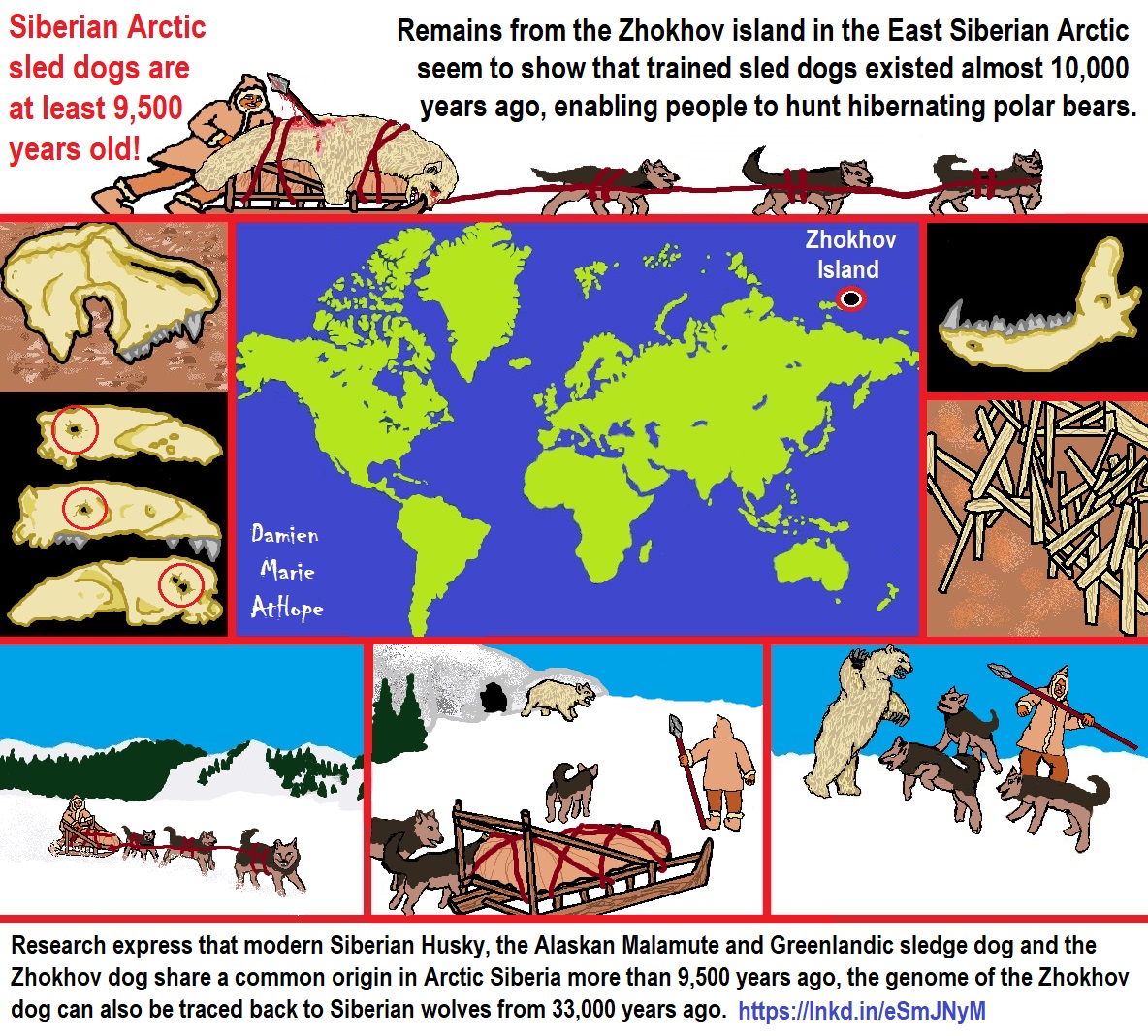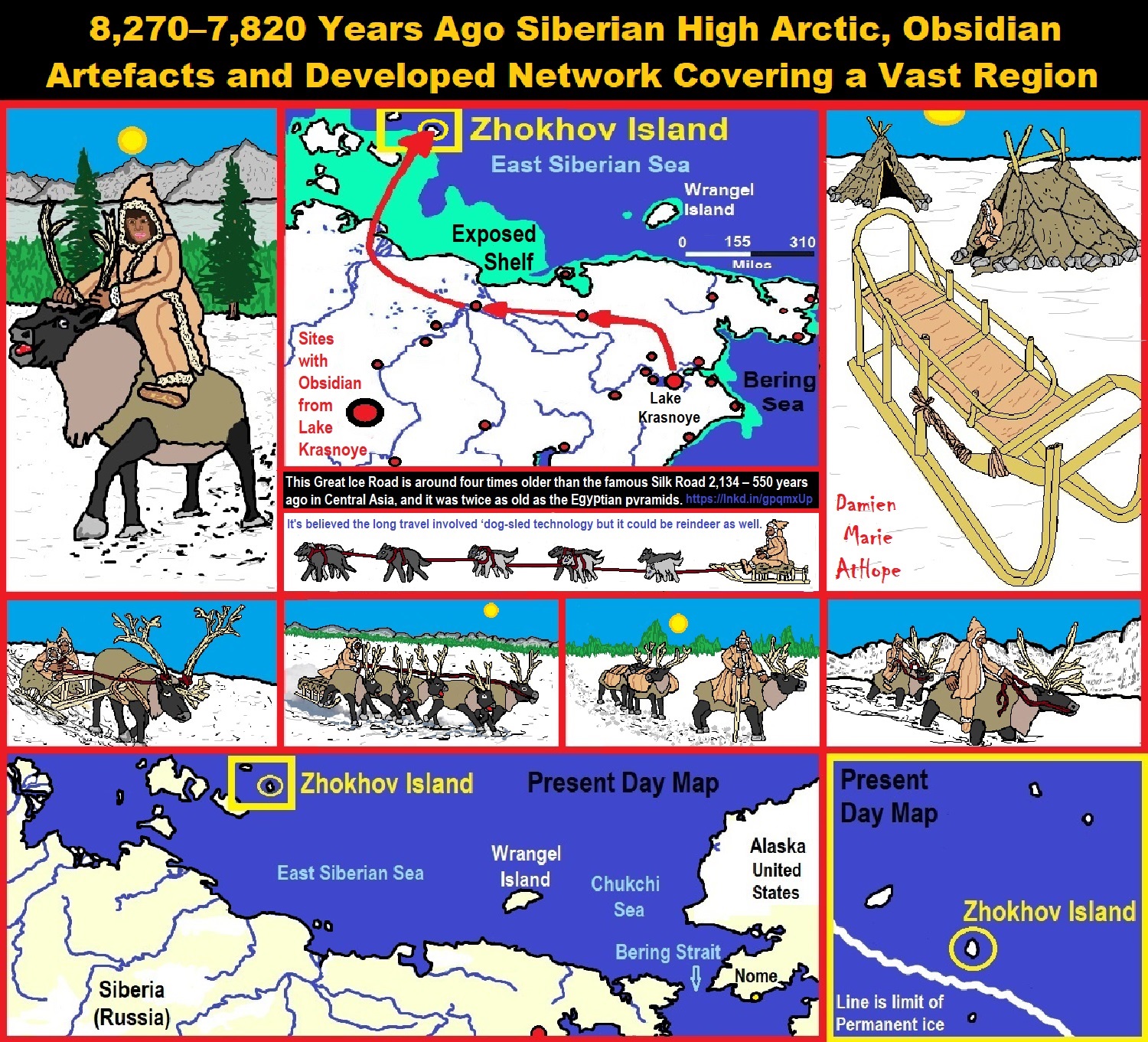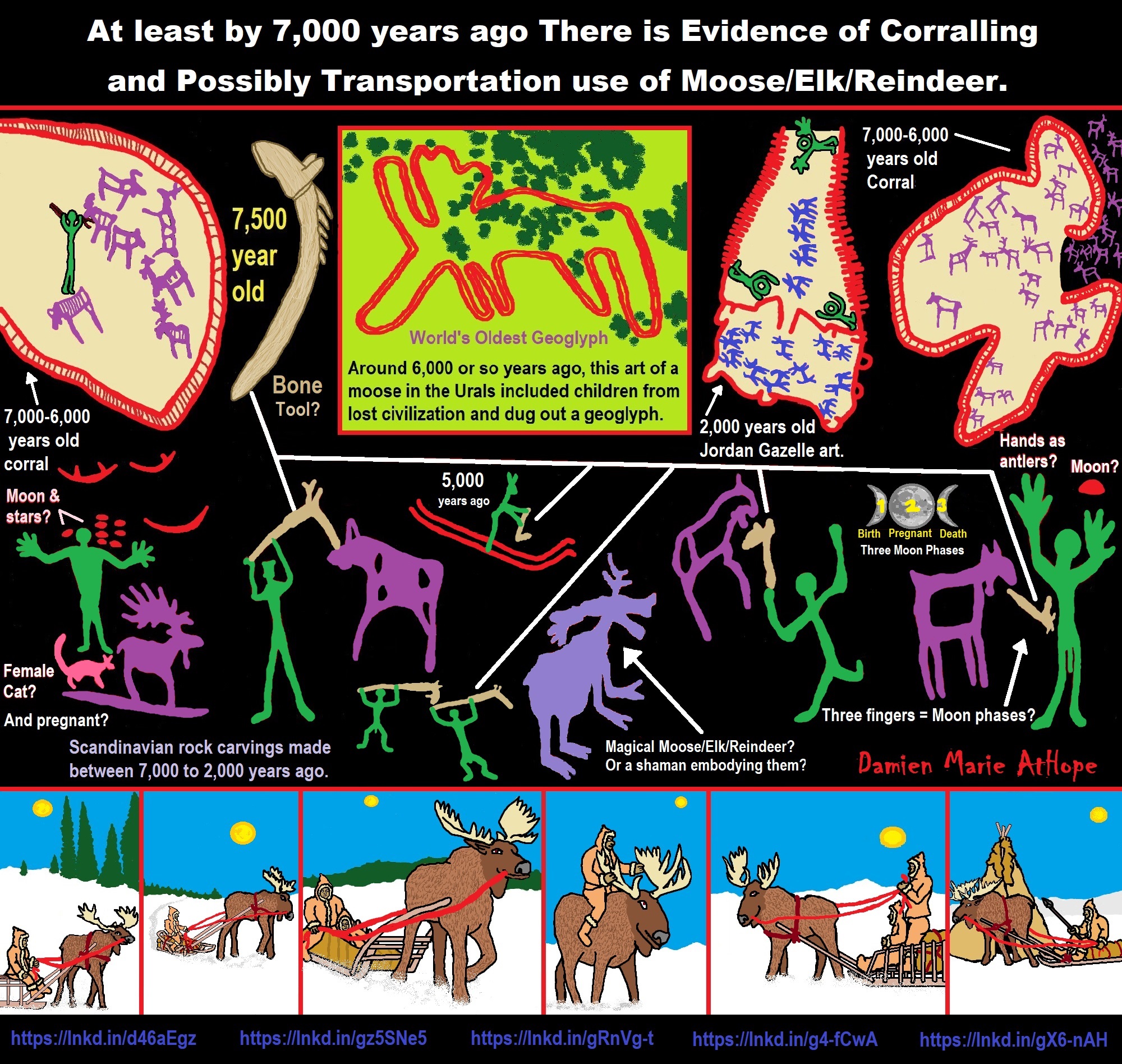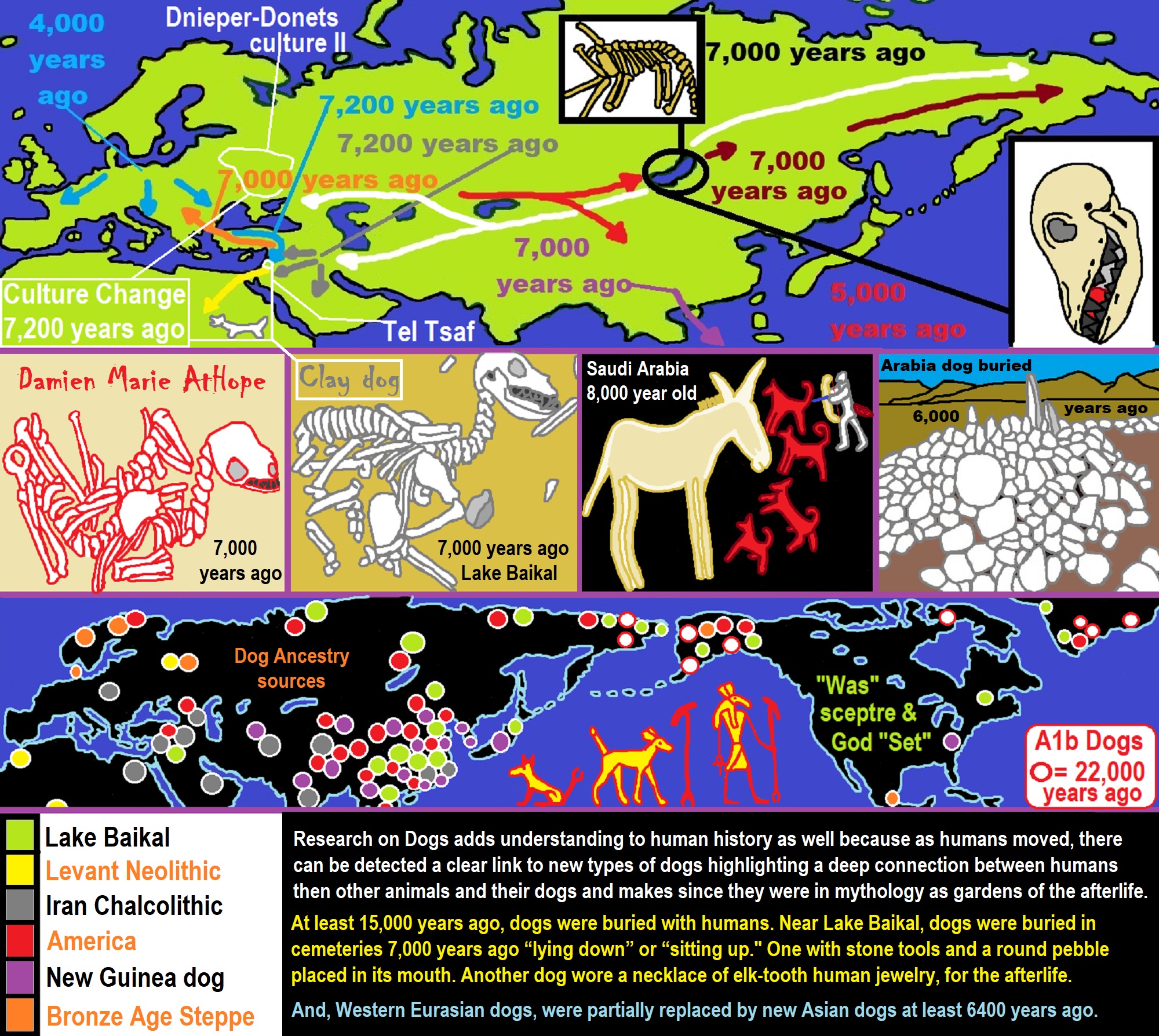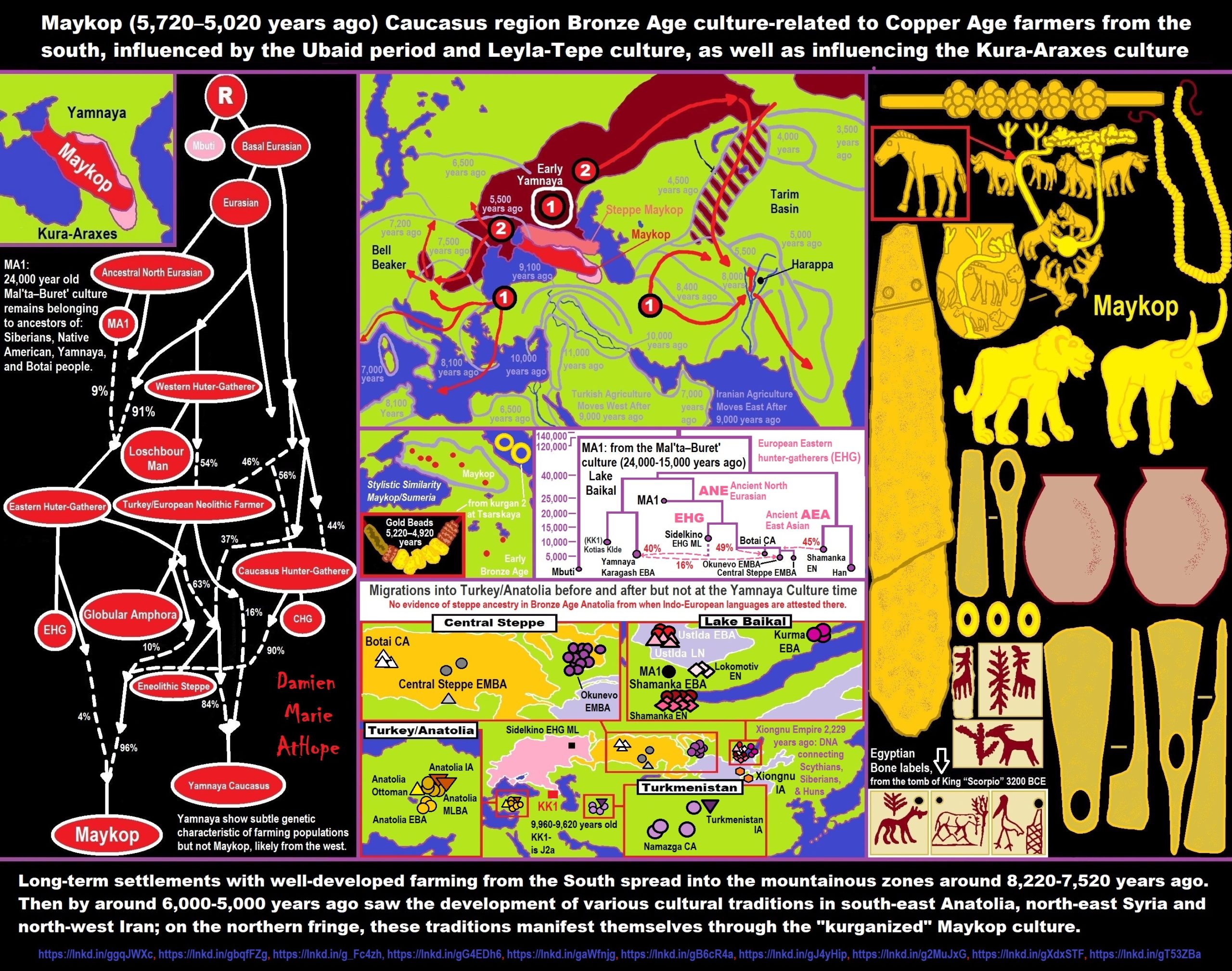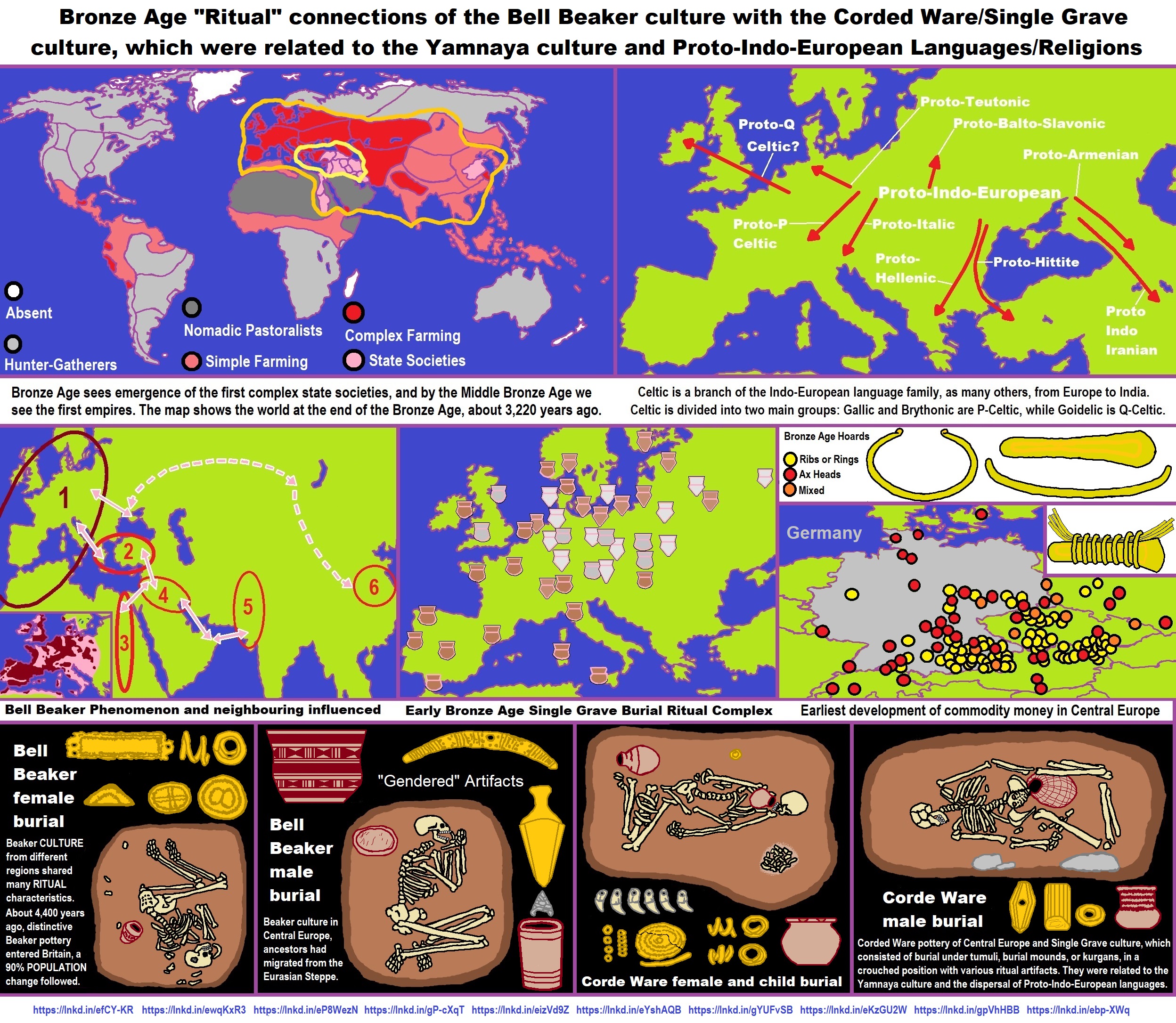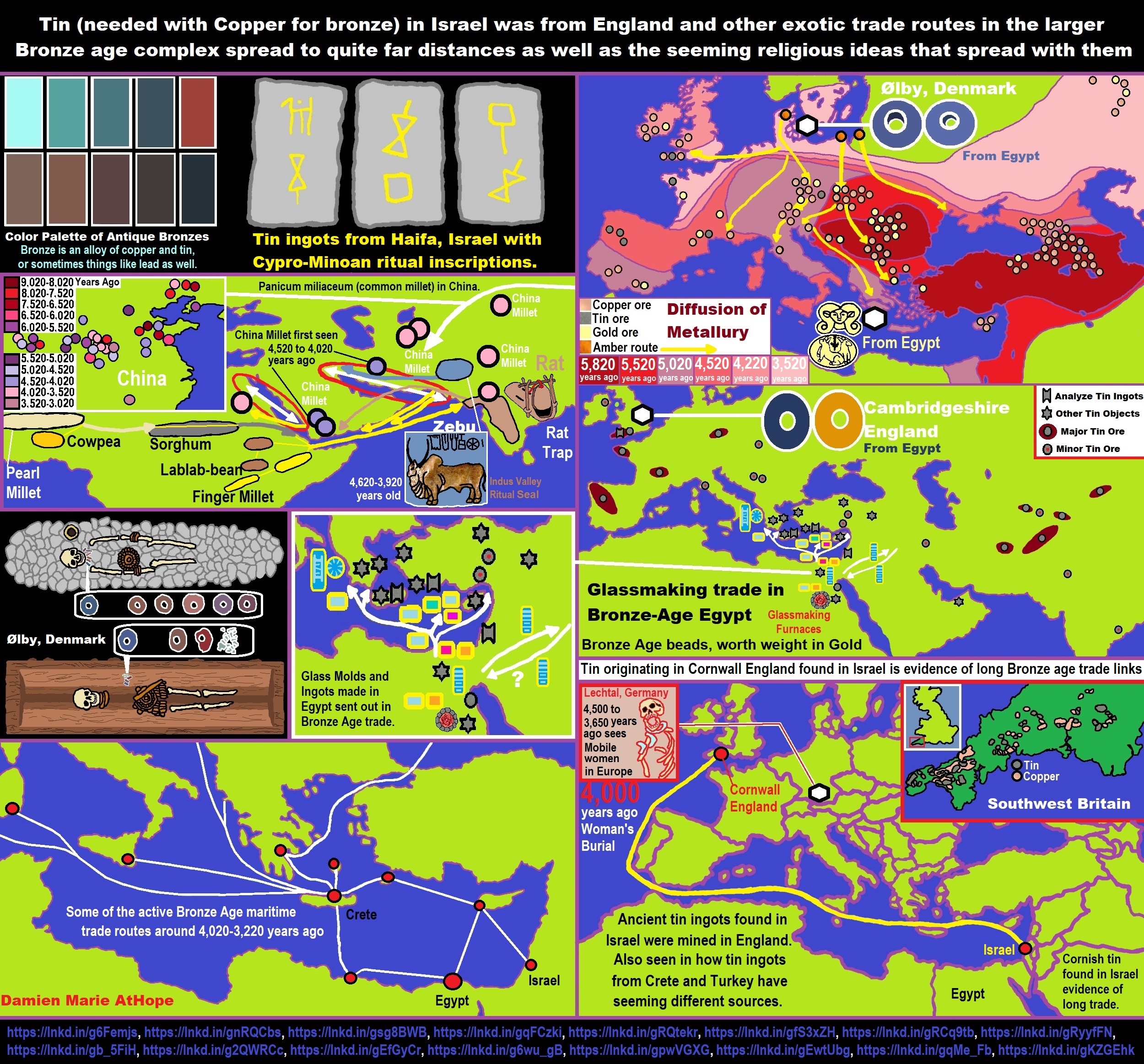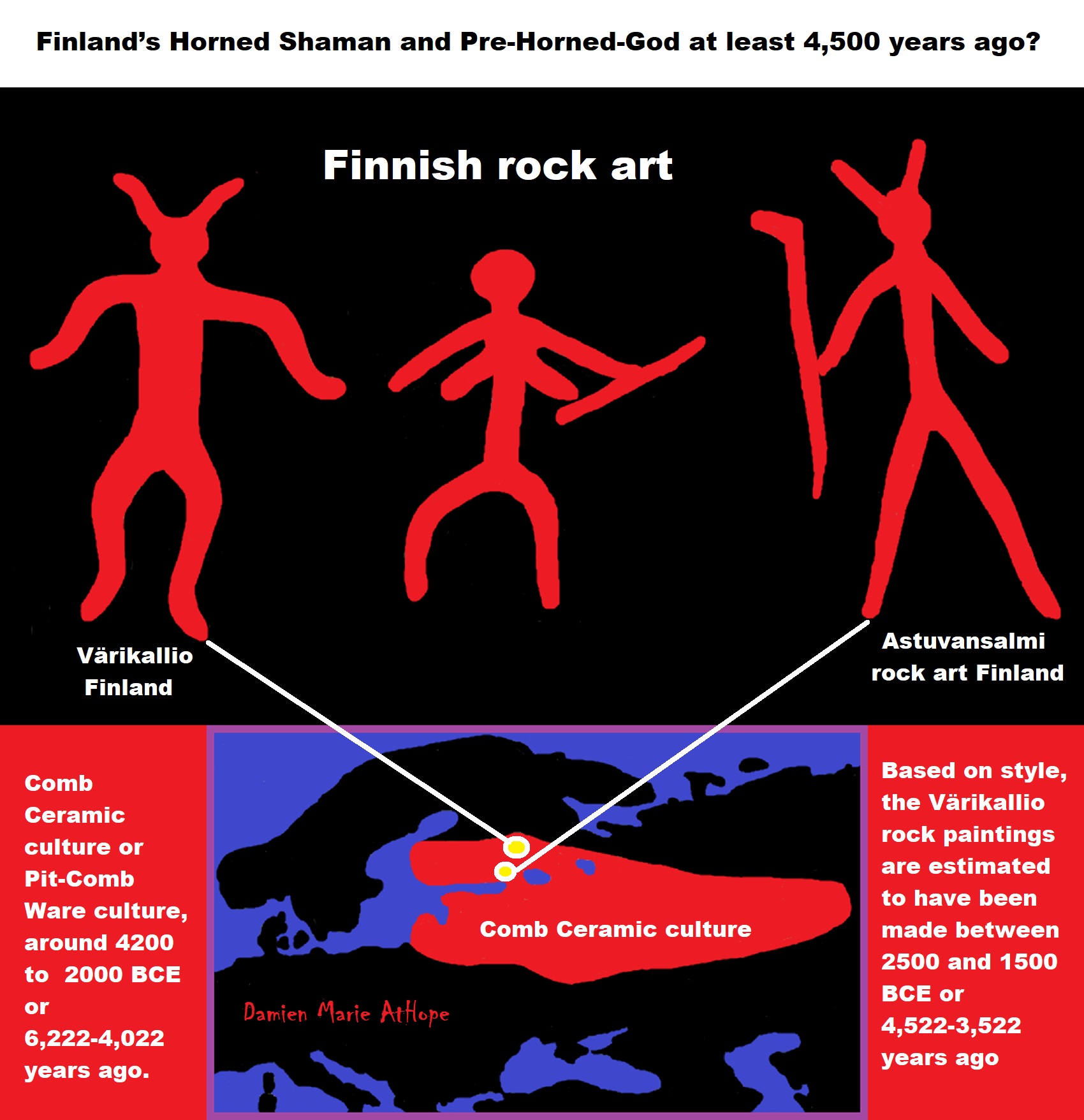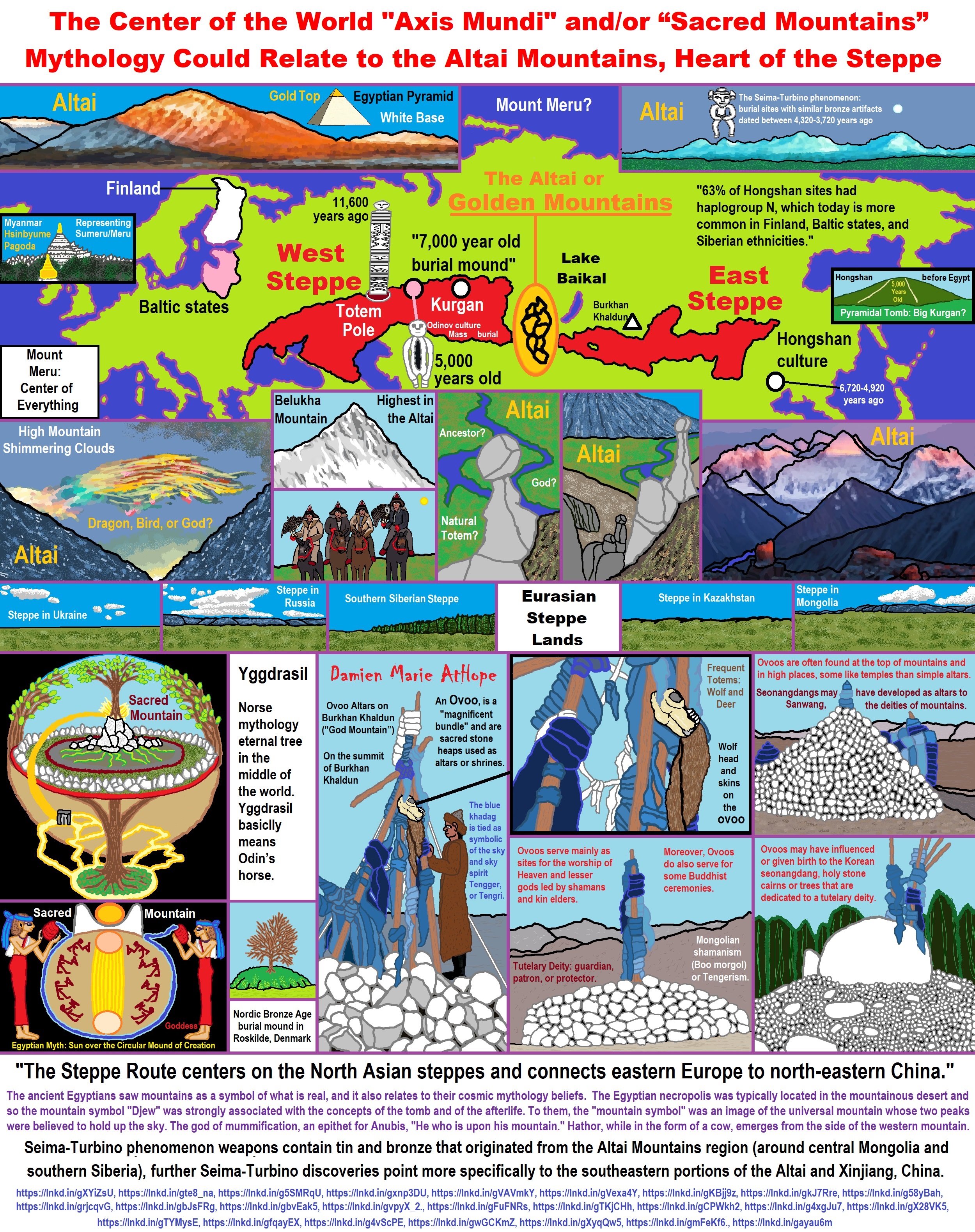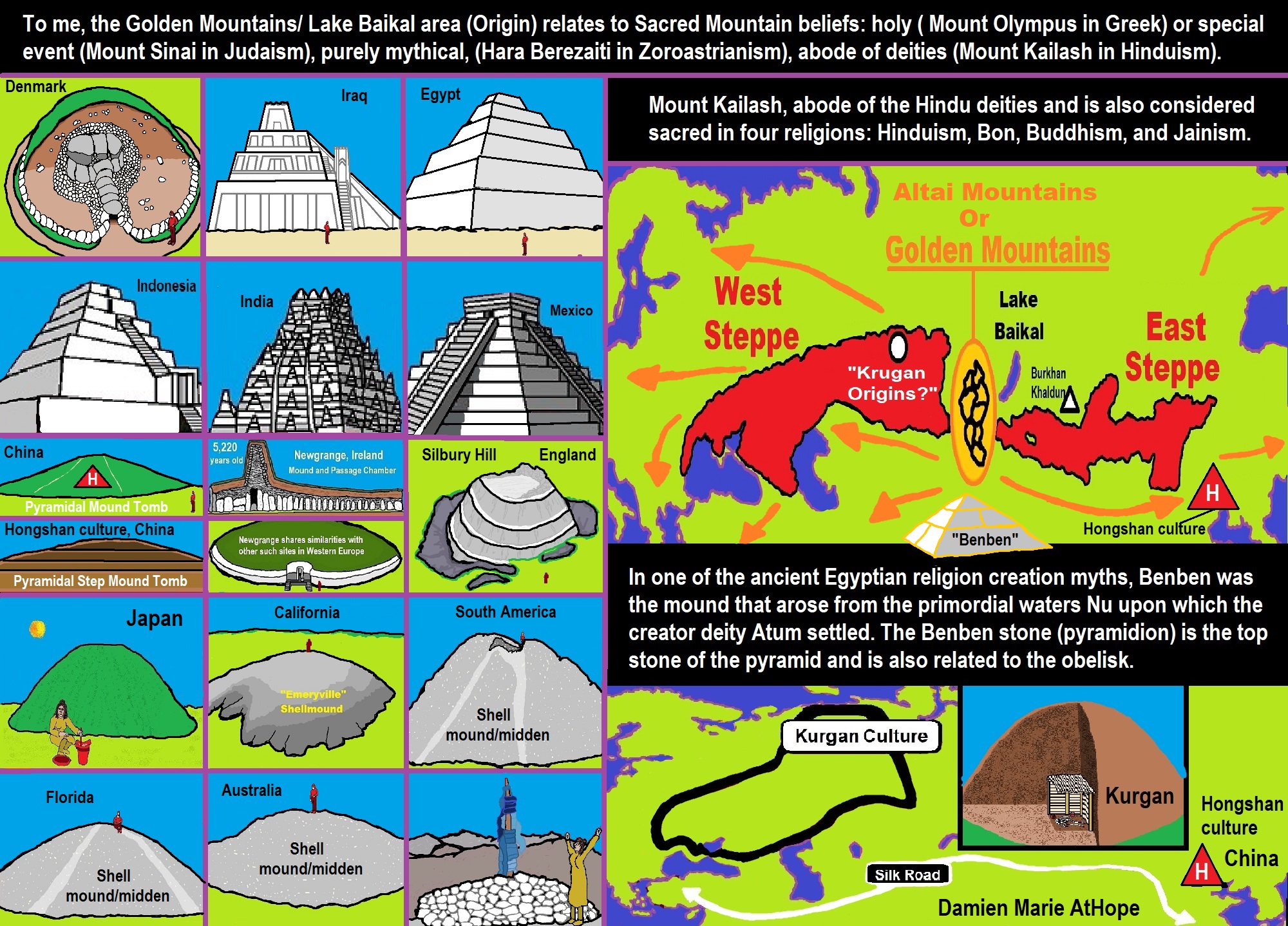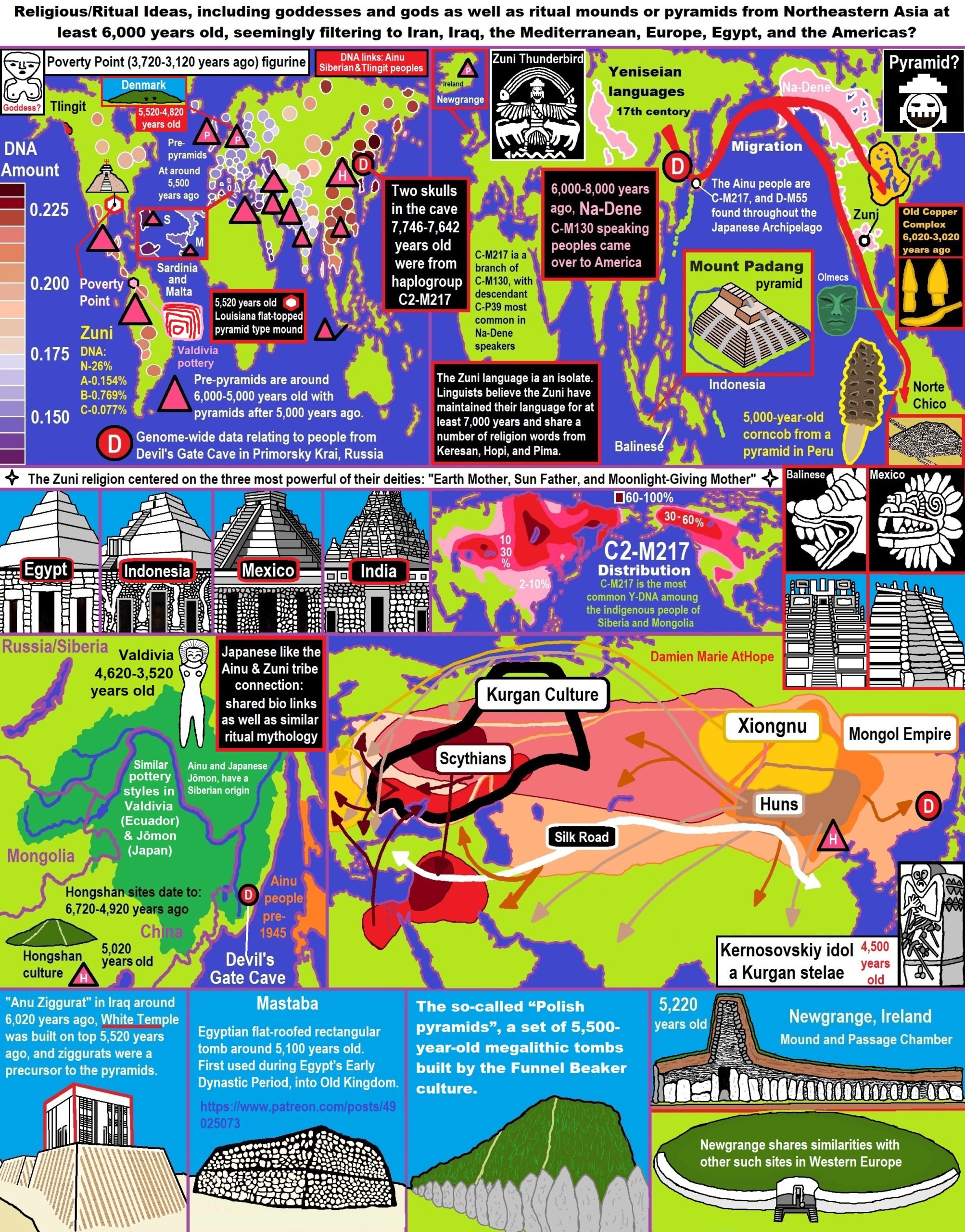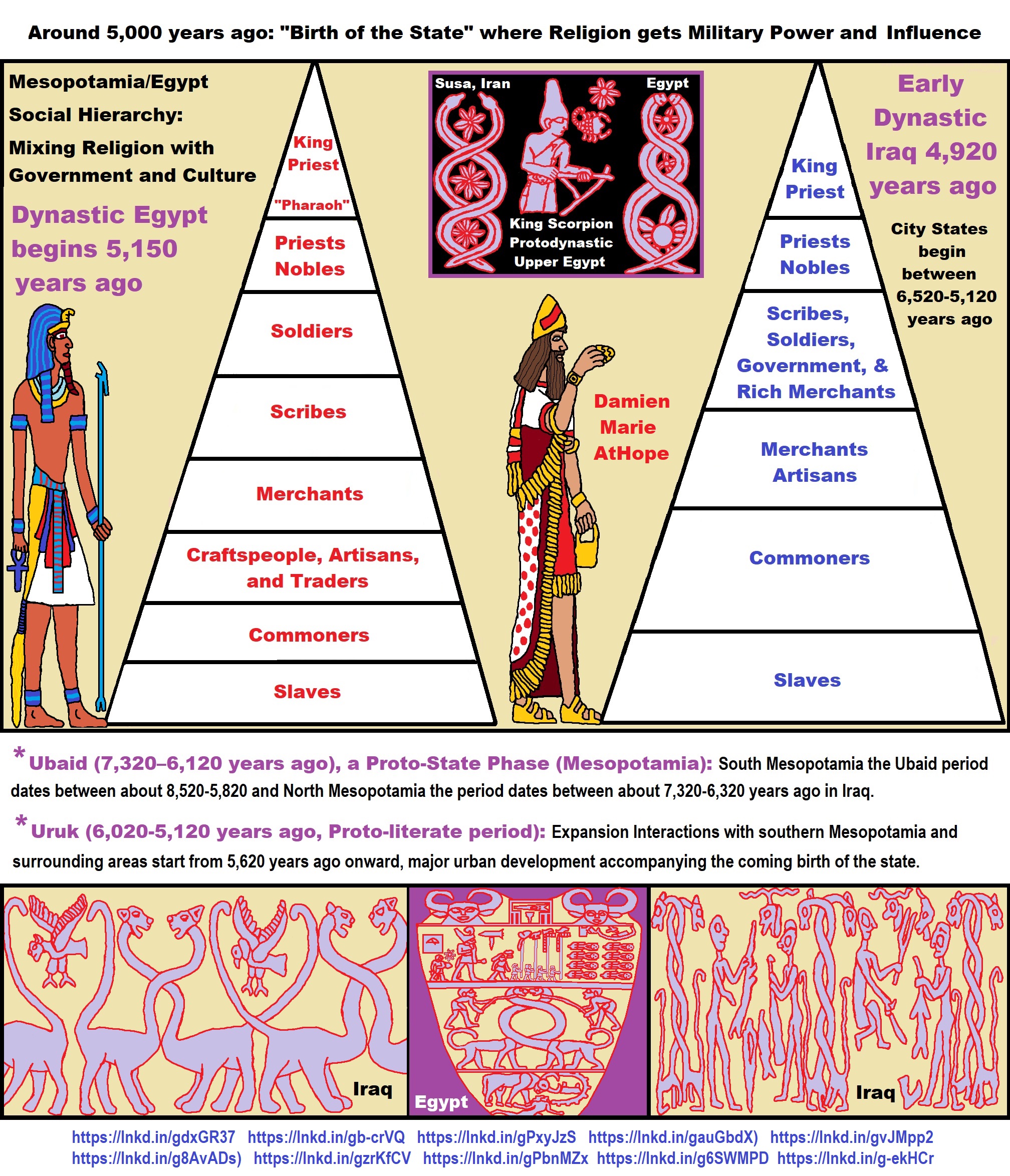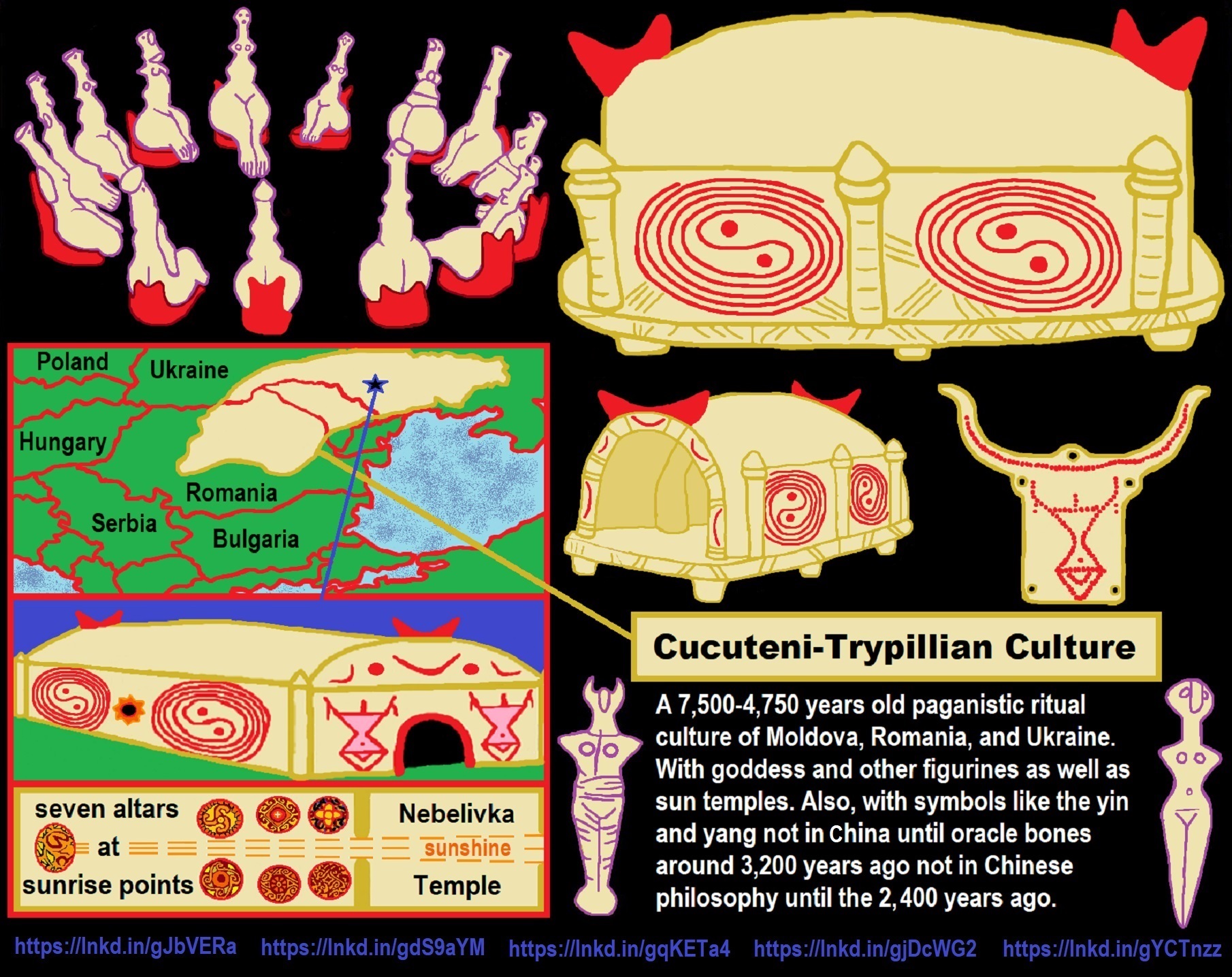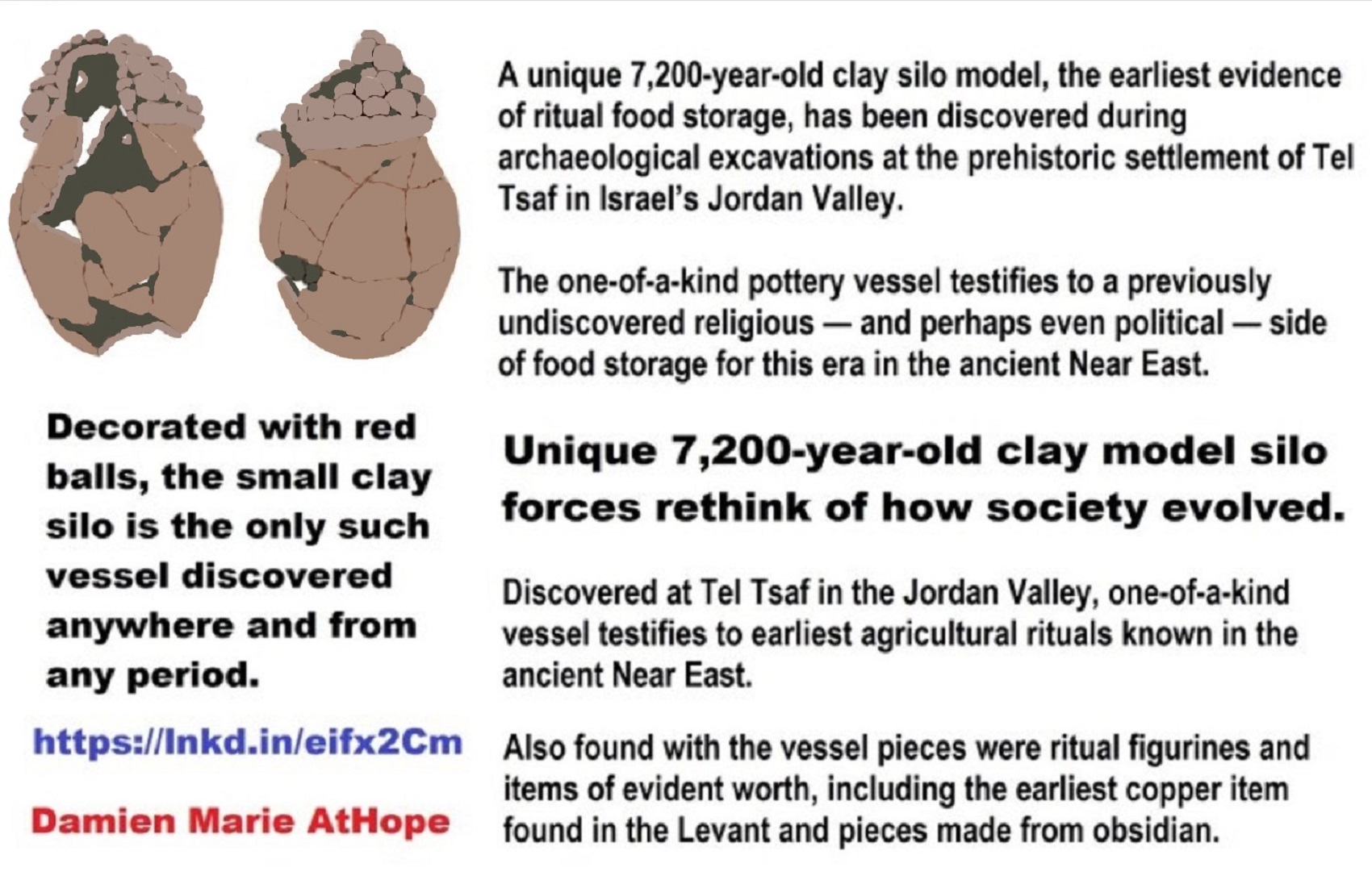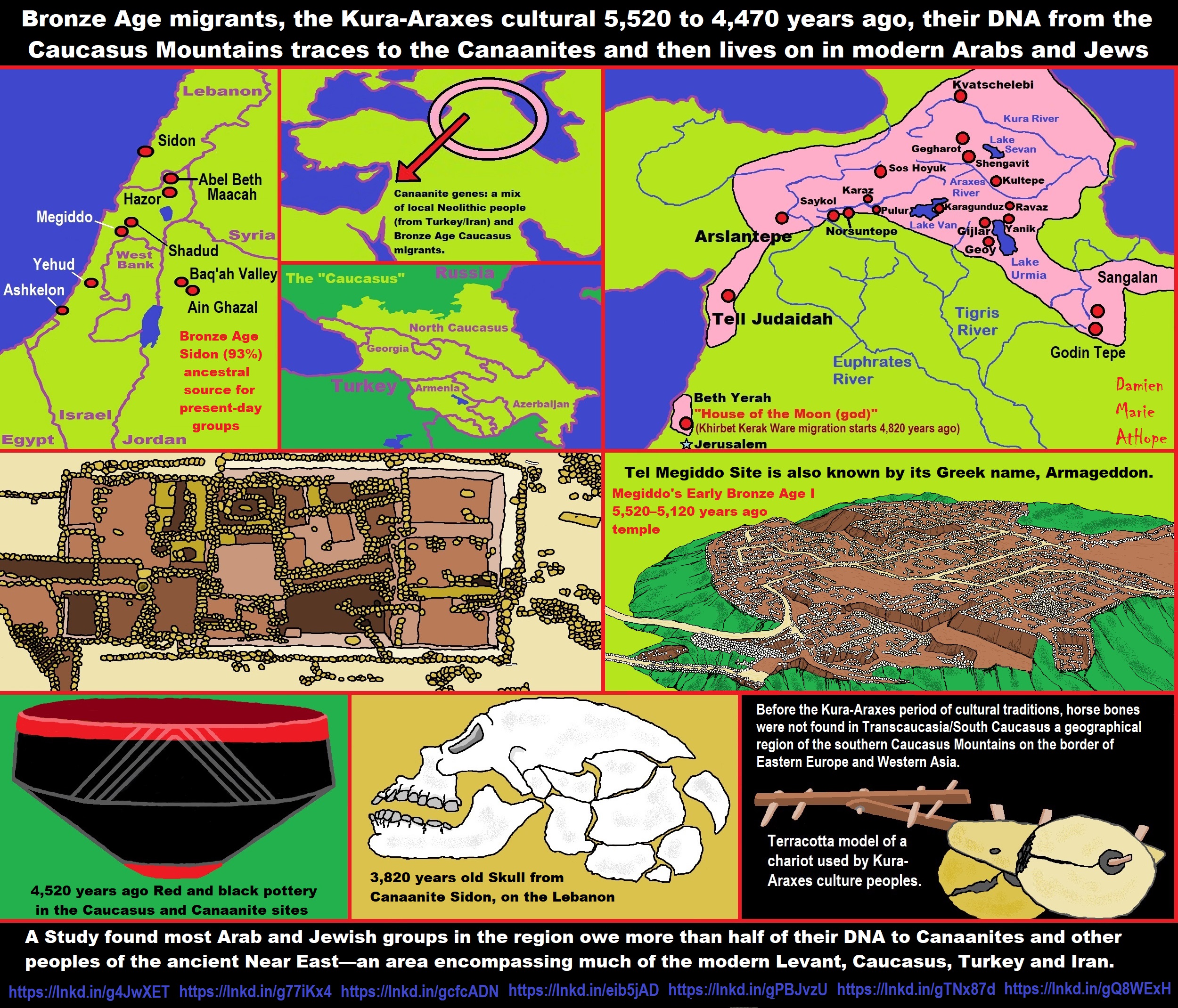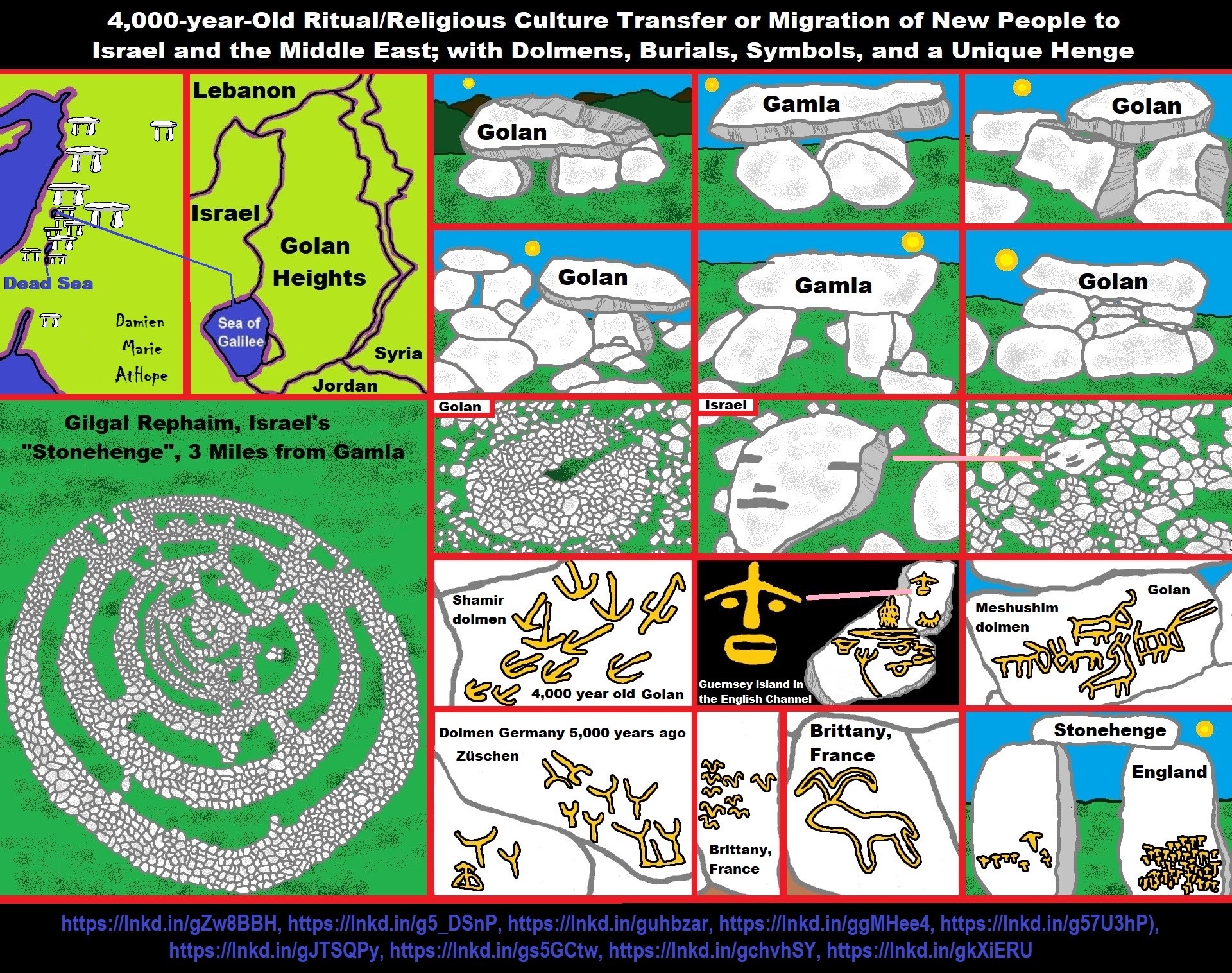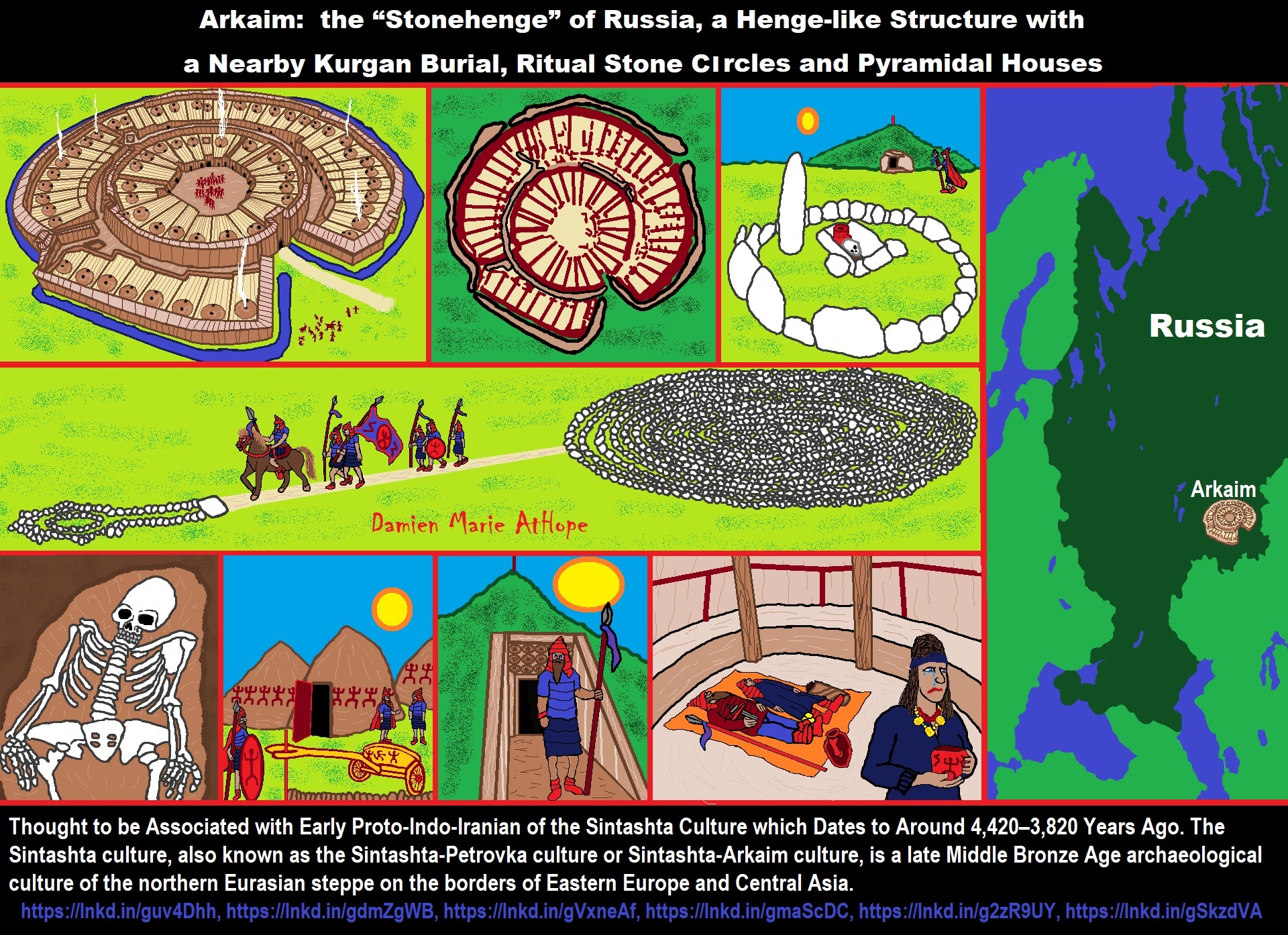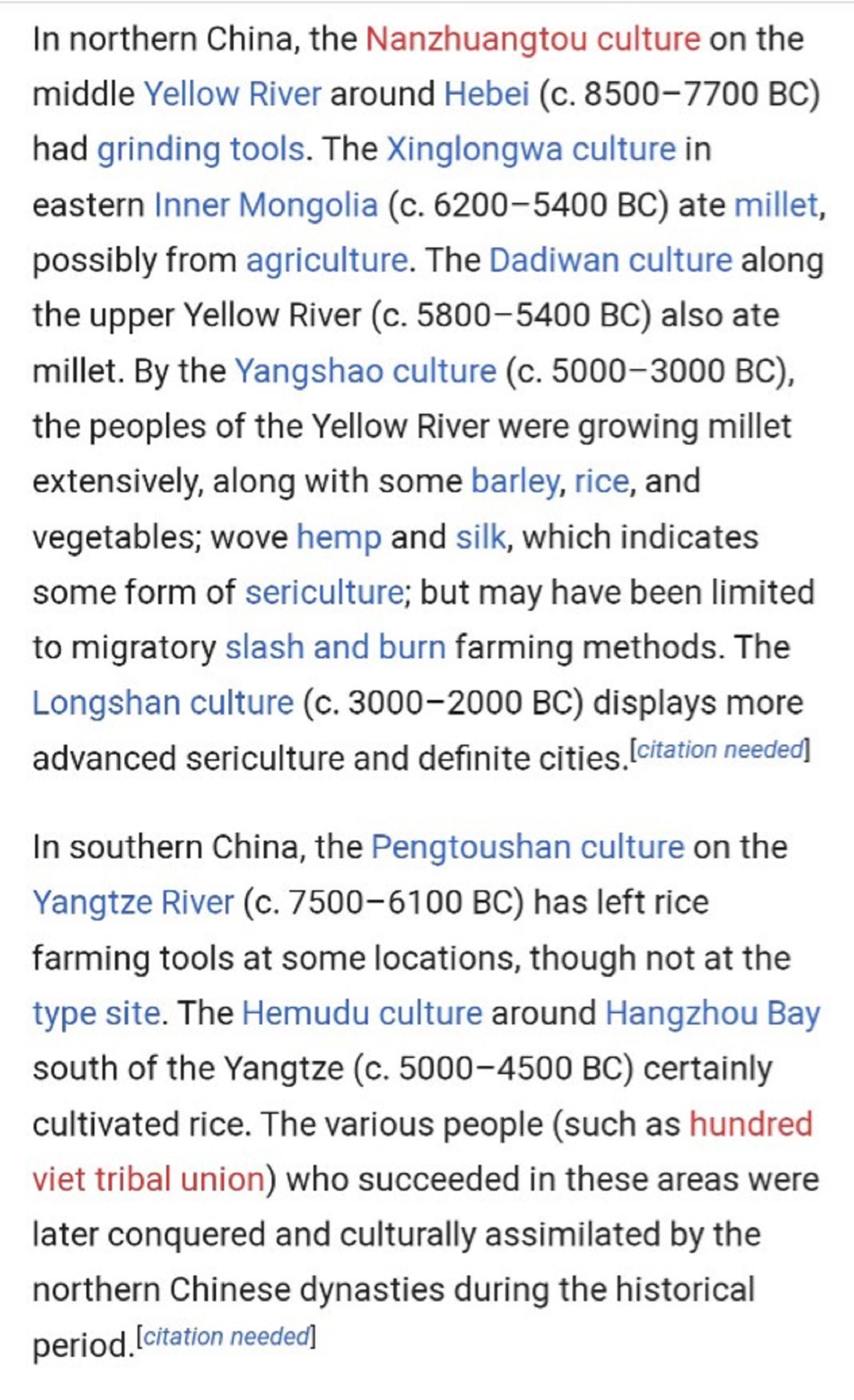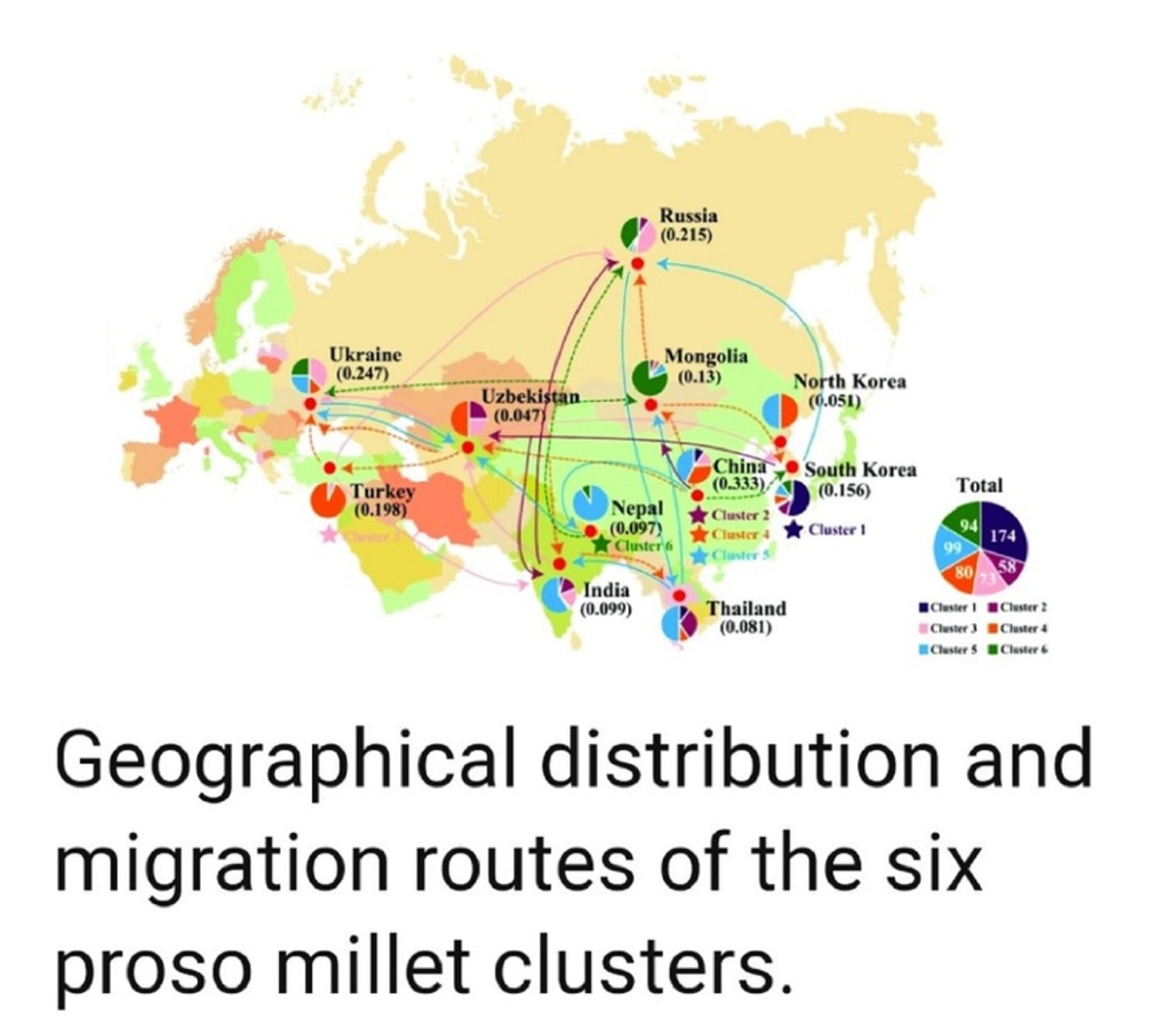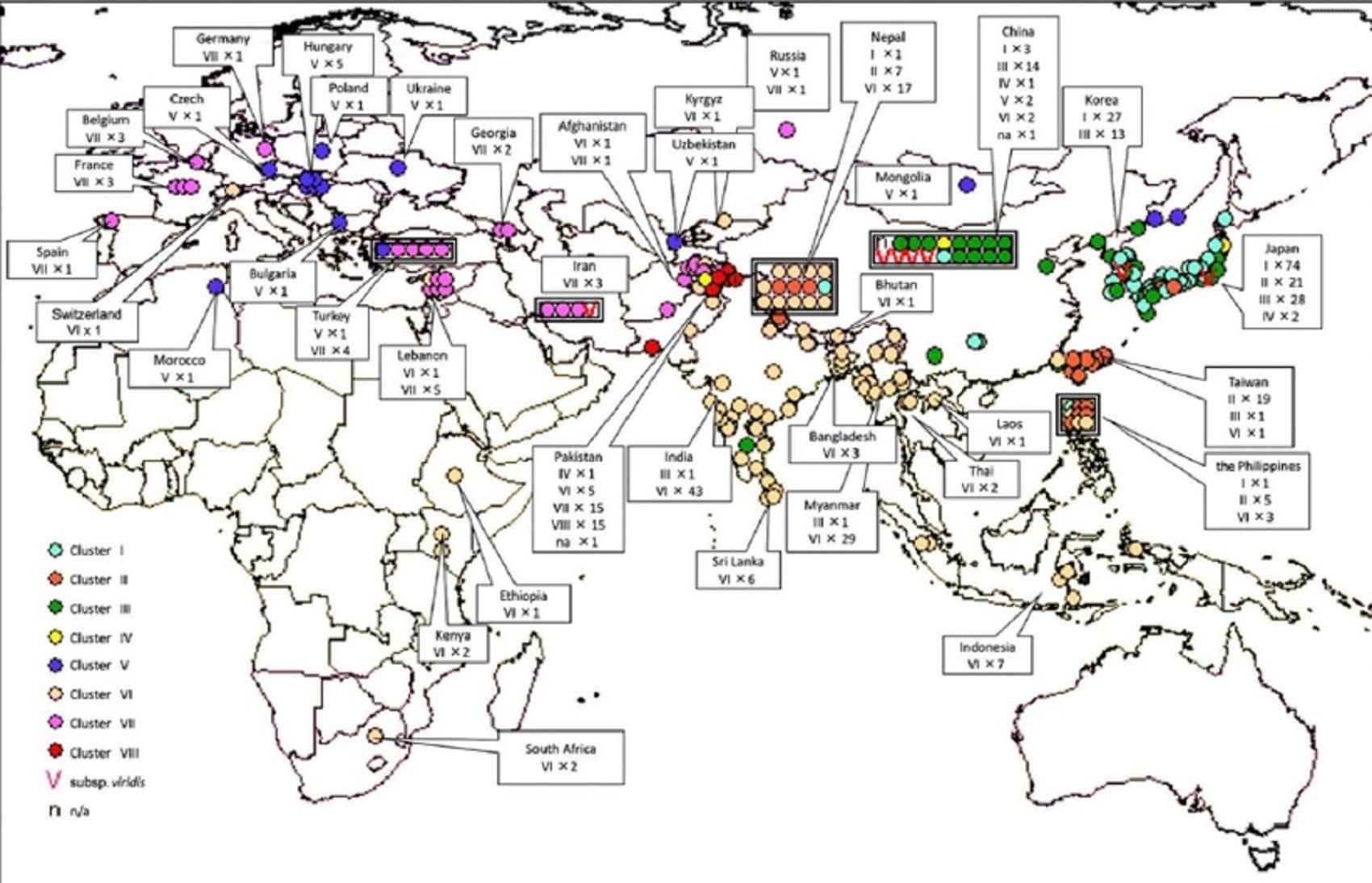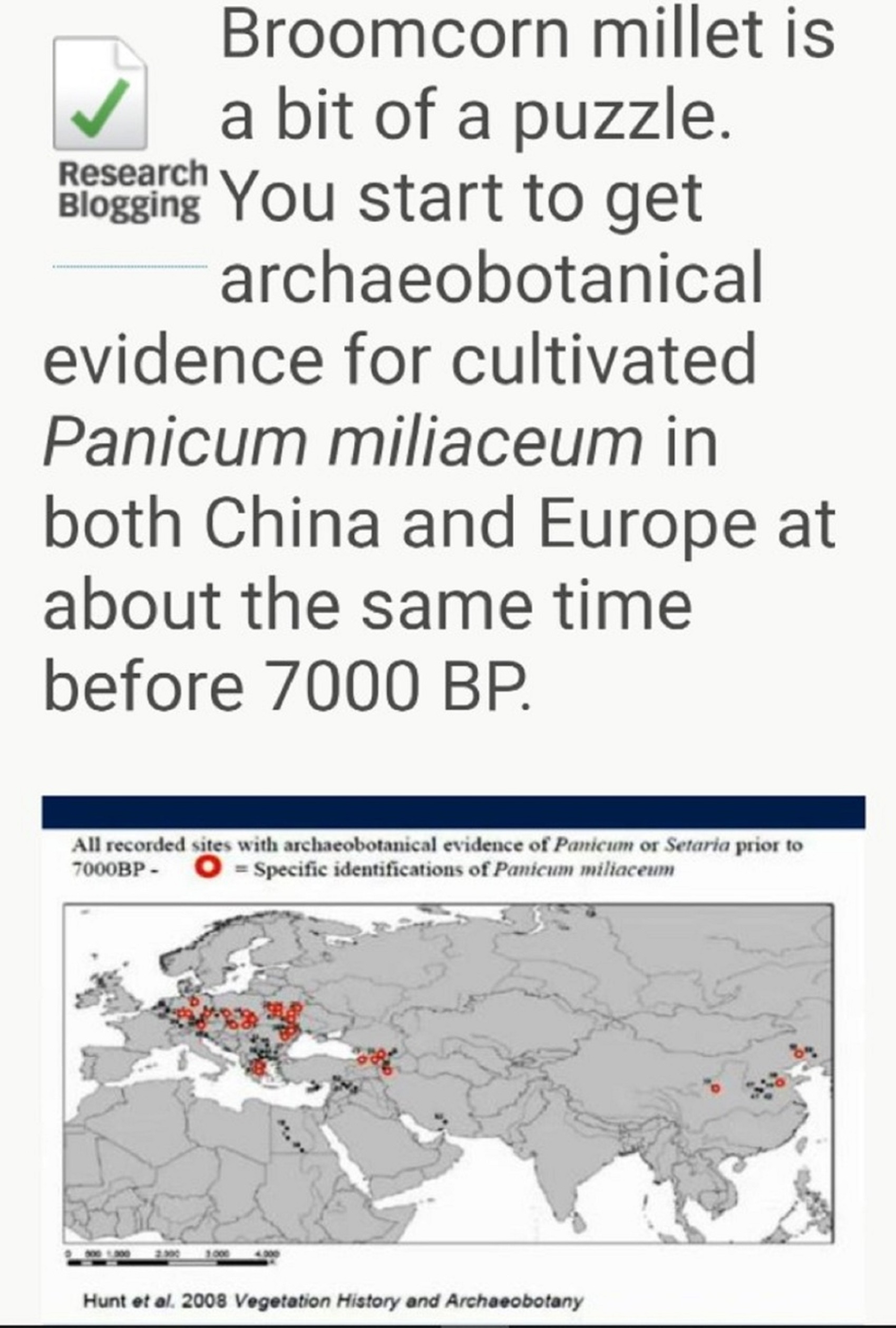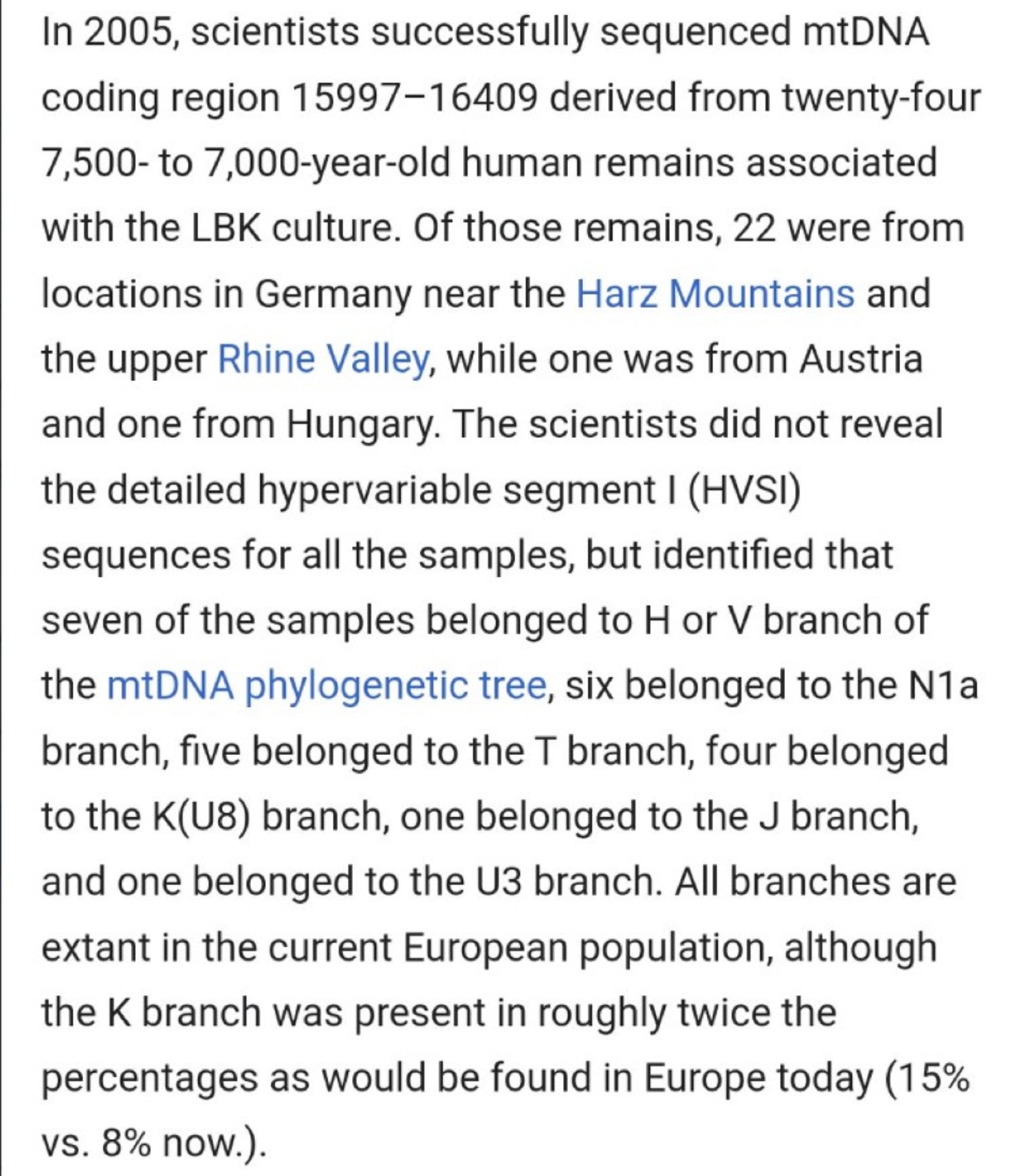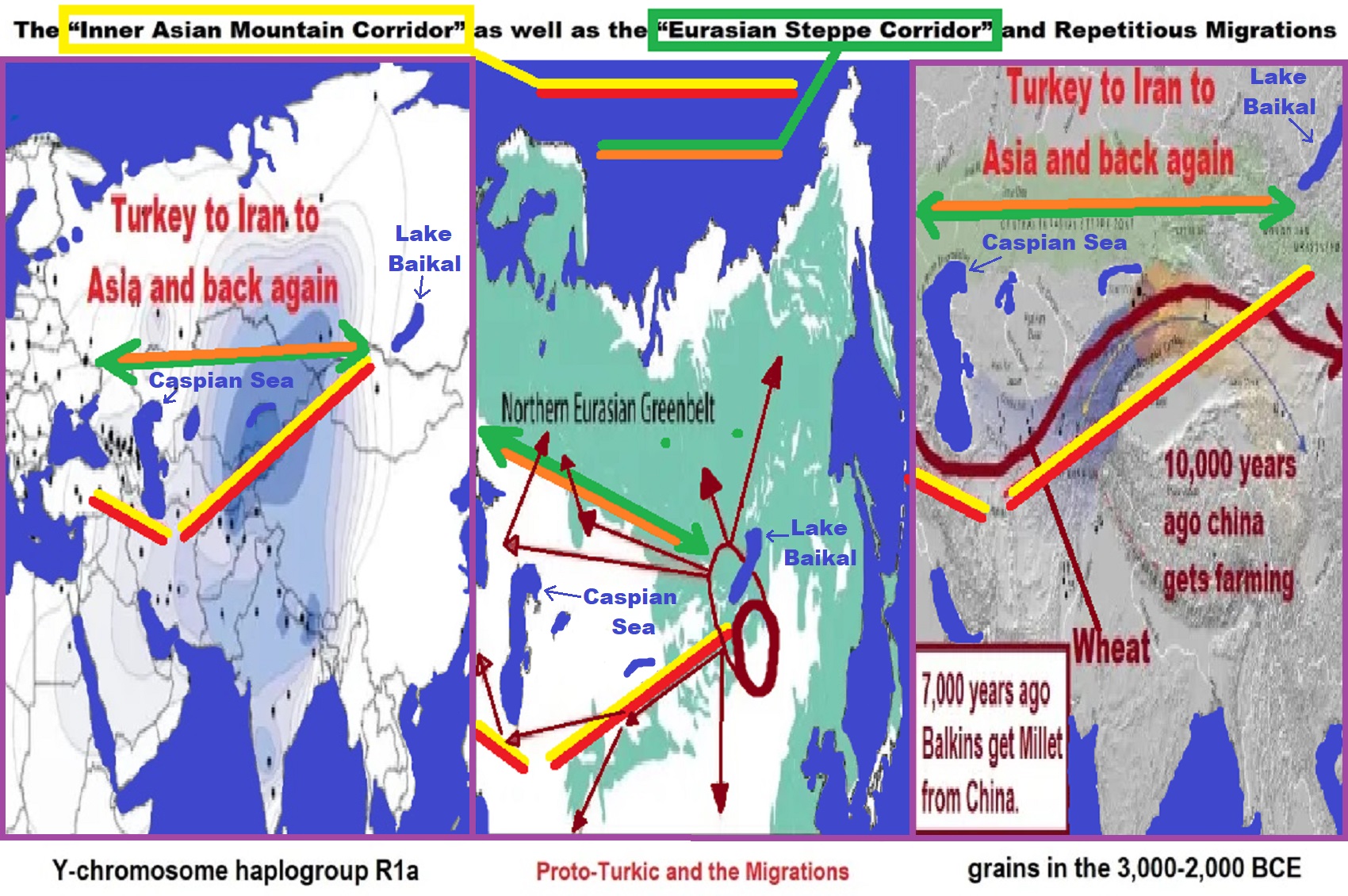
The “Inner Asian Mountain Corridor” as well as the “Eurasian Steppe Corridor” and Repetitious Migrations
“In northern China, the Nanzhuangtou culture on the middle Yellow River around Hebei (c. 8500–7700 BCE) had grinding tools. The Xinglongwa culture in eastern Inner Mongolia (c. 6200–5400 BCE) ate millet, possibly from agriculture. The Dadiwan culture along the upper Yellow River (c. 5800–5400 BCE) also ate millet. By the Yangshao culture (c. 5000–3000 BCE), the peoples of the Yellow River were growing millet extensively, along with some barley, rice, and vegetables; wove hemp and silk, which indicates some form of sericulture; but may have been limited to migratory slash and burn farming methods. The Longshan culture (c. 3000–2000 BCE) displays more advanced sericulture and definite cities.” ref
“In southern China, the Pengtoushan culture on the Yangtze River (c. 7500–6100 BCE) has left rice farming tools at some locations, though not at the type site. The Hemudu culture around Hangzhou Bay south of the Yangtze (c. 5000–4500 BCE) certainly cultivated rice. The various people (such as hundred viet tribal union) who succeeded in these areas were later conquered and culturally assimilated by the northern Chinese dynasties during the historical period.” ref
Inner Asia Mountain Corridor
“The Inner Asia Mountain Corridor (IAMC) was an ancient exchange route ranging from the Altai Mountains in Siberia to the Hindu Kush (present-day Afghanistan and northern Pakistan), which took shape in the 3rd millennium BCE. The expansion of the Indo-European Andronovo culture towards the Bactria-Margiana Culture in the second millennium BCE took place along the IAMC, giving way to the Indo-Aryan migration into South Asia.” ref
“By the fourth millennium BCE, or 6,022-5,022 years ago, a mobile pastoralist culture emerged at the Eurasian steppes. From the Pontic–Caspian steppe (present-day Ukraine and Russia), the Indo-European Yamna culture spread westwards toward the Great Hungarian Plain; and north-west it developed into the Corded Ware culture. Expanding eastward, Corded Ware eventually developed into the Sintashta culture, which further developed into the Andronovo culture. According to Narasimhan et al. (2018), the Andronovo-culture extended southwards via the IAMC, reaching into the Bactria-Margiana Culture, from where Indo-European language and culture reached South Asia.” ref
Eurasian Steppe Corridor
“The Steppe Route was an ancient overland route through the Eurasian Steppe that was an active precursor of the Silk Road. Silk and horses were traded as key commodities; secondary trade included furs, weapons, musical instruments, precious stones (turquoise, lapis lazuli, agate, nephrite), and jewels. This route extended for approximately 10,000 km (6,200 mi). Trans-Eurasian trade through the Steppe Route precedes the conventional date for the origins of the Silk Road by at least two millennia.” ref
Mal’ta–Buret’ culture of Siberia and Basal Haplogroup R* or R-M207
“The Mal’ta–Buret‘ culture is an archaeological culture of the Upper Paleolithic (around 24,000 to 15,000 years ago) on the upper Angara River in the area west of Lake Baikal in the Irkutsk Oblast, Siberia, Russian Federation. The type sites are named for the villages of Mal’ta, Usolsky District and Buret’, Bokhansky District (both in Irkutsk Oblast).” ref
“The “Mal’ta Cluster” is composed of three individuals from the Glacial Maximum 24,000-17,000 years ago from the Lake Baikal region of Siberia.” ref
“MA-1 is the abbreviation of the male child remains found near Mal’ta dated to 24,000 years ago, who belonged to a population related to the genetic ancestors of Siberians, American Indians, and Bronze Age Yamnaya people of the Eurasian steppe. In particular, modern-day Native Americans, Kets, Mansi, Nganasans, and Yukaghirs were found to be harbor a lot of ancestries related to MA-1.” ref
Haplogroup R possible time of origin about 27,000 years in Central Asia, South Asia, or Siberia:
- Mal’ta–Buret’ culture (24,000-15,000 years ago)
- Afontova Gora culture (21,000-12,000 years ago)
- Trialetian culture (16,000–8000 years ago)
- Samara culture (7,000-6,500 years ago)
- Khvalynsk culture (7,000-6,500 years ago)
- Afanasievo culture (5,300-4,500 years ago)
- Yamna/Yamnaya Culture (5,300-4,500 years ago)
- Andronovo culture (4,000–2,900 years ago) ref
“The areas were people showed red hair matches at 1% and Germanic R1b S21 at 1-5%. But it didn’t explain the Finnish I1 subclades came before the bronze age over 4,022 years ago. This also means Finnish I1 in Sweden and Norway were very old and pre bronze age and pre Germanic. Probably, also means Scandinavian I1 arrived before Corded ware culture because of another groups of I1 subclades in continental Europe.” ref
“This also means continental (mainly central) European I1a1 M227, I1a3 Z58, I1a4 Z63, and I1b Z131 own another origin and I1 M253 line that goes back over 11,000 years. I1 M253 is a very old haplogroup, datable 15,000-20,000ybp in central Europe.” ref
“A 2014 study in Hungary uncovered remains of nine individuals from the Linear Pottery culture, one of whom was found to have carried the M253 SNP which defines Haplogroup I1. It is abbreviated as LBK (from German: Linearbandkeramik), and is also known as the Linear Band Ware, Linear Ware, Linear Ceramics, or Incised Ware culture, and falls within the Danubian I culture of V. Gordon Childe. This culture is thought to have been present between 6,500 to 7,500 years ago.” ref
“The densest evidence for the culture is on the middle Danube, the upper and middle Elbe, and the upper and middle Rhine. It represents a major event in the initial spread of agriculture in Europe. The pottery after which it was named consists of simple cups, bowls, vases, and jugs, without handles, but in a later phase with lugs or pierced lugs, bases, and necks.” ref
“Important sites include Nitra in Slovakia; Bylany in the Czech Republic; Langweiler and Zwenkau in Germany; Brunn am Gebirge in Austria; Elsloo, Sittard, Köln-Lindenthal, Aldenhoven, Flomborn, and Rixheim on the Rhine; Lautereck and Hienheim on the upper Danube; and Rössen and Sonderhausen on the middle Elbe.” ref
“Excavations at Oslonki in Poland revealed a large, fortified settlement (dating to 4300 BCE or 6,322 years ago, i. e., Late LBK), covering an area of 4,000 m². Nearly 30 trapezoidal longhouses and over 80 graves make it one of the richest such settlements in archaeological finds from all of central Europe. The rectangular longhouses were between 7 and 45 meters long and between 5 and 7 meters wide. They were built of massive timber posts chinked with wattle and daub mortar.” ref
Two variants of the early Linear Pottery culture are recognized:
•The Early or Western Linear Pottery Culture developed on the middle Danube, including western Hungary, and was carried down the Rhine, Elbe, Oder and Vistula.” ref
•The Eastern Linear Pottery Culture flourished in eastern Hungary. Middle and late phases are also defined. In the middle phase, the Early Linear Pottery culture intruded upon the Bug-Dniester culture and began to manufacture musical note pottery. In the late phase, the Stroked Pottery culture moved down the Vistula and Elbe.” ref
“So how is it that modern Scandinavians belong essentially to three haplogroups (I1, R1a, and R1b) that haven’t been found in Mesolithic Scandinavian samples? I1 would have been the first to penetrated into Scandinavia during the farming transition that lasted roughly from 4,200 to 2,300 BCE or 6,222-4,322 years ago.” ref
“The most likely explanation for the replacement of Mesolithic paternal lineages (I* and I2) by I1 throughout Nordic countries, including Lapland and Finland, is that the few farmers and stock breeders that did spread around Scandinavia were almost exclusively I1 men (through a founder effect).” ref
“In the vast majority of farming societies men are the ones who inherit the land and the livestock. As wild game became scarce, especially during cold winters, farmers would have had a definite advantage for food and survival prospects. As surely happened in other parts of Europe, women from hunter-gathering families were married to wealthy farmers.” ref
“After several millennia, with agricultural land and livestock always inherited by I1 lineages from father to son, I1 became the dominant lineage, even though their maternal lines had become hybridized over time. Nowadays, according to the autosomal admixture tested performed by Lazaridis et al. (2014), Scandinavians have only a few percents more Mesolithic than Neolithic admixture.” ref
“The Saami of Lapland were the last hunter-gatherers of Europe. But even they turned to stock breeding by domesticating the indigenous reindeer, better suited to the harsh local climate than cattle, pigs, sheep, and goats. Reindeer domestication appears to have originated with North Asian N1c1 people. And indeed modern Saami are primarily N1c1 people with only a minority of Scandinavian paternal lineages (I1, R1b, R1a).” ref
“The presence of R1a and R1b, and its very modern proportion to I1 (using central Sweden as a reference) indicates that I1, R1a, and R1b incorporated the Saami gene pool together relatively recently (probably in historical times, from or after the Viking age).” ref
“N1c1 lineages, however, may have not have arrived that early either. N1c1 is associated with the diffusion of the Uralic languages. According to a phylogenetic reconstruction of the Uralic languages by Honkola et al. 2013, the Proto-Finnic and Proto-Samic split from each others only 2,500 years ago, and Samic dialects started diversifying less than 1,000 years ago. In all likelihood, all trace of the Mesolithic inhabitants of Lapland has been wiped out on the Y-chromosomal side, just as in most of Scandinavia.” ref



“Migration from Siberia behind the formation of Göbeklitepe: Expert states. People who migrated from Siberia formed the Göbeklitepe, and those in Göbeklitepe migrated in five other ways to spread to the world, said experts about the 12,000-year-old Neolithic archaeological site in the southwestern province of Şanlıurfa.“ The upper paleolithic migrations between Siberia and the Near East is a process that has been confirmed by material culture documents,” he said.” ref
“Semih Güneri, a retired professor from Caucasia and Central Asia Archaeology Research Center of Dokuz Eylül University, and his colleague, Professor Ekaterine Lipnina, presented the Siberia-Göbeklitepe hypothesis they have developed in recent years at the congress held in Istanbul between June 11 and 13. There was a migration that started from Siberia 30,000 years ago and spread to all of Asia and then to Eastern and Northern Europe, Güneri said at the international congress.” ref
“The relationship of Göbeklitepe high culture with the carriers of Siberian microblade stone tool technology is no longer a secret,” he said while emphasizing that the most important branch of the migrations extended to the Near East. “The results of the genetic analyzes of Iraq’s Zagros region confirm the traces of the Siberian/North Asian indigenous people, who arrived at Zagros via the Central Asian mountainous corridor and met with the Göbeklitepe culture via Northern Iraq,” he added.” ref
“Emphasizing that the stone tool technology was transported approximately 7,000 kilometers from east to west, he said, “It is not clear whether this technology is transmitted directly to long distances by people speaking the Turkish language at the earliest, or it travels this long-distance through using way stations.” According to the archaeological documents, it is known that the Siberian people had reached the Zagros region, he said. “There seems to be a relationship between Siberian hunter-gatherers and native Zagros hunter-gatherers,” Güneri said, adding that the results of genetic studies show that Siberian people reached as far as the Zagros.” ref
“There were three waves of migration of Turkish tribes from the Southern Siberia to Europe,” said Osman Karatay, a professor from Ege University. He added that most of the groups in the third wave, which took place between 2600-2400 BCE, assimilated and entered the Germanic tribes and that there was a genetic kinship between their tribes and the Turks. The professor also pointed out that there are indications that there is a technology and tool transfer from Siberia to the Göbeklitepe region and that it is not known whether people came, and if any, whether they were Turkish.” ref
“Around 12,000 years ago, there would be no ‘Turks’ as we know it today. However, there may have been tribes that we could call our ‘common ancestors,’” he added. “Talking about 30,000 years ago, it is impossible to identify and classify nations in today’s terms,” said Murat Öztürk, associate professor from İnönü University. He also said that it is not possible to determine who came to where during the migrations that were accepted to have been made thousands of years ago from Siberia. On the other hand, Mehmet Özdoğan, an academic from Istanbul University, has an idea of where “the people of Göbeklitepe migrated to.” ref
“According to Özdoğan, “the people of Göbeklitepe turned into farmers, and they could not stand the pressure of the overwhelming clergy and started to migrate to five ways.” “Migrations take place primarily in groups. One of the five routes extends to the Caucasus, another from Iran to Central Asia, the Mediterranean coast to Spain, Thrace and [the northwestern province of] Kırklareli to Europe and England, and one route is to Istanbul via [Istanbul’s neighboring province of] Sakarya and stops,” Özdoğan said. In a very short time after the migration of farmers in Göbeklitepe, 300 settlements were established only around northern Greece, Bulgaria, and Thrace. “Those who remained in Göbeklitepe pulled the trigger of Mesopotamian civilization in the following periods, and those who migrated to Mesopotamia started irrigated agriculture before the Sumerians,” he said.” ref
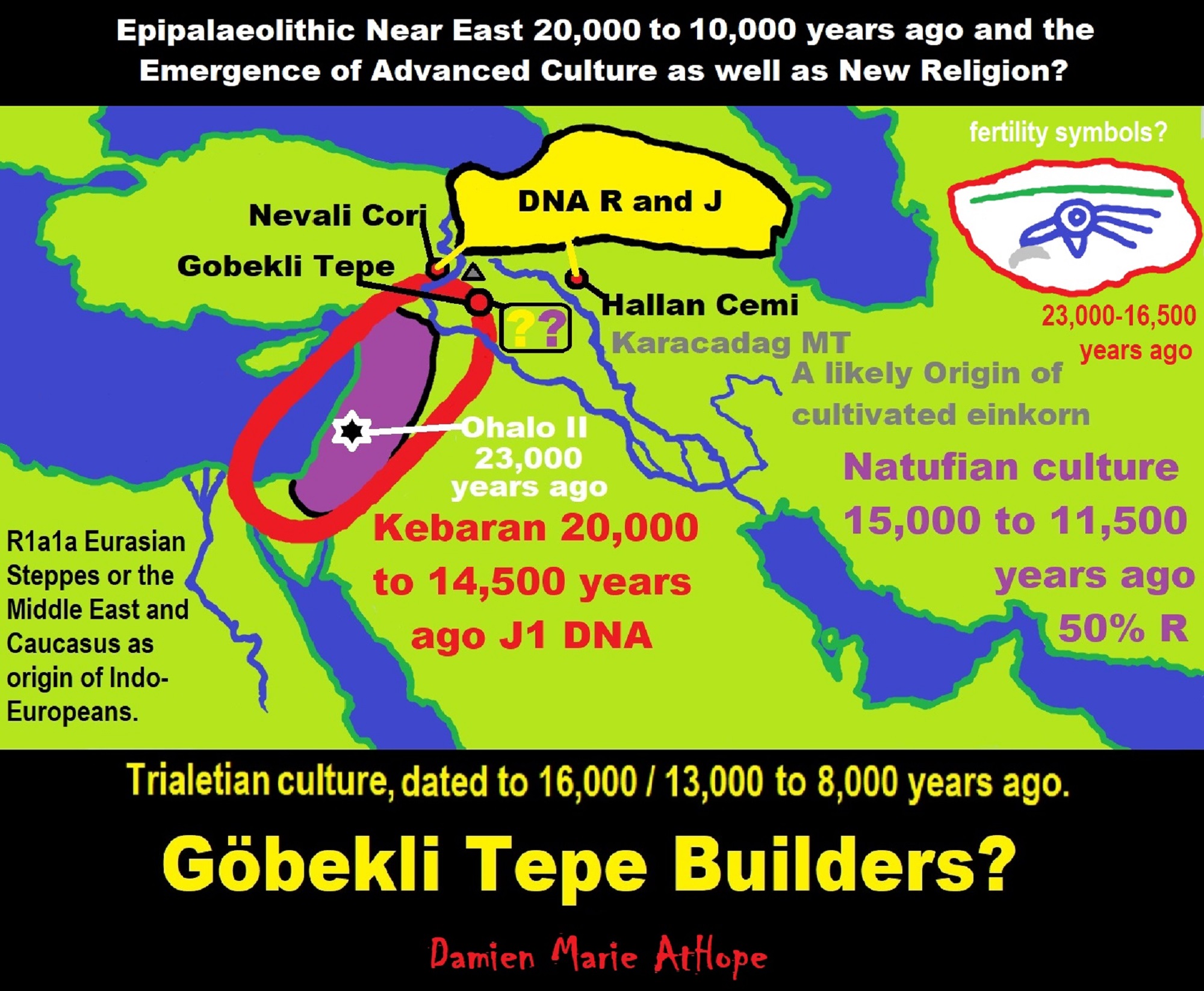
ref
Haplogroup R possible time of origin about 27,000 years in Central Asia, South Asia, or Siberia:
- Mal’ta–Buret’ culture (24,000-15,000 years ago)
- Afontova Gora culture (21,000-12,000 years ago)
- Trialetian culture (16,000–8000 years ago)
- Samara culture (7,000-6,500 years ago)
- Khvalynsk culture (7,000-6,500 years ago)
- Afanasievo culture (5,300-4,500 years ago)
- Yamna/Yamnaya Culture (5,300-4,500 years ago)
- Andronovo culture (4,000–2,900 years ago) ref
Trialetian sites
Caucasus and Transcaucasia:
- Edzani (Georgia)
- Chokh (Azerbaijan), layers E-C200
- Kotias Klde, layer B” ref
Eastern Anatolia:
- Hallan Çemi[9] (from ca. 8.6-8.5k BC to 7.6-7.5k BCE)
- Nevali Çori shows some Trialetian admixture in a PPNB context” ref
Trialetian influences can also be found in:
- Cafer Höyük
- Boy Tepe” ref
Southeast of the Caspian Sea:
- Hotu (Iran)
- Ali Tepe (Iran) (from cal. 10,500 to 8,870 BCE)
- Belt Cave (Iran), layers 28-11 (the last remains date from ca. 6,000 BCE)
- Dam-Dam-Cheshme II (Turkmenistan), layers7,000-3,000 BCE)” ref
“The belonging of these Caspian Mesolithic sites to the Trialetian has been questioned. Little is known about the end of the Trialetian. 6k BC has been proposed as the time on which the decline phase took place. From this date are the first evidence of the Jeitunian, an industry that has probably evolved from the Trialetian. Also from this date are the first pieces of evidence of Neolithic materials in the Belt cave.” ref
“In the southwest corner of the Trialetian region it has been proposed that this culture evolved towards a local version of the PPNB around 7,000 BCE, in sites as Cafer Höyük. Kozłowski suggests that the Trialetian does not seem to have continuation in the Neolithic of Georgia (as for example in Paluri and Kobuleti). Although in the 5,000 BCE certain microliths similar to those of the Trialetian reappear in Shulaveris Gora (see Shulaveri-Shomu) and Irmis Gora.” ref
“The genome of a Mesolithic hunter-gatherer individual found at the layer A2 of the Kotias Klde rock shelter in Georgia (labeled KK1), dating from 9,700 years ago, has been analyzed. This individual forms a genetic cluster with another hunter-gatherer from the Satsurblia Cave, the so-called Caucasian Hunter-Gatherer (CHG) cluster. KK1 belongs to the Y-chromosome haplogruoup J2a (an independent analysis has assigned him J2a1b-Y12379*).” ref
“Although the belonging of the Caspian Mesolithic to the Trialetian has been questioned, it is worth noting that genetic similarities have been found between an Mesolithic hunther-gatherer from the Hotu cave (labeled Iran_HotuIIIb) dating from 9,100-8,600 BCE and the CHG from Kotias Klde. The Iran_HotuIIIb individual belongs to the Y-chromosome haplogroup J (xJ2a1b3, J2b2a1a1) (an independent analysis yields J2a-CTS1085(xCTS11251,PF5073) -probably J2a2-). Then, both KK1 and Iran_HotuIIIb individuals share a paternal ancestor that lived approximately 18.7k years ago (according to the estimates of full). At the autosomal level, it falls in the cluster of the CHG’s and the Iranian Neolithic Farmers.” ref
“Göbekli Tepe (“Potbelly Hill”) is a Neolithic archaeological site near the city of Şanlıurfa in Southeastern Anatolia, Turkey. Dated to the Pre-Pottery Neolithic, between c. 9500 and 8000 BCE, the site comprises a number of large circular structures supported by massive stone pillars – the world’s oldest known megaliths. Many of these pillars are richly decorated with abstract anthropomorphic details, clothing, and reliefs of wild animals, providing archaeologists rare insights into prehistoric religion and the particular iconography of the period..” ref
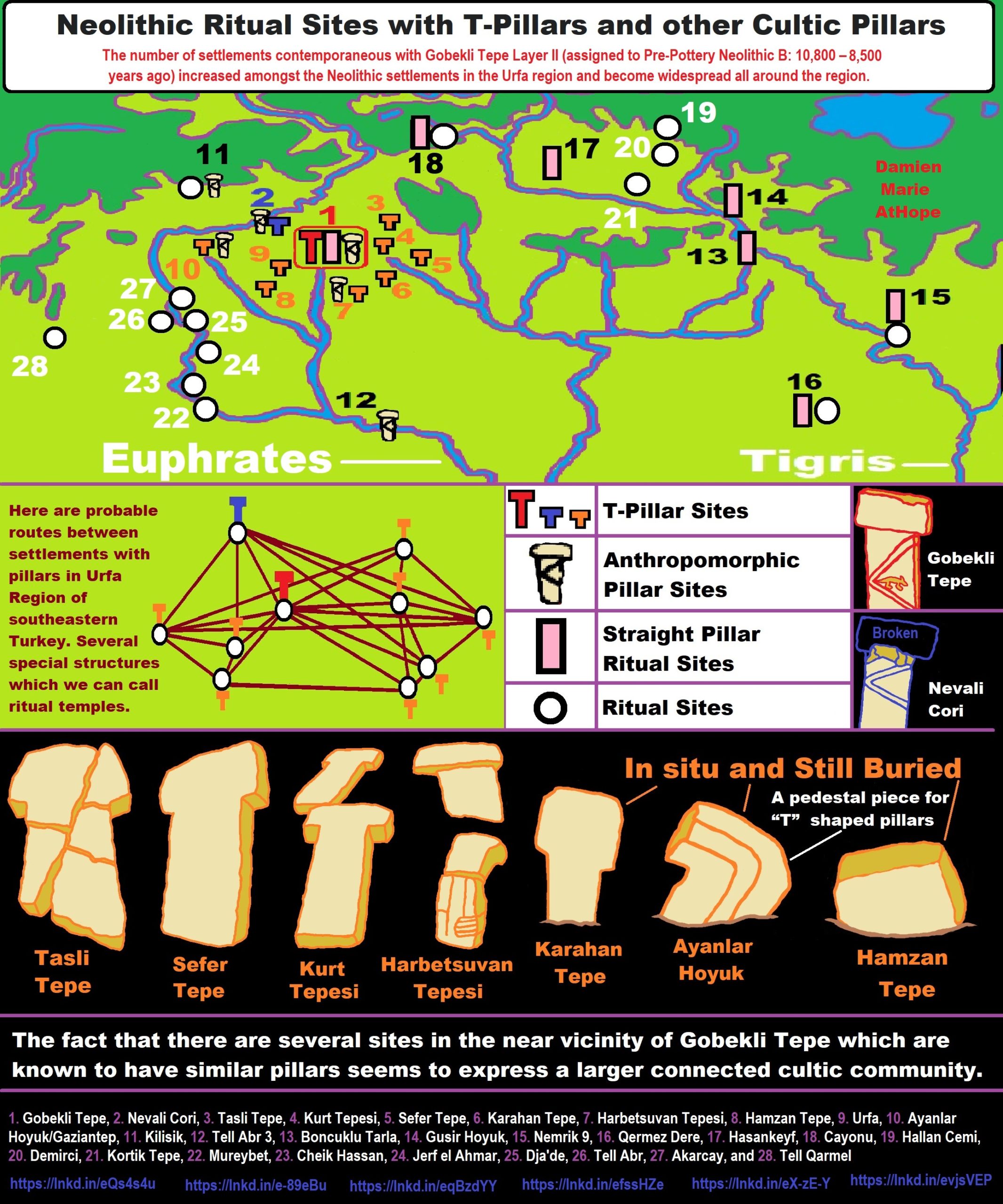
The number of settlements contemporaneous with Gobekli Tepe Layer II (assigned to Pre-Pottery Neolithic B: 10,800 – 8,500 years ago) increased amongst the Neolithic settlements in the Urfa region and become widespread all around the region.
- Gobekli Tepe, 2. Nevali Cori, 3. Tasli Tepe, 4. Kurt Tepesi, 5. Sefer Tepe, 6. Karahan Tepe, 7. Harbetsuvan Tepesi, 8. Hamzan Tepe, 9. Urfa, 10. Ayanlar Hoyuk/Gaziantep, 11. Kilisik, 12. Tell Abr 3, 13. Boncuklu Tarla, 14. Gusir Hoyuk, 15. Nemrik 9, 16. Qermez Dere, 17. Hasankeyf, 18. Cayonu, 19. Hallan Cemi, 20. Demirci, 21. Kortik Tepe, 22. Mureybet, 23. Cheik Hassan, 24. Jerf el Ahmar, 25. Dja’de, 26. Tell Abr, 27. Akarcay, and 28. Tell Qarmel
Göbekli Tepe is not alone, in fact, it is part of a religious/cultural connected ritual culture in the general region. There are several other similar sites with similar T-pillars to Göbekli Tepe or other types of stone pillar providing a seeming connected cult belief or religious culture of pillars seen in the PPNA-PPNB in the northern portion of the Near East.
“The locations of the sites that contain “T” shaped pillars are the main topic that needs more understanding to grasp the larger sociocultural-religious cultural complex in the same general region. Another matter under discussion is to comprehend the differences between the small-scale settlements that contain cult centers and “T” shaped pillars and the larger ones found at Gobekli Tepe layer III. The fact that settlements with “T” shaped pillars contain both the remains of circular domestic buildings and the pillars such as seen at Cayonu and Nevali Cori, which are also known to contain cult and domestic buildings. It is contemplated that such settlements are contemporary with Gobekli Tepe layer II and the cult building known from Nevali Cori based on the similarities and differences of the “T” shaped pillars. In the light of the finds unearthed from the settlements in Şanliurfa region that contain “T” shaped pillars, such settlements should be dated to the end of Late Pre-Pottery Neolithic A (LPPNA) and the Early Pre-Pottery Neolithic B (EPPNB).” ref

12,000-year-old Gobekli Tepe: the first temple
At around 13,000 years ago, the site functioned as a ritual or religious center, with the early circles being added around 11,600 years ago. Then, between 11,130–10,620 years ago, the first building stage for Layer III was completed. At this point, it was a totemistic-shamanistic proto-paganism meeting place of ancestor worship and cultic feasting as well as drinking, with evidence of beer brewing starting at almost 11,000 years ago. Next, around 10,280–9,970 years ago, enclosure B is constructed, followed by enclosure C at around 9,560–9,370. Some pillars are around 15 to 20 ft-foot-high and can weigh up to 20 tons, many with totem animals and anthropomorphic human-like fertility cult representations.
Gobekli Tepe is more like Shamanistic early Paganism, Not Adam, Eve, and Cain or Bible anything!
12,000-year-old Gobekli Tepe: “first human-made pagan temple”
Göbekli Tepe 12,000 years old T-shaped Pillars are not Alone (not Ancient Aliens)
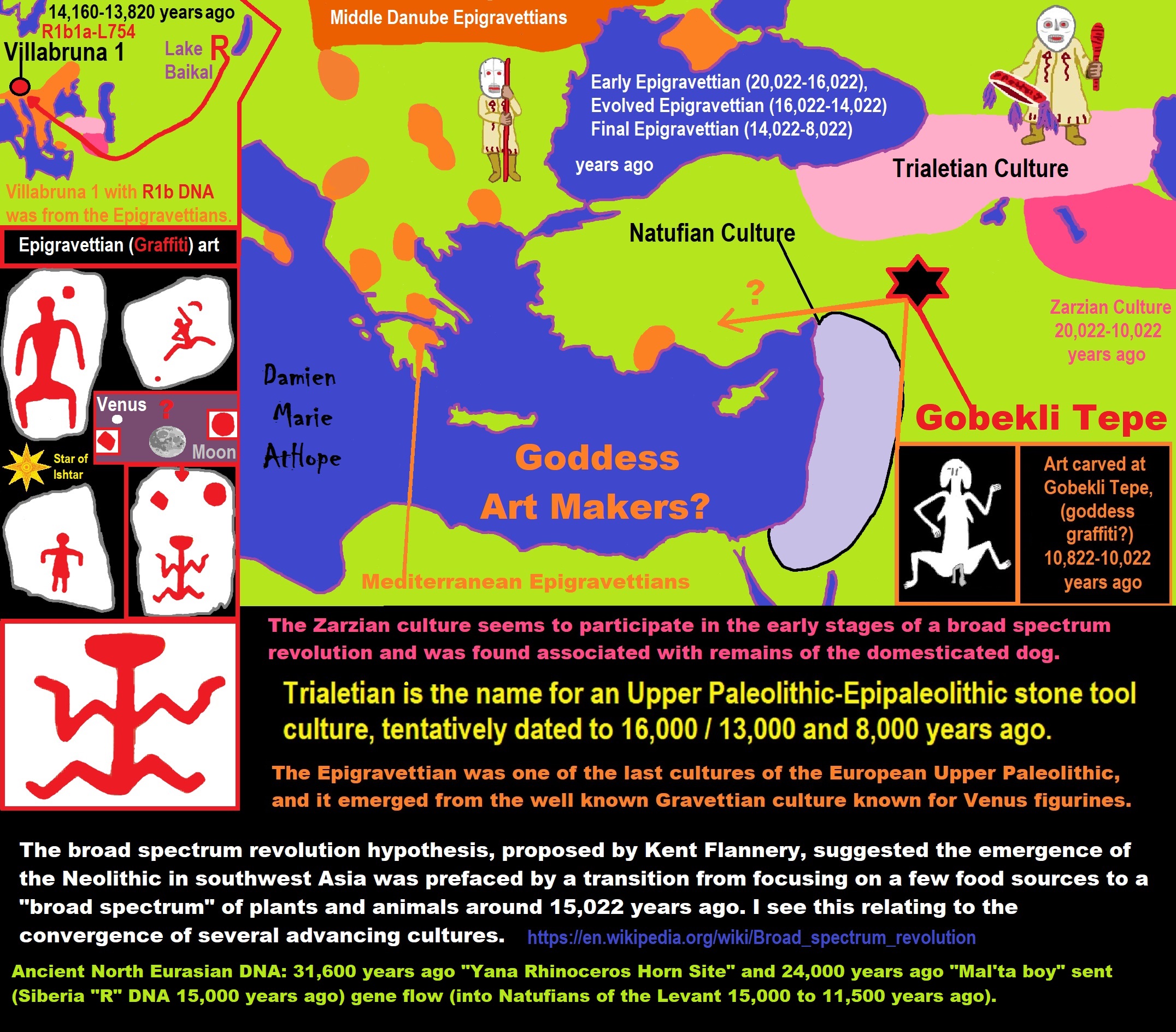
10,800-10,000 years old “Göbekli Tepe, engraving of a female person from layer II.” ref
“The Gravettian was an archaeological industry of the European Upper Paleolithic that succeeded the Aurignacian circa around 36/33,022 years ago, It is archaeologically the last European culture many consider unified, and had mostly disappeared by c. 22,022 years ago, close to the Last Glacial Maximum, although some elements lasted until c. 17,022 years ago. At this point, it was replaced abruptly by the Solutrean in France and Spain, and developed into or continued as the Epigravettian in Italy, the Balkans, Ukraine, and Russia. The Gravettian culture is known for Venus figurines, which were typically carved from either ivory or limestone. The culture was first identified at the site of La Gravette in the southwestern French department of Dordogne.” ref
“Surviving Gravettian art includes numerous cave paintings and small, portable Venus figurines made from clay or ivory, as well as jewelry objects. The fertility deities mostly date from the early period; there are over 100 known surviving examples. They conform to a very specific physical type, with large breasts, broad hips, and prominent posteriors. The statuettes tend to lack facial details, and their limbs are often broken off.” ref
“In a genetic study published in Nature in May 2016, the remains of fourteen Gravettians were examined. The eight samples of Y-DNA analyzed were determined to be three samples of haplogroup CT, one sample of I, one sample of IJK, one sample of BT, one sample of C1a2, one sample of F. Of the fourteen samples of mtDNA, there were thirteen samples of U and one sample of M. The majority of the sample of U belonged to the U5 and U2. In a genetic study published in Nature in November 2020, the remains of one adult male and two twin boys from a Gravettian site were examined. The Y-DNA analysis revealed that all 3 individuals belonged to haplogroup I. The 3 individuals had the same mtDNA, U5.” ref
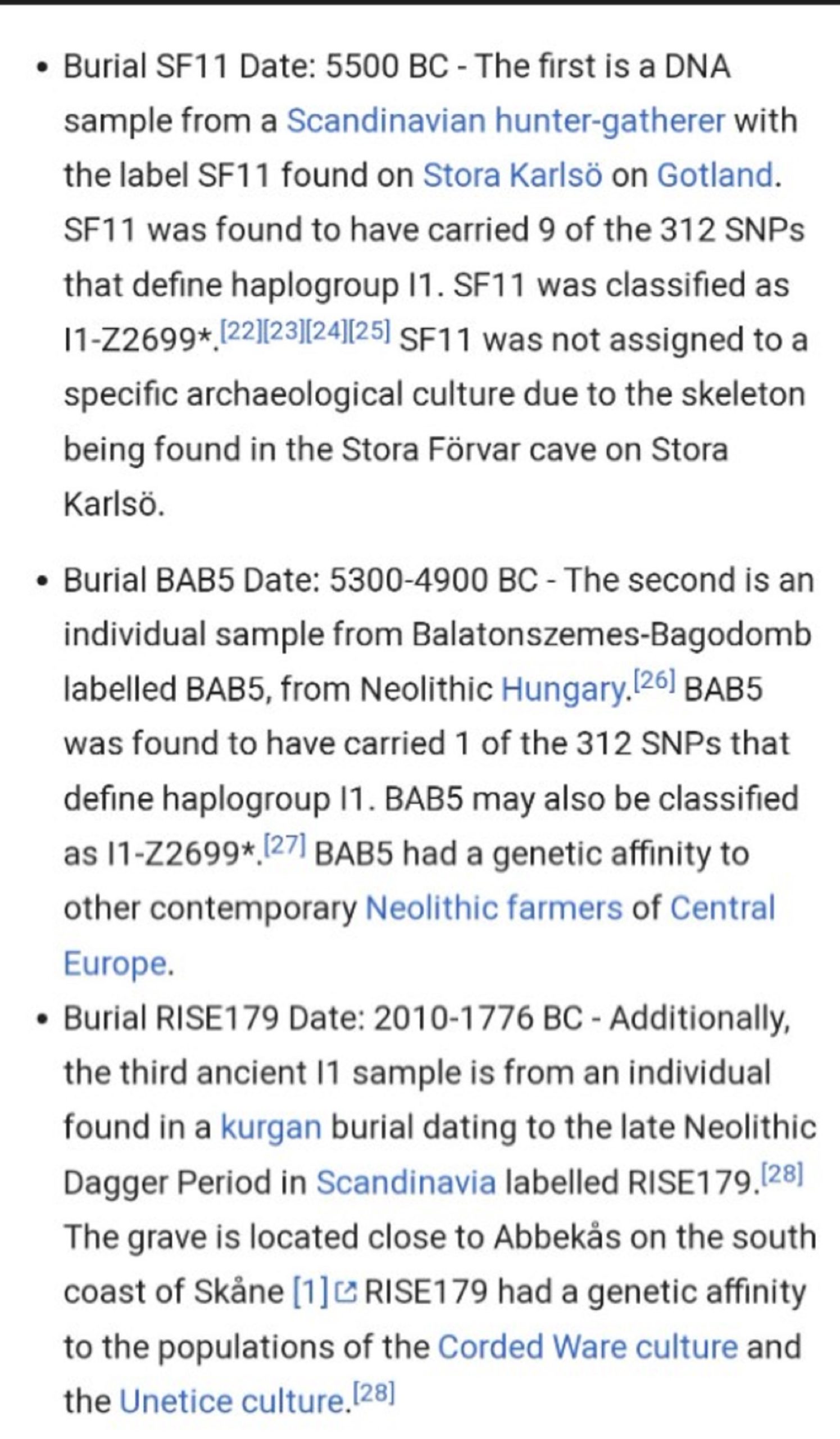

Ideas from Europe head to Russia, then on to Mal’ta–Buret’ culture in Siberia, near the Golden Mountains of Altai and Lake Baikal.
Shamanism and Totemism, with Animism, of course, group ideas are at this point spreading from Europe to Aisa and beyond.
“The majority of modern R1b and R1a would have expanded from the Caspian Sea along with the Indo-European languages. And genetic studies support the Kurgan hypothesis regarding the Proto-Indo-European homeland. According to those studies, haplogroups R1b and R1a, now the most common in Europe (R1a is also common in South Asia) would have expanded from the West Eurasian Steppe, along with the Indo-European languages; they also detected an autosomal component present in modern Europeans which was not present in Neolithic Europeans, which would have been introduced with paternal lineages R1b and R1a, as well as Indo-European languages.” ref
The oldest human remains found to carry R1b include:
- Villabruna 1 (individual I9030), found in an Epigravettian culture setting in the Cismon valley (modern Veneto, Italy), who lived circa 14,000 years BP and belonged to R1b-L754,
- numerous individuals from the Mesolithic Iron Gates culture of the central Danube (modern Romania and Serbia), dating from 10,000 to 8,500 BP – most of them falling into R1b-L754;
- two individuals, dating from circa 7,800–6,800 BP, found at the Zvejnieki burial ground, belonging to the Narva culture of the Baltic neolithic, both determined to belong to the R1b-P297 subclade, and;
- the “Samara hunter-gatherer” (I0124/SVP44), who lived approximately 7,500 BP in the Volga River area and carried R1b-L278. ref
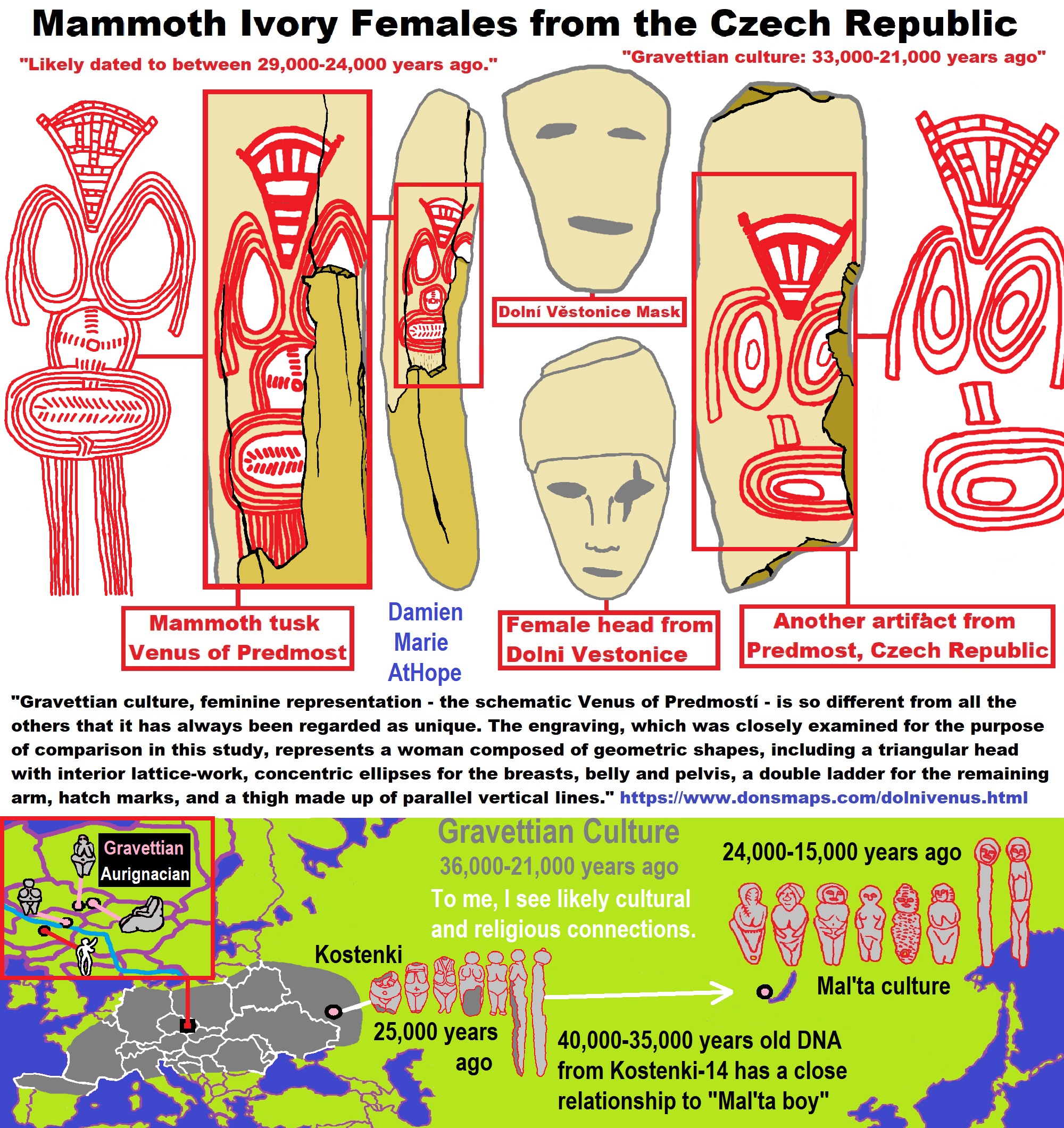

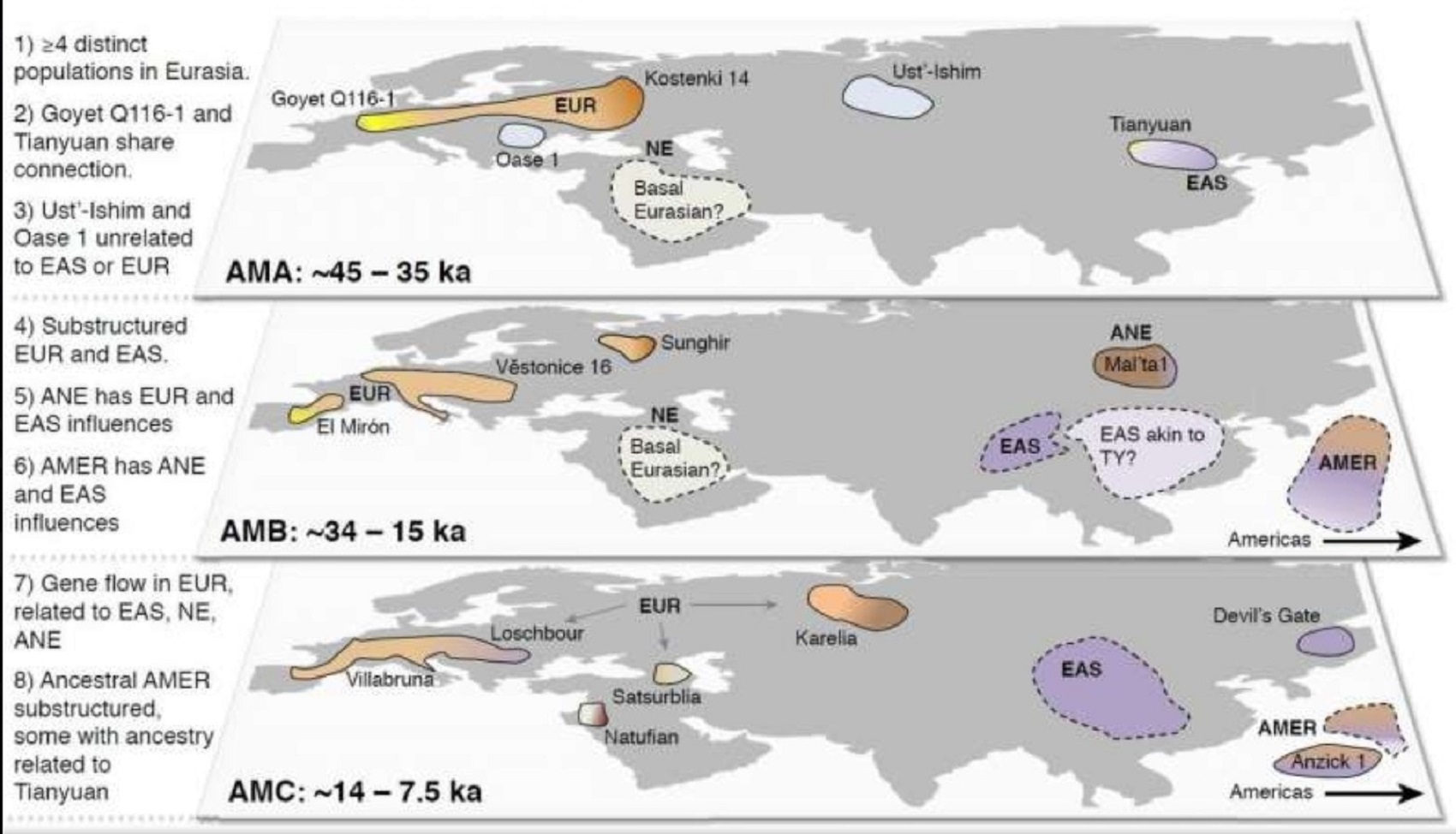
“Eurasia ∼45–35 ka shows the presence of at least four distinct populations: early Asians and Europeans, as well as populations with ancestry, found hardly or not at all in present-day populations. Europeans from around 34–15 ka show a high internal population structure. Approximately 14,000–7,500 years ago, populations across Eurasia shared genetic similarities, suggesting greater interactions between geographically distant populations. Ancient modern human genomes support at least two Neanderthal admixture events, one ∼60,000–50,000 years ago in early ancestors of non-African populations and a second >37,000 years ago related to the Oase 1 individual. A gradual decline in archaic ancestry in Europeans dating from ∼37,000 to 14,000 years ago suggests that purifying selection lowered the amount of Neanderthal ancestry first introduced into ancient modern humans.” ref
“The genetic relationship of past modern humans to today’s populations and each other was largely unknown until recently, when advances in ancient DNA sequencing allowed for unprecedented analysis of the genomes of these early people. These ancient genomes reveal new insights into human prehistory not always observed studying present-day populations, including greater details on the genetic diversity, population structure, and gene flow that characterized past human populations, particularly in early Eurasia, as well as increased insight on the relationship between archaic and modern humans. Here, we review genetic studies on ∼45 000- to 7500-year-old individuals associated with mainly preagricultural cultures found in Eurasia, the Americas, and Africa.” ref
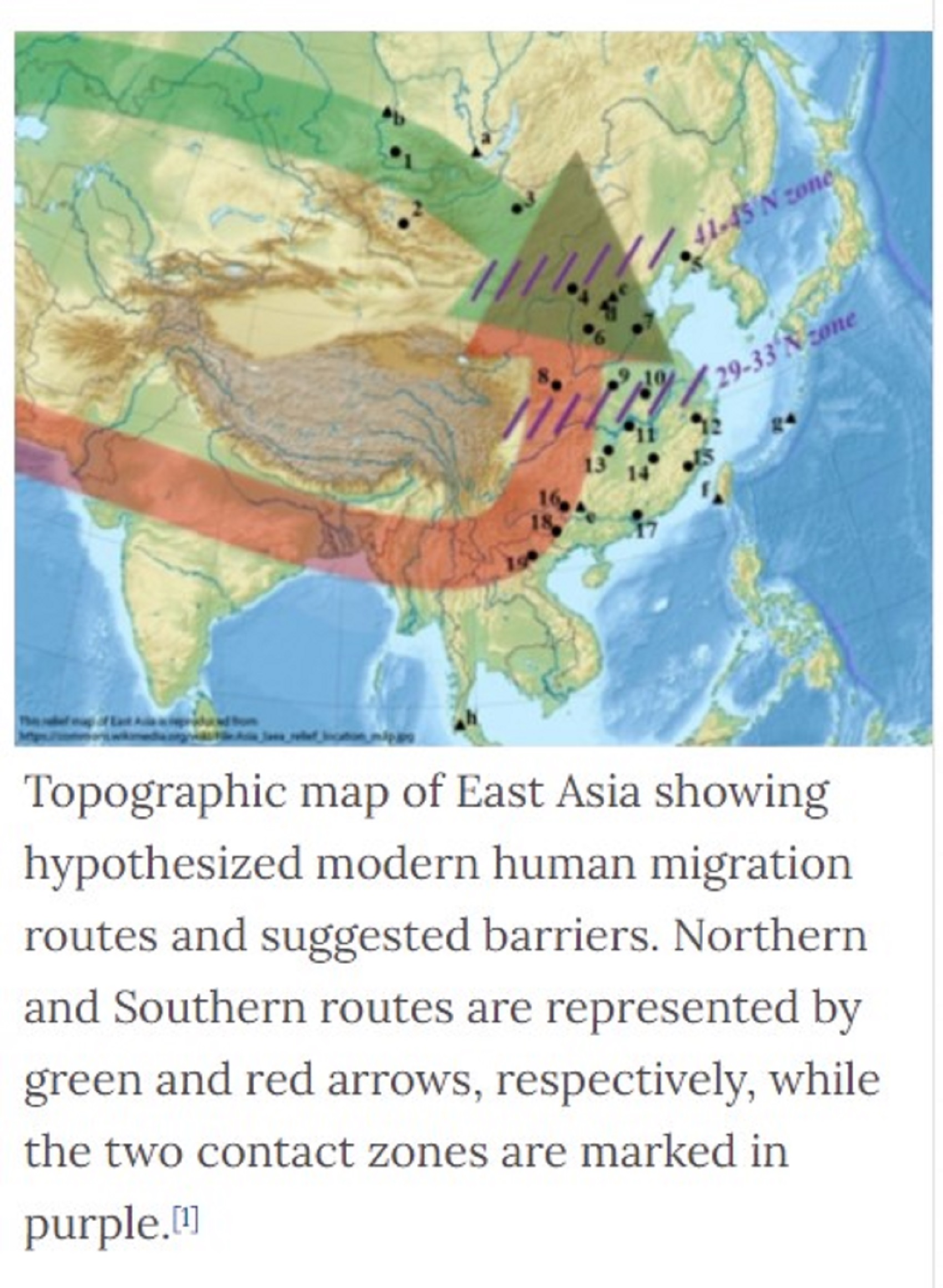
The red arrow shown above was likely more Animism only or something like that, then mixing in North Aisa, near Mal’ta–Buret’ culture area in Siberia, near the Golden Mountains of Altai and Lake Baikal.

Mammoth bone dwellings are a very an early type of housing constructed by Upper Paleolithic hunter-gatherers mainly in central Europe. ref
Mammoth Bone Dwellings range from around 44,000 to 14,000 years ago, likely expressions of Cultist Culture and maybe some “Totemism” socio-religious-symbolic meanings. These ritual structures seem to have begun with Neandertals and then continued with Modern Human Hunter Gather groups like the Gravettian and connected Epi-gravettian cultures. ref
Gravettian and Epigravettian mammoth bone dwellings range from: Pavlovian (Early Gravettian of Moravia), Gagarino and Pouchkari (Gravettian of Eastern Europe), Kostienki 11/1a (Zamiatnine culture), and Mezinian. ref
The 44,000-year-old site from Molodova in eastern Ukraine was a Neanderthal “Mousterian Culture” Mammoth Bone Dwelling with possible “Totemism” connections due to how some of the bones used to build the ritual structure home had decorative carvings and added pigments. It was an incredible 26 foot wide circular building believed to be earliest bone built cultural structure and where they lived for extended periods of time. ref, ref
The 44,000-year-old Neanderthal bone structure near Molodova was constructed with 116 large deliberately selected mammoth bones including skulls, jaws, tusks and leg. Inside there was at least 25 fire pits and from the artifacts found Neanderthals made many decorated carvings in addition to the symbolic adding of ochre pigments to the bones. ref, ref
The painting in red on the front of mammoth skull may represent the flames and sparks of a fire and as bones where found burned in fire pits so there could be a ritualistic representation connection, which I think it is. It could be a prehistoric “drum” consisted of a mammoth skull, which may relate to a change from totemism to shamanism and was set at the entrance as well as contained a painted pattern of red ocher dots and lines. The top of this skull bears depressions where it seems to have been beaten by “drumsticks,” the animal long bones that were found to bear corresponding damage on their ends. It is possible that the building may have served some ritual or communal function at which the mammoth bone rhythms were beaten out, although many Ukrainian huts of a similar size seem to have been ordinary living places. ref, ref, ref
Even more telling to its ritualistic relevance is that is was found at the entrance to one of the mammoth hunter’s huts, which could also hold a vaginal/womb reference and as there was also an oddly placed signal tusk pointing in and hugging the head sticking upright out of the ground almost as if it represents a phallus entering the vaginal/womb thus fertility hunting cult suggestions as well as maybe fire worship. ref, ref
Inside the Mezherich building, there were some remarkable finds: amber ornaments and fossil shells, transported an estimated 218 to 310 miles from their source, and the remains of one of the earliest percussion instruments ever found. The middle Dnepr basin is the origin of amber is well known near Kiev where it was collected throughout the Upper Palaeolithic. Amber objects have been used as pieces of small adornment in the Upper Palaeolithic sites of the Dnepr basin: Gontsy, Dobra-nichivka, Mejiriche, Semenivka 2, Ioudinovo, Chulatovo 2, Mezine, Osokorivka (level 2), and Kaistrova balka 2 ref, ref
A spectacular prehistoric art is visible in the dwellings of the Mezinian, in the grouping in the outer wall of jaws and long bones showing a geometric pattern of lines, chevrons and zigzags, which are also figured in the painted bones of the dwellings and in the mobile art of the statuettes, tools and various artifacts, confirming they are the manifestation of a socio-symbolic system of the Mezinian culture. ref
A mammoth bone dwelling hold a common form of a circular or oval structure with walls made of stacked large mammoth bones often modified to allow them to be lashed together or implanted into the soil. Within the interior is typically found a central fire pits or several scattered fire pits. External fire pits, butchering areas, and flint workshops are often found in association with the hut: scholars call these combinations Mammoth Bone Settlements (MBS). ref
The mammoth bone dwellings are not random. And they seem to express a pattern, thus this may demonstrate cultural/religious transfer inclinations and consistency in tradition over thousands of years. Similarly they are composed of several hundred bones and tusks arranged in a rough circles with a diameter of 20 to 33 feet. Even more interesting is that the first Neanderthal mammoth bone dwelling at 44,000-year-old was also in the range at 26 feet, thus it too is consistent with all the rest seeming to hit that they share some deep possible connection. ref
Such bone houses have been found in considerable numbers, often clustered together in little “villages” of four or five houses in the fertile valleys of the Ukraine and the same method of construction has appeared as far west as Kracow, in Poland, with three rings of mammoth bones exactly similar to those in Russia and dating to about 20 000 years ago. ref
Relatively all of the mammoth bone dwelling sites date to the Upper Paleolithic period (Gravettian or Epi-Gravettian), with the sole exception of Molodova 1, which dates to the Middle Stone Age and is associated with Neanderthals. ref

ref, ref, ref, ref, ref, ref, ref, ref, ref, ref, ref, ref, ref, ref, ref, ref, ref
“The shaman is, above all, a connecting figure, bridging several worlds for his people, traveling between this world, the underworld, and the heavens. He transforms himself into an animal and talks with ghosts, the dead, the deities, and the ancestors. He dies and revives. He brings back knowledge from the shadow realm, thus linking his people to the spirits and places which were once mythically accessible to all.–anthropologist Barbara Meyerhoff” ref
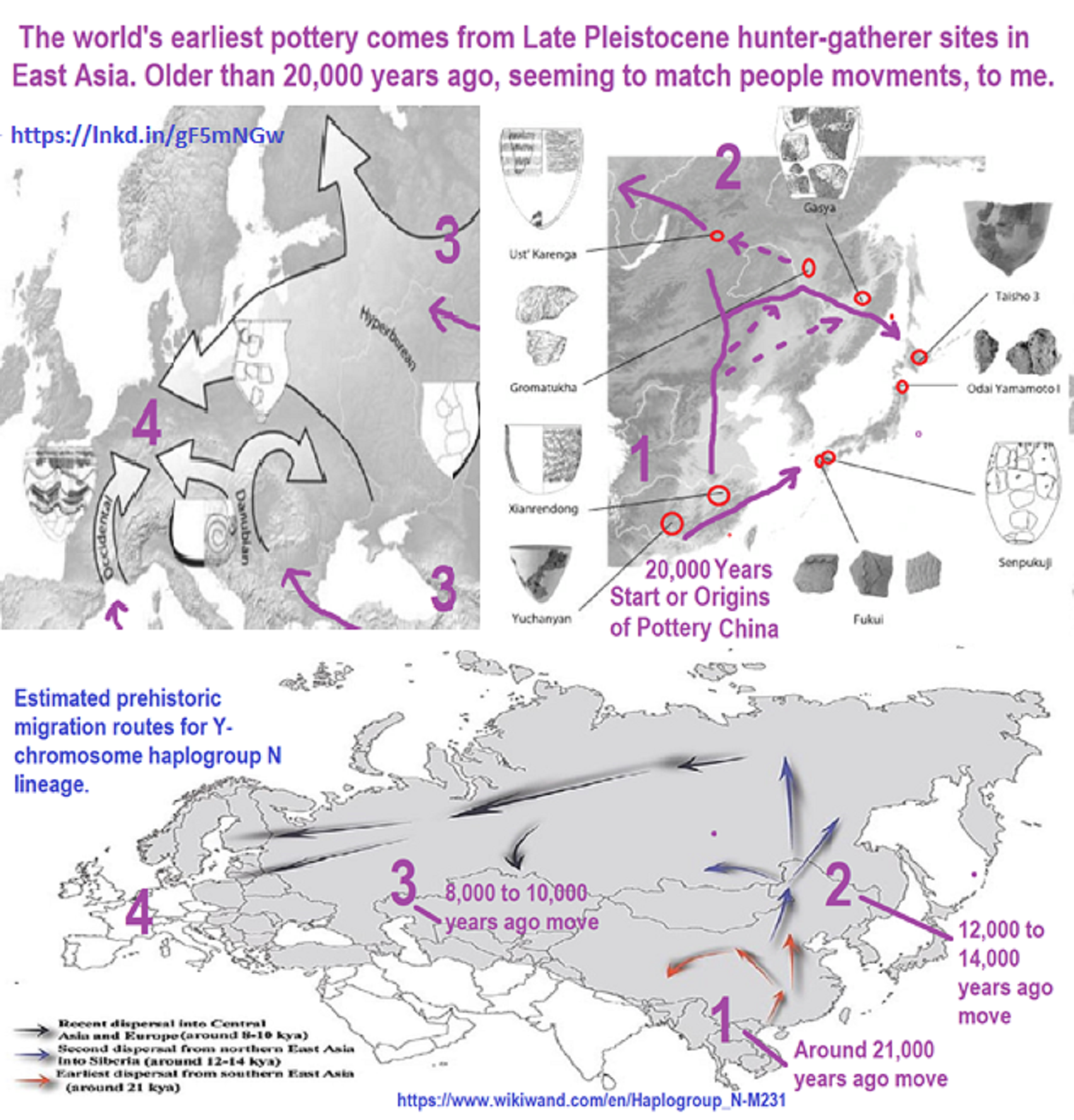
Early Pottery at 20,000 Years Ago in Xianrendong Cave, China
https://science.sciencemag.org/content/336/6089/1696
The oldest pottery, in China, remains of crude pots and bowls, hints at cooking’s ice-age origins
https://www.newscientist.com/article/dn21985-oldest-pottery-hints-at-cookings-ice-age-origins
The Advent and Spread of Early Pottery in East Asia: New Dates and New Considerations for the World’s Earliest Ceramic Vessels
Abstract and Figures
“This paper discusses recent data from North and South China, Japan, and the Russian Far East and eastern Siberia on the dating and function of early pottery during the Late Pleistocene period and shows how reconsiderations are needed for the patterns and reasons for its emergence and spread. Early pottery typically appears in contexts that, except for containing small amounts of pottery, are otherwise similar to Late Paleolithic sites. There is also no evidence of plant cultivation, so clearly, in eastern Asia, the old view of pottery’s emergence or dispersal as only coming within agricultural societies is no longer viable. Greater consideration needs to be given to the invention and spread of pottery in hunter-gatherer societies.” ref
“This paper first reviews recent finds of early pottery sites in South China and North China that now clearly show that the pottery first appears in otherwise Late Paleolithic contexts. Excavations and re-dating at Xianrendong Cave (Jiangxi) in South China show that pottery appears there in securely dated stratigraphic contexts dating to ca. 20,000 cal BP, during the Last Glacial Maximum, some ten millennia before sedentary, Early Neolithic villages first appear in China. Yuchanyan Cave (Hunan) has pottery dating to 18,300 cal BP, evidence for processing deer bones to extract marrow and grease, and perhaps evidence of seasonal visits to the site in annual rounds by mobile hunter-gatherer groups. Sites with early pottery in North China, such as Yujiagou, Zhuannian, Donghulin, Lijiagou, and Nanzhuangtou, appear relatively late, from the climatic downturn of the Younger Dryas, some eight millennia after sites in South China and four millennia after early pottery in Japan and the Russian Far East.” ref
“North China sites variously feature such adaptations as microblades and/or grinding stones, as well as evidence for the exploitation of wild grasses (including millets), acorns, and tubers. These sites might represent hunter-gatherers retreating to more favorable habitats during the Younger Dryas and indicate reduced mobility and semisedentary practices with more intensified exploitation of closer resources. Early pottery finds beginning from ca. 16,800 cal BP in Japan (Incipient Jōmon) and the Russian Far East (“Initial Neolithic”) are also reviewed. Incipient Jōmon sites occur contemporaneously with Final Upper Paleolithic sites, and are found from southern Kyūshū to Hokkaidō (Taishō 3 site). With over 80 known sites, Japan has a better evidence for changes in pottery distribution patterns and diverse adaptations to climatic changes from the time period of the earliest site, Ōdai Yamamoto I, to the Holocene. Molecular and stable isotope analyses of pottery adhesions provide valuable data on the use of early pottery in Japan lacking for all other regions: these indicate the widespread use of pottery for processing marine and freshwater animals.” ref
“Like Final Upper Paleolithic sites, Incipient Jōmon sites also may have microblades, edge polished stone axes, arrowheads, and bifacial spear points. Undecorated pottery with Mikoshiba-type lithics are found in the initial phase of pottery making (Ōdai Yamamoto I, Kitahara, and Maeda Kōji sites, dating ca. 16,500-13,500 BP). Decorated pottery (Phase 2) begins ca.15,700 cal BP during the Bølling-Allerød warming period and rapidly disperses across the archipelago at a time when there may have been significant changes in subsistence and mobility patterns. Phase 1 pottery might occur during a time of intensive information flow and fluidity of social networks, while diversification of pottery in Phase 2 occurs when social networks were becoming more embedded in place. Russian “Initial Neolithic” early pottery sites, such as Khummy, Gasya, and Goncharka 1 in the Lower Amur River basin, are transitional between Paleolithic traditions and typical Neolithic sites of the Holocene, with pottery and ground stone tools gradually appearing amongst Upper Paleolithic toolkits.” ref
“As in China and Japan, early pottery production is at a very low scale, with only limited quantities of sherds being found at a few sites. Eastern Siberia early pottery is first present at the Ust’-Karenga 12 site ca. 13,000 cal BP. Pottery may have dispersed westerly across Siberia as forested areas expanded, perhaps resulting in the introduction of pottery into Europe by hunter-gatherer groups. Across East Asia, early pottery appears only in small amounts and at a few sites, and it persists in this episodic, low scale usage from the Last Glacial Maximum until the Early Holocene. We still need to better understand why this is the case. Early pottery may have been invented and used for special purposes, such as in feasting that was carried out to achieve various socio-political goals.” ref
“While pottery also offered utilitarian or economic value, its long-lasting, low-scale use, but widespread dispersal despite this, cannot be fully accounted for only in terms of it being an adaptation tied to subsistence and increasing energy yields. Questions still remain over whether pottery was the result of a single or multiple inventions in East Asia. South China sites are clearly earlier, and the contemporaneity of Japan and Russia does not rule out singular invention and spread, as sites of the same radiocarbon date in the Late Pleistocene actually fall within a real calendrical range on a centuries-long scale. We need to better understand the scale and patterns of hunter-gatherer mobility and the extent of information exchange networks through which knowledge of pottery making could have spread widely in Late Pleistocene East Asia.” ref
As N migrated out of cultural mixing in North Aisa, near Mal’ta–Buret’ culture area in Siberia, near the Golden Mountains of Altai and Lake Baikal.
N DNA in China when it started north was Animism but as it hit Siberia they met the totemistic shamanists and both were the same after that but they also pick up paganism as they head west. Creating paganistic shamanism with the totemism seemingly even stronger than ever as it evolved as well. And it is likely the devil’s people as to a potential “why” we have pyramids all over the world where ever they went.

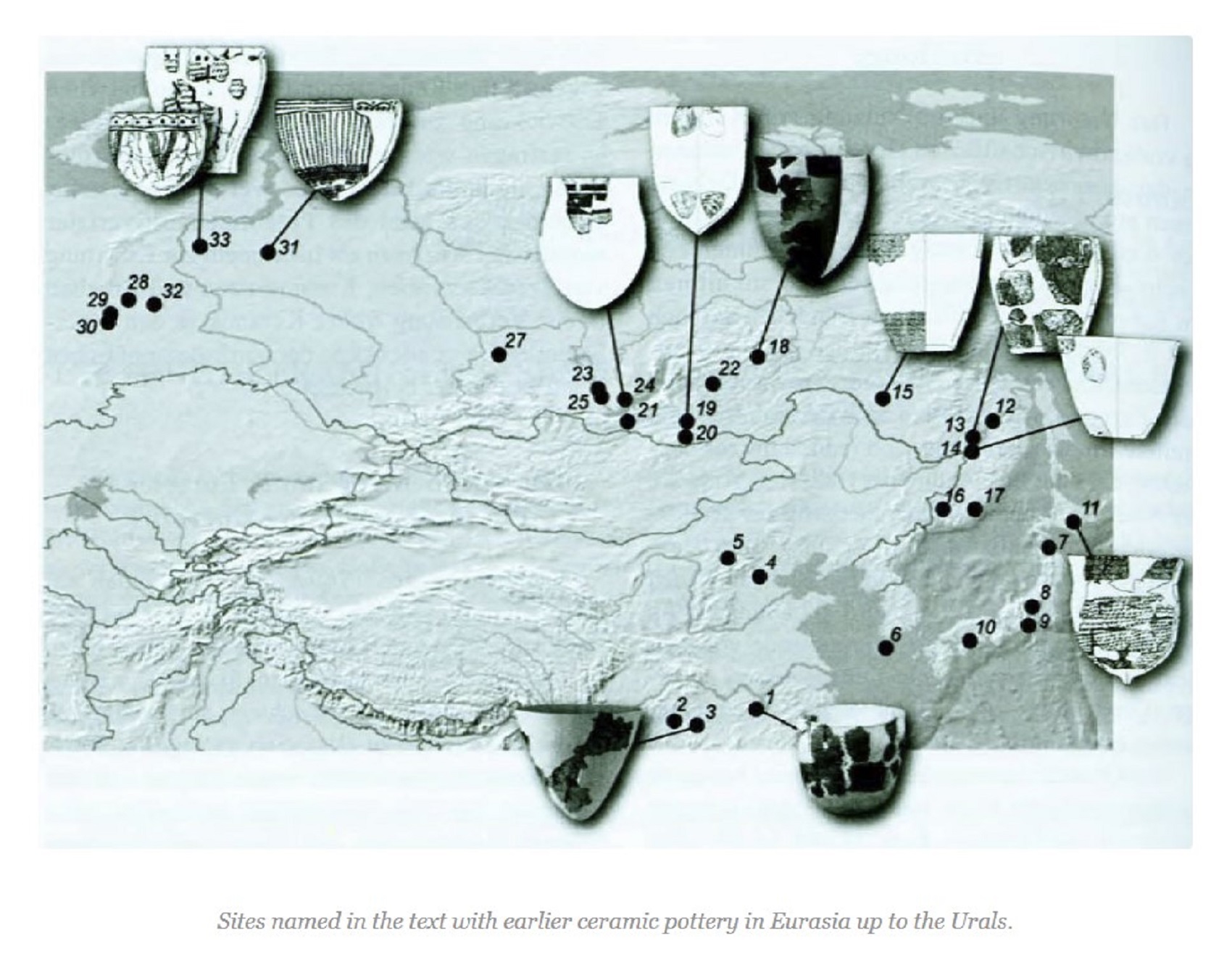
“The arrival of haplogroup R1a-M417 in Eastern Europe, and the east-west diffusion of pottery through North Eurasia.” ref
R-M417 (R1a1a1)
“R1a1a1 (R-M417) is the most widely found subclade, in two variations which are found respectively in Europe (R1a1a1b1 (R-Z282) ([R1a1a1a*] (R-Z282) and Central and South Asia (R1a1a1b2 (R-Z93) ([R1a1a2*] (R-Z93).” ref
R-Z282 (R1a1a1b1a) (Eastern Europe)
“This large subclade appears to encompass most of the R1a1a found in Europe.
- R1a1a1b1a [R1a1a1a*] (R-Z282*) occurs in northern Ukraine, Belarus, and Russia at a frequency of c. 20%.
- R1a1a1b1a3 [R1a1a1a1] (R-Z284) occurs in Northwest Europe and peaks at c. 20% in Norway.
- R1a1a1c (M64.2, M87, M204) is apparently rare: it was found in 1 of 117 males typed in southern Iran.” ref
R1a1a1b2 (R-Z93) (Asia)
“This large subclade appears to encompass most of the R1a1a found in Asia, being related to Indo-European migrations (including Scythians, Indo-Aryan migrations, and so on).
- R-Z93* or R1a1a1b2* (R1a1a2* in Underhill (2014)) is most common (>30%) in the South Siberian Altai region of Russia, cropping up in Kyrgyzstan (6%) and in all Iranian populations (1-8%).
- R-Z2125 occurs at highest frequencies in Kyrgyzstan and in Afghan Pashtuns (>40%). At a frequency of >10%, it is also observed in other Afghan ethnic groups and in some populations in the Caucasus and Iran.
- R-M434 is a subclade of Z2125. It was detected in 14 people (out of 3667 people tested), all in a restricted geographical range from Pakistan to Oman. This likely reflects a recent mutation event in Pakistan.
- R-M560 is very rare and was only observed in four samples: two Burushaski speakers (north Pakistan), one Hazara (Afghanistan), and one Iranian Azerbaijani.
- R-M780 occurs at high frequency in South Asia: India, Pakistan, Afghanistan, and the Himalayas. The group also occurs at >3% in some Iranian populations and is present at >30% in Roma from Croatia and Hungary.” ref
R-M458 (R1a1a1b1a1)
“R-M458 is a mainly Slavic SNP, characterized by its own mutation, and was first called cluster N. Underhill et al. (2009) found it to be present in modern European populations roughly between the Rhine catchment and the Ural Mountains and traced it to “a founder effect that … falls into the early Holocene period, 7.9±2.6 KYA.” M458 was found in one skeleton from a 14th-century grave field in Usedom, Mecklenburg-Vorpommern, Germany. The paper by Underhill et al. (2009) also reports a surprisingly high frequency of M458 in some Northern Caucasian populations (for example 27.5% among Karachays and 23.5% among Balkars, 7.8% among Karanogays and 3.4% among Abazas).” ref
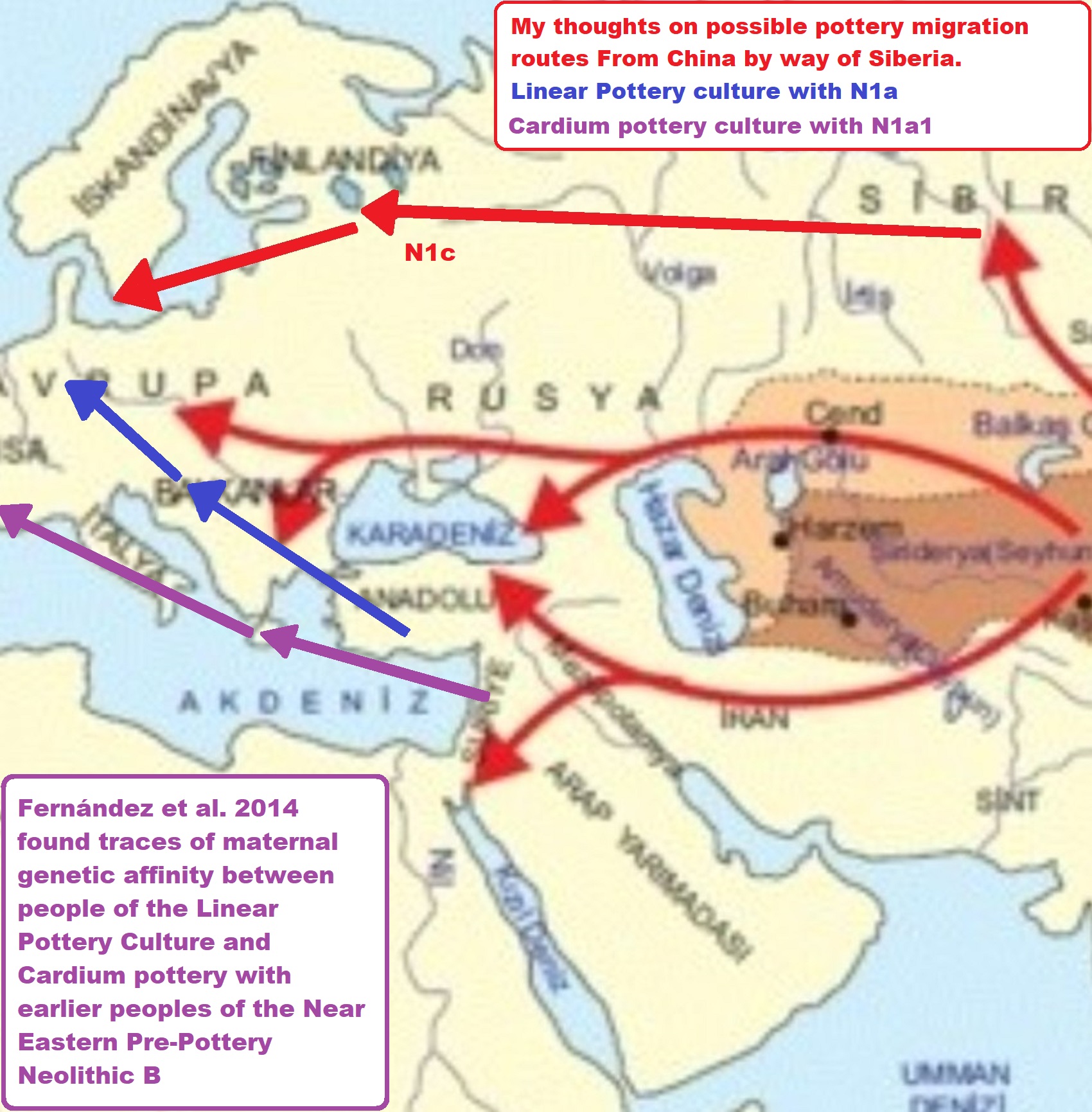
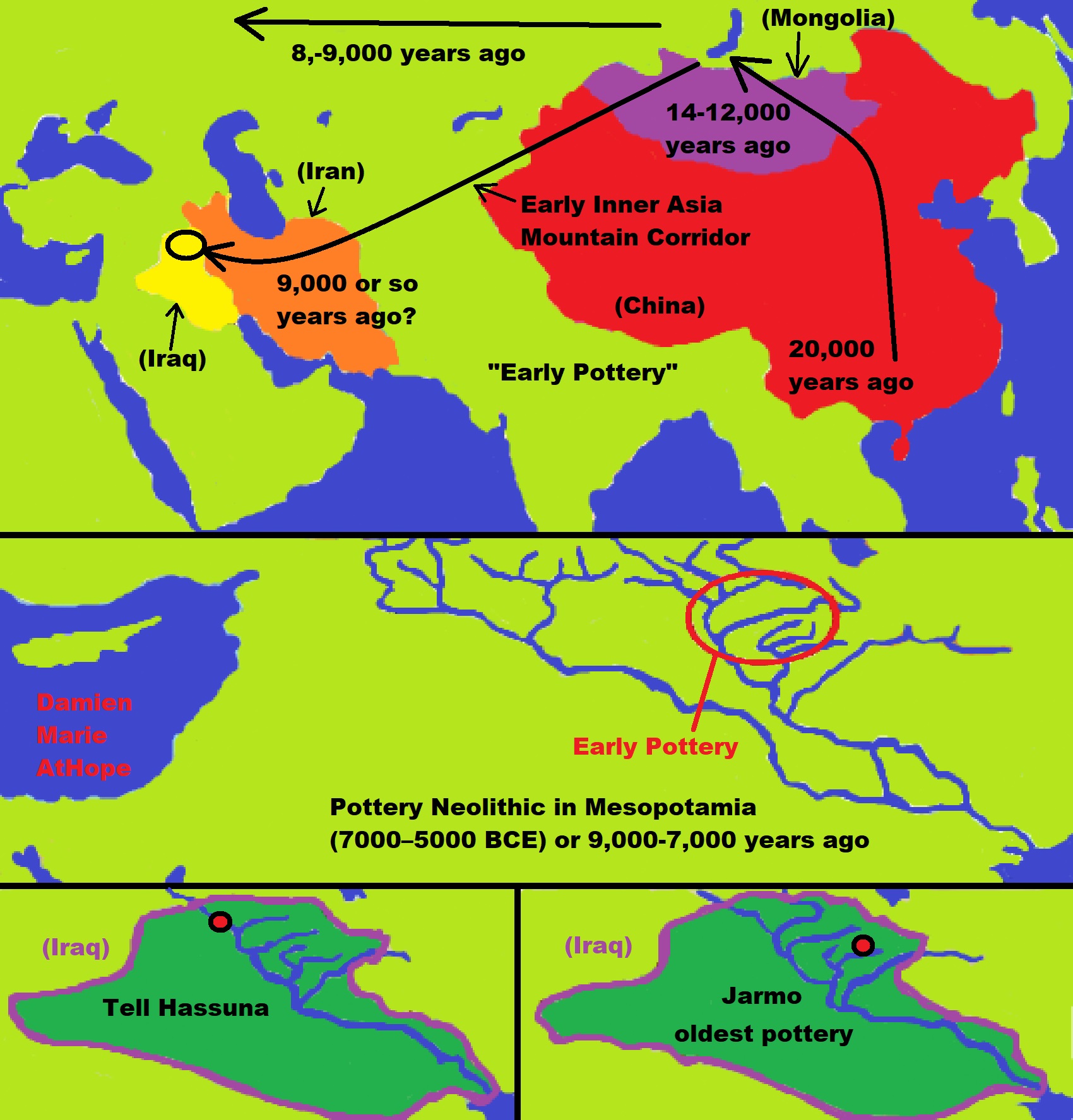
ref, ref, ref, ref, ref, ref, ref, ref, ref
“Location of important archaeological sites in the Fertile Crescent: 1 – Chogha Golan, 2 – Ali Kosh, 3 – Chia Sabz, 4 – Ganj Dareh Tepe, 5 – Sheikh-e Abad, 6 – Jani, 7 – Tepe Abdul Hosein, 8 – M’lefaat, 9 – Nemrik, 10 – Qermez Dere, 11 – Magzalia, 12 – Körtik Tepe, 13 – Hallan Cemi, 14 – Cayonu, 15 – Cafer Hoyuk, 16 – Asikli Hoyuk, 17 – Can Hasan III, 18 – Nevali Cori, 19 – Göbekli Tepe, 20 – Akarcay Tepe, 21 – Djade, 22 – Halula, 23 – Jerf el Ahmar, 24 – Mureybet, 25 – Abu Hureyra, 26 – El Kowm I and II, 27 – Bouqras, 28 – Abr, 29 – Qaramel, 30 – Tell Ras Shamra, 31 – Kissonerga, 32 – Parekklisha-Shillourokambos, 33 – Tell Ghoraifé, 34 – Tell Aswad, 35 – Tell Ramad, 36 – Yiftah’el, 37 – Iraq ed Dubb, 38 – Gilgal, 39 – ‘Ain Ghazal, 40 – Netiv Hagdud, 41 – Dhra, 42 – Jericho, 43 – Nahal Hemar, 44 – Wadi Fidan, 45 – Beidha, 46 – Basta, 47 – Dhuweila, 48 – Azraq 31, 49 – Wadi Jilat 7 (Simone Riehl et al)” ref
PPNA /PPNB /PPNC: “Beyond the Pre-pottery Neolithic B interaction sphere” by Eleni Asouti
PPNA /PPNB /PPNC: “Our Place: Our Place in the World. Newsletter. January 2014” by Lee Clare
Animal domestication: “Subsistence and beyond: Animals in Neolithic Anatolia” by Benjamin Arbuckle
“EARLY ANIMAL PRODUCTION FOR MARITAL TRADE: A NEOLITHIC BRIDE-PRICE?” by Cedric Bodet
Pre-Pottery Neolithic (10000 – 6500 BCE or 12,022-8,522 years ago)
“The Pre-Pottery Neolithic (PPN) represents the early Neolithic in the Levantine and upper Mesopotamian region of the Fertile Crescent, dating to c. 12,000 – c. 8,500 years ago, (10000 – 6500 BCE). It succeeds the Natufian culture of the Epipalaeolithic Near East (also called Mesolithic), as the domestication of plants and animals was in its formative stages, having possibly been induced by the Younger Dryas. The Pre-Pottery Neolithic culture came to an end around the time of the 8.2-kiloyear event, a cool spell centered on 6200 BCE that lasted several hundred years. It is succeeded by the Pottery Neolithic, also known as the Late Neolithic, or the Ceramic Neolithic” ref
“The time period is characterized by tiny circular mud-brick dwellings, the cultivation of crops, the hunting of wild game, and unique burial customs in which bodies were buried below the floors of dwellings. The Pre-Pottery Neolithic A and the following Pre-Pottery Neolithic B (PPNB) were originally defined by Kathleen Kenyon in the type site of Jericho (Palestine). During this time, pottery was not yet in use. They precede the ceramic Neolithic (Yarmukian). PPNA succeeds the Natufian culture of the Epipaleolithic (Mesolithic).” ref
“PPNA archaeological sites are much larger than those of the preceding Natufian hunter-gatherer culture, and contain traces of communal structures, such as the famous Tower of Jericho. PPNA settlements are characterized by round, semi-subterranean houses with stone foundations and terrazzo-floors. The upper walls were constructed of unbaked clay mudbricks with plano-convex cross-sections. The hearths were small and covered with cobbles. Heated rocks were used in cooking, which led to an accumulation of fire-cracked rock in the buildings, and almost every settlement contained storage bins made of either stones or mud-brick.” ref
“As of 2013 Gesher, modern Israel, became the earliest known of all known Neolithic sites (PPNA), with a calibrated Carbon 14 date of 10,459 BCE ± 348 years, analysis suggesting that it may have been the starting point of a Neolithic revolution. A contemporary site is Mureybet in modern Syria. One of the most notable PPNA settlements is Jericho, thought to be the world’s first town (c. 9,000 BCE).” ref
“The PPNA town contained a population of up to 2,000–3,000 people and was protected by a massive stone wall and tower. There is much debate over the function of the wall, for there is no evidence of any serious warfare at this time. One possibility is the wall was built to protect the salt resources of Jericho. It has also been proposed that the tower caught the shadow of the largest nearby mountain on summer solstice in order to create a sense of power in support of whatever hierarchy ruled the town’s inhabitants.” ref
“PPNA cultures are unique for their burial practices, and Kenyon (who excavated the PPNA level of Jericho) characterized them as “living with their dead”. Kenyon found no fewer than 279 burials, below floors, under household foundations, and in between walls. In the PPNB period, skulls were often dug up and reburied, or mottled with clay and (presumably) displayed. The lithic industry is based on blades struck from regular cores. Sickle-blades and arrowheads continue traditions from the late Natufian culture, transverse-blow axes, and polished adzes appear for the first time.” ref
“Sedentism of this time allowed for the cultivation of local grains, such as barley and wild oats, and for storage in granaries. Sites such as Dhra′ and Jericho retained a hunting lifestyle until the PPNB period, but granaries allowed for year-round occupation. This period of cultivation is considered “pre-domestication“, but may have begun to develop plant species into the domesticated forms they are today. Deliberate, extended-period storage was made possible by the use of “suspended floors for air circulation and protection from rodents”. This practice “precedes the emergence of domestication and large-scale sedentary communities by at least 1,000 years.” ref
“Granaries are positioned in places between other buildings early on c. 11,522 years ago, however, beginning around 10,522 years ago, they were moved inside houses, and by 9,522 years ago storage occurred in special rooms. This change might reflect changing systems of ownership and property as granaries shifted from communal use and ownership to become under the control of households or individuals.” ref
“It has been observed of these granaries that their “sophisticated storage systems with subfloor ventilation are a precocious development that precedes the emergence of almost all of the other elements of the Near Eastern Neolithic package—domestication, large scale sedentary communities, and the entrenchment of some degree of social differentiation”. Moreover, “[b]uilding granaries may […] have been the most important feature in increasing sedentism that required active community participation in new life-ways.” ref
“With more sites becoming known, archaeologists have defined a number of regional variants of Pre-Pottery Neolithic A:
- (Aswadian) in the Damascus Basin, defined by finds from Tell Aswad IA; typical: bipolar cores, big sickle blades, Aswad points. The ‘Aswadian’ variant recently was abolished by the work of Danielle Stordeur in her initial report from further investigations in 2001–2006. The PPNB horizon was moved back at this site, to around 10,722 years ago.
- Mureybetian in the Northern Levant, defined by the finds from Mureybet IIIA, IIIB, typical: Helwan points, sickle-blades with base amenagée or short stem and terminal retouch. Other sites include Sheyk Hasan and Jerf el Ahmar.
- Sites in “Upper Mesopotamia” include Çayönü and Göbekli Tepe, with the latter possibly being the oldest ritual complex yet discovered.
- Sites in central Anatolia that include the ‘mother city’ Çatalhöyük and the smaller, but older site, rivaling even Jericho in age, Aşıklı Höyük.
- Sultanian in the Jordan River valley and the southern Levant, with the type site of Jericho. Other sites include Netiv HaGdud, El-Khiam, Hatoula, and Nahal Oren.” ref
Pre-Pottery Neolithic A (8800 – 6500 BCE or 12,022-8,822 years ago)
“The Pre-Pottery Neolithic is divided into Pre-Pottery Neolithic A (PPNA 10000 – 8800 BCE) and the following Pre-Pottery Neolithic B (PPNB 8800 – 6500 BCE). These were originally defined by Kathleen Kenyon in the type site of Jericho (Palestine). The Pre-Pottery Neolithic precedes the ceramic Neolithic (Yarmukian culture, 6400 – 6200 BCE). At ‘Ain Ghazal, in Jordan, the culture continued a few more centuries as the so-called Pre-Pottery Neolithic C culture. Around 11000 years ago (9000 BCE), during the Pre-Pottery Neolithic A (PPNA), the world’s first town, Jericho, appeared in the Levant.” ref
Pre-Pottery Neolithic B (8800 – 6500 BCE or 10,822-8,522 years ago)
“The Pre-Pottery Neolithic is divided into Pre-Pottery Neolithic A (10000 – 8800 BCE) and the following Pre-Pottery Neolithic B (8800 – 6500 BCE). PPNB differed from PPNA in showing greater use of domesticated animals, a different set of tools, and new architectural styles.” ref
“Like the earlier PPNA people, the PPNB culture developed from the Mesolithic Natufian culture. However, it shows evidence of a northerly origin, possibly indicating an influx from the region of northeastern Anatolia. Cultural tendencies of this period differ from that of the earlier Pre-Pottery Neolithic A (PPNA) period in that people living during this period began to depend more heavily upon domesticated animals to supplement their earlier mixed agrarian and hunter-gatherer diet.” ref
“In addition, the flint tool kit of the period is new and quite disparate from that of the earlier period. One of its major elements is the naviform core. This is the first period in which architectural styles of the southern Levant became primarily rectilinear; earlier typical dwellings were circular, elliptical, and occasionally even octagonal. Pyrotechnology, the expanding capability to control fire, was highly developed in this period. During this period, one of the main features of houses is a thick layer of white clay plaster flooring, highly polished and made of lime produced from limestone.” ref
“It is believed that the use of clay plaster for floor and wall coverings during PPNB led to the discovery of pottery. The earliest proto-pottery was White Ware vessels, made from lime and gray ash, built up around baskets before firing, for several centuries around 7000 BCE at sites such as Tell Neba’a Faour (Beqaa Valley). Sites from this period found in the Levant utilizing rectangular floor plans and plastered floor techniques were found at Ain Ghazal, Yiftahel (western Galilee), and Abu Hureyra (Upper Euphrates). The period is dated between c. 10,722-8,022 years ago.” ref
“Plastered human skulls were reconstructed human skulls that were made in the ancient Levant between 9000 and 6000 BCE in the Pre-Pottery Neolithic B period. They represent some of the oldest forms of art in the Middle East and demonstrate that the prehistoric population took great care in burying their ancestors below their homes. The skulls denote some of the earliest sculptural examples of portraiture in the history of art.” ref
“Danielle Stordeur‘s recent work at Tell Aswad, a large agricultural village between Mount Hermon and Damascus could not validate Henri de Contenson‘s earlier suggestion of a PPNA Aswadian culture. Instead, they found evidence of a fully established PPNB culture at 8700 BCE at Aswad, pushing back the period’s generally accepted start date by 1,200 years. Similar sites to Tell Aswad in the Damascus Basin of the same age were found at Tell Ramad and Tell Ghoraifé. How a PPNB culture could spring up in this location, practicing domesticated farming from 8700 BCE has been the subject of speculation. Whether it created its own culture or imported traditions from the North East or Southern Levant has been considered an important question for a site that poses a problem for the scientific community.” ref
“Work at the site of ‘Ain Ghazal in Jordan has indicated a later Pre-Pottery Neolithic C period, which existed between 8,222-7,922 years ago. Juris Zarins has proposed that a Circum Arabian Nomadic Pastoral Complex developed in the period from the climatic crisis of 6200 BCE, partly as a result of an increasing emphasis in PPNB cultures upon animal domesticates, and a fusion with Harifian hunter-gatherers in Southern Palestine, with affiliate connections with the cultures of Fayyum and the Eastern Desert of Egypt. Cultures practicing this lifestyle spread down the Red Sea shoreline and moved east from Syria into southern Iraq.” ref
The culture disappeared during the 8.2 kiloyear event, a term that climatologists have adopted for a sudden decrease in global temperatures that occurred approximately 8,200 years before the present, or c. 6200 BCE, and which lasted for the next two to four centuries. In the following Munhatta and Yarmukian post-pottery Neolithic cultures that succeeded it, rapid cultural development continues, although PPNB culture continued in the Amuq valley, where it influenced the later development of the Ghassulian culture.” ref
“Around 8000 BCE, before the invention of pottery, several early settlements became experts in crafting beautiful and highly sophisticated containers from stone, using materials such as alabaster or granite, and employing sand to shape and polish. Artisans used the veins in the material to the maximum visual effect. Such objects have been found in abundance on the upper Euphrates river, in what is today eastern Syria, especially at the site of Bouqras. These form the early stages of the development of the Art of Mesopotamia.” ref
“Pre-Pottery Neolithic B fossils that were analysed for ancient DNA were found to carry the Y-DNA (paternal) haplogroups E1b1b (2/7; ~29%), CT (2/7; ~29%), E(xE2,E1a,E1b1a1a1c2c3b1,E1b1b1b1a1,E1b1b1b2b) (1/7; ~14%), T(xT1a1,T1a2a) (1/7; ~14%), and H2 (1/7; ~14%). The CT clade was also observed in a Pre-Pottery Neolithic C specimen (1/1; 100%). Maternally, the rare basal haplogroup N* has been found among skeletal remains belonging to the Pre-Pottery Neolithic B, as have the mtDNA clades L3 and K.” ref
Haplogroup N and its related Uralic Languages and Cultures
DNA analysis has also confirmed ancestral ties between the Pre-Pottery Neolithic culture bearers and the makers of the Epipaleolithic Iberomaurusian culture of North Africa, the Mesolithic Natufian culture of the Levant, the Savanna Pastoral Neolithic culture of East Africa, the Early Neolithic Cardium culture of Morocco, and the Ancient Egyptian culture of the Nile Valley, with fossils associated with these early cultures all sharing a common genomic component.” ref
Pre-Pottery Neolithic C
“Work at the site of ‘Ain Ghazal in Jordan has indicated a later Pre-Pottery Neolithic C period. Juris Zarins has proposed that a Circum Arabian Nomadic Pastoral Complex developed in the period from the climatic crisis of 6200 BCE, partly as a result of an increasing emphasis in PPNB cultures upon domesticated animals, and a fusion with Harifian hunter-gatherers in the Southern Levant, with affiliate connections with the cultures of Fayyum and the Eastern Desert of Egypt. Cultures practicing this lifestyle spread down the Red Sea shoreline and moved east from Syria into southern Iraq.” ref
Pottery Neolithic (7000–5000 BCE)
“In the archaeology of Southwest Asia, the Late Neolithic, also known as the Ceramic Neolithic or Pottery Neolithic, is the final part of the Neolithic period, following on from the Pre-Pottery Neolithic and preceding the Chalcolithic. It is sometimes further divided into Pottery Neolithic A (PNA) and Pottery Neolithic B (PNB) phases. The Late Neolithic began with the first experiments with pottery, around 7000 BCE, and lasted until the discovery of copper metallurgy and the start of the Chalcolithic around 4500 BCE.” ref
“First experiments with pottery (c. 7000 BCE) with a Pottery bowl from Jarmo, Mesopotamia, 7100-5800 BCE. The northern Mesopotamian sites of Tell Hassuna and Jarmo are some of the oldest sites in the Near-East where pottery has been found, appearing in the most recent levels of excavation, which dates it to the 7th millennium BCE. This pottery is handmade, of simple design and with thick sides, and treated with a vegetable solvent. There are clay figures, zoomorphic or anthropomorphic, including figures of pregnant women which are taken to be fertility goddesses, similar to the Mother Goddess of later Neolithic cultures in the same region.” ref
“The Neolithic of the Southern Levant is divided into Pre-Pottery and Pottery or Late Neolithic phases, initially based on the sequence established by Kathleen Kenyon at Jericho. In the Mediterranean zone, the Pottery Neolithic is further subdivided into two subphases and several regional cultures, although the extent to which these represent real cultural phenomena is debated:
- Pottery Neolithic A (PNA) or Late Neolithic 1 (LN1)Yarmukian culture
Lodian (Jericho IX) culture - Pottery Neolithic B (PNB) or Late Neolithic 2 (LN2)Wadi Rabah culture” ref
“In the eastern desert regions of the Southern Levant—the Badia—the whole period is referred to as the Late Neolithic (c. 7000–5000 BCE). It is marked by the appearance of the first pastoralist societies in the desert, who may have migrated there following the abandonment of the large PPNB settlements to the west. In the southern Negev and Sinai Deserts, the Late Neolithic is characterized by the pastoralist Timnian culture, which persisted through to the Bronze Age.” ref
“The Late Neolithic began around 6,400 BCE in the Fertile Crescent, succeeding the period of the Pre-Pottery Neolithic. By then distinctive cultures emerged, with pottery like the Halafian (Turkey, Syria, Northern Mesopotamia) and Ubaid (Southern Mesopotamia).” ref
Tell Hassuna
“Tell Hassuna is a tell, or settlement mound, in the Nineveh Province (Iraq), about 35km south-west of Nineveh. It is the type site for the Hassuna culture (early sixth millennium BCE). Excavations revealed that there was once an advanced village culture that was spread throughout northern Mesopotamia. At Hassuna, six different layers of houses were uncovered, revealing various vessels and pottery that date ~5600-5350 BCE, with each layer becoming more substantial. Similar vessels were found throughout the Middle East, showing that there was an extensive trade network that was present as early as the 6th Millennium BCE.” ref
“Tell Hassuna is located approximately 35 kilometers (22 mi) southwest of modern Mosul, along the west bank of the Tigris River. It is a small site, roughly 200 by 150 meters (660 ft × 490 ft) and about 7 meters (23 ft) high. Hassuna was one of the earliest cultures in Northern Mesopotamia. Before this time, Southern Mesopotamia was considered the cradle of civilization. When settlements began forming in the north, such as Hassuna, Jarmo, Samarra, and Tell Halaf, the north became the important region. The architecture at Hassuna was built of packed mud, with the width varying from 20 to 50 centimeters. The mud-brick technique may perhaps have been developed in Southern Mesopotamia, where mud-bricks were common in the first half of the 6th millennium BCE.” ref
“Around 6,000 BCE, people began moving to the foothills of northern Mesopotamia and practicing methods of dry agriculture. These people were the first known farmers, and Hassuna became one of the most ancient centers for the principal forms of producing economies, such as the cultivation of soil and raising livestock. Evidence of this is shown in the oldest layers of Hassuna. The occupants of Hassuna also led the way in improving agriculture, settling the river valleys, the beginning of irrigation, and progress in all branches of production and culture.” ref
“Around 6,000 BCE, at Tell Hassuna, adobe dwellings were built around open central courts; fine painted pottery was replacing the crude pottery of the earlier levels. Hand axes, sickles, grinding stones, bins, baking ovens, and numerous bones of domesticated animals reflect settled agricultural life. Stone tools found at Tell Hassuna do not seem to be as advanced as tools found at other sites of the Hassuna culture, such as Jarmo, and were typically made of flint and obsidian. Female figurines were also used in relation to worship and jar burials, within which food was placed due to belief in the afterlife.” ref
“Pottery found at Hassuna can be divided into three different categories: Hassuna Archaic, Hassuna Standard, and Samarran. These also include painted, incised, and painted-incised ware. The decoration of the Samarra Painted Fine Ware is always monochrome, but it seems as if three types of paint have been used: an ivory black, a dark violet brown, and a medium chocolate brown. Circumstances of firing and variations in the concentration of the paint have caused color changes, so that for example an oxidizing firing of vessels painted with ivory black has produced an Indian red color.” ref
“In general, the designs of the Samarra Painted Fine Ware are carefully painted. Occasionally, however, parallel lines approach or diverge slightly, and the thickness of some lines varies, apparently due to the use of a soft painting-brush. The outside rim motifs are spaced and limited by groups of horizontal lines.” ref
Jarmo
“Jarmo (Qal’at Jarmo) (Kurdish: Çermo) is a prehistoric archeological site located in modern Iraq on the foothills of the Zagros Mountains. It lies at an altitude of 800 m above sea-level in a belt of oak and pistachio woodlands in the Adhaim River watershed. Excavations revealed that Jarmo was an agricultural community dating back to 7090 BCE. It was broadly contemporary with such other important Neolithic sites such as Jericho in the Southern Levant and Çatal Hüyük in Anatolia.” ref
“The excavations exposed a small village, covering an area of 12,000 to 16,000 m2, and which has been dated (by carbon-14) to 7090 BCE, for the oldest levels, to 4950 BCE for the most recent. The entire site consists of twelve levels. Jarmo appears to be two older, permanent Neolithic settlements and, approximately, contemporary with Jericho or the Neolithic stage of Shanidar. The high point is likely to have been between 6,200 and 5,800 BCE. This small village consisted of some twenty-five houses, with adobe walls and sun-dried mud roofs, which rested on stone foundations, with a simple floor plan dug from the earth.” ref
“These dwellings were frequently repaired or rebuilt. In all, about 150 people lived in the village, which was clearly a permanent settlement. In the earlier phases, there is a preponderance of objects made from stone, silex—using older styles—and obsidian. The use of this latter material, obtained from the area of Lake Van, 200 miles away, suggests that some form of organized trade already existed, as does the presence of ornamental shells from the Persian Gulf. In the oldest level baskets have been found, waterproofed with pitch, which is readily available in the area.” ref
“Agricultural activity is attested by the presence of stone sickles, cutters, bowls and other objects, for harvesting, preparing and storing food, and also by receptacles of engraved marble. In the later phases instruments made of bone, particularly perforating tools, buttons, and spoons, have been found. Further research has shown that the villagers of Jarmo grew wheat of two types, emmer, and einkorn, a type of primitive barley and lentils (it is common to record the domestication of grains, less so of pulses). Their diet, and that of their animals, also included species of wild plants, peas, acorns, carob seeds, pistachios, and wild wheat. Snail shells are also abundant. There is evidence that they had domesticated goats, sheep, and dogs. On the higher levels of the site, pigs have been found, together with the first evidence of pottery.” ref
“Jarmo is one of the oldest sites at which pottery has been found, appearing in the most recent levels of excavation, which dates it to the 7th millennium BCE. This pottery is handmade, of simple design and with thick sides, and treated with a vegetable solvent. There are clay figures, zoomorphic or anthropomorphic, including figures of pregnant women which are taken to be fertility goddesses, similar to the Mother Goddess of later Neolithic cultures in the same region. These constitute the inception of the Art of Mesopotamia.” ref
Prehistory of Iran from Neolithic to Chalcolithic
“The prehistory of the Iranian plateau, and the wider region now known as Greater Iran. Some nearby and more constantly occupied settlements in the Zagros date from a short time after Asiab, from the time between 8,000 and 6,800 BC. Still, the material culture of Tappeh Ganj Dareh and Tappeh Abdul Hosein does not include any pottery. Thus this period is often called “aceramic Neolithic”. This is also true for the oldest levels of Tappeh Guran, located in Luristan, as well as for the sites of Ali Kosh and Chogha Sefid in the plain of Deh Luran, west of the Zagros Mountains. There, flocks of sheep and herds of goats were kept for the first time. Managing animals meant a fundamentally new orientation of the Neolithic inhabitants of Iran and must be understood to be connected with a whole number of other innovations, particularly the architecture of houses. We do not definitely know if in those days there was any cultivation of cereals. Tools for harvesting and for making cereal products are there, but remnants of burned grain are extremely rare.” ref
In the eighth millennium BCE, around 10,022 to 9,022 years ago. In chronological terms, it is the second full millennium of the current Holocene epoch and is entirely within the Pre-Pottery Neolithic B (PPNB) phase of the Early Neolithic. Agricultural communities such as Chogha Bonut (the earliest village in Susiana) started to form in western Iran, either as a result of indigenous development or of outside influences. Around about the same time the earliest known clay vessels and modeled human and animal terracotta figurines were produced at Ganj Dareh and Teppe Sarab, also in western Iran. The south-western part of Iran was part of the Fertile Crescent.” ref
“Early agricultural communities such as Chogha Golan in 10,000 BCE along with settlements such as Chogha Bonut (the earliest village in Elam) in 8000 BCE, began to flourish in and around the Zagros Mountains region in western Iran. Around about the same time, the earliest-known clay vessels and modeled human and animal terracotta figurines were produced at Ganj Dareh, also in western Iran. There are also 10,000-year-old human and animal figurines from Tepe Sarab in Kermanshah Province among many other ancient artifacts.” ref
“Some of the oldest agricultural ground has been discovered in Susa and south-western part of Iran was part of the Fertile Crescent where most of humanity’s first major crops were grown, in villages such as Susa (where a settlement was first founded possibly as early as 4395 cal BCE) and settlements such as Chogha Mish, dating back to 6800 BCE; there are 7,000-year-old jars of wine excavated in the Zagros Mountains and ruins of 7000-year-old settlements such as Tepe Sialk are further testament to that.” ref

Pic ref
Abstract
“Ancient genomes have revolutionized our understanding of Holocene prehistory and, particularly, the Neolithic transition in western Eurasia. In contrast, East Asia has so far received little attention, despite representing a core region at which the Neolithic transition took place independently ~3 millennia after its onset in the Near East. We report genome-wide data from two hunter-gatherers from Devil’s Gate, an early Neolithic cave site (dated to ~7.7 thousand years ago) located in East Asia, on the border between Russia and Korea. Both of these individuals are genetically most similar to geographically close modern populations from the Amur Basin, all speaking Tungusic languages, and, in particular, to the Ulchi. The similarity to nearby modern populations and the low levels of additional genetic material in the Ulchi imply a high level of genetic continuity in this region during the Holocene, a pattern that markedly contrasts with that reported for Europe.” ref
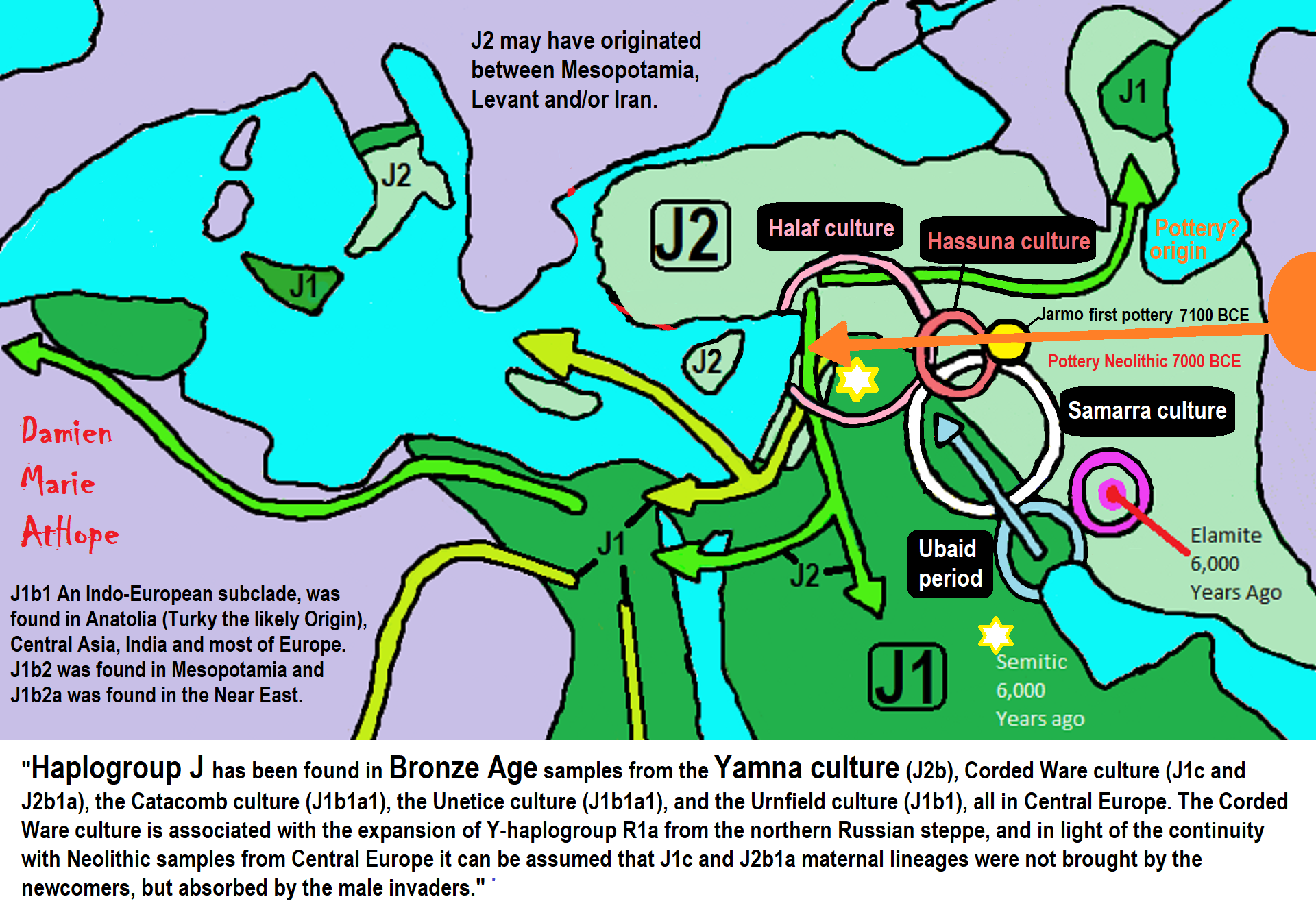


To me, ideas (farming, building, cattle worship/use, arcane paganism) move from Turkey to Iran to the “Inner Asian Mountain Corridor” and possibly up to the “Eurasian Steppe Corridor”, farming spread to China around 10,000 years ago or so.
“New Neolithic cult centers and domestic settlements in the light of Urfa Region Surveys: The study concerns Neolithic period cult centers and settlements discovered recently during surface surveys in the central district of Urfa (Sanlıurfa) region in south-eastern Turkey. The presence of T-shaped pillars was ascertained at Ayanlar Höyük and Kurt Tepesi cult sites. Other settlements are domestic settlements arranged around cult center settlements. Some sites belong to Pre Pottery Neolithic, and the others to Pottery Neolithic. They are believed to be coeval with Göbekli Tepe and Nevali Çori cult sites. Nineteen Neolithic sites were examined as a result of the studies conducted in the Urfa region, at Kurt Te-pesi, Guhera Abid Mevkii, Selamet Kuzey Mevkii, Se-lamet Kuzey Höyügü, Çam-çak Tepesi, Terzi Village Batı Mevkii, Sıluba Tepesi, Asagı Yazıcı Güney Mevkii, Mınzilit Feris, Mınzilit Hıleyil, Mınzilit I ·sa, KarakusKuzeybatı Mev-kii, Çillo Mevkii 1, Çillo Mev-kii 2, omuzcurnu Tepesi, Ne-bi Tarlası, Ömer AltundagTar-lası, Hasan Sırtı and Ayanlar Höyük, respectively.” ref
Neolithic cattle herders
“It has been hypothetised that R1b people (perhaps alongside neighbouring J2 tribes) were the first to domesticate cattle in northern Mesopotamia some 10,500 years ago. R1b tribes descended from mammoth hunters, and when mammoths went extinct, they started hunting other large game such as bisons and aurochs. With the increase of the human population in the Fertile Crescent from the beginning of the Neolithic (starting 12,000 years ago), selective hunting and culling of herds started replacing indiscriminate killing of wild animals. The increased involvement of humans in the life of aurochs, wild boars and goats led to their progressive taming. Cattle herders probably maintained a nomadic or semi-nomadic existence, while other people in the Fertile Crescent (presumably represented by haplogroups E1b1b, G and T) settled down to cultivate the land or keep smaller domesticates.” ref
“The analysis of bovine DNA has revealed that all the taurine cattle (Bos taurus) alive today descend from a population of only 80 aurochs. The earliest evidence of cattle domestication dates from circa 8,500 BCE in the Pre-Pottery Neolithic cultures in the Taurus Mountains. The two oldest archaeological sites showing signs of cattle domestication are the villages of Çayönü Tepesi in southeastern Turkey and Dja’de el-Mughara in northern Iraq, two sites only 250 km away from each others. This is presumably the area from which R1b lineages started expanding – or in other words the “original homeland” of R1b.” ref
“The early R1b cattle herders would have split in at least three groups. One branch (M335) remained in Anatolia, but judging from its extreme rarity today wasn’t very successful, perhaps due to the heavy competition with other Neolithic populations in Anatolia, or to the scarcity of pastures in this mountainous environment. A second branch migrated south to the Levant, where it became the V88 branch. Some of them searched for new lands south in Africa, first in Egypt, then colonising most of northern Africa, from the Mediterranean coast to the Sahel. The third branch (P297), crossed the Caucasus into the vast Pontic-Caspian Steppe, which provided ideal grazing grounds for cattle. They split into two factions: R1b1a1 (M73), which went east along the Caspian Sea to Central Asia, and R1b1a2 (M269), which at first remained in the North Caucasus and the Pontic Steppe between the Dnieper and the Volga. It is not yet clear whether M73 actually migrated across the Caucasus and reached Central Asia via Kazakhstan, or if it went south through Iran and Turkmenistan. In any case, M73 would be a pre-Indo-European branch of R1b, just like V88 and M335.” ref
“R1b-M269 (the most common form in Europe) is closely associated with the diffusion of Indo-European languages, as attested by its presence in all regions of the world where Indo-European languages were spoken in ancient times, from the Atlantic coast of Europe to the Indian subcontinent, which comprised almost all Europe (except Finland, Sardinia and Bosnia-Herzegovina), Anatolia, Armenia, European Russia, southern Siberia, many pockets around Central Asia (notably in Xinjiang, Turkmenistan, Tajikistan and Afghanistan), without forgetting Iran, Pakistan, northern India and Nepal. The history of R1b and R1a are intricately connected to each others.” ref


“This paper aims to uncover the evolutionary pattern of the ancient Chinese agricultural technology system that focused on land and water mobilizations from 8000 BCE to 1911 CE. Our findings show that agricultural technology in China transitioned through an extremely slow, S-shaped pathway, increasing only ten fold in over 8000 years. The technology system was initially driven by tangible tools (40% of growth), then by technological theories and practices that contributed more than 50% of growth. Its development was spatially inclined to the Yellow River then to the Yangtze River region, where over 45% of technologies were developed. This study provides an empirical baseline for comparative studies between pre-industrial and industrial technologies. Greater understanding of the mechanisms of technology development will be required to reorientate technology development for present and future generations.” ref

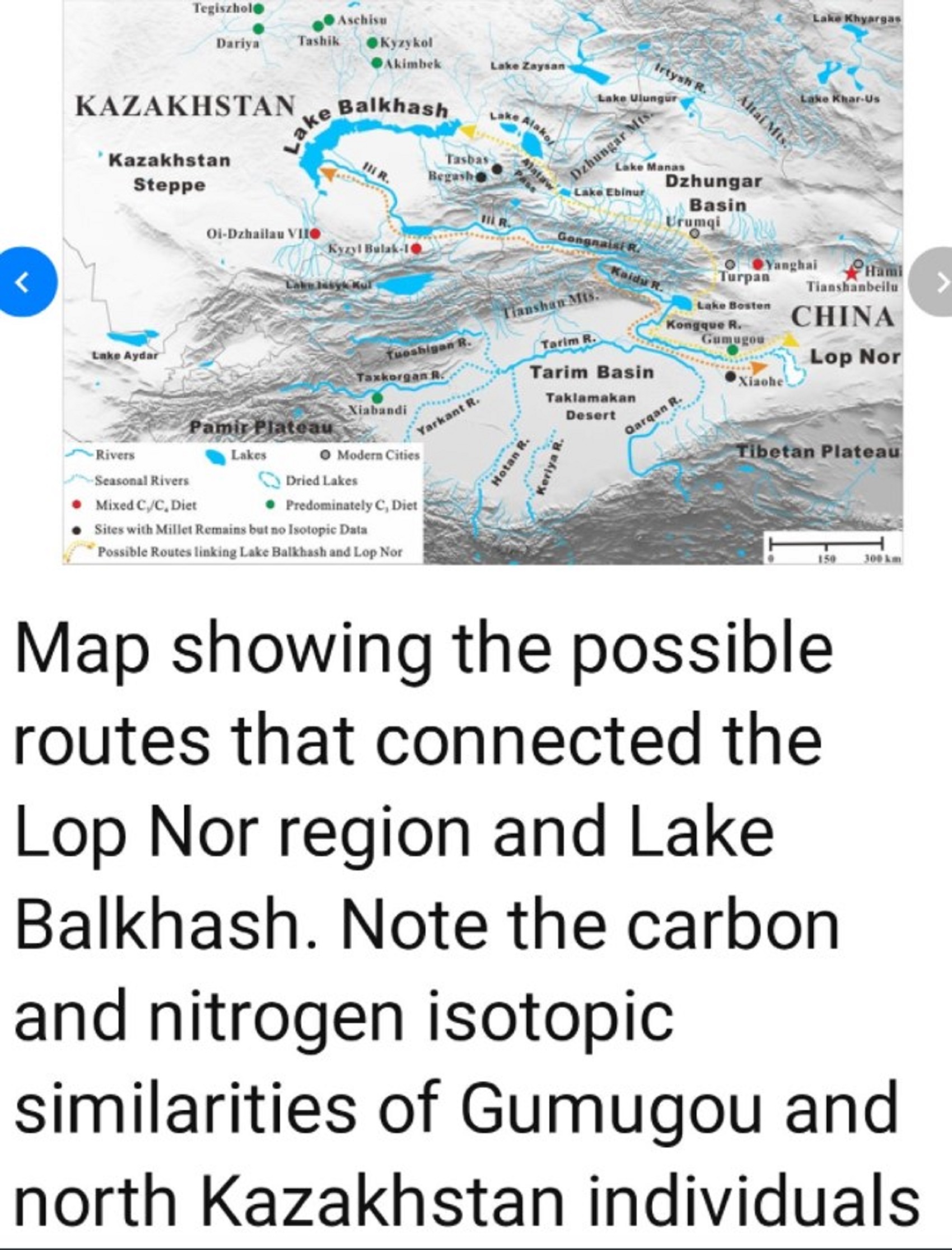
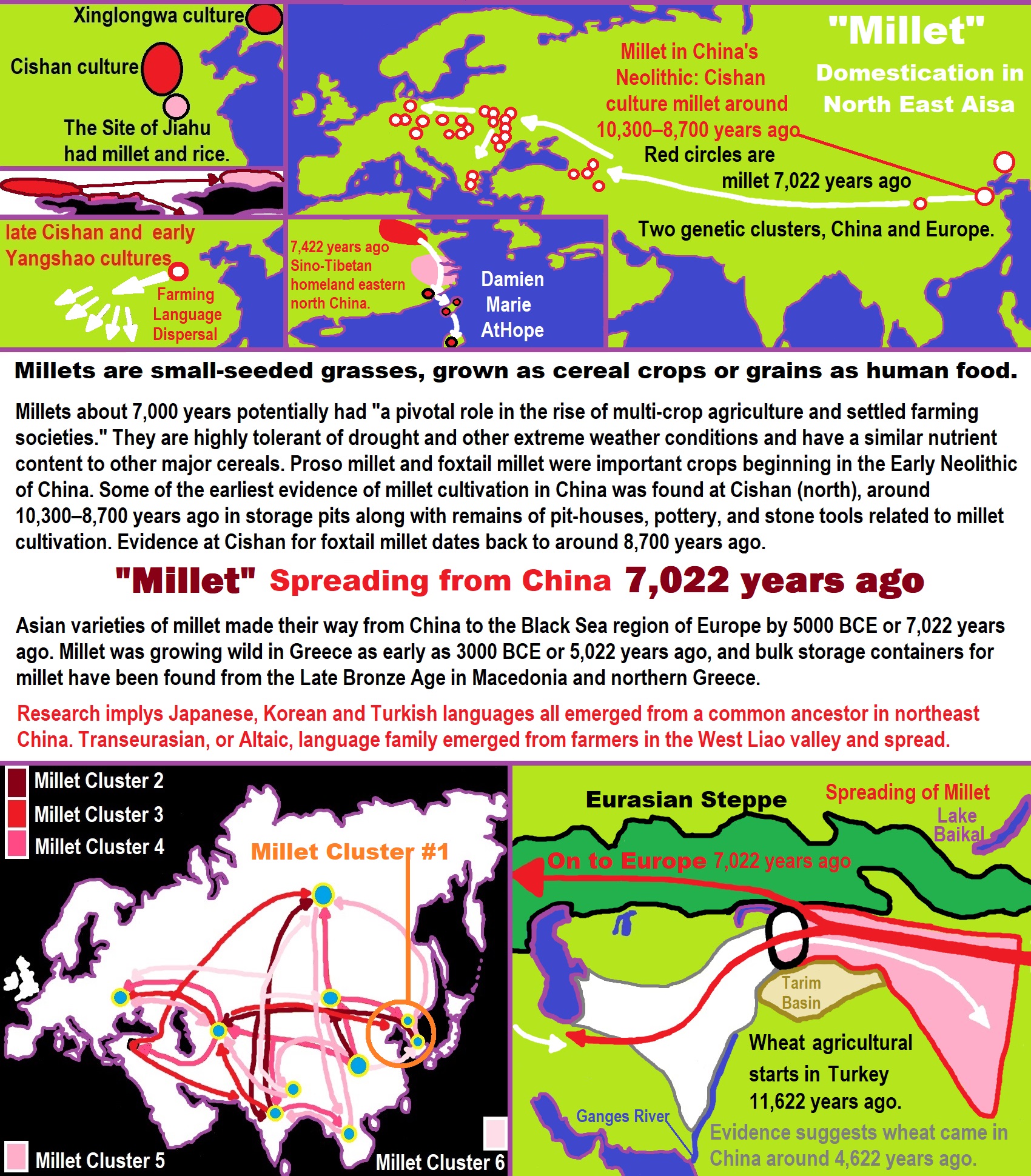
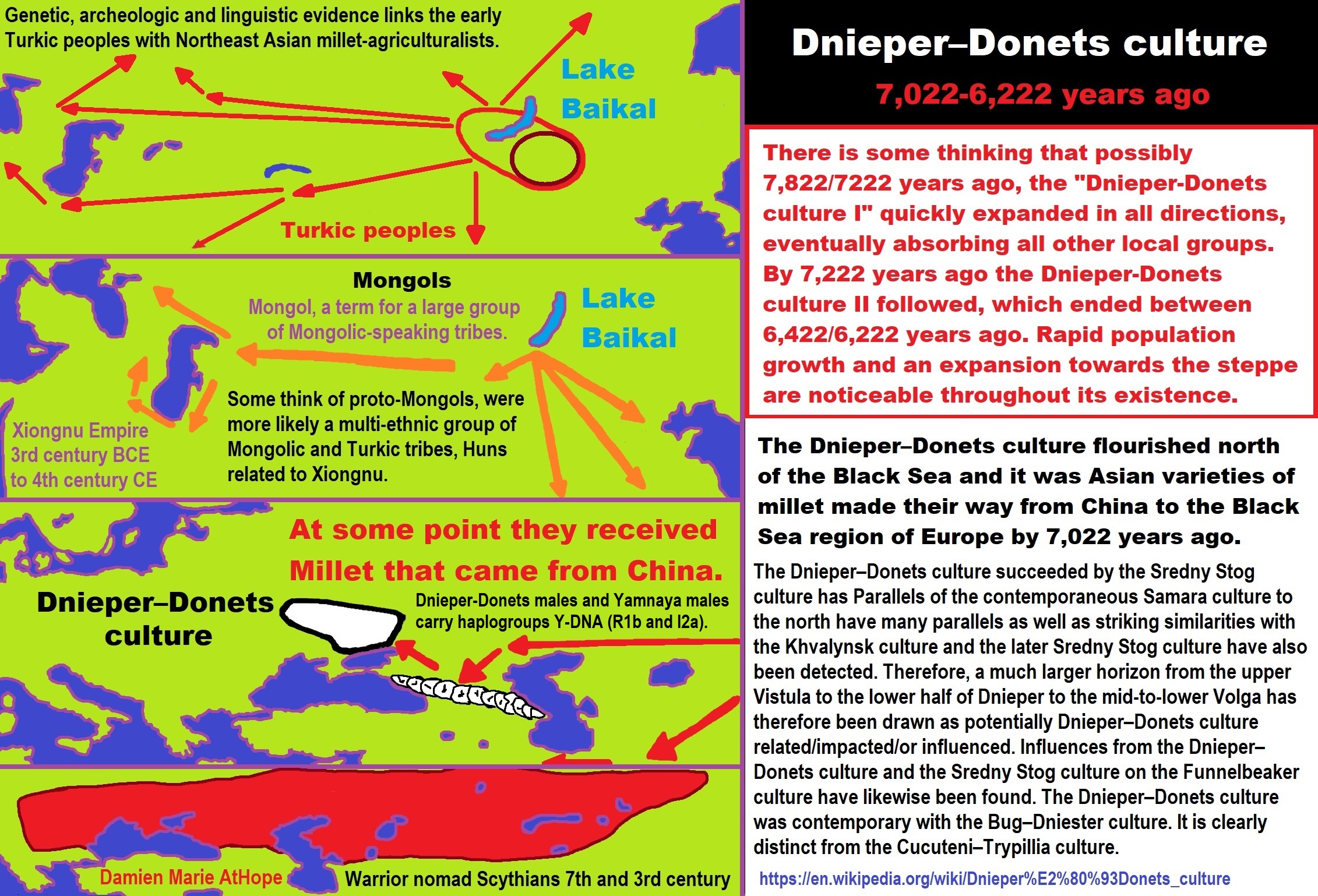
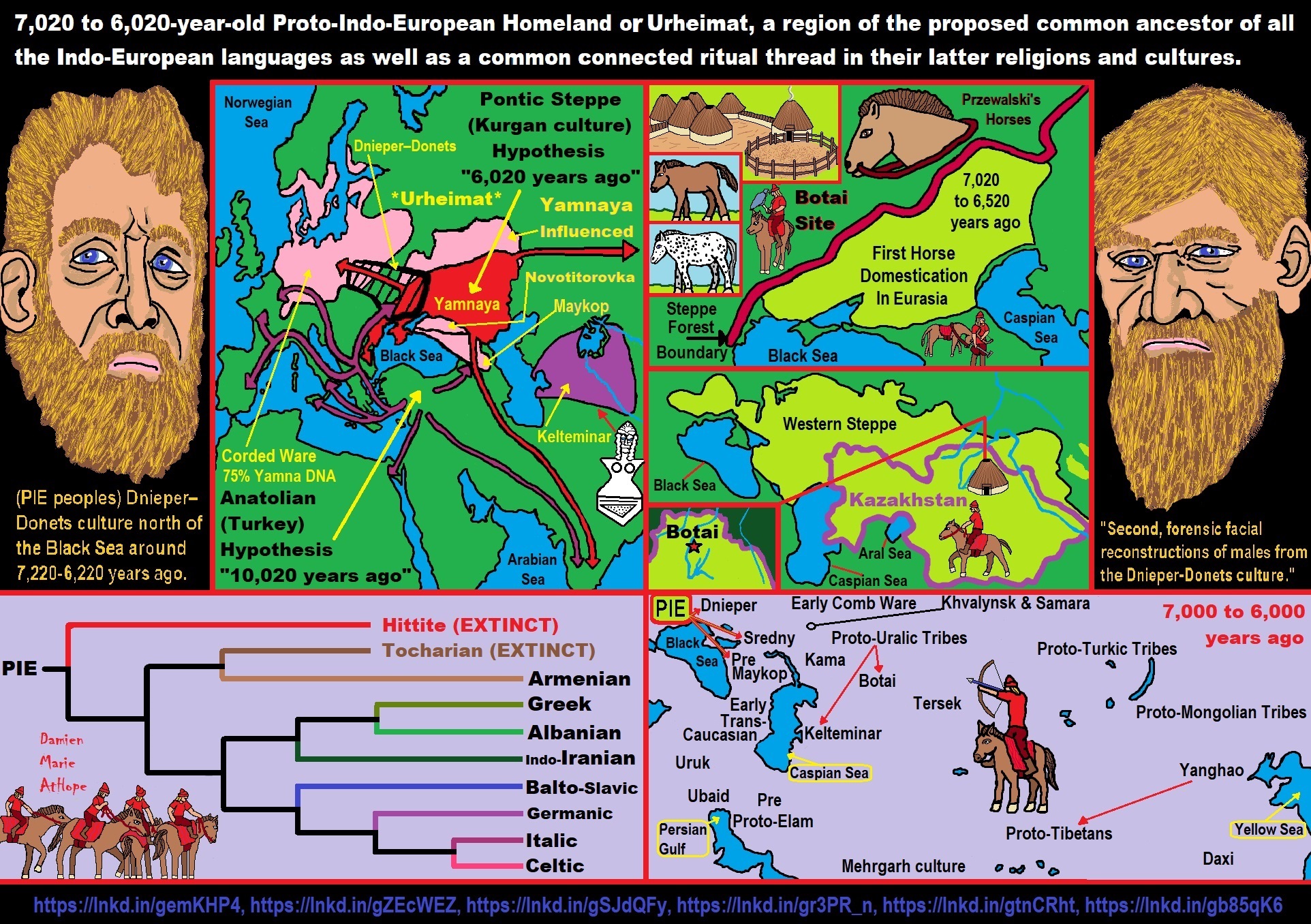
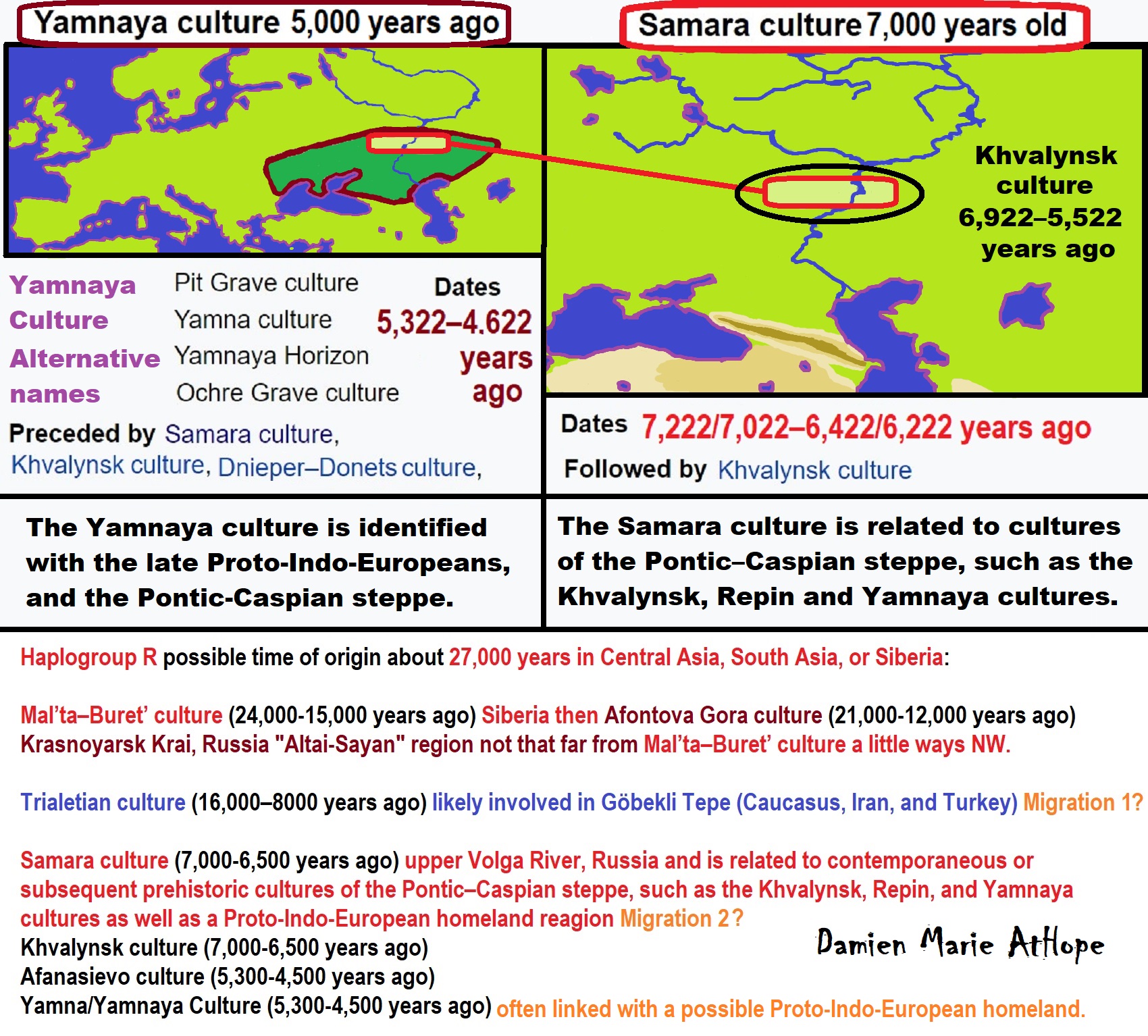

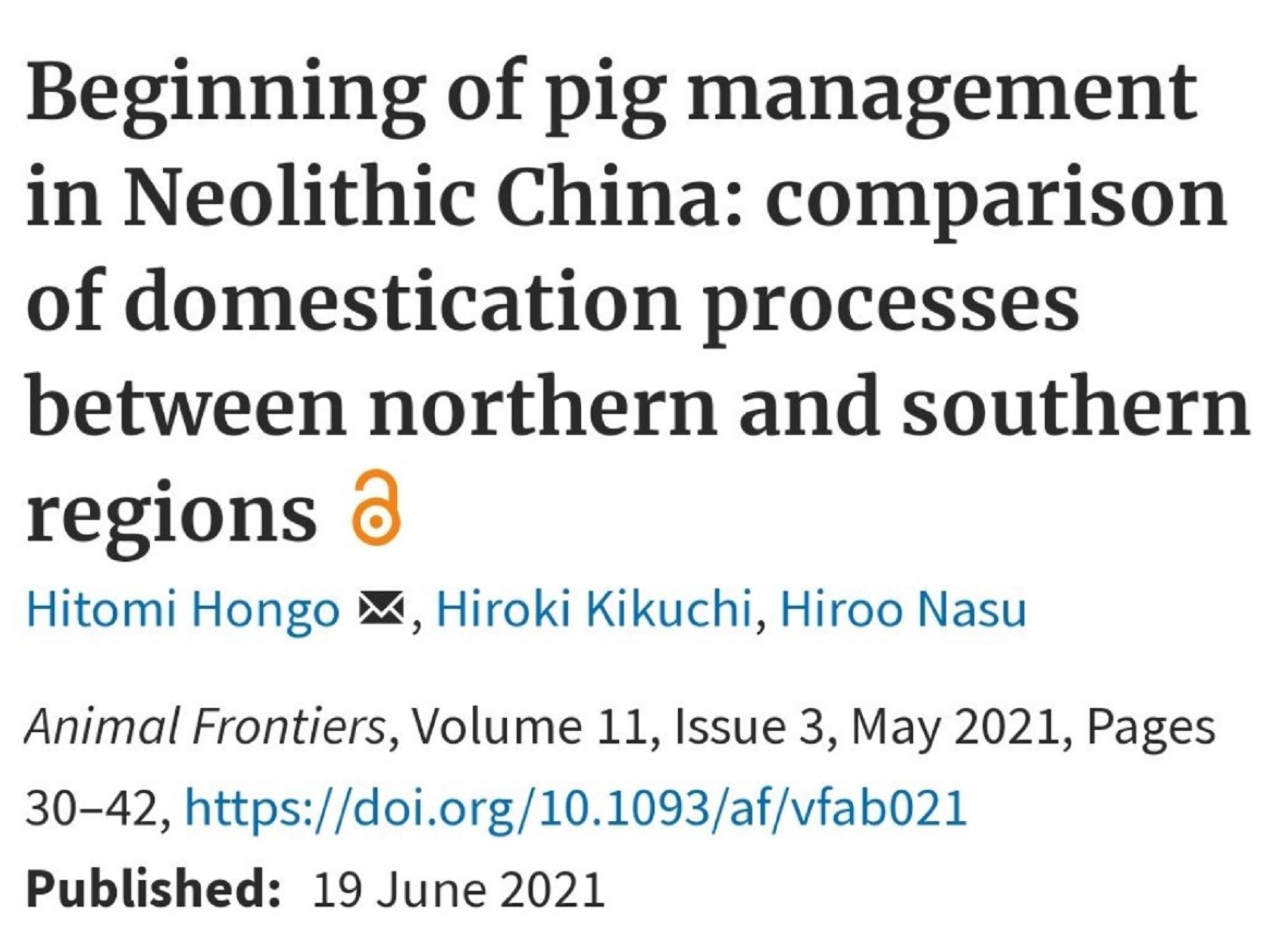
“China was one of the centers of the domestication of pigs. Morphological characteristics and pathological pieces of evidence found in pig bones excavated from Neolithic sites in the Yellow River Valley in the north, Yangtze River Valley in the south, and in the region between these two major river valleys suggest that management of pigs had begun around 9000 years ago, possibly in multiple places in China. Dietary analyses using carbon and nitrogen isotopes in the bone collagen of pigs indicate that a small number of pigs with C4 plants in their diet appeared in northern China in the Early Neolithic between 9,000 and 7,500 years ago.” ref
Separating the post-Glacial coancestry of European and Asian Y chromosomes within haplogroup R1a
“Human Y-chromosome haplogroup structure is largely circumscribed by continental boundaries. One notable exception to this general pattern is the young haplogroup R1a that exhibits post-Glacial coalescent times and relates the paternal ancestry of more than 10% of men in a wide geographic area extending from South Asia to Central East Europe and South Siberia.” ref
“Its origin and dispersal patterns are poorly understood as no marker has yet been described that would distinguish European R1a chromosomes from Asian. Here we present frequency and haplotype diversity estimates for more than 2000 R1a chromosomes assessed for several newly discovered SNP markers that introduce the onset of informative R1a subdivisions by geography.” ref
“Marker M434 has a low frequency and a late origin in West Asia bearing witness to recent gene flow over the Arabian Sea. Conversely, marker M458 has a significant frequency in Europe, exceeding 30% in its core area in Eastern Europe and comprising up to 70% of all M17 chromosomes present there. The diversity and frequency profiles of M458 suggest its origin during the early Holocene and a subsequent expansion likely related to a number of prehistoric cultural developments in the region.” ref
“Its primary frequency and diversity distribution correlates well with some of the major Central and East European river basins where settled farming was established before its spread further eastward. Importantly, the virtual absence of M458 chromosomes outside Europe speaks against substantial patrilineal gene flow from East Europe to Asia, including to India, at least since the mid-Holocene.” ref
“Human populations across the world are characterized by generally low genetic differences as compared with their intrapopulation variation. These differences can be quantitative, pronounced in different frequencies of the same derived states of ancient polymorphic markers (eg, majority of the HapMap markers), or qualitative, in which case younger derived variants are found restricted to a particular geographic region or population.” ref
“The Y-chromosome haplogroup structure frequently shows a good qualitative correlation with continental boundaries, and the geographic specificity of the markers can most often be explained by their phylogenetic descent order rather than by drift alone.” ref
“Recently evolved polymorphisms unless amplified by selection or specific founder effects tend to have low frequencies in modern populations, characterized generally by increased effective population sizes in the Holocene period. One of the notable outliers to this rule, because of its high frequency and young age, is the transcontinental spread of haplogroup R1a.” ref
“Early observations have led to various interpretations associating R1a phylogeography with certain cultural developments of the past. Even though R1a occurs as the most frequent Y-chromosome haplogroup among populations representing a wide variety of language groups, such as Slavic, Indo-Iranian, Dravidian, Turkic, and Finno-Ugric, many authors have been particularly interested in the link between R1a and the Indo-European language family.” ref
“For example, R1a frequency patterns have been discussed in the context of the purported link connecting Indo-European-speaking pastoralists and the archeological evidence on the distribution of the Kurgan culture in the Pontic steppe. A more precise interpretation of the underlying prehistoric and historic episodes of R1a chromosomes across this wide span of Eurasian geography remains largely unknown because of insufficient information on the phylogenetic subdivisions within haplogroup R1a.” ref
“We address this shortcoming here by analyzing more than 11 000 DNA samples from across Eurasia, including more than 2000 from haplogroup R1a to ascertain the phylogenetic information of the newly discovered R1a-related SNPs. We also examine the STR diversity of the associated R1a subclades to better understand the demographic history and prehistoric cultural associations of one of the most widely spread and frequent Y-chromosome haplogroups in the world with post-Last Glacial Maximum origin.” ref
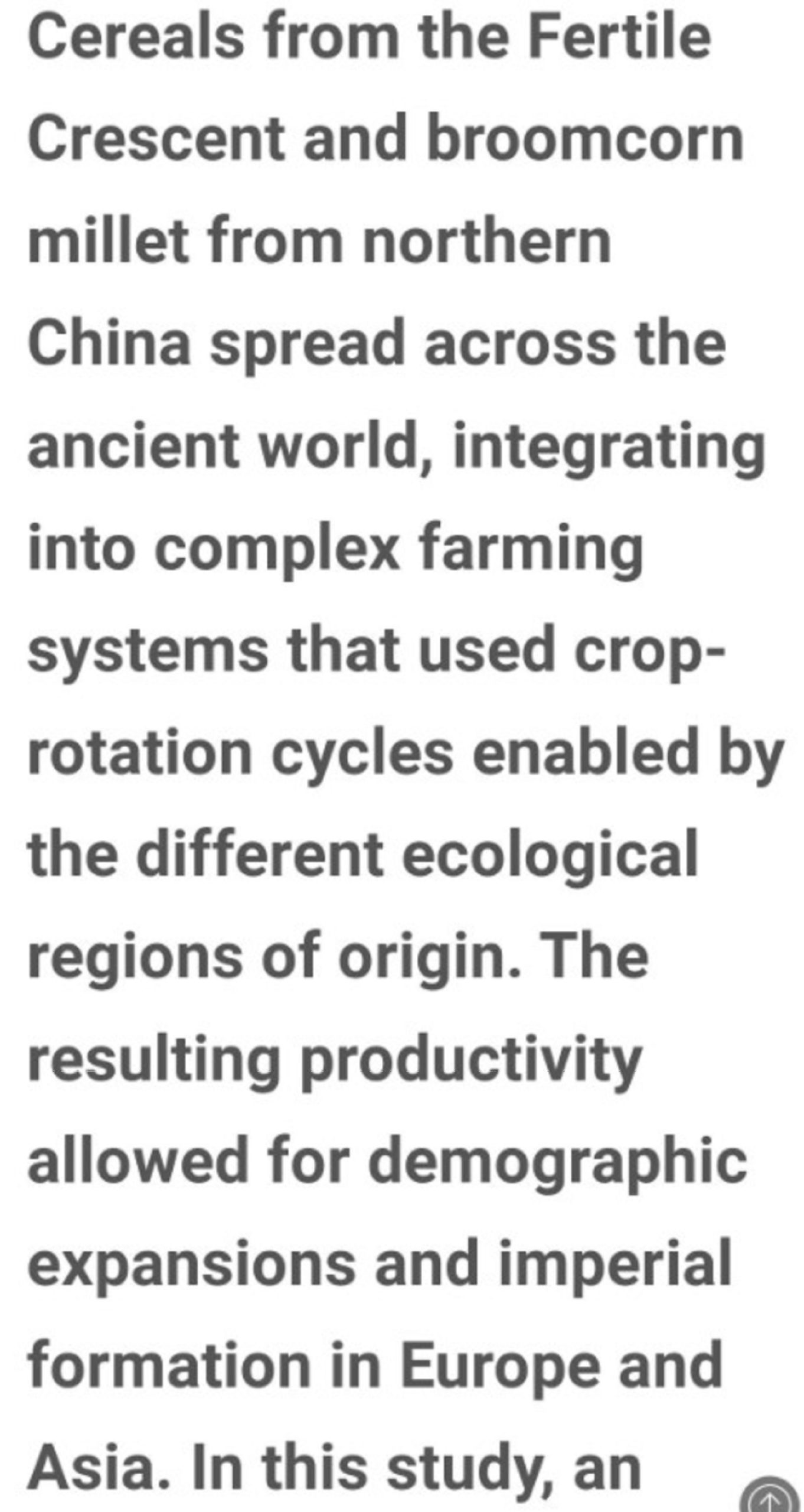
“Cereals from the Fertile Crescent and broomcorn millet from northern China spread across the ancient world, integrating into complex farming systems that used crop-rotation cycles enabled by the different ecological regions of origin. The resulting productivity allowed for demographic expansions and imperial formation in Europe and Asia. In this study, an international, interdisciplinary team of scientists illustrate that people moved these crops across Eurasia earlier than previously realized, adapting cultivation methods for harsh agricultural environments.” ref
“5200-Year-Old Cereal Grains From the Eastern Altai Mountains Predate the Trans-Eurasian Crop Exchange… Agricultural crops dispersed across Eurasia more than five millennia ago, causing significant cultural change in human populations across the ancient world. New discoveries in the Altai Mountains illustrate that this process occurred earlier than believed.” ref
“Most people are familiar with the historical Silk Road, but fewer people realize that the exchange of items, ideas, technology, and human genes through the mountain valleys of Central Asia started almost three millennia before organized trade networks formed. These pre-Silk Road exchange routes played an important role in shaping human cultural developments across Europe and Asia, and facilitated the dispersal of technologies such as horse breeding and metal smelting into East Asia.” ref
“One of the most impactful effects of this process of ancient cultural dispersal was the westward spread of northeast Asian crops and the eastward spread of southwest Asian crops. However, until the past few years, a lack of archaeobotanical studies in Central Asia left a dearth of data relating to when and how this process occurred.” ref
“This new study, led by scientists from the Chinese Academy of Sciences and the Max Planck Institute for the Science of Human History, provides details of recently recovered ancient grains from the far northern regions of Inner Asia. Radiocarbon dating shows that the grains include the oldest examples of wheat and barley ever recovered this far north in Asia, pushing back the dates for early farming in the region by at least a millennium.” ref
“These are also the earliest domesticated plants reported from the northern half of Central Asia, the core of the ancient exchange corridor. This study pulls together sedimentary pollen and ancient wood charcoal data with archaeobotanical remains from the Tiangtian archaeological site in the Chinese Altai Mountains to reveal how humans cultivated crops at such northern latitudes. This study illustrates how adaptable ancient crop plants were to new ecological constraints and how human cultural practices allowed people to survive in unpredictable environments.” ref
The Northern Dispersal of Cereal Grains
“The ancient relatives of wheat and barley plants evolved to grow in the warm and dry climate of the eastern Mediterranean and southwest Asia. However, this study illustrates that ancient peoples were cultivating these grasses over five and a half thousand kilometers to the northeast of where they originally evolved to grow.” ref
“In this study, Dr. Xinying Zhou and his colleagues integrate paleoenvironmental proxies to determine how extreme the ecology was around the archaeological cave site of Tangtian more than five millennia ago, at the time of its occupation. The site is located high in the Altai Mountains on a cold, dry landscape today; however, the study shows that the ecological setting around the site was slightly warmer and more humid at the time when people lived in and around this cave.” ref
“The slightly warmer regional conditions were likely the result of shifting air masses bringing warmer, wetter air from the south. In addition to early farmers using a specific regional climate pocket to grow crops in North Asia, analysis showed that the crops they grew evolved to survive in such northern regions. The results of this study provide scholars with evidence for when certain evolutionary changes in these grasses occurred, including changes in the programed reliance of day length, which signals to the plant when to flower, and a greater resistance to cold climates.” ref
The Trans-Eurasian Exchange and Crop Dispersal
The ancient dispersal of crops across Inner Asia has received a lot of attention from biologists and archaeologists in recent years; as Dr. Spengler, one of the study’s lead authors, discusses in his recent book Fruit from the Sands, these ancient exchange routes shaped the course of human history. The mingling of crops originating from opposite ends of Asia resulted in the crop-rotation cycles that fueled demographic growth and led to imperial formation. East Asian millets would become one of the most important crops in ancient Europe and wheat would become one of the most important crops in East Asia by the Han Dynasty.” ref
“While the long tradition of rice cultivation in East Asia made rice a staple of the Asian kitchen, Chinese cuisine would be unrecognizable without wheat-based food items like steamed buns, dumplings, and noodles. The discovery that these plants dispersed across Eurasia earlier than previously understood will have lasting impacts on the study of cultivation and labor practices in ancient Eurasia, as well as the history cultural contact and shifts in culinary systems throughout time.” ref
“These new discoveries provide reason to question these views, and seem to suggest that mixed small-scale human populations made major contributions to world history through migration and cultural and technological exchange. “This study not only presents the earliest dates for domesticated grains in far North Asia,” says Professor Xiaoqiang Li, director of the Institute of Vertebrate Paleontology and Paleoanthropology in Beijing, “it represents the earliest beginning of a trans-Eurasian exchange that would eventually develop into the great Silk Road.” ref
“Dr. Xinying Zhou, who headed the study and directs a research team at the IVPP in Beijing, emphasizes that “this discovery is a testament to human ingenuity and the amazing coevolutionary bond between people and the plants that they maintain in their cultivated fields.” ref
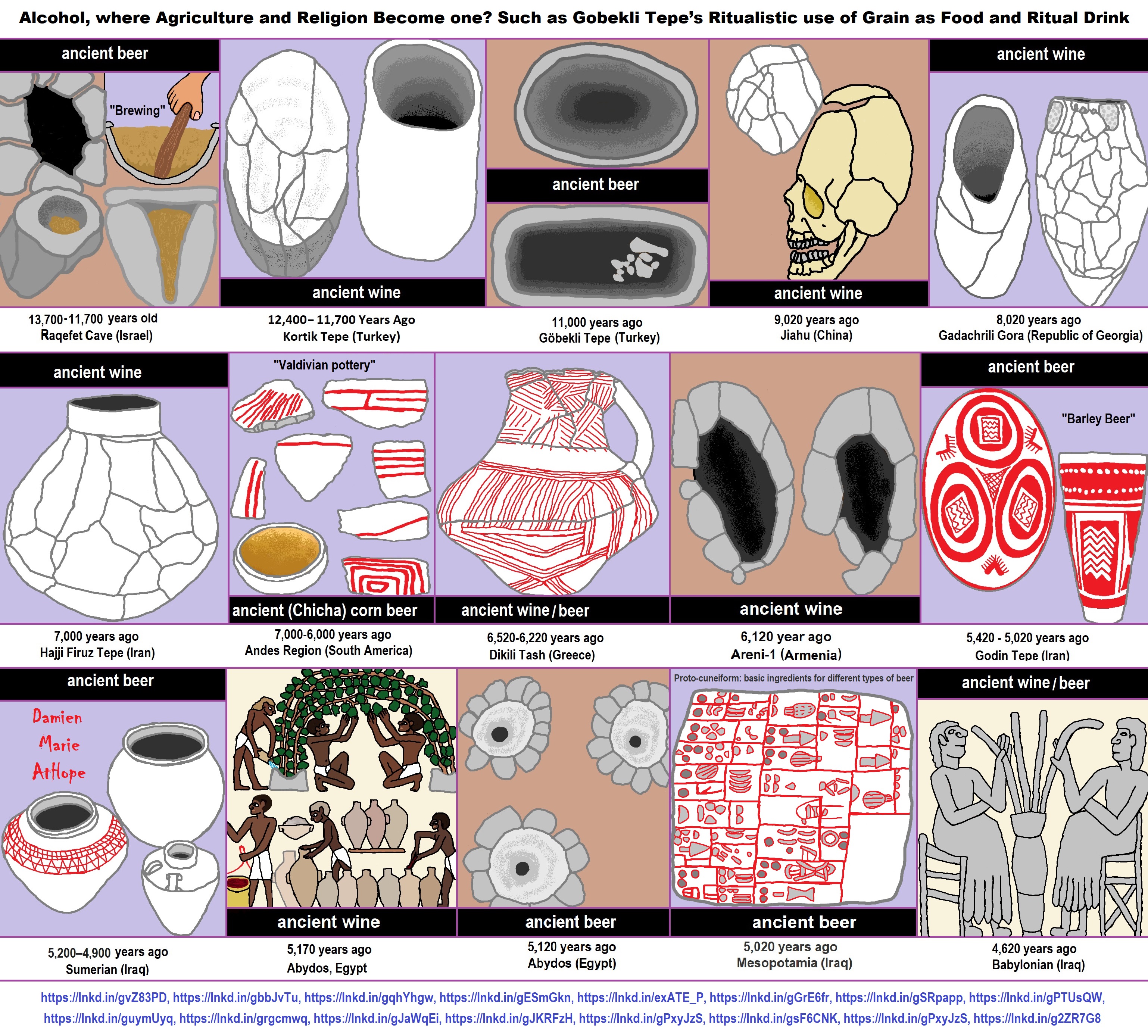
ref, ref, ref, ref, ref, ref, ref, ref, ref, ref, ref, ref, ref, ref, ref
Raqefet Cave
13,000-year-old stone mortars offers the earliest known physical evidence of an extensive ancient beer-brewing operation.
“The find comes on the heels of a July report that archaeologists working in northeastern Jordan discovered the charred remains of bread baked by Natufians some 11,600 to 14,600 years ago. According to the Stanford scientists, the ancient beer residue comes from 11,700 to 13,700 years old. Through laboratory analysis, other archaeological evidence found in the cave, and the wear of the stones, the team discovered that the ancient Natufians used species from seven plant families, “including wheat or barley, oat, legumes and bast fibers (including flax),” according to the article. “They packed plant-foods, including malted wheat/barley, in fiber-made containers and stored them in boulder mortars. They used bedrock mortars for pounding and cooking plant-foods, including brewing wheat/barley-based beer likely served in ritual feasts ca. 13,000 years ago,” the scientists write. “It has long been speculated that the thirst for beer may have been the stimulus behind cereal domestication, which led to a major social-technological change in human history; but this hypothesis has been highly controversial,” the Stanford authors say. “We report here of the earliest archaeological evidence for cereal-based beer brewing by a semi-sedentary, foraging people.” ref
“Beer making was an integral part of rituals and feasting, a social regulatory mechanism in hierarchical societies,” said Stanford’s Wang. The Raqefet Cave discovery of the first man-made alcohol production, the cave also provides one of the earliest pieces of evidence of the use of flower beds on gravesites, discovered under human skeletons. “The Natufian remains in Raqefet Cave never stop surprising us,” co-author Prof. Dani Nadel, of the University of Haifa’s Zinman Institute of Archaeology, said in a press release. “We exposed a Natufian burial area with about 30 individuals, a wealth of small finds such as flint tools, animal bones and ground stone implements, and about 100 stone mortars and cupmarks. Some of the skeletons are well-preserved and provided direct dates and even human DNA, and we have evidence for flower burials and wakes by the graves.” ref
“And now, with the production of beer, the Raqefet Cave remains provide a very vivid and colorful picture of Natufian lifeways, their technological capabilities, and inventions,” he said. Stanford’s Liu posited that the beer production was of a religious nature because its production was found near a graveyard. “This discovery indicates that making alcohol was not necessarily a result of agricultural surplus production, but it was developed for ritual purposes and spiritual needs, at least to some extent, prior to agriculture,” she said. “Alcohol making and food storage were among the major technological innovations that eventually led to the development of civilizations in the world, and archaeological science is a powerful means to help reveal their origins and decode their contents,” said Liu. “We are excited to have the opportunity to present our findings, which shed new light on a deeper history of human society.” ref

List of Neolithic cultures of China and their rituals or mythology
“This is a list of Neolithic cultures of China that have been unearthed by archaeologists. They are sorted in chronological order from earliest to latest and are followed by a schematic visualization of these cultures. It would seem that the definition of Neolithic in China is undergoing changes. The discovery in 2012 of pottery about 20,000 years BCE indicates that this measure alone can no longer be used to define the period. It will fall to the more difficult task of determining when cereal domestication started.” ref
20,022–9,022 years ago Xianren Cave culture, (Paleolithic) Wannian County, Shangrao, Jiangxi
10,522–9,722 years ago Nanzhuangtou culture, Yellow River region in southern Hebei
9,522–8,122 years ago Pengtoushan culture, central Yangtze region in northwestern Hunan
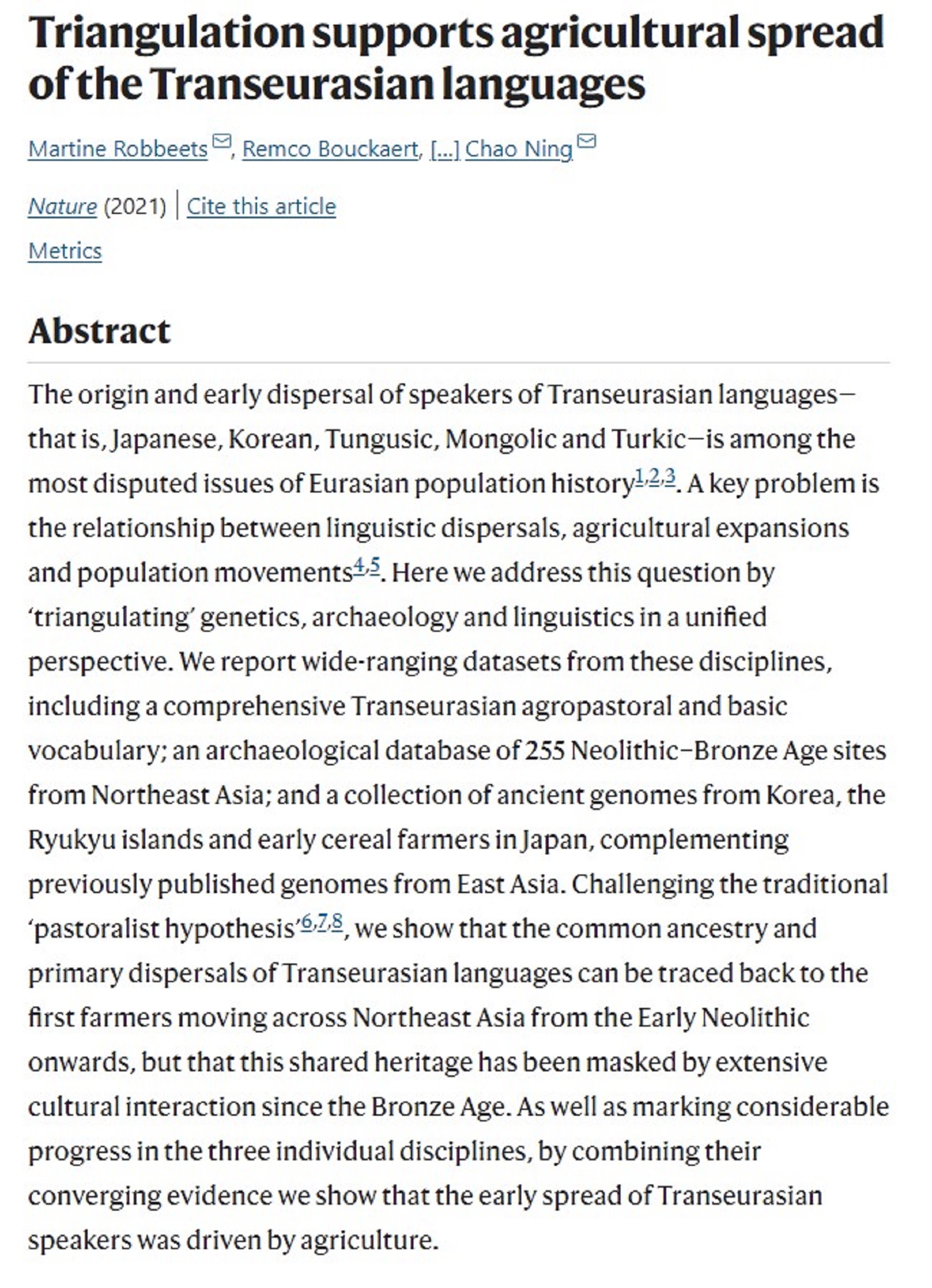
Triangulation supports agricultural spread of the Transeurasian languages: https://www.nature.com/articles/s41586-021-04108-8 Just out today more supportive of my thinking, as usual. Triangulation supports the agricultural spread of the Transeurasian languages.
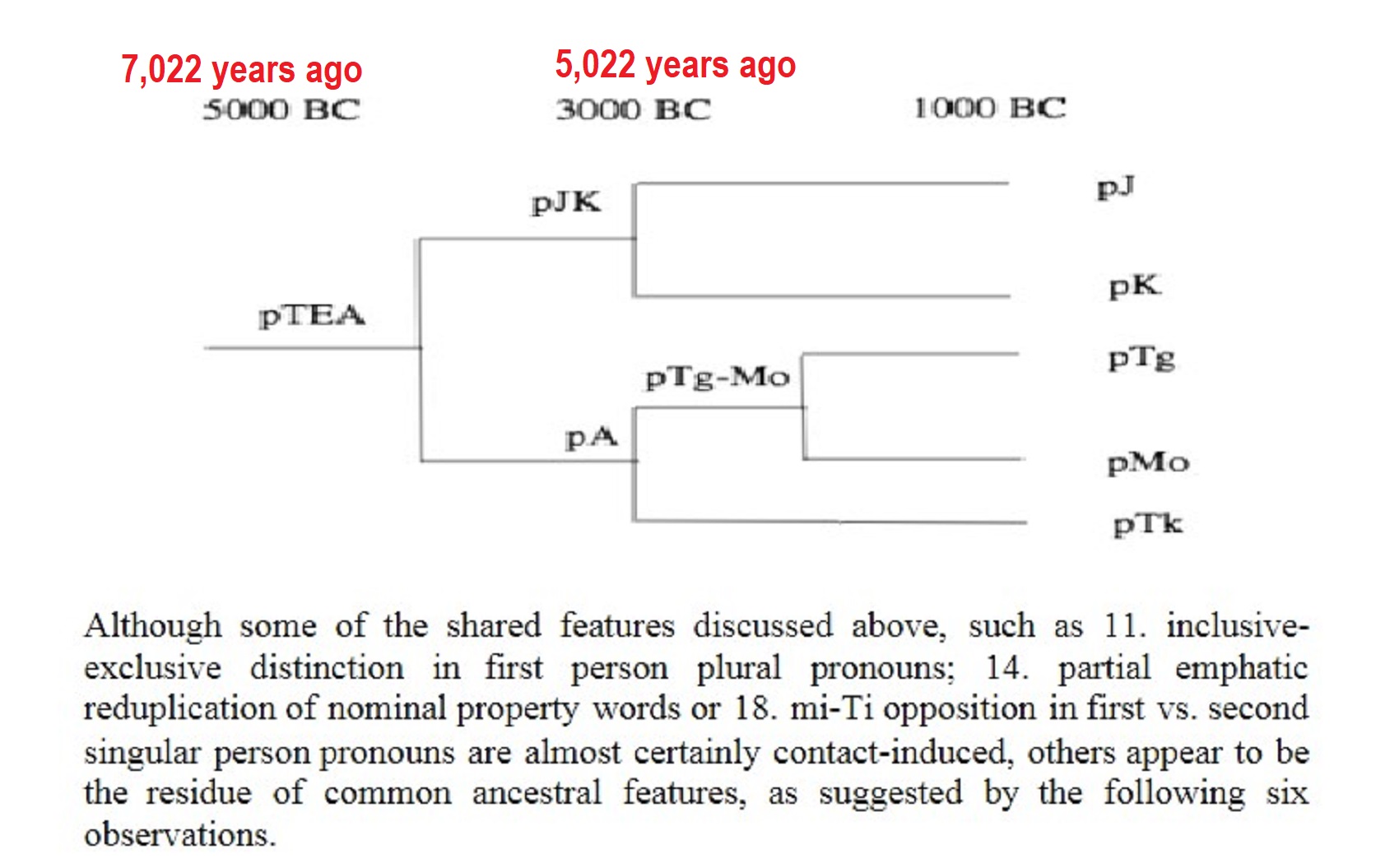
“It is important to note that the typological similarities among the Transeurasian languages are accompanied by a significant number of correspondences in the lexicon as well as in verb morphology in such a way that — in the researcher’s own judgment — these languages are likely to be genealogically related.” ref
“The Transeurasian continuum has clear boundaries which delimit the language type in relation to its neighbors both to the north (Yeniseic, Yukaghiric) and east (Nivkh, Ainu) as well as to the south (Sinitic, Austronesian). Although the observations above are in line with findings about a certain internal uniformity in the larger Ural-Altaic belt, they also suggest including Yukaghir in this larger belt and they indicate additional boundaries in a reality between the Uralic and the Transeurasian languages as such.” ref
“Among the features that enable researchers to delimit the Transeurasian languages in relation to their Uralic neighbors are tongue root harmony in Transeurasian (and Yukaghir) vs. palatal harmony in Uralic; voicing distinction for stops in Transeurasian (and Yukaghir) vs. original singleton-geminate distinction in Uralic; non-verbal strategy of verbal borrowing in Transeurasian vs. direct insertion in Uralic; inclusive-exclusive distinction in Transeurasian vs. none in Uralic (and Yukaghir); mixed and switched encoding of property words in Transeurasian (and perhaps originally in Yukaghir) vs. nominal encoding in Uralic; partial emphatic reduplication in Transeurasian vs. none in Uralic (and Yukaghir); absence of initial in the nominative first person singular vs. presence in Uralic (and Yukaghir); development of a negative verb into a suffix in Transeurasian vs. none in Uralic (and Yukaghir); and augmented first-person plural pronoun in Transeurasian versus none in Uralic (and Yukaghir).” ref
“For some features such as Uralic makes use of a larger variety of strategies than the Transeurasian languages, where all languages uniformly use locative possession or ablative comparatives. It is remarkable that Yukaghir aligns with Uralic rather than with Transeurasian in more than half of the delimiting features, although it is geographically adjacent to Transeurasian languages such as Yakut (Turkic) and some northern Tungusic languages, but not to the Uralic languages. In the reacher’s own opinion, this observation is probably not coincidental, but it might reflect the alleged genetic relatedness between Uralic and Yukaghir.” ref
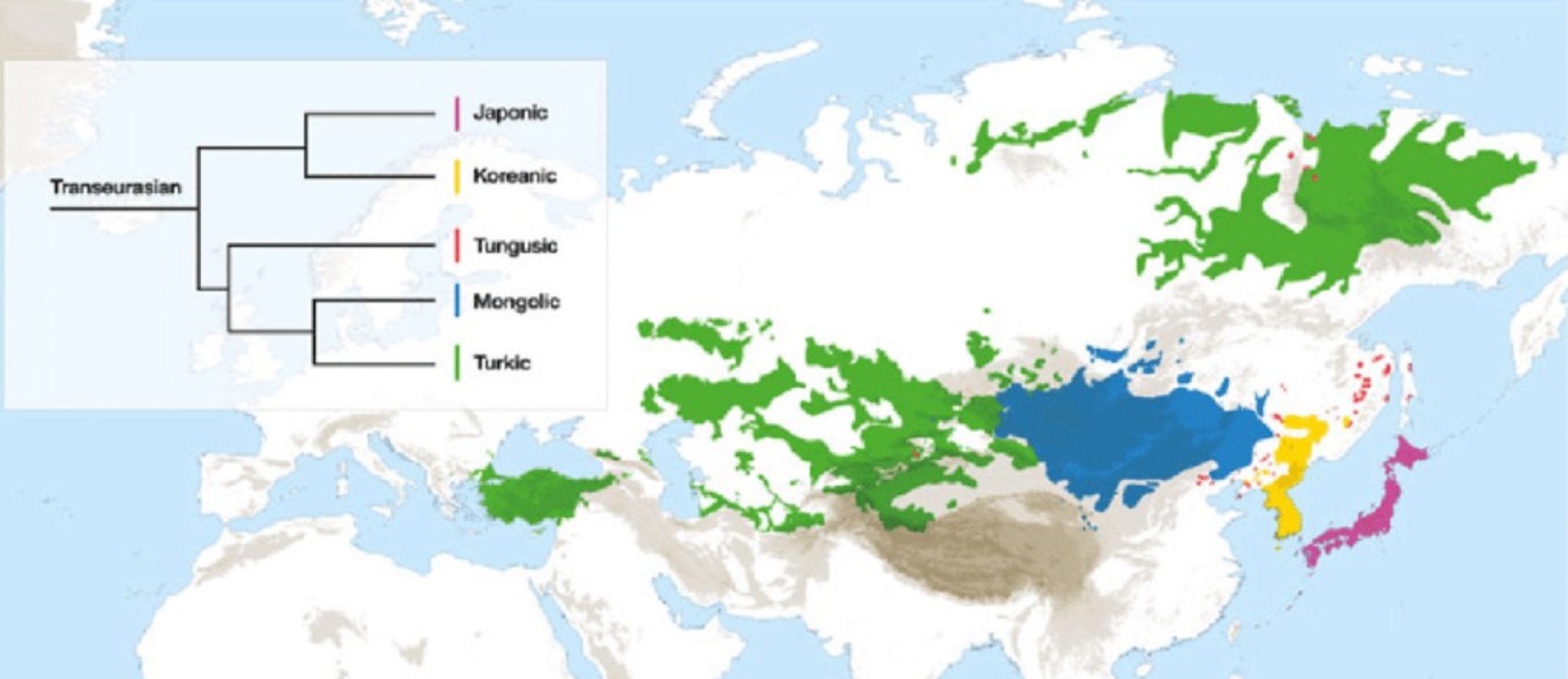
“27 features in the Transeurasian languages, providing a typological profile of some contemporary varieties in relation to historical stages of the languages involved and to selected languages immediately outside the continuum. Comparison with neighbors to the north (Yeniseic, Yukaghiric), south (Sinitic, Austronesian), east (Nivkh, Ainu), and west (Uralic) makes it possible to set up boundaries which delimit the Transeurasian proto-type. Along the margins of the Transeurasian continuum, I have found examples of gradual loss of Transeurasian features in the western and eastern peripheries, as well as gradual adoption of Transeurasian features, as in the case of Mandarin.” ref
“The data further suggest that the Transeurasian continuum in its turn is part of a larger Uralic-Yukaghiric-Transeurasian belt of languages, which again is part of a larger area of North Asian languages. Although it is meaningful to apply the concept of “areality” to the Transeurasian languages in the sense of a historically motivated geographical concentration of linguistic features, I prefer avoiding the label “area” with reference to these languages because this would imply that all shared properties are the result of diffusion. Observations relating to geography, history, distribution, cyclicity of grammaticalization, and combined isomorphism indicate that this is not the case. A fuller study would need to take more feature values into account and to insert a larger variety of Transeurasian languages as comparative points.” ref
“Neighboring languages should also be more diversified and adjacent languages in the west such as Indo-European languages or languages of the Caucasus region should be included. One should also pay attention to structural dependencies between the features and to considering whether particular features can be easier accounted for by diffusion or by genealogical retention. For the latter purpose, it would be particularly interesting to take common diachronic mechanisms, such as shared patterns of grammaticalization into fuller account. Although this chapter perhaps raises as many new questions as it answers, I hope to have contributed here to the understanding of areality among the Transeurasian languages.” ref
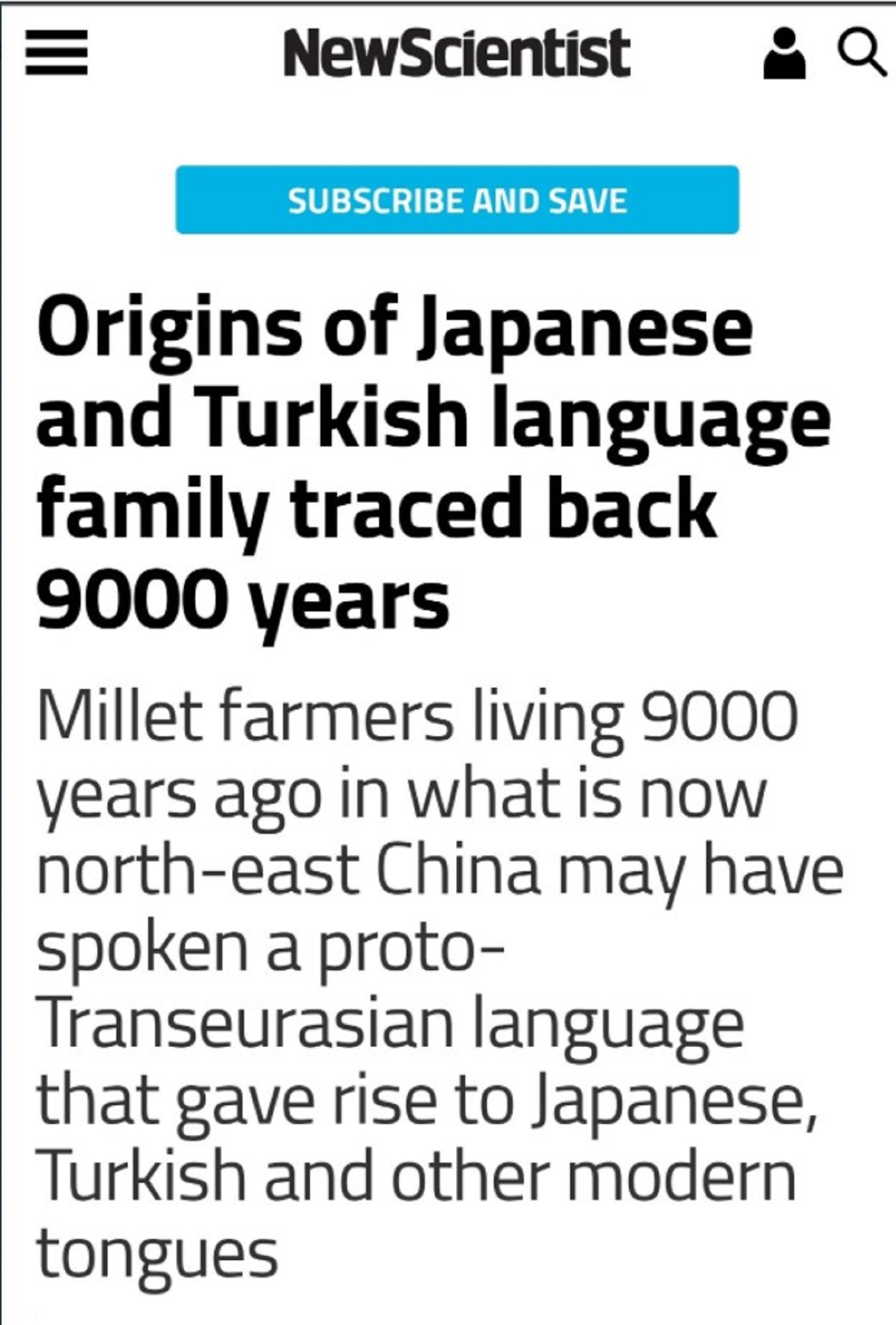
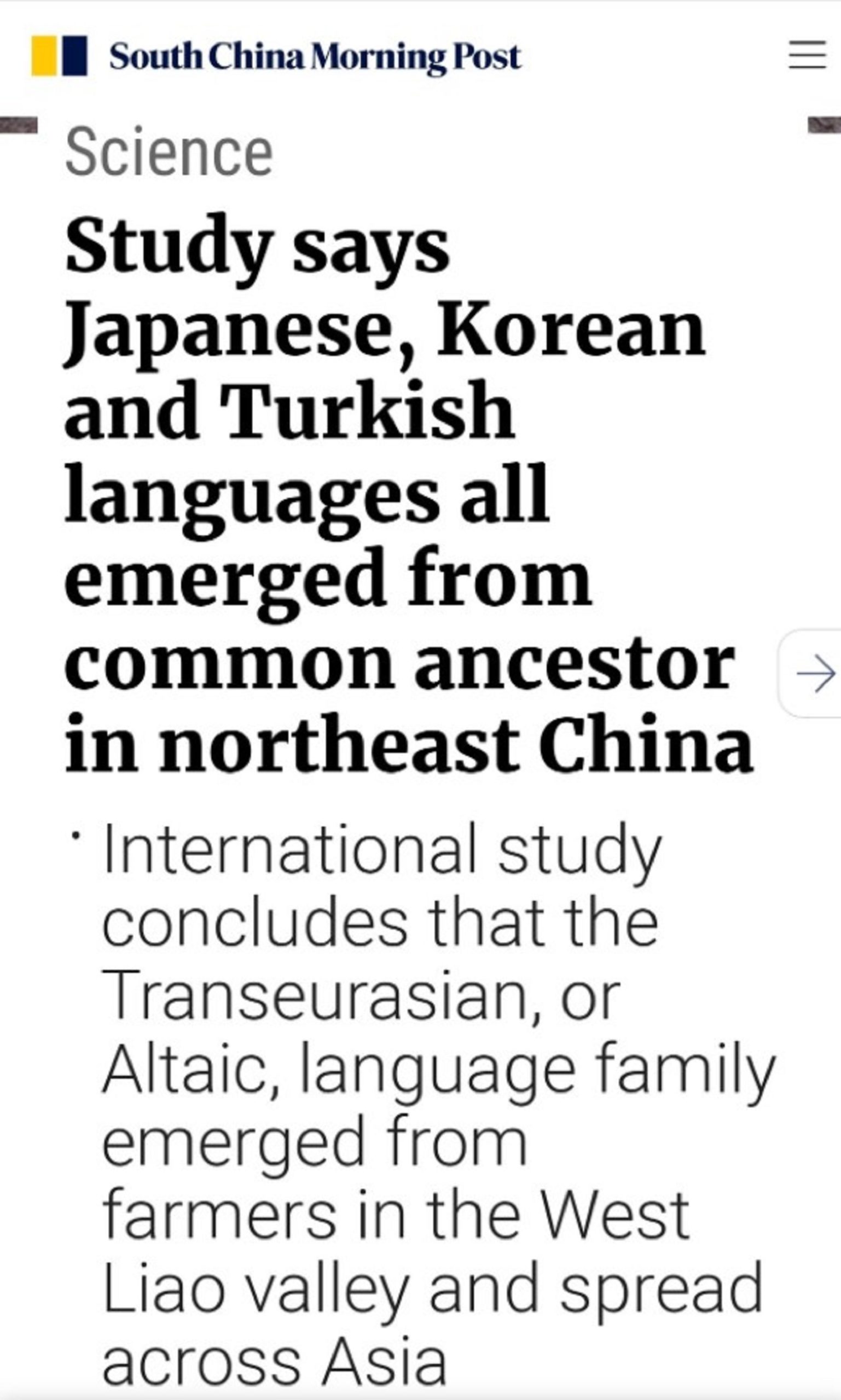
“The study says Japanese, Korean and Turkish languages all emerged from a common ancestor in northeast China. The international study concludes that the Transeurasian, or Altaic, language family emerged from farmers in the West Liao valley and spread across Asia. The link between the five groups in the family has been hotly contested, but researchers say there is archaeological and genetic evidence to support the theory.” ref
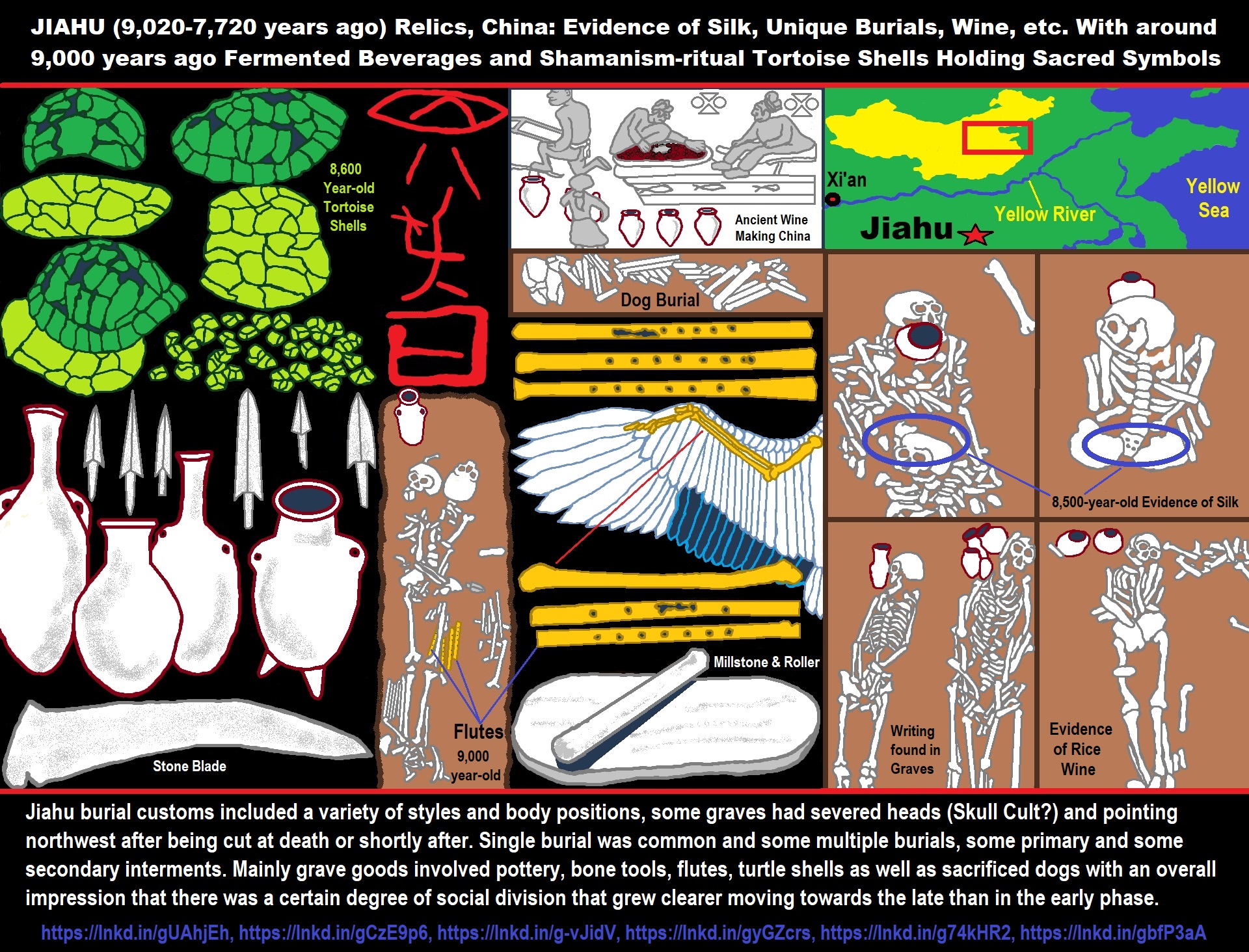
ref, ref, ref, ref, ref, ref, ref, ref, ref, ref, ref, ref
9,022-7,722 years ago Jiahu Culture
“Jiahu was the site of a Neolithic settlement based in the central plain of ancient China, near the Yellow River. It is located between the floodplains of the Ni River to the north, and the Sha River to the south, 22 km (14 mi) north of the modern city of Wuyang, Henan Province. Most archaeologists consider the site to be one of the earliest examples of the Peiligang culture. Settled around 7000 BCE, the site was later flooded and abandoned around 5700 BCE. The settlement was surrounded by a moat and covered a relatively large area of 55,000 square meters (5.5 hectare). At one time, it was “a complex, highly organized Chinese Neolithic society”, home to at least 250 people and perhaps as many as 800.” ref
“The important discoveries of the Jiahu archaeological site include the Jiahu symbols, possibly an early example of proto-writing, carved into tortoise shells and bones; the thirty-three Jiahu flutes carved from the wing bones of cranes, believed to be among the oldest playable musical instruments in the world; and evidence of wine fermented from rice, honey, and hawthorn leaves.” ref
“A broad variety of other artifacts indicates a fairly advanced settlement for the early Neolithic period, including residences, burial sites, pottery kilns, an assortment of implements made of stone and earthenware, and a large central structure believed to be a communal workspace. To date, 45 residences have been excavated at Jiahu. Most of these are small, between four and ten meters. Most of these were semi-subterranean (partially dug into the earth) and with a single room; however, some of these had additional rooms built on later. Rubbish pits and storage cellars were also excavated, and nine pottery kilns were identified.” ref
“Some archaeologists point to cultural distinctions between Jiahu and Peiligang, as well as the distance: Jiahu is isolated, many kilometers south of the larger Peiligang grouping of over 100 archaeological sites in a fairly compact area. The distance would have represented a journey on foot of several days in the Neolithic era. This school of thought suggests that Jiahu and Peiligang represented separate, neighboring cultures that interacted and shared many characteristics. Other early Neolithic settlements in this part of the world were much farther south and east.” ref
“Archaeologists have divided Jiahu into three distinct phases. The oldest phase ranges from 7000 to 6600 BCE; the middle phase ranges from 6600 to 6200 BCE; and the last phase ranges from 6200 to 5700 BCE. The last two phases correspond to the Peiligang culture, while the earliest phase is unique to Jiahu.” ref
“Careful examination of the skeletons of over 400 individuals, removed from more than 300 graves, by several scientific teams over the course of the past 30 years illustrates that the Jiahu ethnic group was a part of the Northern Mongoloid group, and identified closely with the Miaodigou and Xiawanggang sub-groups which were also descendants of hunting and gathering tribes in Henan Province, and the Dawenkou, Xixiahou and Yedian sub-groups that were later found in Shandong Province.” ref
“The inhabitants of Jiahu cultivated foxtail millet and rice. While millet cultivation is common in the Peiligang culture, rice cultivation at Jiahu is unique, and tends to support the theory that Jiahu was a separate culture from the Peiligang grouping. On the other hand, difference in local climate, moisture, and soil conditions may have made cultivating rice in the Peiligang area more difficult. Jiahu rice cultivation is one of the earliest found, and the most northerly found at such an early stage in history. The rice was a kind of short-grained japonica rice. Scholars had previously thought the earliest domesticated rice belonged to the long-grain indica subspecies.” ref
“There is abundant proof of millet farming in cool, dry high latitudes of the Yellow River Valley, and rice farming dominated in warm, moist low latitudes of the Yangtze River Valley. The early Neolithic site of Jiahu lies near the boundary between the cool, dry north and the warm, moist south. In another sign of advancement, Jiahu’s farmers had moved on from the usual slash-and-burn techniques of Neolithic farmers, and were using intensive cultivation in permanent fields. Jiahu is also the site of the earliest find of wild soybean seeds in China; a large quantity of soybean remains were discovered at Jiahu.” ref
“Food was plentiful, from farming as well as hunting and foraging, and contributed to considerable population growth for such an early settlement. Women of the Jiahu culture gathered wild pears and apricots, and foraged for acorns, chestnuts, broad beans, edible roots, and tubers in the surrounding countryside. There is evidence of domesticated pigs, dogs, poultry, and small numbers of cattle. The Jiahu people used manure from their pigs and cattle as fertilizer, substantially increasing the yield of their rice crops. The livestock produced meat, milk, and eggs. There was also evidence of deer, wild boar and rabbit hunting, and fishing for carp and herring[clarification needed] in the nearby rivers to the north and south, with nets made of hemp fibers. The red-crowned crane, a large bird indigenous to the region, was hunted for meat; its bones and feathers were also used for other purposes.” ref
“Due to this steadily improving and varied diet, the health and longevity of the Jiahu people gradually improved. This has been documented through a comparison of the archaeological evidence. Over 400 burials have been unearthed at Jiahu, and many hundreds more are believed to await excavation. Skeletons have been measured and carefully examined, revealing the height, weight, gender, and approximate age of each of the deceased Jiahu at the time of death, as well as the general health, and in many cases the cause of death. The three phases of Jiahu history correspond to steadily increasing numbers of middle-aged and older people, suggesting an increase in survival and life expectancy, and fewer remains of children and infants, suggesting a reduction in child and infant mortality. By the third phase, the average height of an adult had increased by 0.8in (2 cm) and the bones and teeth were in significantly better condition.” ref
“A stone sickle blade has been recovered. This was secured to a wooden handle to harvest grain. Evidence of baskets woven from wild grass has been uncovered. These were used to carry grain from the harvests. Remnants of a spinning loom have been found, indicating the production of cloth, probably from hemp fibers. Among the many tools and utensils unearthed at Jiahu are three-legged earthenware cooking pots with tight-fitting lids, and a variety of stone implements, including arrowheads, barbed harpoons, spades, axes, awls, and chisels.” ref
“Stone spearheads have also been found, and evidence of what may have been a wooden stockade fence along at least a portion of the interior shore of the moat. These improved weapons, and the moat surrounding the settlement, provided an ideal defense for such an early culture. The area is known to have been frequented by nomadic hunting and gathering tribes for several thousand years prior to the Jiahu settlement, and these may have been potential enemies, as well as the genetic forebears of Jiahu. The Jiahu people are not believed to have been warlike in nature, but capable of defending themselves if the need arose.” ref
“Thorough examination of the site has revealed no evidence of any armed conflict. Unearthed human remains showing signs of violent death are very rare, and scattered along the known timeline—rather than occurring at the same time which would indicate a battle. It is possible that the large size of the settlement, its substantial defenses, and the improved weapons of the Jiahu people may have caused potential enemies of that time to keep their distance. Such a scenario is consistent with the substantial growth in population and longevity exhibited by the Jiahu site. Without war, and with plenty of nutritious food, the village flourished.” ref
“The burials at Jiahu were usually accompanied by burial offerings, with increasing frequency as the second and third phases progressed. Burial objects range from pottery to tortoise shells. Burial offerings varied between individuals, and are believed to be linked to the skills they displayed in life, providing evidence of an early specialization of labor. The types of labor specialization, from most common to most rare, included farmers, herdsmen, fishermen, hunters, potters, musicians, and a tribal priest.” ref
“Most of the burials were earthen pits; infants were buried in earthenware jars. As is common with Neolithic communities, the burials were in cemeteries which were separate from the residential areas, although many gravesites overlapped, so they were probably not marked. A few burials were multiple, while most burial pits contained single individuals. These did not follow any discernible pattern, although it is possible that in some cases, couples (a man and a woman of roughly the same age) were buried together.” ref
“In some graves, the heads were severed from the body and pointed toward the northwest. Cut marks made when the bones were fresh indicates the heads were cut off shortly after the person died. A few burial offerings included turquoise carvings, and represented a significant level of material wealth, suggesting some differences in social status. Burial offerings in women’s graves were more sparse, indicating lower social status, and indicated that their roles were limited to childbearing and child care, cooking, and foraging for food.” ref
“Some of the most significant burial offerings discovered were playable tonal flutes made from red-crowned crane wing bones. This crane is five feet tall with a wingspan of eight feet, yielding large bones for this purpose. The first of the flutes were found in the late 1980s, but were not described in the West until 1999.” ref
“Thirty-three flutes—including around 20 intact flutes, several broken or fragmented ones, and several more unfinished ones—have been found at Jiahu. All are between seven and 10 inches in length. It seems plausible that ancient flutes were also made from bamboo. Ancient myths described bamboo flutes; but no ancient ones have been found, in all likelihood because bamboo decays more quickly than bone and doesn’t survive burial for thousands of years like bone.” ref
“The oldest phase at Jiahu only contains two flutes, which are tetratonic and pentatonic; the middle phase at Jiahu contains several flutes, including an interesting pair of hexatonic flutes. One of the flutes was broken, and the other flute seems to be a replica of the first flute, as it shows evidence of adjustments made to match the pitch of the first. Innovations in the last phase include the use of heptatonic flutes. The flutes were cut, smoothed at the ends, polished, and finally drilled with a row of holes on one side. One of the broken flutes was repaired by drilling fourteen tiny holes along the breakage lines and then tying the sections together with hemp string.” ref
“The flutes play in the so-called pentatonic scale, in which octaves are divided into five notes—the basis of many kinds of music, including Chinese folk music. The fact that the flute has a scale indicates that its original players played music rather than just single notes. The flutes were probably used in some kind of ceremonial capacity, but may have been played for entertainment.” ref
“Jiahu yielded some of the oldest Chinese pottery yet found in Neolithic China. Patrick McGovern, of the University of Pennsylvania Museum, led a team of scientists who applied biomarker chemical analysis to pottery jars from Jiahu. They found signature molecules proving alcohol was fermented from rice, honey, grapes, and hawthorn. Researchers hypothesize that this hybrid beverage (a beer, wine, and mead combination) was fermented by the process of mold saccharification, a uniquely Chinese contribution to the art of beverage-making in which several mold species are used to break down the carbohydrates of rice and other grains into simple, fermentable sugars. Specific aromatic herbs and flowers such as chrysanthemum, in addition to tree resins such as China fir, had been added to the hybrid beverages, the researchers found. These aromatic additions, as well as the honey, indicate that fermented beverages with a pleasing aroma and sweet taste were important to the Jiahu people.” ref
“Substantial quantities of rice and millet were stored in pottery jars, enabling the specialization of labor. Jiahu society is believed to have been fairly egalitarian, with several hundred residents of the village at the height of its development. Comparative DNA evidence from remains in the Jiahu settlement itself, as well as other evidence gathered, leads to speculation among researchers that there were one or more other ancient villages nearby, with peaceful interaction with the Jiahu in some form; but the sites of other villages nearby have not been located.” ref
“At Jiahu, archaeologists identified eleven markings of Jiahu symbols, also known as pictograms: nine on tortoise shells and two on bone, as possible evidence for proto-writing. The markings correspond to the middle phase. Some of the markings are quite similar to later Chinese characters; two of the most intriguing marks appear to be similar to later characters for eye (目) and sun (日). However, correspondence of many early non-writing symbols with the Shang dynasty period oracle bone writing is to be expected, given the pictographic style of many of the Shang characters.” ref
“In later Chinese culture dating to around 3500 BCE, tortoise shells were used as a form of divination. These were subjected to intense heat, and the cracks that formed were read as omens. The cracks were then carved as permanent marks on the surface of the shell. The evidence of shell pictograms from Jiahu may indicate that this tradition, or a related one, has much deeper roots in ancient Chinese culture than previously considered.” ref
“Based on the archaeological evidence, a severe flood from the nearby rivers submerged most or all of the Jiahu settlement under a few feet of water sometime around 5700 BCE. The inhabitants evacuated. It is not known where they went. The absence of tools and weapons in most of the residences indicates that they were able to salvage most of their belongings. They may have built a new village that has not been discovered, emigrated to the Peiligang villages, or scattered.” ref
“Zhang Juzhong imagines that they were led by their tribal priest to build a new village nearby on higher ground, so that they could send salvage parties to the old village site. The new village site has never been found. The demolishing of older structures to salvage materials for the construction of new ones may have eradicated the site of the new village if it existed.” ref
9,022–7,022 years ago Peiligang culture Yi-Luo river basin valley in Henan
“Cord-marked pottery was discovered among the burial goods. Another important site is Bashidang, also in Li County, belonging to the late stage of the Pengtoushan culture. It features a wall and a ditch, as well as a star-shaped platform. Rice residues at Pengtoushan have been carbon dated to 8200–7800 BCE, showing that rice had been domesticated by this time. At later stages, pots containing grains of rice were also dated to approximately 5800 BCE. By 4000 BCE, evidence of rice domestication in the region is abundant in the form of bone and wooden spades, as well as pottery. The rice grains at Pengtoushan are larger than naturally occurring wild rice. Large amounts of rice grains have also been found at Bashidang.” ref
8,522–7,522 years ago Houli culture Shandong
“The people of the culture lived in square, semi-subterranean houses. The most commonly found artifacts at Houli sites are pottery and stone tools. Jade artifacts and bone, antler, shell tools were also found at Houli sites. While the remains of domesticated dogs and pigs in the early stages of domestication were found at some sites associated with the culture, the people of the Houli culture relied mostly on hunting and fishing. The remains of rice, broomcorn millet, and foxtail millet were discovered at Houli sites. The type site at Houli was discovered in the Linzi District of Shandong and was excavated from 1989 to 1990. The culture was followed by the Beixin culture.” ref
8,222–7,422 years ago Xinglongwa culture Inner Mongolia–Liaoning border
“120 pit-houses were discovered at Xinglongwa. Each home had a hearth at its center. Xinglongwa also featured a large building in the center of the village. Xinglongwa is the earliest discovered site in China to be surrounded by a ditch. Xinglongwa also featured an unusual burial custom, as some bodies were buried directly under the houses. Jade objects were also discovered. In the most lavish grave, a man was buried with a pair of pigs, as well as jade objects. The recently discovered site at Xinglonggou is the only site of the culture to show evidence of any sort of agriculture, with evidence of millet remains. Some of the oldest Comb Ceramic artifacts were found in the Xinglongwa culture.” ref
“According to the study of 34 sets of human remains from Xinglongwa in-house burials, male individuals apparently predominate over female individuals at roughly 2:1 ratio (23 males vs. 11 females). Within the male group, no individuals were identified as being over 55 in age, whereas all of females belong to middle-to-old age group (no one younger than 35 years old). The youngest individuals examined were at age 13 or 14, so it’s suspected that children before mature sex-awareness might not have been buried in-house. From examined samples, the average height of males was between 163.8 cm and 168.8 cm, while the average height of females was between 153.4 cm – 159.9 cm. According to some papers, the Xinglongwa are perhaps the distant ancestors of the present-day Northeast Asian peoples that belong to the proposed “Transeurasian” (aka Altaic) language family.” ref
8,022–7,022 years ago Kuahuqiao culture Zhejiang
“During latest excavations, numerous well-preserved organic remains were found. They indicate that rice, dogs and pigs had already been domesticated by villagers. Thus, it was established that paddy rice cultivation was already practiced in China dating back 7,700 years. This evidence was well-dated, and maybe the earliest evidence for rice cultivation. A very early dugout canoe was revealed; this demonstrates the earliest technology for constructing this type of watercraft in China, and perhaps the world.” ref
8,022–7,522 years ago Cishan culture southern Hebei
“The Cishan culture was based on the farming of broomcorn millet, the cultivation of which on one site has been dated back 10,000 years. The people at Cishan also began to cultivate foxtail millet around 8700 years ago. There is also evidence that the Cishan people cultivated barley and, late in their history, a japonica variety of rice. Since the culture shared many similarities with its southern neighbor, the Peiligang culture, both cultures were sometimes previously referred to together as the Cishan-Peiligang culture or Peiligang-Cishan culture. The Cishan culture also shared several similarities with its eastern neighbor, the Beixin culture. However, the contemporary consensus among archaeologists is that the Cishan people were members of a distinct culture that shared many characteristics with its neighbors. This culture has been linked to the origin of the Sino-Tibetan language family. Over 500 subterranean storage pits were discovered at Cishan. These pits were used to store millet. The largest pits were 5 meters deep and capable of storing up to 1,000 kg (2,205 lb) of millet.” ref
7,822–7,422 years ago Dadiwan culture Gansu and western Shaanxi
“The remains of millet, pigs, and dogs have been found in sites associated with the culture, which is itself defined by a thin-walled, cord-marked ceramic tradition sometimes referred to as Laoguantai. They represents some of the earliest evidence for agricultural production (cultivation, harvesting, and storing of seed crops) in East Asia. The Dadiwan culture shares a variety of common features, in pottery, architecture, and economy, with the Cishan and Peiligang cultures to the east. The Neolithic cultural sequence here begins with the Dadiwan culture (c. 7900–7200 BP), followed by the Yangshao culture (c. 6800–4900 BP) and then the Changshan culture (c. 4900–4800 BP). The agricultural economy intensified and flourished during the early phases of the Yangshao culture.” ref
“The foundation of a large building, measuring 290 and 420 m2 (3,100 and 4,500 sq ft) when including the outer courtyard, was discovered at Dadiwan. The building, known as F901, is described by Chinese archaeologists as a communal meeting hall. The building was built on an elevated rammed earth foundation, which was then layered with burnt clay.” ref
7,522–6,822 years ago Xinle culture lower Liao River on the Liaodong Peninsula
“Excavations at the site discovered evidence for some 40 neolithic houses. Artifacts uncovered during the dig included stone tools, pottery, jade, bone tools, wood carvings, and refined coal. Another dig uncovered yet more artifacts including one wooden carving that was some 7,200 years old, presumably a type of totem (Snake?) worshipped by the clan. No other find in the whole of Shenyang has been older, and the find is one of the oldest wooden carvings found anywhere in the world. Various artifacts were unearthed during the various excavations that have taken place on the 44-acre (180,000 m2) site. Some of the houses in the settlement contain representations of life 7,000 years ago.” ref
7,422–6,522 years ago Zhaobaogou culture Luan River valley in Inner Mongolia and northern Hebei
“The culture produced sand-tempered, incised pottery vessels with geometric and zoomorphic designs. The culture also produced stone and clay human figurines.” ref
7,322–6,122 years ago Beixin culture Shandong
“They made extensive use of hemp fibers to weave fabric for clothing, to make baskets, and for various forms of thread, twine, and rope, including their fishing nets. There is no evidence of hemp cultivation, but it grew wild in great abundance throughout the region. Small quantities of hemp seeds have been recovered, but archaeologists believe these were acquired as a food source rather than for planting. Houses tended to be semi-subterranean and circular in shape. The Beixin people had separate housing and burial areas in the settlements, which was common for early Neolithic cultures. The houses and burial areas were clustered in small groups, which indicated a family or clan social structure in both life and death. Tools, weapons, and other articles buried with the dead as burial offerings, in the more recent gravesites, indicated the development of a type of early ceremonial burial.” ref
“Violent death, as revealed by examination of the remains, was relatively uncommon among the Beixin people compared with other Neolithic cultures. Death was almost always attributed to disease or the results of old age. This indicates that the Beixin were a peaceful culture, and not troubled by internal strife or conflicts with neighboring cultures.” ref
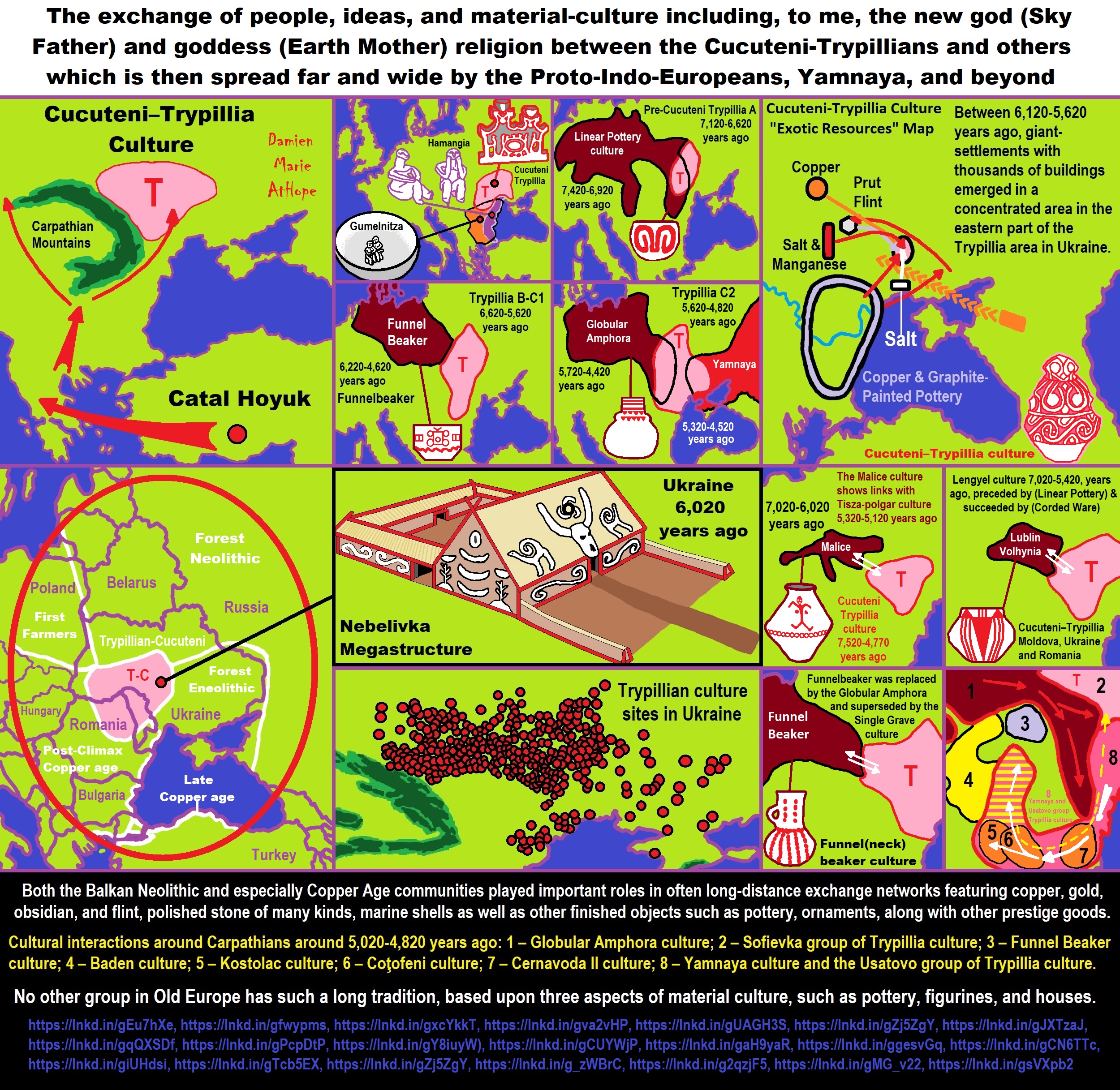
ref, ref, ref, ref, ref, ref, ref, ref, ref, ref, ref, ref, ref, ref, ref, ref, ref, ref, ref, ref
• Early (Pre-Cucuteni I–III to Cucuteni A–B, Trypillia A to Trypillia BI–II): 5800 to 5000 BCE or 7,822-7,022 years ago
• Middle (Cucuteni B, Trypillia BII to CI–II): 5000 to 3500 BCE or 7,022-5,522 years ago (China-related culture coming in?)
• Late (Horodiştea–Folteşti, Trypillia CII): 3500 to 3000 BCE or 7,022-5,522 years ago
“The roots of Cucuteni–Trypillia culture can be found in the Starčevo–Körös–Criș and Vinča cultures of the 6th to 5th millennia, with additional influence from the Bug–Dniester culture (6500–5000 BCE). During the early period of its existence (in the fifth millennium BCE), the Cucuteni–Trypillia culture was also influenced by the Linear Pottery culture from the north, and by the Boian culture from the south. Through colonization and acculturation from these other cultures, the formative Pre-Cucuteni/Trypillia A culture was established. During the late period, the Cucuteni–Trypillia territory expanded to include the Volyn region in northwest Ukraine, the Sluch and Horyn Rivers in northern Ukraine, and along both banks of the Dnieper river near Kyiv. Members of the Cucuteni–Trypillia culture who lived along the coastal regions near the Black Sea came into contact with other cultures.” ref
“Cucuteni–Trypillia figurines have become known popularly as goddesses; however, this term is not necessarily accurate for all female anthropomorphic clay figurines, as the archaeological evidence suggests that different figurines were used for different purposes (such as for protection), and so are not all representative of a goddess. Nikitin (2011) analyzed mtDNA recovered from Cucuteni–Trypillia human osteological remains found in the Verteba Cave (on the bank of the Seret River, Ternopil Oblast, Ukraine). It revealed that seven of the individuals whose remains where analyzed belonged to: two to haplogroup HV(xH), two to haplogroup H, one to haplogroup R0(xHV), one to haplogroup J, and one to haplogroup T4, the latter also being the oldest sample of the set.” ref
“The authors conclude that the population living around Verteba Cave was fairly heterogenous, but that the wide chronological age of the specimens might indicate that the heterogeneity might have been due to natural population flow during this timeframe. The authors also link the R0(xHV) and HV(xH) haplogroups with European Paleolithic populations, and consider the T4 and J haplogroups as hallmarks of Neolithic demic intrusions from the southeast (the north-pontic region) rather than from the west (i.e. the Linear Pottery culture).” ref
“Arguing from archaeological and linguistic evidence, Gimbutas concluded that the people of the Kurgan culture (a term grouping the Yamnaya culture and its predecessors) of the Pontic–Caspian steppe, being most likely speakers of the Proto-Indo-European language, effectively destroyed the Cucuteni–Trypillia culture in a series of invasions undertaken during their expansion to the west. Based on this archaeological evidence Gimbutas saw distinct cultural differences between the patriarchal, warlike Kurgan culture and the more peaceful egalitarian Cucuteni–Trypillia culture, which she argued was a significant component of the “Old European cultures” which finally met extinction in a process visible in the progressing appearance of fortified settlements, hillforts and the graves of warrior-chieftains, as well as in the religious transformation from the matriarchy to patriarchy, in a correlated east–west movement.” ref
“In this, “the process of Indo-Europeanization was a cultural, not a physical, transformation and must be understood as a military victory in terms of successfully imposing a new administrative system, language, and religion upon the indigenous groups. Accordingly, these proponents of the Kurgan hypothesis hold that this invasion took place during the third wave of Kurgan expansion between 3000–2800 BCE, permanently ending the Cucuteni–Trypillia culture.” ref
“The obvious issue with that theory is the limited common historical life-time between the Cucuteni–Trypillia (4800–3000 BCE) and the Yamnaya culture (3300–2600 BCE); given that the earliest archaeological findings of the Yamnaya culture are located in the Volga–Don basin, not in the Dniester and Dnieper area where the cultures came in touch, while the Yamnaya culture came to its full extension in the Pontic steppe at the earliest around 3000 BCE, the time the Cucuteni–Trypillia culture ended, thus indicating an extremely short survival after coming in contact with the Yamnaya culture.” ref
“According to Jones et al. (2015) and Haak et al. (2015), autosomal tests indicate that the Yamnaya people were the result of a genetic admixture between two different hunter-gatherer populations: distinctive “Eastern Hunter-Gatherers” (EHG), from Eastern Europe, with high affinity to the Mal’ta–Buret’ culture or other, closely related people from Siberia and a population of “Caucasus hunter-gatherers” (CHG) who probably arrived from the Caucasus or Iran. Each of those two populations contributed about half the Yamnaya DNA. This admixture is referred to in archaeogenetics as Western Steppe Herder (WSH) ancestry.” ref
“Admixture between EHGs and CHGs is believed to have occurred on the eastern Pontic-Caspian steppe starting around 5,000 BC, while admixture with Early European Farmers (EEF) happened in the southern parts of the Pontic-Caspian steppe sometime later. As Yamnaya Y-DNA is exclusively of the EHG and WHG type, displaying genetic continuity from the paternal lineages of the Dnieper-Donets culture, the admixture appears to have occurred predominantly between EHG males, and CHG and EEF females.” ref
“Haplogroup R1b, especially subclades of R1b-M269, is the most common Y-DNA haplogroup found among both the Yamnaya and modern-day Western Europeans. Additionally, a minority are found to belong to haplogroup I2. They are found to belong to a wider variety of mtDNA haplogroups, including U, T, and haplogroups associated with Caucasus Hunter-Gatherers and Early European Farmers.” ref
“People of the Yamnaya culture are believed to have had mostly brown eye colour, light to intermediate skin, and brown hair, with some variation. Some individuals are believed to have carried a mutation to the KITLG gene associated with blond hair, as several individuals with Steppe ancestry are later found to carry this mutation. The Ancient North Eurasian population, who contributed significant ancestry to Western Steppe Herders, are believed to be the source of this mutation. A study in 2015 found that Yamnaya had the highest ever calculated genetic selection for height of any of the ancient populations tested.” ref
“The geneticist David Reich has argued that the genetic data supports the likelihood that the people of the Yamnaya culture were a “single, genetically coherent group” who were responsible for spreading many Indo-European languages. Reich also argues that the genetic evidence shows that Yamnaya society was an oligarchy dominated by a small number of elite males.” ref
“The genetic evidence for the extent of the role of the Yamnaya culture in the spread of Indo-European languages has however been questioned by Russian archaeologist Leo Klejn and Balanovsky et al., who note a lack of male haplogroup continuity between the people of the Yamnaya culture and the contemporary populations of Europe.” ref
Cucuteni–Trypillia culture and proso millet of which archaeobotanical evidence suggests millet was first domesticated about 10,000 BP in Northern China. ref
“The Cucuteni–Trypillia culture was a society of subsistence farmers. Cultivating the soil (using an ard or scratch plough), harvesting crops, and tending livestock was probably the main occupation for most people. Typically for a Neolithic culture, the vast majority of their diet consisted of cereal grains. They cultivated club wheat, oats, rye, proso millet, barley, and hemp, which were probably ground and baked as unleavened bread in clay ovens or on heated stones in the home. They also grew peas and beans, apricot, cherry plum, and wine grapes – though there is no solid evidence that they actually made wine. There is also evidence that they may have kept bees.” ref
“A study published in Nature in 2018 included an analysis of three males from the Cucuteni–Trypillia culture and found evidence of genetic contact between the Cucuteni–Trypillia culture and steppe populations from the east from as early as 3600 BCE, well before the influx of steppe ancestry into Europe associated with the Yamnaya culture. With respect to Y-DNA, two carried haplogroup G2a2b2a, while one carried G2a. With respect to mtDNA, the males carried H5a, T2b, and HV.” ref
“Two early culture-complexes have developed in the region, Starčevo culture and Vinča culture. The Balkans are also the location of the first advanced civilizations. Vinča culture developed a form of proto-writing before the Sumerians and Minoans, known as the Old European script, while the bulk of the symbols had been created in the period between 4500 and 4000 BCE or 6,522-6,022 years ago, with the ones on the Tărtăria clay tablets even dating back to around 5300 BCE or 7,322 years ago.” ref
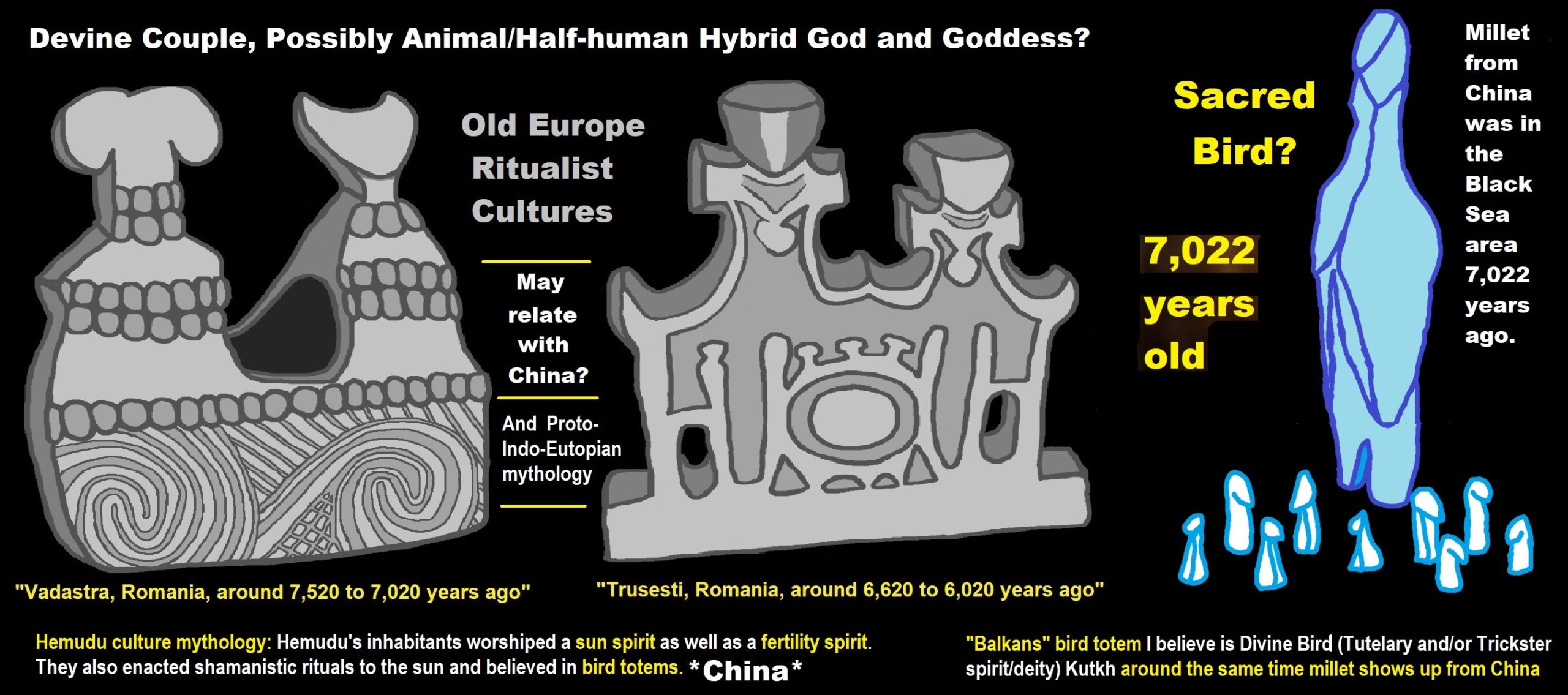
ref, ref, ref, ref, ref, ref, ref, ref, ref, ref, ref
I hear possible similarities to Proto-Indo-Eutopian mythology in China’s 7,022–6,522 years ago Hemudu culture as well as to 7,000-year-old ritual items found in the Balkans area such as the Cucuteni-Trypillian culture.
PIE Proto-Indo-Eutopian mythology: *Dyḗws Ph₂tḗr, the daylight-sky god; his consort/wife *Dʰéǵʰōm, the earth mother.
Hemudu culture mythology: Hemudu’s inhabitants worshiped a sun spirit as well as a fertility spirit. They also enacted shamanistic rituals to the sun and believed in bird totems.
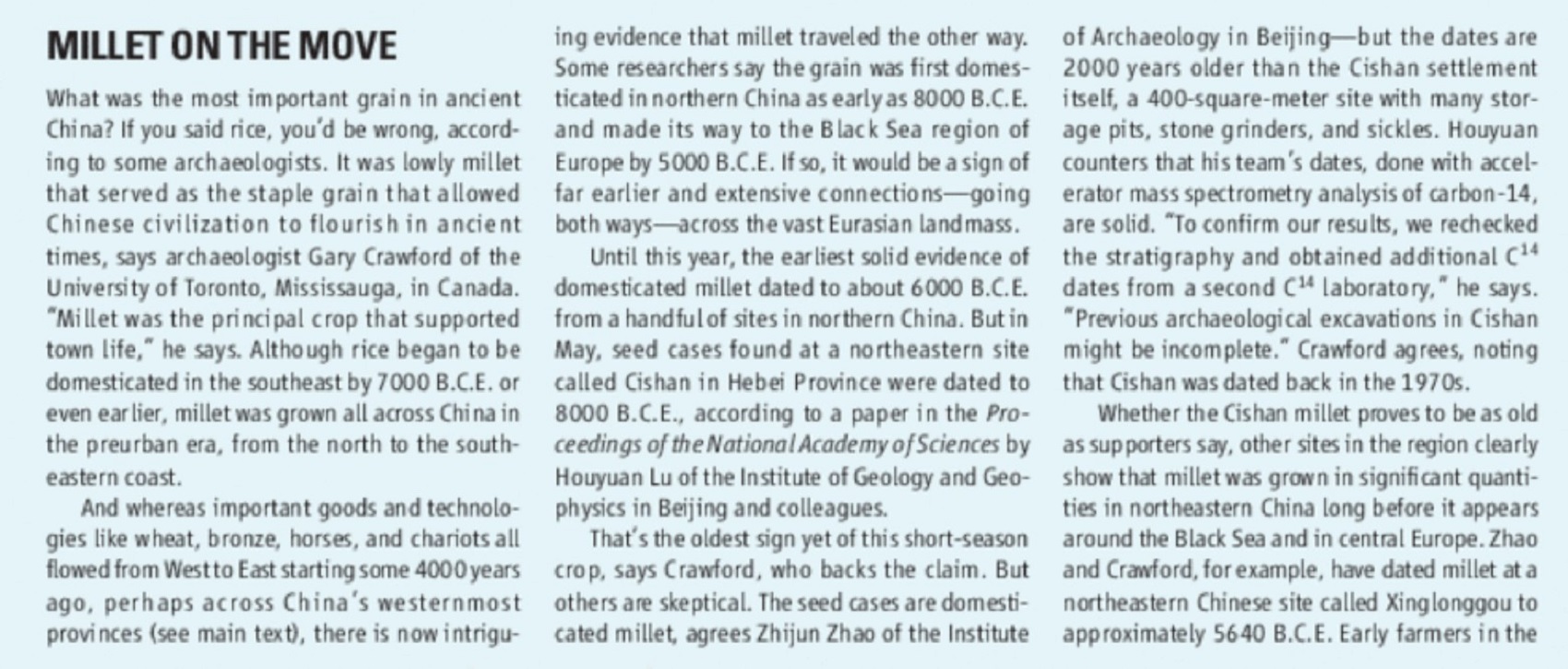
Millet on the Move
“By 5000 BCE or 7,022 years ago, millet was flourishing west of the Black Sea, where there are at least 20 published sites with archaeological evidence for the crop, such as the Gomolava site in the Balkans. It was first domesticated in China, probably in the Yellow River valley, about 8000 BP, and spread outward from there into Asia, Europe, and Africa.” ref
“Broomcorn domestication is believed to have taken place about 8000 BP. Stable isotope studies of human remains at sites such as Jiahu, Banpo, Xinglongwa, Dadiwan, and Xiaojingshan suggest that while millet agriculture was present ca 8000 BP, it did not become a dominant crop until about a thousand years later, during the Middle Neolithic (Yangshao).” ref
“Broomcorn remains which suggests a highly developed millet-based agriculture have been found at several sites associated with Middle Neolithic (7500-5000 BP) cultures including the Peiligang culture in Henan province, the Dadiwan culture of Gansu province and the Xinle culture in Liaoning province. The Cishan site, in particular, had more than 80 storage pits filled with millet husk ashes, totaling an estimated 50 tons of millet.” ref
“According to a statement released by Rutgers University, evidence for the cultivation of broomcorn millet (Panicum miliaceum) in the late second millennium BCE. has been found at the site of Khani Masi, which is located in the Kurdistan region of northern Iraq.” ref
“Archaeological remains show that these millets became common in their north China heartland around 7,500 years ago. Seeds recovered from sites of different ages show signs of being domesticated and selected — namely, they got bigger and bigger over time. Human skeletons of the same age show that millets were a staple food source.” ref
“Later, these millets traveled from north China into Central Asia and Europe, and south through Thailand to India. And nomadic shepherd-farmers were instrumental in this spread, Jones says. He got a chance to see for himself how this might have occurred while in Mongolia. The herders there spend their lives on horseback, he tells The Salt, but they’ll often find a plot of land and scatter millet seeds onto it, returning after a few weeks to harvest the crop.” ref
“Millets, Jones says, make a perfect bridge between nomadic life and settled agriculture, because they have a very short growing season – just 45 days, compared to 100 or more for rice – and need very little attention, ideal for nomadic horsemen on the go. “They’d tread the seed in with their horses’ hooves and off they go,” Jones explains, “maybe leaving a couple of teenagers behind to keep an eye on it.” ref
“Meanwhile, in other parts of China, local rice, and wheat, and barley from the Near East, were being further domesticated. Roaming shepherds and herders from different regions would have encountered each other, exchanging grains and advice on how to grow them. Evidence of this knowledge-sharing shows up in the archeological record between 2,500 and 1,600 years ago, when “crops that have been there for thousands of years start moving around all over the place,” Jones says. Millets moved into the Fertile Crescent, where wheat and barley were predominant, and wheat and barley moved into northern China.” ref
“At the same, Jones’ research shows, agriculture in China moved out of the foothills — where individual farmers could control the flow of water — and into the valley bottoms. And as crops grew more diverse and moved downstream, farmers had to work together to manage their increasingly complex agriculture — a need that encouraged settlements and community-building.” ref
7,022–6,522 years ago Hemudu culture Yuyao and Zhoushan, Zhejiang
“The Hemudu culture (5500 to 3300 BCE) was a Neolithic culture that flourished just south of the Hangzhou Bay in Jiangnan in modern Yuyao, Zhejiang, China. The culture may be divided into early and late phases, before and after 4000 BCE or 6,022 years ago respectively. The site at Hemudu, 22 km northwest of Ningbo, was discovered in 1973. Hemudu sites were also discovered at Tianluoshan in Yuyao city, and on the islands of Zhoushan. Hemudu are said to have differed physically from inhabitants of the Yellow River sites to the north. Some authors propose that the Hemudu Culture was a source of the pre-Austronesian cultures.” ref
“The Hemudu people lived in long, stilt houses. Communal longhouses were also common in Hemudu sites, much like the ones found in modern-day Borneo. The Hemudu culture was one of the earliest cultures to cultivate rice. Recent excavations at the Hemudu period site of Tianluoshan has demonstrated rice was undergoing evolutionary changes recognized as domestication. Most of the artifacts discovered at Hemudu consist of animal bones, exemplified by hoes made of shoulder bones used for cultivating rice.” ref
“The culture also produced lacquer wood. A red lacquer wood bowl at the Zhejiang Museum is dated to 4,000-5,000 BCE or 6,022-7,022 years ago. It is believed to be the earliest such object in the world. The remains of various plants, including water caltrop, Nelumbo nucifera, acorns, melon, wild kiwifruit, blackberries, peach, the foxnut, or Gorgon euryale, and bottle gourd, were found at Hemudu and Tianluoshan. The Hemudu people likely domesticated pigs but practiced extensive hunting of deer and some wild water buffalo. Fishing was also carried out on a large scale, with a particular focus on crucian carp.” ref
“The practices of fishing and hunting are evidenced by the remains of bone harpoons and bows and arrowheads. Music instruments, such as bone whistles and wooden drums, were also found at Hemudu. Artifact design by Hemudu inhabitants bears many resemblances to those of Insular Southeast Asia. The culture produced a thick, porous pottery. This distinctive pottery was typically black and made with charcoal powder. Plant and geometric designs were commonly painted onto the pottery; the pottery was sometimes also cord-marked. The culture also produced carved jade ornaments, carved ivory artifacts, and small clay figurines.” ref
“The early Hemudu period is considered the maternal clan phase. Descent is thought to have been matrilineal and the social status of children and women comparatively high. In the later periods, they gradually shifted into patrilineal clans. During that period, the social status of men rose and descent was passed through the male line.” ref
“Hemudu’s inhabitants worshiped a sun spirit as well as a fertility spirit. They also enacted shamanistic rituals to the sun and believed in bird totems. A belief in an afterlife and ghosts is thought to have been widespread as well. People were buried with their heads facing east or northeast and most had no burial objects. Infants were buried in urn-casket style burials, while children and adults received earth level burials.” ref
“They did not have a definite communal burial ground, for the most part, but a clan communal burial ground has been found from the later period. Two groups in separate parts of this burial ground are thought to be two intermarrying clans. There were noticeably more burial goods in this communal burial ground.” ref
“Fossilized amoeboids and pollen suggests Hemudu culture emerged and developed in the middle of the Holocene Climatic Optimum. A study of a sea-level highstand in the Ningshao Plain from around 7000 to 5000 years ago shows that there may have been stabilized lower sea levels at this time, followed by frequent flooding from around 5000 to 3900 years ago. The climate was said to be tropical to subtropical with high temperatures and much precipitation throughout the year.” ref
7,022–5,022 years ago Daxi culture Three Gorges region
“The Daxi culture showed evidence of cultural interactions with the Yangtze River Delta region. The white pan artefacts from the culture were discovered at several Yangtze River Delta sites, including the type site of the Majiabang culture. Conversely, jade artefacts at Daxi sites show possible influence from the Yangtze River Delta region. The Daxi culture was followed by the Qujialing culture.” ref
7,022–5,022 years ago Majiabang culture Lake Tai area and north of Hangzhou Bay
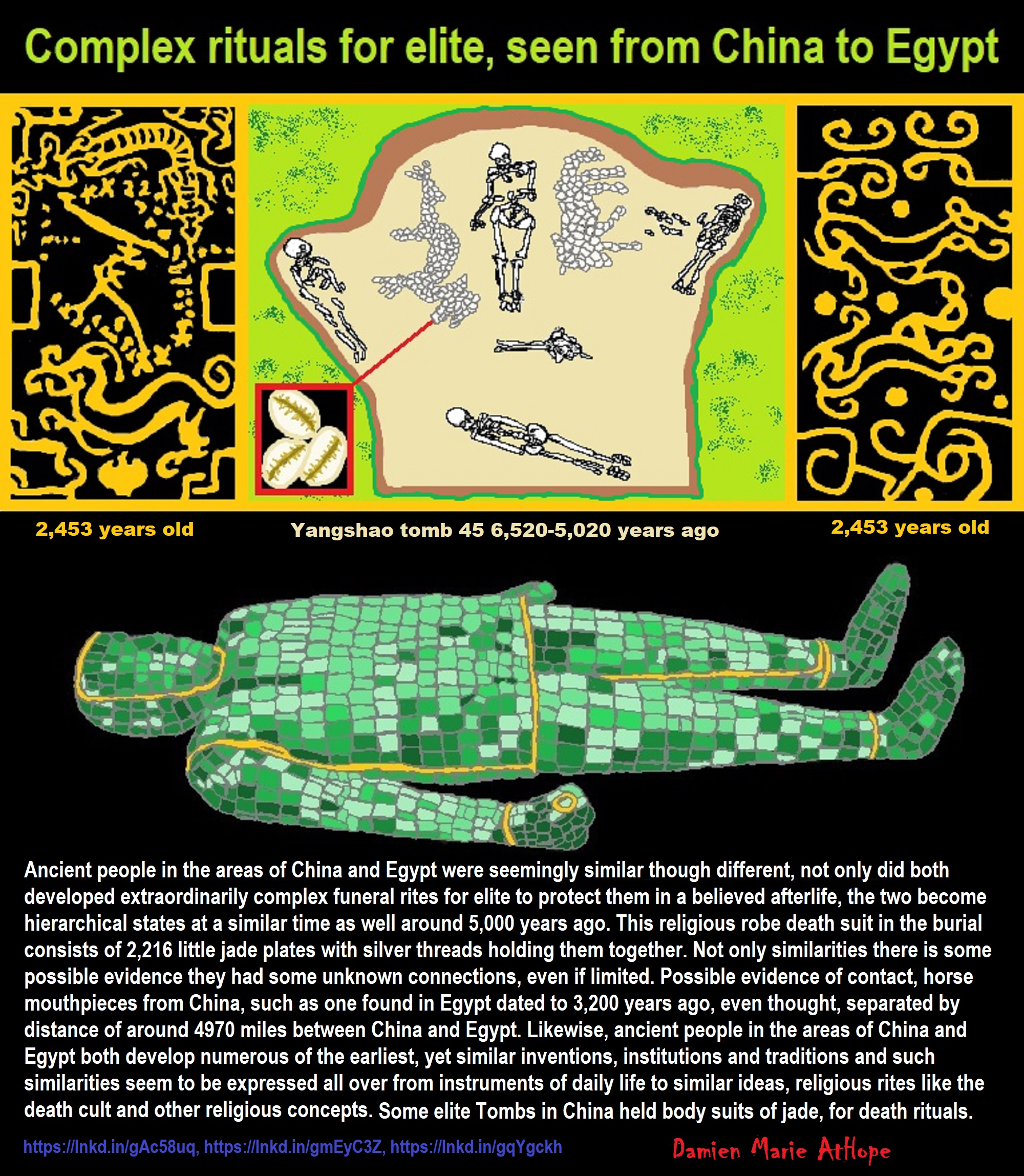
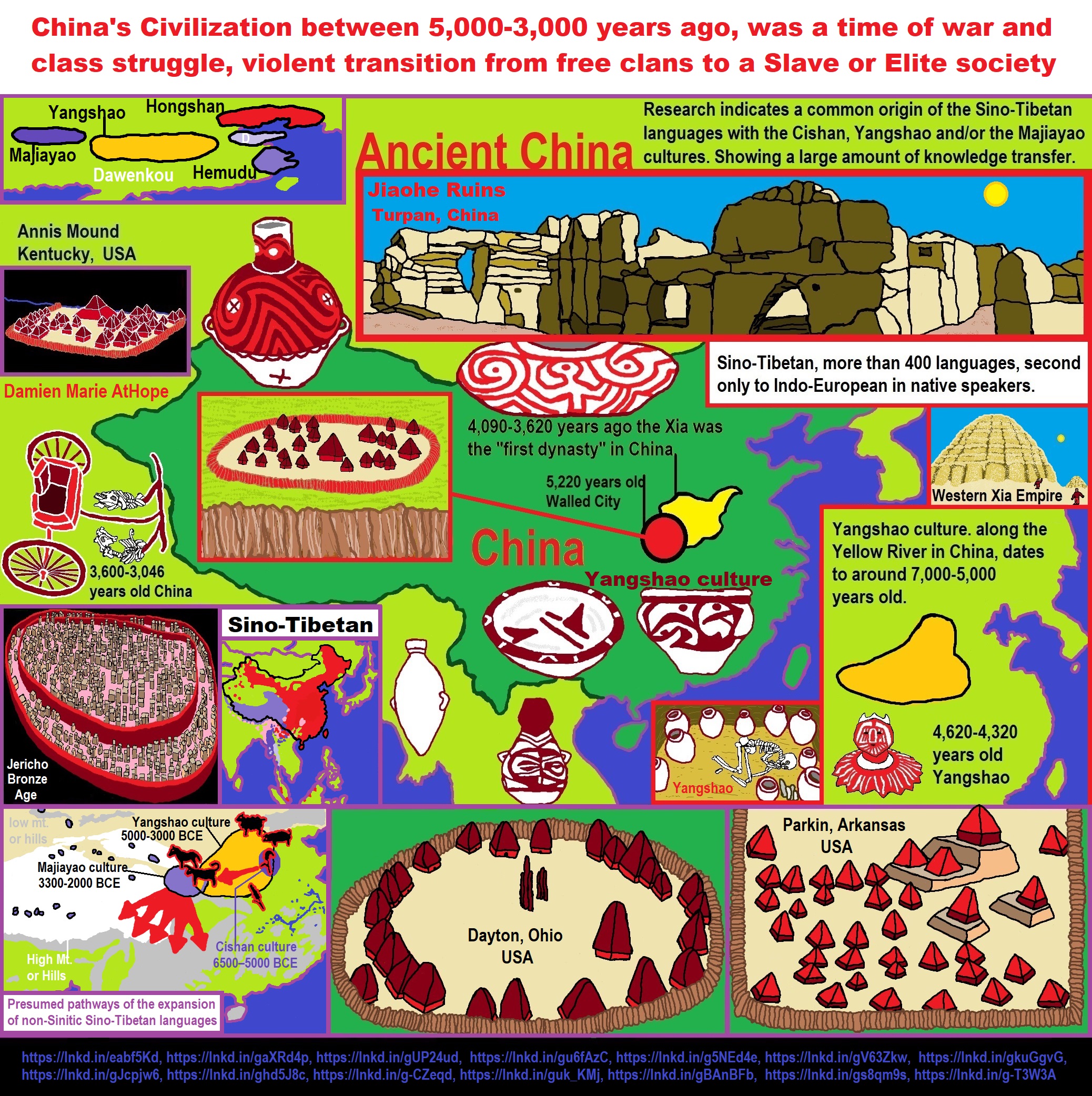
ref, ref, ref, ref, ref, ref, ref, ref, ref, ref, ref
7,022–5,022 years ago Yangshao culture Henan, Shaanxi, and Shanxi
“The Yangshao culture was a Neolithic culture that existed extensively along the Yellow River in China. It is dated from around 5000 to 3000 BCE. The culture is named after the Yangshao site, the first excavated site of this culture, which was discovered in 1921 in Yangshao town, Mianchi County, Henan Province by the Swedish geologist Johan Gunnar Andersson (1874–1960). The culture flourished mainly in the provinces of Henan, Shaanxi, and Shanxi. Recent research indicates a common origin of the Sino-Tibetan languages with the Cishan, Yangshao, and/or the Majiayao cultures.” ref
“The main food of the Yangshao people was millet, with some sites using foxtail millet and others proso millet, though some evidence of rice has been found. The exact nature of Yangshao agriculture, small-scale slash-and-burn cultivation versus intensive agriculture in permanent fields, is currently a matter of debate. Once the soil was exhausted, residents picked up their belongings, moved to new lands, and constructed new villages. However, Middle Yangshao settlements such as Jiangzhi contain raised-floor buildings that may have been used for the storage of surplus grains. Grinding stones for making flour were also found.” ref
“The Yangshao people kept pigs and dogs. Sheep, goats, and cattle are found much more rarely. Much of their meat came from hunting and fishing with stone tools. Their stone tools were polished and highly specialized. They may also have practiced an early form of sericulture. The Yangshao culture crafted pottery. Yangshao artisans created fine white, red, and black painted pottery with human facial, animal, and geometric designs. Unlike the later Longshan culture, the Yangshao culture did not use pottery wheels in pottery-making. Excavations found that children were buried in painted pottery jars. The Yangshao culture produced silk to a small degree and wove hemp. Men wore loin clothes and tied their hair in a top knot. Women wrapped a length of cloth around themselves and tied their hair in a bun.” ref
“Houses were built by digging a rounded rectangular pit around one metre deep. Then they were rammed, and a lattice of wattle was woven over it. Then it was plastered with mud. The floor was also rammed down. Next, a few short wattle poles would be placed around the top of the pit, and more wattle would be woven to it. It was plastered with mud, and a framework of poles would be placed to make a cone shape for the roof. Poles would be added to support the roof. It was then thatched with millet stalks. There was little furniture; a shallow fireplace in the middle with a stool, a bench along the wall, and a bed of cloth. Food and items were placed or hung against the walls. A pen would be built outside for animals. Yangshao villages typically covered ten to fourteen acres and were composed of houses around a central square.” ref
“Although early reports suggested a matriarchal culture, others argue that it was a society in transition from matriarchy to patriarchy, while still others believe it to have been patriarchal. The debate hinges on differing interpretations of burial practices. The discovery of a dragon statue dating back to the fifth millennium BCE in the Yangshao culture makes it the world’s oldest known dragon depiction, and the Han Chinese continue to worship dragons to this day.” ref
The Yangshao culture is conventionally divided into three phases:
- The early period or Banpo phase, c. 5,000–4,000 BCE or 7,022-6,022 years ago) is represented by the Banpo, Jiangzhai, Beishouling, and Dadiwan sites in the Wei River valley in Shaanxi.
- The middle period or Miaodigou phase, c. 4,000–3,500 BCE or 6,022-5,522 years ago) saw an expansion of the culture in all directions, and the development of hierarchies of settlements in some areas, such as western Henan.
- The late period (c. 3,500–3,000 BCE or 5,522-5,022 years ago) saw a greater spread of settlement hierarchies. The first wall of rammed earth in China was built around the settlement of Xishan (25 ha) in central Henan (near modern Zhengzhou).” ref
- The Majiayao culture (c. 3,300–2,000 BCE) to the west is now considered a separate culture that developed from the middle Yangshao culture through an intermediate Shilingxia phase.” ref
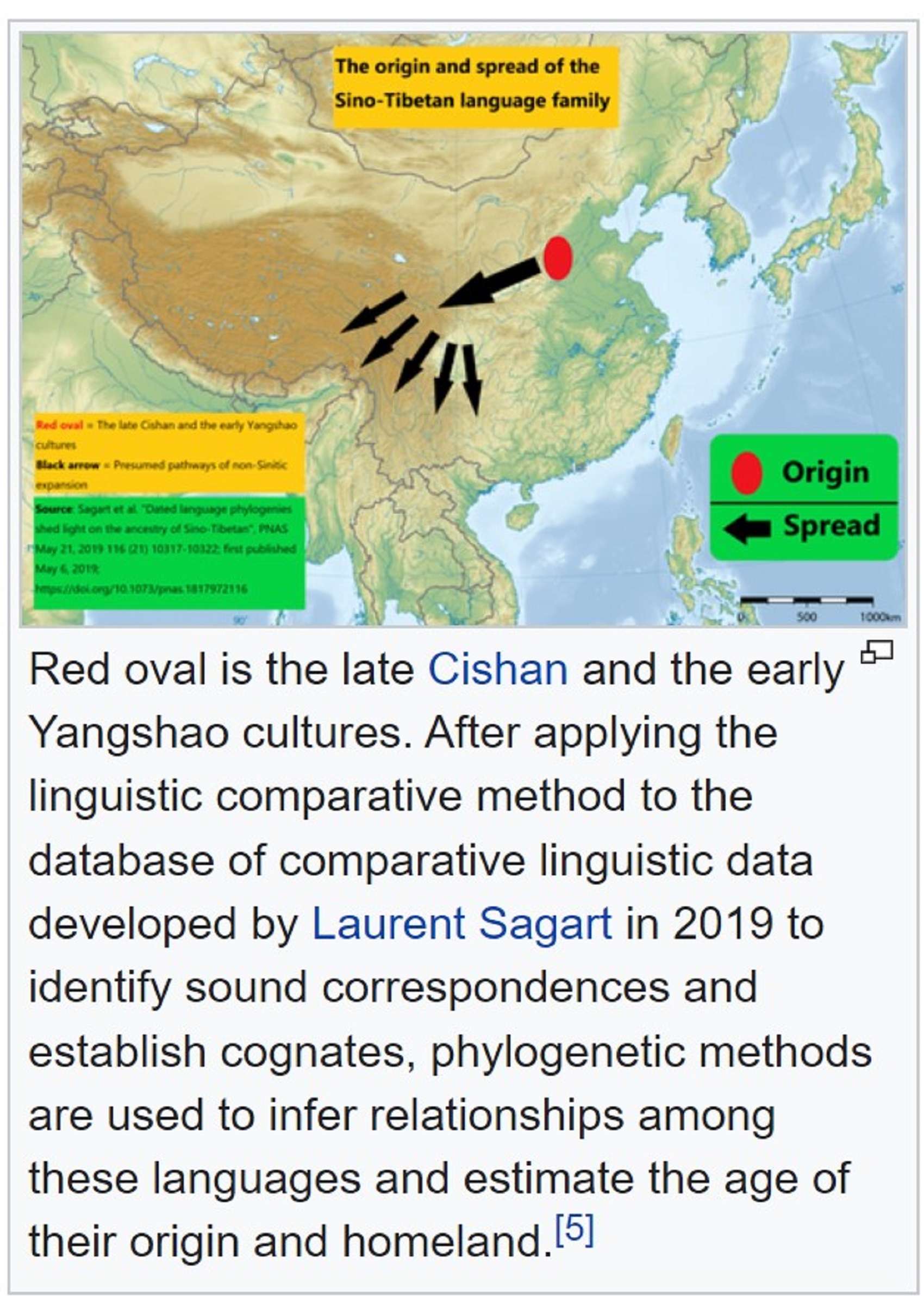
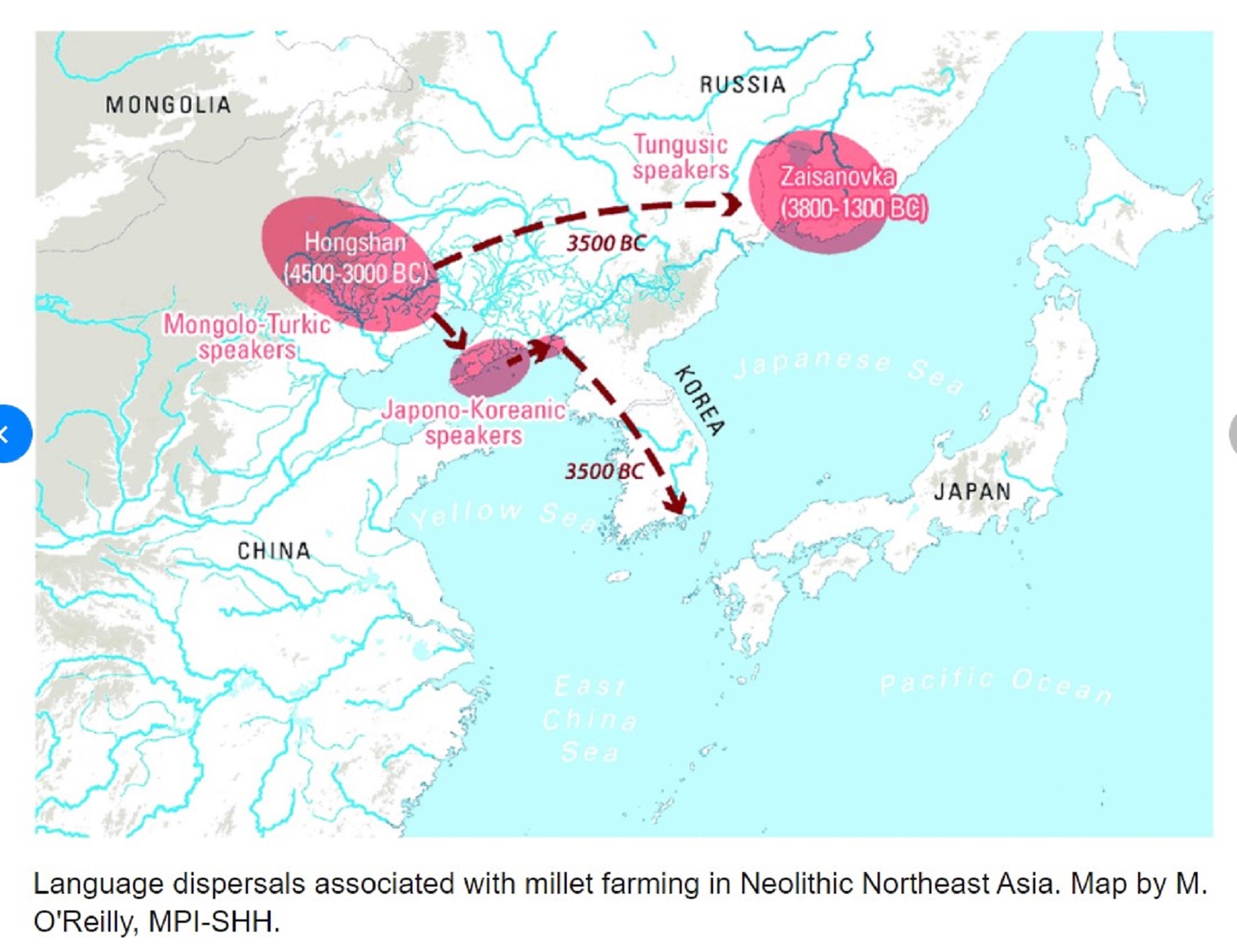
“The Japanese language displays remarkable similarities with the Transeurasian—traditionally called “Altaic”—languages as well as with the Austronesian languages. This fact has given rise to a certain polarization in classification attempts between scholars who try to relate Japanese to the Transeurasian languages on the one hand and others who try to relate it to the Austronesian languages on the other hand. Attempts to make the extremes meet are found in consensus approaches such as the idea that Japanese is a mixed language or that it is a language of Transeurasian ancestry on an Austronesian substratum.” ref
“In this paper, the spread of the Transeurasian languages in general and Japanic in particular is viewed through the lens of the Farming/Language Dispersal Hypothesis. This hypothesis, proposed by Renfrew (1987), Bellwood and Renfrew (2002), Diamond and Bellwood (2003), and Bellwood (2005, 2011), posits that many of the world’s major language families owe their dispersal to the adoption of agriculture: on becoming farmers, populations grew in number, moved into wider territories and displaced the languages of preexisting hunter-gatherers.” ref
“The specific interpretation of this hypothesis proposed here is that the Transeurasian homeland correlates with the early Neolithic Xinglongwa culture (6,200–3,750 BCE or 8,222-5,772 years ago), situated in Southern Manchuria from the seventh millennium BCE onwards, while the homeland of Japanic is situated on the Liaodong Peninsula between the third and second millennium BCE, with its speakers adopting rice agriculture from a para-Austronesian population within the Liaodong-Shandong interaction sphere. Sagart first hypothesized that a form of pre-Austronesian was spoken on the Shandong Peninsula during that time (Sagart, 1995), and he suggested that the linguistic ancestors of the Japanese acquired rice cultivation from speakers of an eastern language within the Sino-Tibetan-Austronesian macrofamily with whom they were once in contact (Sagart, 2011).” ref
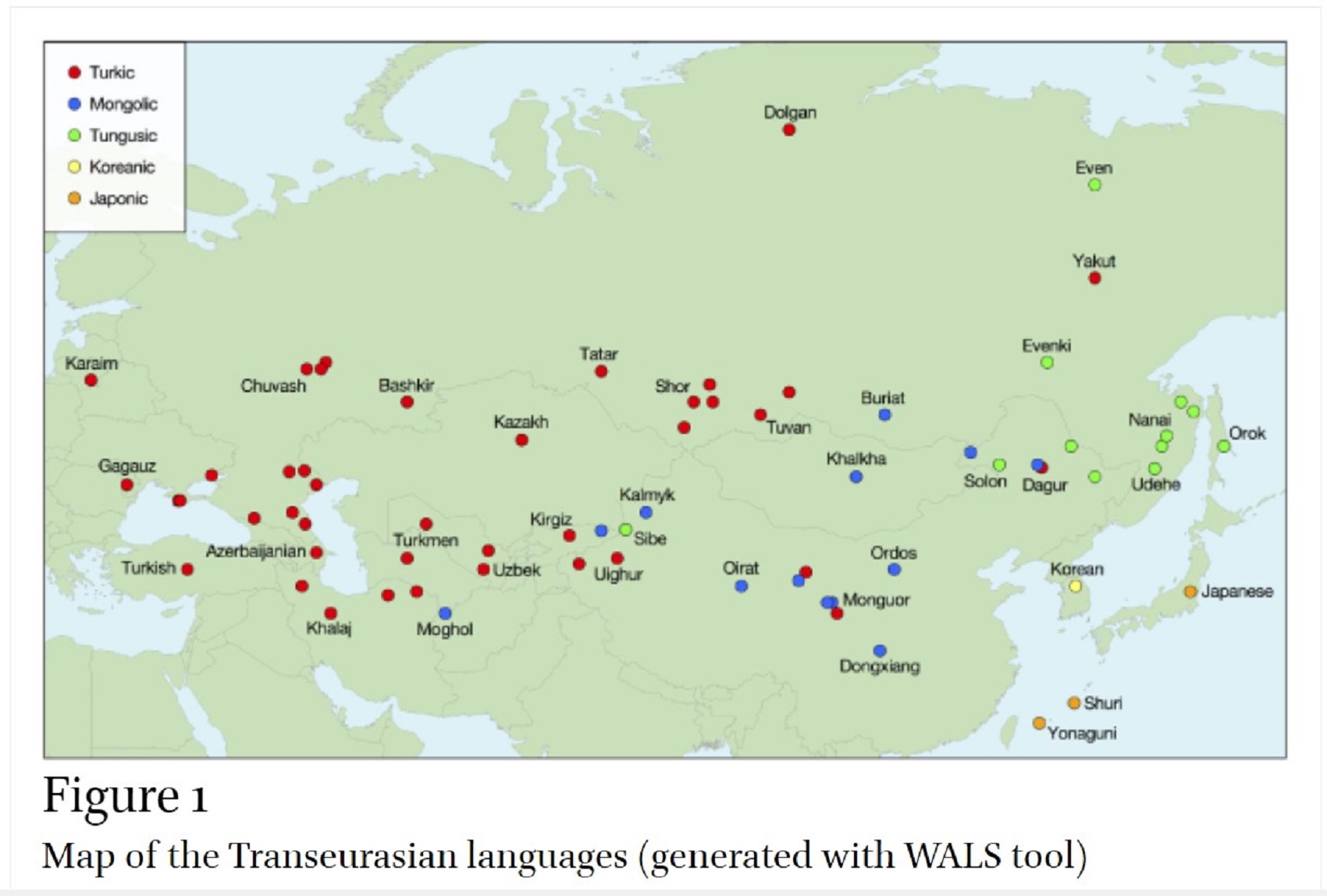
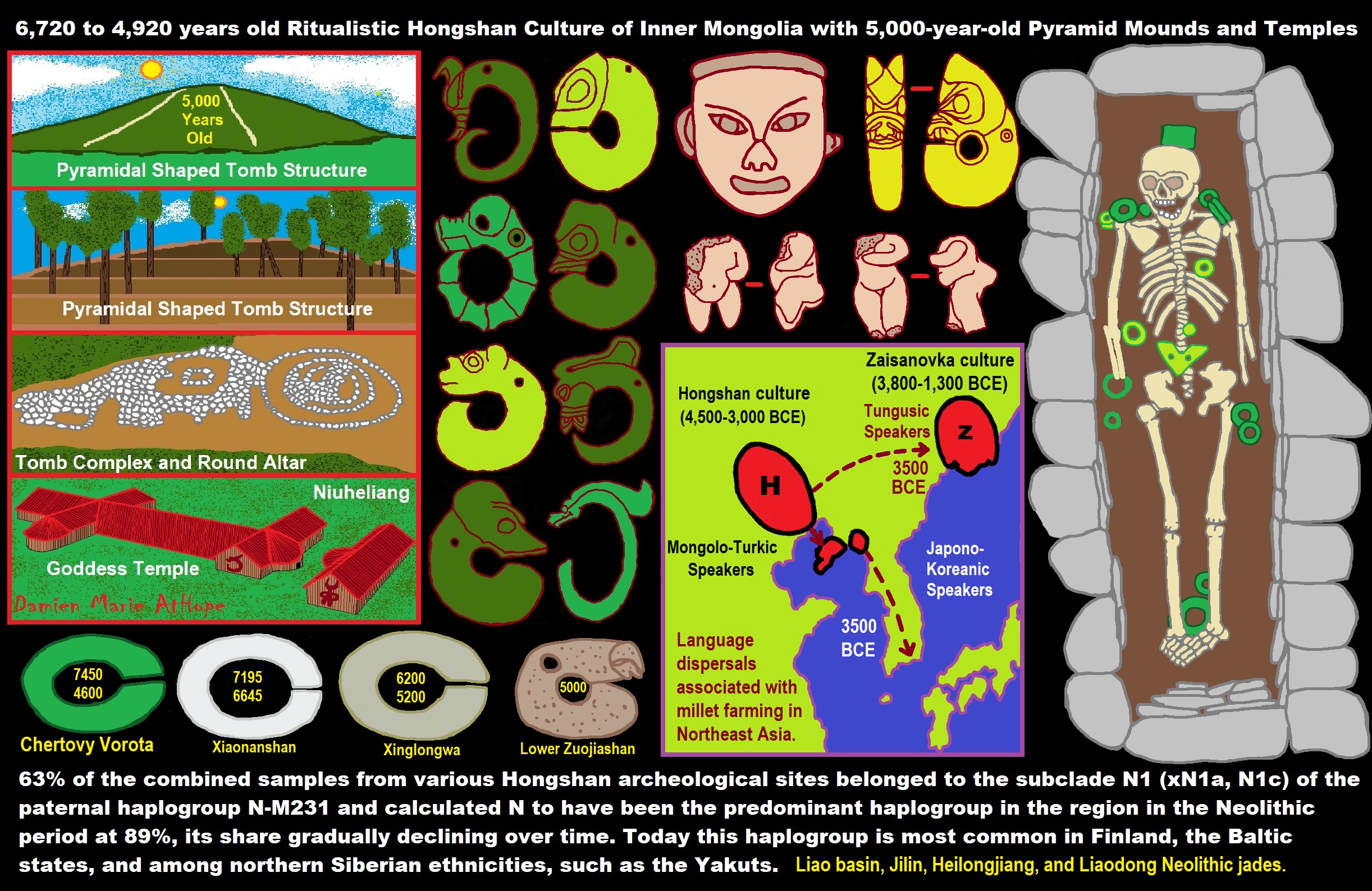
ref, ref, ref, ref, ref, ref, ref, ref, ref, ref, ref, ref, ref, ref, ref, ref, ref
6,722–4,922 years ago Hongshan culture Inner Mongolia, Liaoning, and Hebei
“The Hongshan culture was a Neolithic culture in the Liao river basin in northeast China. Hongshan sites have been found in an area stretching from Inner Mongolia to Liaoning, and dated from about 4,700 to 2,900 BCE or 6,722-4,922 years ago. The culture is named after Hongshanhou, a site in Hongshan District, Chifeng. The Hongshanhou site was discovered by the Japanese archaeologist Torii Ryūzō in 1908 and extensively excavated in 1935 by Kōsaku Hamada and Mizuno Seiichi.” ref
“In northeast China, Hongshan culture was preceded by Xinglongwa culture (6200–5400 BCE), Xinle culture (5300–4800 BCE), and Zhaobaogou culture, which may be contemporary with Xinle and a little later. The Yangshao culture of the Yellow River existed contemporaneously with the Hongshan culture (see map). These two cultures interacted with each other. Similar to the Yangshao culture, the Hongshan culture cultivated millet. Isotope analyses revealed that millet contributed up to 70% of the human diet in the Early Hongshan and up to 80% in the Late Hongshan.” ref
“A study by Yinqiu Cui et al. from 2013 found that 63% of the combined samples from various Hongshan archeological sites belonged to the subclade N1 (xN1a, N1c) of the paternal haplogroup N-M231 and calculated N to have been the predominant haplogroup in the region in the Neolithic period at 89%, its share gradually declining over time. Today this haplogroup is most common in Finland, the Baltic states, and among northern Siberian ethnicities, such as the Yakuts. Other paternal haplogroups identified in the study were C and O3a (O3a3), both of which predominate among the present-day inhabitants. Nelson et al. 2020 attempts to link the Hongshan culture to a “Transeurasian” linguistic context (see Altaic).” ref
“Hongshan burial artifacts include some of the earliest known examples of jade working. The Hongshan culture is known for its jade pig dragons and embryo dragons. Clay figurines, including figurines of pregnant women, are also found throughout Hongshan sites. Small copper rings were also excavated. The archaeological site at Niuheliang is a unique ritual complex associated with the Hongshan culture.” ref
“Excavators have discovered an underground temple complex—which included an altar—and also cairns in Niuheliang. The temple was constructed of stone platforms, with painted walls. Archaeologists have given it the name Goddess Temple due to the discovery of a clay female head with jade inlaid eyes. It was an underground structure, 1m deep. Included on its walls are mural paintings.” ref
“Housed inside the Goddess Temple are clay figurines as large as three times the size of real-life humans. The exceedingly large figurines are possibly deities, but for a religion not reflective in any other Chinese culture. The existence of complex trading networks and monumental architecture (such as pyramids and the Goddess Temple) point to the existence of a “chiefdom” in these prehistoric communities.” ref
“Painted pottery was also discovered within the temple. Over 60 nearby tombs have been unearthed, all constructed of stone and covered by stone mounds, frequently including jade artifacts. Cairns were discovered atop two nearby two hills, with either round or square stepped tombs, made of piled limestone. Entombed inside were sculptures of dragons and tortoises. It has been suggested that religious sacrifice might have been performed within the Hongshan culture.” ref
“Hongshan Feng shui was just as suggested by evidence found at early Yangshao culture sites, Hongshan culture sites also provide the earliest evidence for feng shui. The presence of both round and square shapes at Hongshan culture ceremonial centers suggests an early presence of the gaitian cosmography (“round heaven, square earth”). Early feng shui relied on astronomy to find correlations between humans and the universe.” ref
“The Hongshan culture region was thought to have been desert for the past 1 million years. However, a 2015 study found that the region once featured rich aquatic resources and deep lakes and forests that existed from 12,000 years ago to 4,000 years ago. It was changed into desert by climate change which began approximately 4,200 years ago. Therefore, some of the people of the Hongshan culture may have emigrated south to the Yellow River valley approximately 4,000 years ago.” ref
“Archaeological evidence discovered at the Miaozigou site in Ulanqab, Inner Mongolia, a northern branch of the Yangshao culture from the Yellow River (the Yangshao culture is speculated to be the origin of the Sino-Tibetan languages) demonstrates similarities in the material cultures between the Yellow River and Liao River cultures. Three individuals from the Miaozigou site belonged to haplogroup N1(xN1a, N1c), while the main lineage of Yellow River valley cultures is O3-M122. The existence of N1(xN1a, N1c) among the Miaozigou individuals could serve as evidence for the migration of some of the Hongshan people.” ref
“Some Chinese archaeologists such as Guo Da-shun see the Hongshan culture as an important stage of early Chinese civilization. Whatever the linguistic affinity of the ancient denizens, Hongshan culture is believed to have exerted an influence on the development of early Chinese civilization. The culture may have also contributed to the development of settlements in ancient Korea. However, the Hongshan culture is also commonly used in Korean pseudohistory.” ref
“The most popular Y DNA haplogroup I1 (I1a Df29) was identified 5,022 years ago. The E1b1b, J1, J2, and G2a are extremely rare (J1 percentage: 1%; J2 and G2a percentage 1-5%) and located in small areas of southern Sweden and Norway. Another very rare haplogroup is represented by Uralic N1c1, more popular in Uralic Finland and Suomi.” ref
“According to FTDNA, it was spread to north east Europe about 6,022 years ago. This haplogroup is connected to Kunda culture (7,022-8,022 years ago) and Comb Cermic culture (6,222-4,022 years ago), both showing huge connections with the distribution of N1c1 in Europe. This haplogroup is derived from Siberia and this theory which can explain the extra Mongoloid results in Finnish and Soumi.” ref
“R1a haplogroups (R1a1a1b1 Z283) came with Corded ware culture about 4,900-4,422 years ago, R1b (R1b1a2a1a L11 then Germanic R1b1a2a1a1 S21) and I2a2 P214 haplogroups came with Germanic languages and Nordic bronze age culture about 4,022-3,522 years ago.” ref
“J1, J2, G2a, and E1b1b are seems to be Neolithic and own an extremely rare distribution. Also according to Honkola et al. 2013, the majority of Scandinavian I1 belongs to I1a2 L22 unlike continental European I1 it shows Finnish I1 is from the same source as Norwegian and Swedish I1. More evidence that I1 in Finland derived before to the foundation of Germanic speakers in Sweden and Norway, which started about 3,522-4,022 years ago.” ref

N1(xN1a, N1c) was found in ancient bones of Liao civilization:
- Niuheliang (Hongshan Culture, 6500–5000 BP) 66.7%(=4/6)
- Halahaigou (Xiaoheyan Culture, 5000–4200 BP) 100.0%(=12/12)
- Dadianzi (Lower Xiajiadian culture, 4200–3600 BP) 60.0%(=3/5) ref
6,100–4,622 years ago Dawenkou culture Shandong, Anhui, Henan, and Jiangsu
“The Dawenkou culture was a Chinese Neolithic culture primarily located in the eastern province of Shandong, but also appearing in Anhui, Henan, and Jiangsu. The culture existed from 4100 to 2600 BCE, and co-existed with the Yangshao culture. Turquoise, jade, and ivory artifacts are commonly found at Dawenkou sites. The earliest examples of alligator drums appear at Dawenkou sites. Neolithic signs, perhaps related to subsequent scripts, such as those of the Shang Dynasty, have been found on Dawenkou pottery.” ref
“Archaeologists commonly divide the culture into three phases: the early phase (4100–3500 BCE), the middle phase (3500–3000 BCE), and the late phase (3000–2600 BCE). Based on the evidence from grave goods, the early phase was highly egalitarian. The phase is typified by the presence of individually designed, long-stemmed cups. Graves built with earthen ledges became increasingly common during the latter parts of the early phase. During the middle phase, grave goods began to emphasize quantity over diversity.” ref
“During the late phase, wooden coffins began to appear in Dawenkou burials. The culture became increasingly stratified, as some graves contained no grave goods while others contained a large quantity of grave goods. The type site at Dawenkou, located in Tai’an, Shandong, was excavated in 1959, 1974, and 1978. Only the middle layer at Dawenkou is associated with the Dawenkou culture, as the earliest layer corresponds to the Beixin culture and the latest layer corresponds to the early Shandong variant of the Longshan culture.” ref
“The term “chiefdom” seems to be appropriate in describe the political organization of the Dawenkou. A dominant kin group likely held sway over Dawenkou village sites, though power was most likely manifested through religious authority rather than coercion. Unlike the Beixin culture from which they descend, the people of the Dawenkou culture were noted for being engaged in violent conflict. Scholars suspect that they may have engaged in raids for land, crops, livestock, and prestige goods.” ref
“The warm and wet climate of the Dawenkou area was suitable for a variety of crops, though they primarily farmed millet at most sites. Their production of millet was quite successful and storage containers have been found that could have contained up to 2000 kg of millet, once decomposition is accounted for, have been found. For some of the southern Dawenkou sites, rice was a more important crop, however, especially during the late Dawenkou period. Analysis done on human remains at Dawenkou sites in southern Shandong revealed that the diet of upper-class Dawenkou individuals consisted mainly of rice, while ordinary individuals ate primarily millet.” ref
“The Dawenkou people successfully domesticated chicken, dogs, pigs, and cattle, but no evidence of horse domestication was found. Pig remains are by far most abundant, accounting for about 85% of the total, and are thought to be the most important domesticated animal. Pig remains were also found in Dawenkou burials also highlighting their importance.” ref
“Seafood was also an important staple of the Dawenkou diet. Fish and various shellfish mounds have been found in the early periods indicating that they were important food sources. Although these piles became less frequent in the later stages, seafood remained an important part of the diet.” ref
“Dawenkou’s inhabitants were one of the earliest practitioners of trepanation in prehistoric China. A skull of a Dawenkou man dating to 3000 BCE was found with severe head injuries which appeared to have been remedied by this primitive surgery. Alligator hide drums have also been found in Dawenkou sites. The Dawenkou interacted extensively with the Yangshao culture.” ref
“For two and a half millennia of its existence the Dawenkou was, however, in a dynamic interchange with the Yangshao Culture, in which process of interaction it sometimes had the lead role, notably in generating Longshan. Scholars have also noted similarities between the Dawenkou and the Liangzhu culture as well as the related cultures of the Yantze River basin.” ref
“According to some scholars, the Dawenkou culture may have a link with a pre-Austronesian language. Other researchers also note a similarity between Dawenkou inhabitants and modern Austronesian people in cultural practices such as tooth avulsion and architecture. However, the Dawenkou appeared to be genetically distinct from the pre-Austronesian cultures to their south.” ref
“The physical similarity of the Jiahu people to the later Dawenkou (2600 BC±4300 BC) indicates that the Dawenkou might have descended from the Jiahu, following a slow migration along the middle and lower reaches of the Huai river and the Hanshui valley. Other scholars have also speculated that the Dawenkou originate in nearby regions to the south. The Dawenkou culture descends from the Beixin culture, but is deeply influenced by the northward expanding Longqiuzhuang culture located between the Yangtze and Huai rivers.” ref
“The people of Dawenkou exhibited a primarily Sinodont dental pattern. The Dawenkou were also physically dissimilar to the Neolithic inhabitants of Hemudu, Southern China, and Taiwan. DNA testing revealed that neolithic inhabitants of Shandong were closer to northern East Asians. Dawenkou burials and social status.” ref
5,800–5,322 years ago Songze culture Lake Tai area
“Three radiocarbon dates were taken from Songze culture layers at Jiangli near Lake Tai. Two of the dates were obtained from charred rice grains, returning dates of 3360–3090 BCE and 3540–3370 BCE. The third date was taken from knotgrass and produced a date of 3660–3620 BCE. Although it is accepted to be the successor of the Majiabang culture, others have suggested that Songze was a successor phase to the Hemudu culture. Excavations show that the most recent had pottery from the Spring and Autumn period; the middle layer was a cemetery with 148 graves and numerous artifacts; the oldest layer belonged to a village of the Majiabang culture.” ref
Nanhebang: 92 graves have been excavated from a Songze cemetery at Nanhebang.” ref
Pishan: The Pishan cemetery contained 61 burials.” ref
Dongshan: Dongshan Village is located near Jingang Town 18 km west of Zhangjiagang. It was discovered in 1989 and has undergone excavations by the Suzhou Museum (1989–1990), followed by two large rescue excavations led by the Nanjing Museum in 2008–2009. The site is divided into three areas: area 1 was a small cemetery of 27 burials, all of which had different quantities of grave goods, which has been used to suggest the existence of a stratified society; area 2 was a residential comprising five buildings in the center of the site; area 3 was another burial ground in the site’s west, with 10 tombs.” ref
5,400–4,272 years ago Liangzhu culture Yangtze River Delta
“The Liangzhu culture (around 5,322–4,322 years ago) was the last Neolithic jade culture in the Yangtze River Delta of China. The culture was highly stratified, as jade, silk, ivory, and lacquer artifacts were found exclusively in elite burials, while pottery was more commonly found in the burial plots of poorer individuals. This division of class indicates that the Liangzhu period was an early state, symbolized by the clear distinction drawn between social classes in funeral structures.” ref
A pan-regional urban center had emerged at the Liangzhu city-site and elite groups from this site presided over the local centers. The Liangzhu culture was extremely influential and its sphere of influence reached as far north as Shanxi and as far south as Guangdong. The primary Liangzhu site was perhaps among the oldest Neolithic sites in East Asia that would be considered a state society.” ref
“The type site at Liangzhu was discovered in Yuhang County, Zhejiang, and initially excavated by Shi Xingeng in 1936. A 2007 analysis of the DNA recovered from human remains shows high frequencies of Haplogroup O1 in Liangzhu culture linking this culture to modern Austronesian and Tai-Kadai populations. It is believed that the Liangzhu culture or other associated subtraditions are the ancestral homeland of Austronesian speakers.” ref
“The Liangzhu Culture entered its prime around 2500 BCE, but suddenly disappeared from the Taihu Lake area around 2300 BCE when it reached its peak. Almost no traces of the culture were found from the following years in this area.” ref
“Recent research has shown that rising waters interrupted the development of human settlements several times in this area. This led researchers to conclude the demise of the Liangzhu culture was brought about by extreme environmental changes such as floods, as the cultural layers are usually interrupted by muddy or marshy and sandy–gravelly layers with buried paleo trees.” ref
“An alternative scenario proposes that extremely heavy monsoon rains during this period resulted in massive flooding which destroyed dams and the culture’s settlements. This theory was backed by a study in 2021, suggesting that a decades-long period of high precipitation (between around 4345 ± 32 years and 4324 ± 30 years ago), probably caused by increased frequency of El Niño–Southern Oscillation conditions, coincided with the disappearance of the culture.” ref
“The researchers stated that “massive rainfall in the entire middle-lower reaches of the Yangtze River Valley might have induced fluvial flooding and/or overbank marine flooding transported by the Yangtze River plume and thus impeded human habitation and rice farming. Massive flooding and inundation due to poor drainage in the low-lying land may have forced the Liangzhu people to abandon their capital city and dwellings in the Taihu Plain, ultimately leading to the collapse of the entire Liangzhu civilization.” ref
“Some evidence suggests that Lake Tai was formed as an impact crater only 4500 years ago, which could help explain the disappearance of the Liangzhu culture. However, other work does not find an impact crater structure or shocked minerals at Lake Tai.” ref
“The inhabitants of Liangzhu sites used artifact designs of “bent knee” shaped adze handles, stone untangled adzes, art styles emphasizing the use of spirals and circles, cord-marking of pottery, pottery pedestals with cut-out decorations, baked clay spindle whorls, slate reaping knives, and spear points. Pottery was often decorated with a red slip. These artifacts are also common in later neolithic Southeast Asia and the technological and economic toolkits of these societies possibly developed in the neolithic Yangtze River area.” ref
“Some of the Liangzhu pottery is reminiscent of the Shandong Longshan black “eggshell” style, however, most differed and were a soft-fired gray with a black or red slip. There has also been evidence of tremolite particles being used as an ingredient for crafting some of the black “eggshell” pottery. It was determined that the black color of the pottery resulted from similar advancements in carburization and firing processes.” ref
“Similarities between Liangchengzhen, the largest Dawenkou site, pottery making process and that of the Liangzhu were noted, which led researchers to believe there was communication between the two cultures. The Guangfulin site showed influence from more northern cultures but also had pottery practices very similar to that of the typical Liangzhu sites.” ref
“Researchers have found that some of the axes at Liangzhu sites were crafted using diamond tools. The inhabitants of Liangzhu, using these tools, worked corundum into ceremonial axes. The axes were said to “have been polished to a mirrorlike luster”. The techniques they used generated results that are said to be difficult to replicate even with modern technology. This is the earliest known use of diamond tools worldwide, thousands of years earlier than the gem is known to have been used elsewhere. The researchers also note that this is the only prehistoric culture known to work sapphire.” ref
The jade from this culture is characterized by finely worked large ritual jades, commonly incised with the taotie motif. The most exemplary artifacts from the culture were its cong (cylinders). The largest cong discovered weighed 3.5 kg. Bi (discs) and Yue axes (ceremonial axes) were also found. Jade pendants were also found, designed with engraved representations of small birds, turtles, and fish.” ref
“Many Liangzhu jade artifacts had a white milky bone-like aspect due to its tremolite rock origin and influence of water-based fluids at the burial sites, although jade made from actinolite and serpentine were also commonly found. Most of Liangzhu’s contemporaries have some jades, but 90 percent of all the cong and bi jades recovered, and by far the best in quality, are from Liangzhu sites.” ref
“Jade artifacts unearthed from Liangzhu sites are said to have been influential on the development of other neolithic cultures in China: “The impactful legacy of Liangzhu Culture is seen in Longshan in Shandong, Taosi in Shanxi, Qijia in Ganqing, and many other sites in northern Shaanxi, where cong tubes, bi disks and other jade objects reminiscent of Liangzhu Culture have been unearthed.” Liangzhu jade work is also said to have had a lasting influence on ritual objects in later periods of Chinese culture.” ref
“The Liangzhu “ancient city” or Liangzhu site-complex controlled the best jade products, but less important centers also produced elite crafts, which lead researchers to believe the Liangzhu culture was not a simple pyramid structure society in terms of status levels. Many minor centers had access to their own jade (nephrite). However, the Liangzhu elites at the ancient city communicated and exchanged goods with elites from other parts of the Liangzhu world (and also in other regions of Longshan-era China) and set the criteria of what jade should look like. The Liangzhu did not seem to be importers of jade, even though they did export it extensively.” ref
“A neolithic altar from the Liangzhu culture, excavated at Yaoshan in Zhejiang, demonstrates that religious structures were elaborate and made of carefully positioned piles of stones and rock walls: this indicates that religion was of considerable importance. The altar has three levels, the highest being a platform of rammed earth. Three additional platforms were paved with cobblestones. There are the remains of a stone wall. On the altar are twelve graves in two rows. Some scholars claim that ritual sacrifice of slaves was part of the Liangzhu tradition.” ref
“A 2007 analysis of the DNA recovered from human remains in archeological sites of prehistoric peoples along the Yangtze River shows high frequencies of Haplogroup O1 (Y-DNA) in the Liangzhu culture, linking them to the Austronesian and Tai-Kadai peoples. The Liangzhu culture existed in coastal areas around the mouth of the Yangtze. Haplogroup O1 was absent in other archeological sites inland. The authors of the study suggest that this may be evidence of two different human migration routes during the peopling of Eastern Asia, one coastal and the other inland, with little genetic flow between them.” ref
5,100–4,722 years ago Majiayao culture upper Yellow River region in Gansu and Qinghai
“The Majiayao culture was a group of neolithic communities who lived primarily in the upper Yellow River region in eastern Gansu, eastern Qinghai, and northern Sichuan, China. The culture existed from 3300 to 2000 BCE. The Majiayao culture represents the first time that the upper Yellow River region was widely occupied by agricultural communities and it is famous for its painted pottery, which is regarded as a peak of pottery manufacturing at that time.” ref
“Majiayao phase (3300–2500 BCE) sites are mostly found on terraces along: the upper Wei River valley; upper Bailong River valley; middle and lower Tao River and Daxia River valleys; upper Yellow River valley; the Huangshui River; and lower Datong River. The original site, whereas previously it had been referred to as the “Gansu Yangshao” culture.” ref
“This culture developed from the middle Yangshao (Miaodigou) phase, through an intermediate Shilingxia phase. The culture is often divided into three phases: Majiayao (3300–2500 BCE), Banshan (2500–2300 BCE), and Machang (2300–2000 BCE). At the end of the 3rd millennium BC, the Qijia culture succeeded the Majiayao culture at sites in three main geographic zones: eastern Gansu, central Gansu, and western Gansu/eastern Qinghai.” ref
“The most distinctive artifacts of the Majiayao culture are the painted pottery. During the Majiayao phase, potters decorated their wares with designs in black pigment featuring sweeping parallel lines and dots. The pottery of the Banshan phase is distinguished by curvilinear designs using both black and red paints. Machang-phase pottery is similar, but often not as carefully finished. Its development is associated with interaction between hunter-gatherers in the Qinghai region and the westward expansion of agricultural Yangshao people.” ref
“In contrast to plain pottery, the Majiayao painted pottery was produced at large, centralized workshops. The largest Neolithic workshop found in China is at Baidaogouping, Gansu. The manufacture of large amounts of painted pottery means there were professional craftspeople to produce it, which is taken to indicate increasing social complexity. Control over the production process and quality declined by the Banshan phase, potentially due to greater demand for pottery to use in funeral rituals, similar to what Hung Ling-yu calls the “modern Wal-Mart syndrome.” ref
“The oldest bronze object found in China was a knife found at a Majiayao site in Dongxiang, Gansu, and dated to 2900–2740 BCE. Further copper and bronze objects have been found at Machang-period sites in Gansu. Metallurgy spread to the middle and lower Yellow River region in the late 3rd millennium BCE. Scholars have come to the conclusion that the development of the Majiayao culture was highly related to climate changes.” ref
“A group of scholars from Lanzhou University have researched climate changes during the Majiayao culture and the results indicate that the climate was wet during 5,830 to 4,900 years ago, which promoted the development of early and middle Majiayao culture in eastern Qinghai province. However, from 4900 to 4700 years ago, the climate underwent droughts in this area, which may be responsible for the decline and eastward movement of prehistoric cultures during the period of transition from early-mid to late Majiayao culture. The transition from Yangshao to Majiayao coincides, climatically, with the Piora Oscillation.” ref
5,100–4,722 years ago Qujialing culture middle Yangtze region in Hubei and Hunan
“The Qujialing culture (3400–2600 BCE) was a Neolithic civilization centered primarily on the middle Yangtze River region in Hubei and Hunan, China. The culture succeeded the Daxi culture and reached southern Shaanxi, northern Jiangxi, and southwest Henan. Artifact types unique to the culture include ceramic balls and painted spindle whorls; the later were inherited by the succeeding Shijiahe culture.” ref
“The type site at Qujialing was discovered in Jingshan County, Hubei, China. The site was excavated from 1955 to 1957. The remains of chickens, dogs, pigs, and sheep were discovered at the site. The remains of fish were discovered in ten storage pits. Egg shell pottery and tripods were also discovered at the site. City walls, man-made water systems, large courtyard buildings, and residential sites were found on the site. Many of the artifacts from the culture are located in the Hubei Provincial Museum.” ref
5,000–4,022 years ago Longshan culture central and lower Yellow River
“The Longshan (or Lung-shan) culture, also sometimes referred to as the Black Pottery Culture, was a late Neolithic culture in the middle and lower Yellow River valley areas of northern China from about 3000 to 1900 BCE. The first archaeological find of this culture took place at the Chengziya Archaeological Site in 1928, with the first excavations in 1930 and 1931. The culture is named after the nearby modern town of Longshan (lit. “Dragon Mountain”) in Zhangqiu, Shandong.” ref
“The culture was noted for its highly polished black pottery (or egg-shell pottery). The population expanded dramatically during the 3rd millennium BCE, with many settlements having rammed earth walls. It decreased in most areas around 2000 BCE until the central area evolved into the Bronze Age Erlitou culture. The Longshan culture has been linked to the early Sinitic (of the Sino-Tibetan languages).” ref
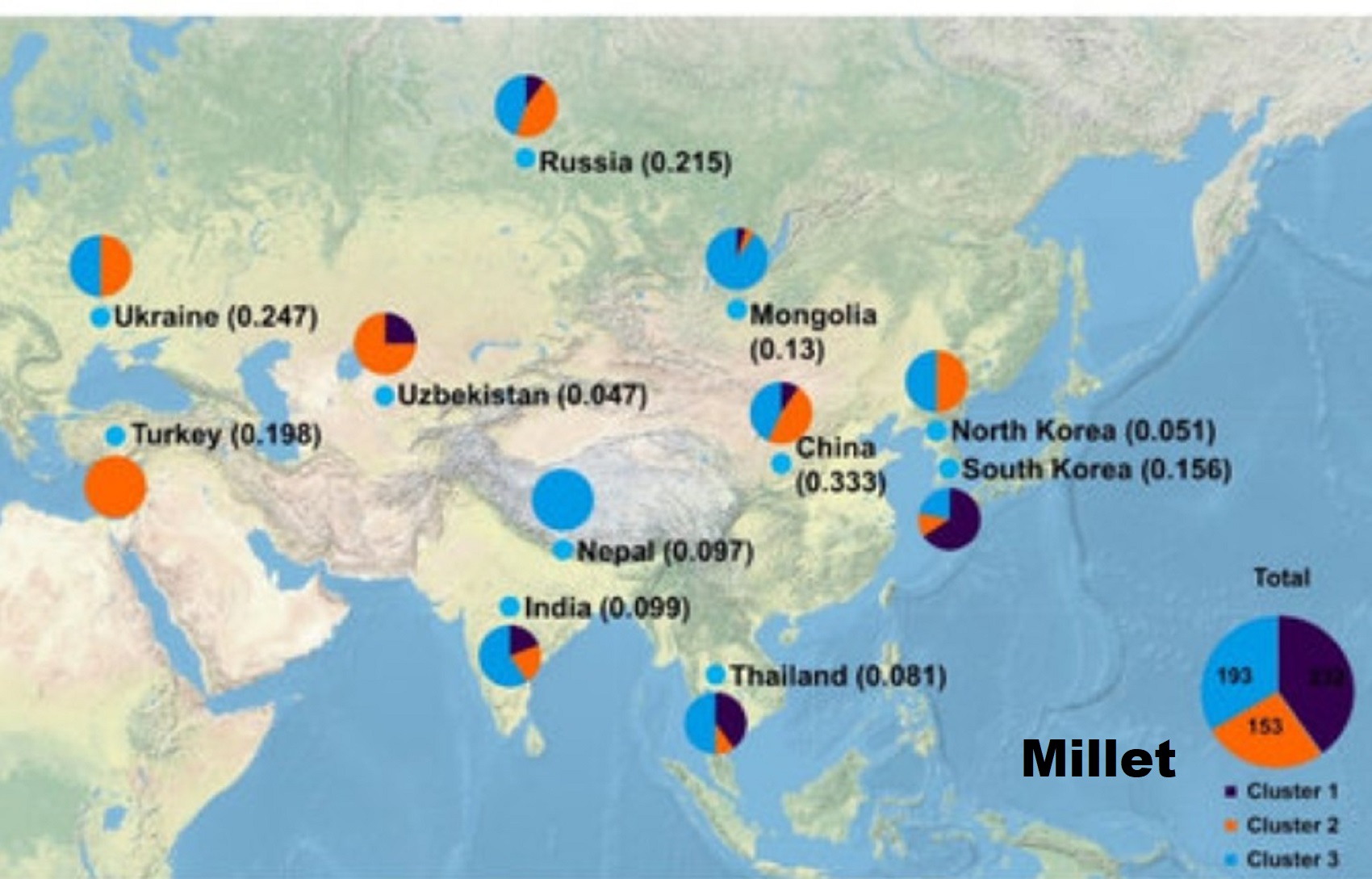
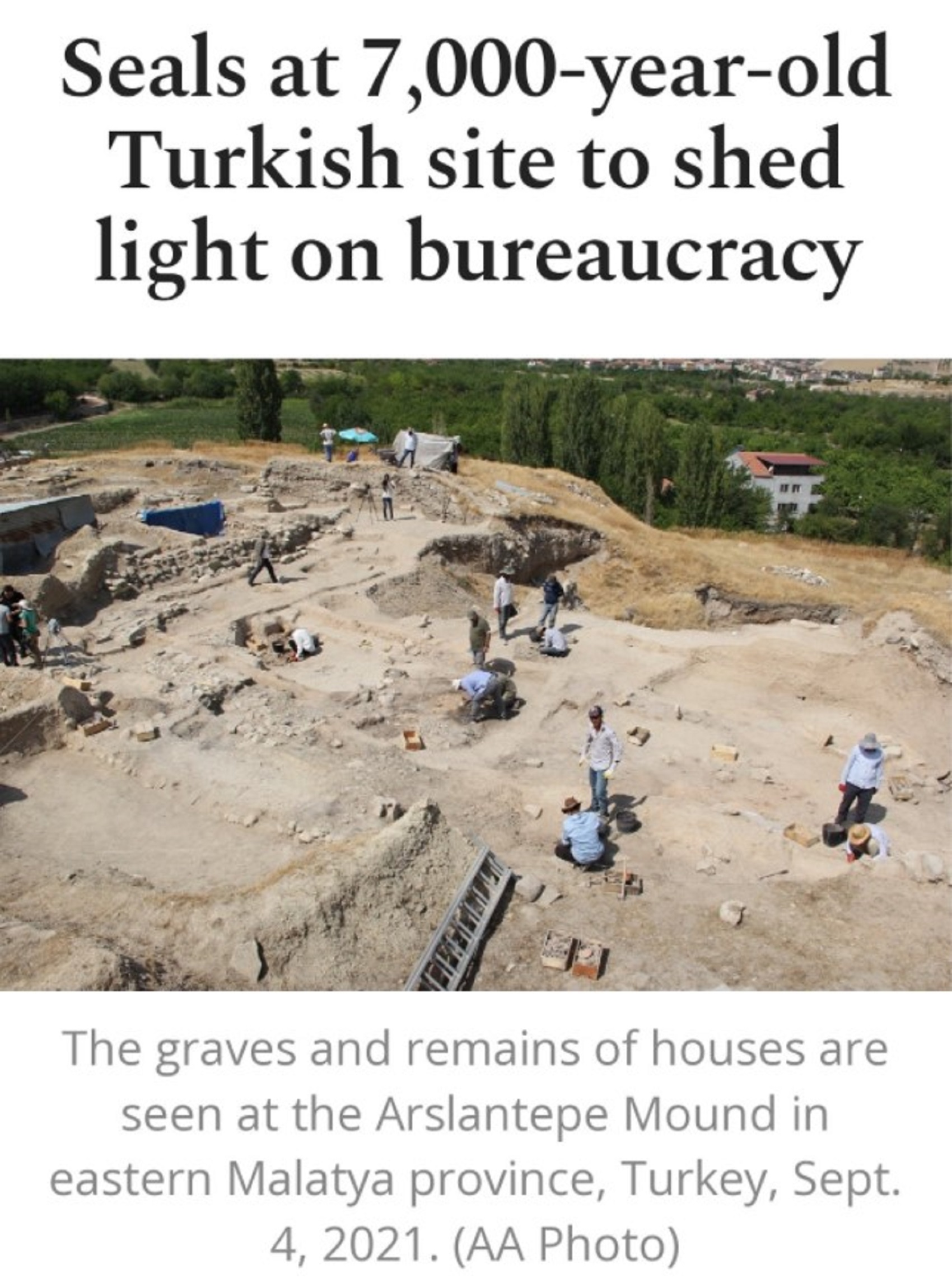
The 5th millennium BCE spanned the years 5000 to 4001 BCE (c. 7,022 to c. 6,022 years ago).
“The rapid world population growth of the previous millennium, caused by the Neolithic Revolution, is believed to have slowed and become fairly stable. It has been estimated that there were around forty million people worldwide by 5000 BCE, growing to 100 million by the Middle Bronze Age c. 1600 BCE.” ref
“The 5th millennium has become a start point for calendars and chronologies, though only one has any basis in reality. The year 4750 BCE is the retrospective start point for the Assyrian calendar, marking the traditional date for the foundation of Assur, some 2,000 years before it actually happened.” ref
“Another traditional date is 19 July 4241 BCE, marking the supposed beginning of the Egyptian calendar, as calculated retrospectively by Eduard Meyer. The more likely start point is 19 July 2781 BCE, one Sothic cycle later. It has generally been believed that the calendar was based on a heliacal (dawn) rising of Sirius but that view is now being questioned.” ref
“According to the Ussher chronology, the creation of Earth happened on 22/23 October 4004 BCE. This chronology was the work of James Ussher, whose basis was the dates in the Old Testament of the Bible. He estimated that the universe was created by God at either 18:00 on the 22nd (Jewish calendar) or 09:00 on the 23rd (Ussher-Lightfoot-Chronology).” ref
“The only exact date in the 5th millennium is Monday, 1 January 4713 BCE, the beginning of the current Julian Period, first described by Joseph Justus Scaliger in the sixteenth century. This Julian Period lasts 7,980 years until the year 3268 CE in the next millennium. It is a useful device for date conversions between different calendars. The date of origin has the integer value of zero in the Julian Day Count: i.e., in the Julian Calendar; the equivalent date in the Gregorian Calendar is 24 November 4714 BCE.” ref
China
Further information: Neolithic China
“Chinese civilization advanced in this millennium with the beginnings of three noted cultures from around 5000 BCE. The Yangshao culture was based in the Huang He (Yellow River) basin and endured for some 2,000 years. It is believed that pigs were first domesticated there. Pottery was fired in kilns dug into the ground and then painted. Millet was cultivated. A type-site settlement for the Yangshao was established c. 4700 BCE at Banpo near modern Xi’an, Shaanxi. Also about 5000 BCE, the Hemudu culture began in eastern China with the cultivation of rice, and the Majiabang culture was established on the Yangtze estuary near modern Shanghai, lasting until c. 3300 BCE.” ref
Europe
“The Cucuteni–Trypillia culture (aka Tripolye culture) began around 4800 BCE. It was centered on modern Moldova and lasted in three defined phases until c. 3000 BCE. From about 4500 BCE until c. 2500 BCE, a single tongue called Proto-Indo-European (PIE) existed as the forerunner of all modern Indo-European languages, but it left no written texts and its structure is unknown.” ref
“Mainstream scholarship places them in the Pontic–Caspian steppe zone in Eastern Europe (present-day Ukraine and southern Russia). Some archaeologists would extend the time depth of PIE to the middle Neolithic (5500 to 4500 BC) or even the early Neolithic (7500 to 5500 BC), and suggest alternative location hypotheses.” ref
However, I believe that possibly the Cucuteni–Trypillia culture at some point after millet showed up from China started speaking Proto-Indo-European and may also have given/spread it to others as well.
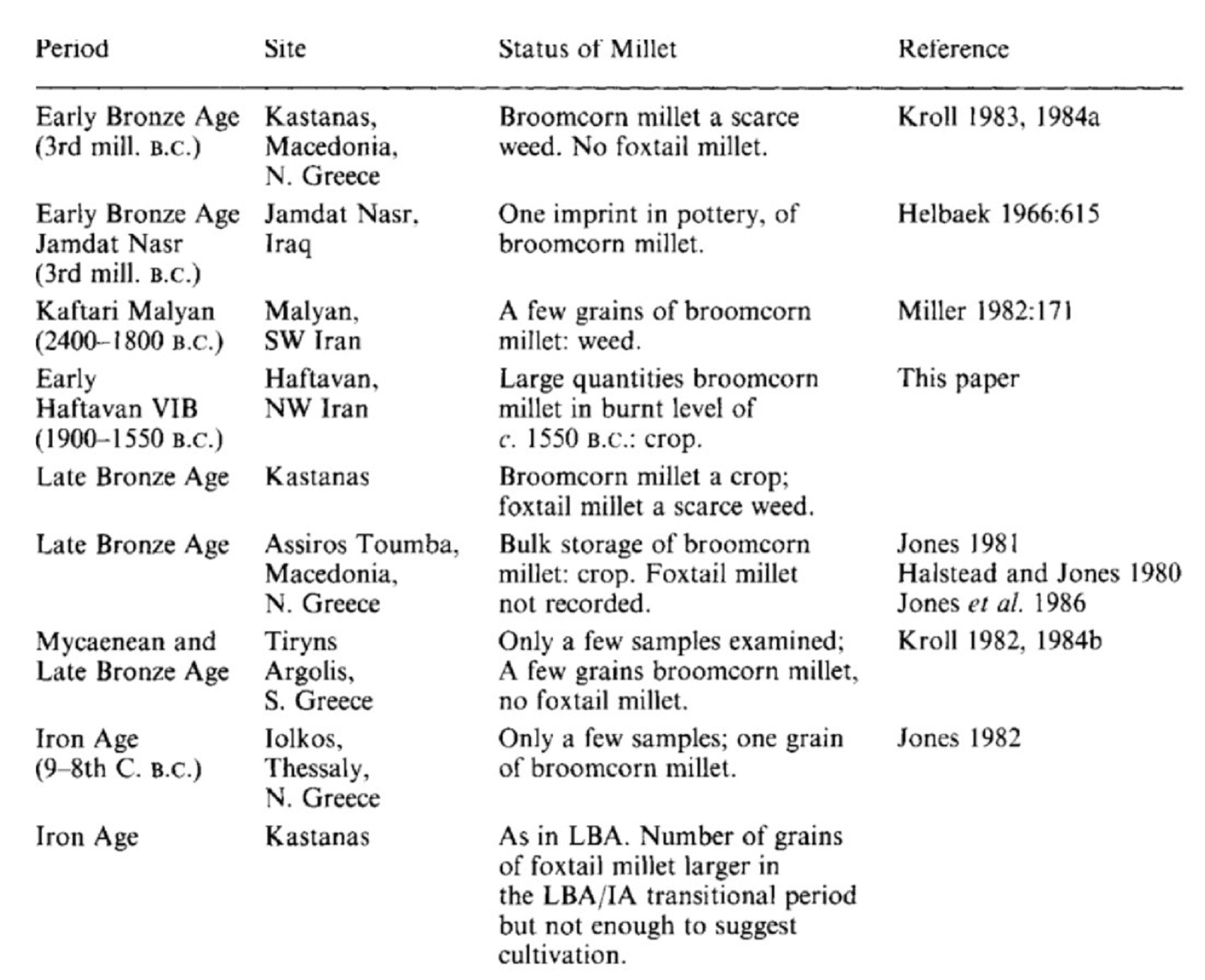
“Although a relatively unimportant crop in the Near East, millet has an especially interesting history that may throw some light on the cultural relationships of the Middle–Late Bronze Ages and the Iron Age. Thus the prompt, separate, publication of a large deposit of foxtail millet ( Setaria italica (L.) P. Beauv.), recently identified from an Iron Age level at Tille Höyük, seems justified. This is the first find of the cereal in such large quantities—definitely as a crop—from the Near East or Greece. The rest of the plant remains from this level will be published in conjunction with the rich samples that are expected to be found in the massive Late Bronze Age burnt level at Tille. The opportunity is also taken in this paper to present other previously unpublished millet samples, from second millennium B.C. levels at Haftavan Tepe, northwestern Iran, and from Hellenistic, Roman, and Medieval levels at Aşvan Kale, eastern Turkey. A full discussion of these criteria will be included in the first author’s forthcoming publication of the Aşvan plant remains. Knörzer (1971) has published a useful key to millet seeds. Three genera of millets (all belonging to the tribe Paniceae of the grass family) have grains of the relatively wide, large embryoed type discussed here.” ref
4,800–4,022 years ago Baodun culture Chengdu Plain
“The Baodun culture (2700 – 1700 BCE) was a Neolithic culture centered on the Chengdu Plain in Sichuan, China. Ten settlements from the culture have been found. The first six sites discovered were: the type site at Baodun in Xinjin County, the site at Mangcheng in Dujiangyan City, the site at Yufu in Wenjiang County, the site at Zizhu in Chongzhou, the site at Shuanghe in Chongzhou and the site at Gucheng in Pi County. Yufucun is the second largest site associated with the Baodun culture.” ref
“All of the settlements straddle the Min River. The settlement walls were covered with pebbles, a feature unique to the Baodun culture. The pottery from the culture share some similarities with Sanxingdui. The inhabitants lived in wattle and daub houses. The earliest evidence for rice and foxtail millet agriculture in southwest China was discovered at the type site at Baodun.” ref
“The site at Yufu is also surrounded by two walls: The inner wall covers and area of around 25 ha (250,000 m2), while the outer wall covers and area of around 40 ha (400,000 m2). The site at Mangcheng is also surrounded by two, pounded earth walls: the inner wall covers an area of around 7.2 ha (72,000 m2), while the outer wall covers an area of around 10.5 ha (105,000 m2). The majority of buildings were made from wattle and daub technology. The site at Gucheng is surrounded by a wall enclosing an area of around 30.4 ha (304,000 m2). The sites at Zizhu and Shuanghe are also surrounded by double walls.” ref
“The Baodun type site was discovered in 1950. The type site is the oldest and largest site associated with the Baodun culture. This culture has the largest walled Neolithic area in China. Baodun is surrounded by two walls: the inner wall covers an area of around 66 ha (660,000 m2), while the outer wall covers and area of around 245 ha (2,450,000 m2). Estimates of the labor required to build both walls suggest that they would have taken 100 people over 5 years to build. It is unclear whether the area between the two walls was residential, agricultural, or used for different purposes.” ref
“Rice and foxtail millet were both grown at Baodun, with rice dominating. Many weeds associated with paddy rice cultivation were also discovered at Baodun. The remains of Job’s tears, Vicia, two types of Vigna, beefsteak plant, and Crataegus were also discovered at Baodun. Rice has also been found at Mangcheng.” ref
4,500–4,022 years ago Shijiahe culture middle Yangtze region in Hubei
“The Shijiahe culture (2500–2000 BCE) was a late Neolithic culture centered on the middle Yangtze River region in Shijiahe Town, Tianmen, Hubei Province, China. It succeeded the Qujialing culture in the same region and inherited its unique artifact of painted spindle whorls. Pottery figurines and distinct jade worked with advanced techniques were also common to the culture.” ref
“The culture is named after its type site, the Shijiahe site cluster, in Tianmen, Hubei, in the Middle Yangtze Valley. The lower layer of the site belonged to the Qujialing culture. The city site is said to be a “nearly perfect square” of 120 hectares (300 acres) in area and was densely populated. It may have housed from between 15,000 and 50,000 inhabitants within the settlement’s walls. At Dengjiawan, within the Shijiahe site cluster, some pieces of copper were discovered, making these the earliest copper objects discovered so far in southern China.” ref
“The primary mode of travel was thought to be watercraft. People even built channels as makeshift rivers to connect urban core areas to adjacent rivers or from towns to main rivers. In addition to walls, moats were also dug around towns and urban centers in the same fashion as the constructed channels. At the town site at Chengtoushan, the moat is about 40–50 m in width. Researchers estimate that a total labor force of 200,000 to 470,000 people was needed to construct the moat and walls at this site. The people of the Shijiahe culture grew both rice and millet.” ref
“Some scholars have speculated that Shijiahe could have been considered an ancient state due to its relatively advanced socio-political structure. Shijiahe is said to have a population size and land area greater than Erlitou, however, it is not very clear if they had the same level of centralized control over these regions that the Erlitou did. Other scholars note that the Shijiahe and other cultures along the Yangtze were more socially complex and developed than their northern contemporaries in the Han Valley.” ref
“Many jade artifacts have been unearthed from Shijiahe sites, mainly dating from the late phase. Most jades have parallels in the Liangzhu culture, and in many ways the Shijiahe site complex is similar to the Mojiaoshan complex of Liangzhu, suggesting strong influences from the lower Yangtze region to the east. In 2015, archaeologists excavated the Tanjialing site, dating to late Shijiahe culture. They discovered more than 250 pieces of jade in five tombs. The jade carving technology exhibited by these artifacts appear to have exceeded that of the Liangzhu and Hongshan cultures, both of which are renowned for their jades.” ref
“The Shijiahe culture ended around 2000 BCE, about the same time as Liangzhu. However, unlike the Liangzhu culture, which completely disappeared, Shijiahe seems to have had a drastic decrease in population. Some scholars believe the decline was a result of warfare with the Longshan culture, which was expanding from the north. Other possible reasons are flooding, collapse of social order, or a combination of these factors. From 4,200 years ago, severe drought eroded the economic foundation of rice-cultivation.” ref
3,922–3,522 years ago Yueshi culture lower Yellow River region in Shandong
“The Yueshi culture (Chinese: 岳石文化) was an archaeological culture in the Shandong region of eastern China, dated from 1900 to 1500 BCE. It spanned the period from the Late Neolithic to the early Bronze Age. In the Shandong area, it followed the Longshan culture period (c. 2600–1900 BCE), and was later replaced by the Erligang culture (identified with the historical Shang dynasty).” ref
“Fennic and Samic populations seem to be clearly influenced by Palaeo-Laplandic peoples, whereas Volga-Finnic and especially Permic populations may have received gene flow from both, but essentially Palaeo-Siberian influence from the north and east.” ref
“The fact that modern Mansis and Khantys offer the highest variation in N1a subclades, and some of the highest “Siberian ancestry” among non-Nganasans, should have raised a red flag long ago. The fact that Hungarians – supposedly stemming from a source population similar to Mansis – do not offer the same amount of N subclades or Siberian ancestry (not even close), and offer instead more R1a, in common with Estonians (among Finno-Samic peoples) and Mordvins (among Volga-Finnic peoples) should have raised a still bigger red flag. The fact that Nganasans – the model for Siberian ancestry – show completely different N1a2b-P43 lineages should have been a huge genetic red line (on top of the anthropological one) to regard them as the Uralian-type population.” ref
“We know now that ethnolinguistic groups have usually expanded with massive (usually male-biased) migrations, and that neighboring locals often ‘resurge’ later without changing the language. That is seen in Europe after the spread of Bell Beakers, with the increase of previous ancestry and lineages in Scandinavia during the formation of the Nordic ethnolinguistic community; in Central-West Europe, with the resurgence of Neolithic ancestry (and lineages) during the Bronze Age over steppe ancestry; and in Central-East Europe (with Unetice or East European Bronze Age groups like Mierzanowice, Trzciniec, or Lusatian) showing an increase in steppe ancestry (and resurge of R1a subclades); none of them represented a radical ethnolinguistic change.” ref
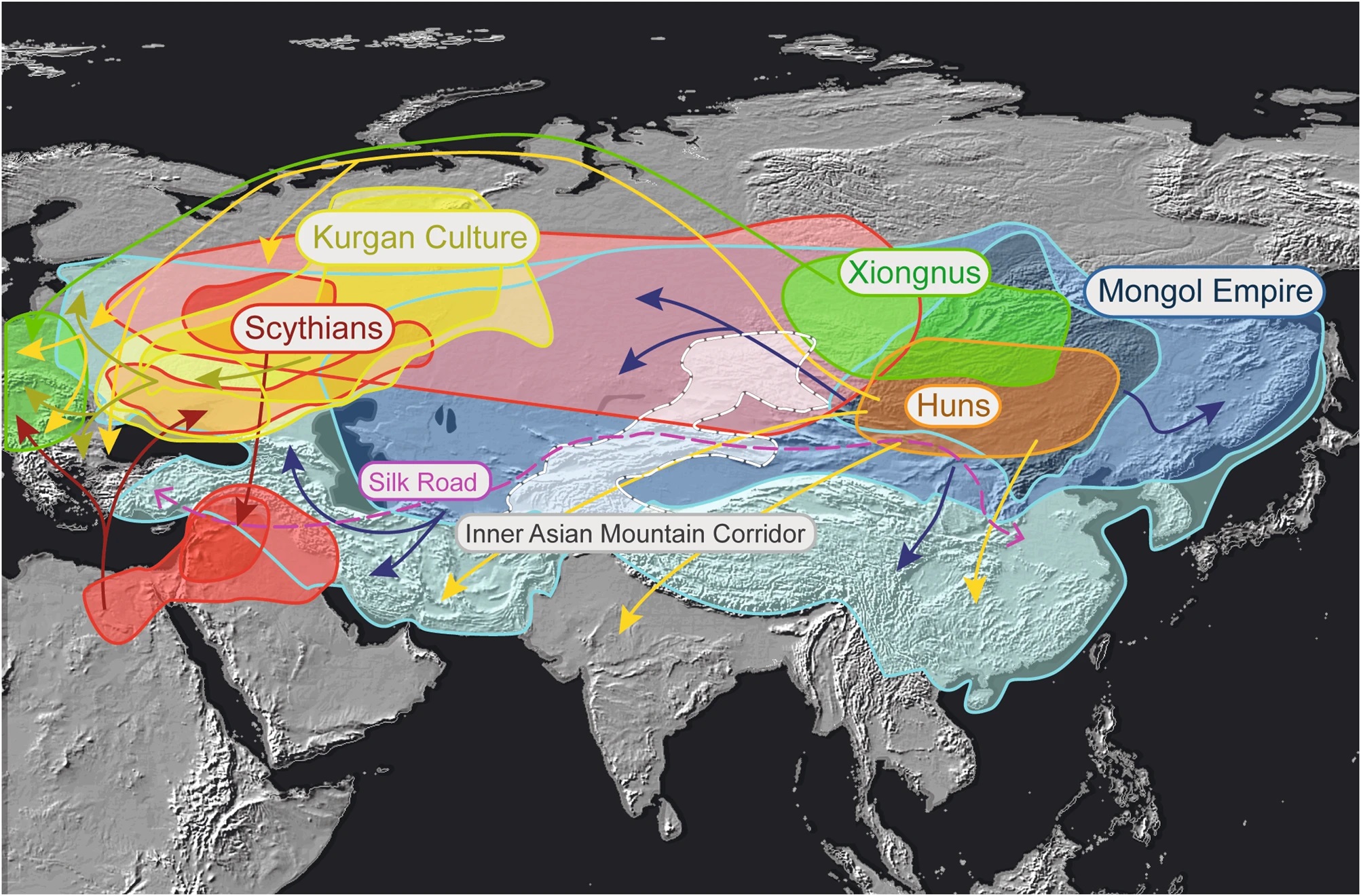
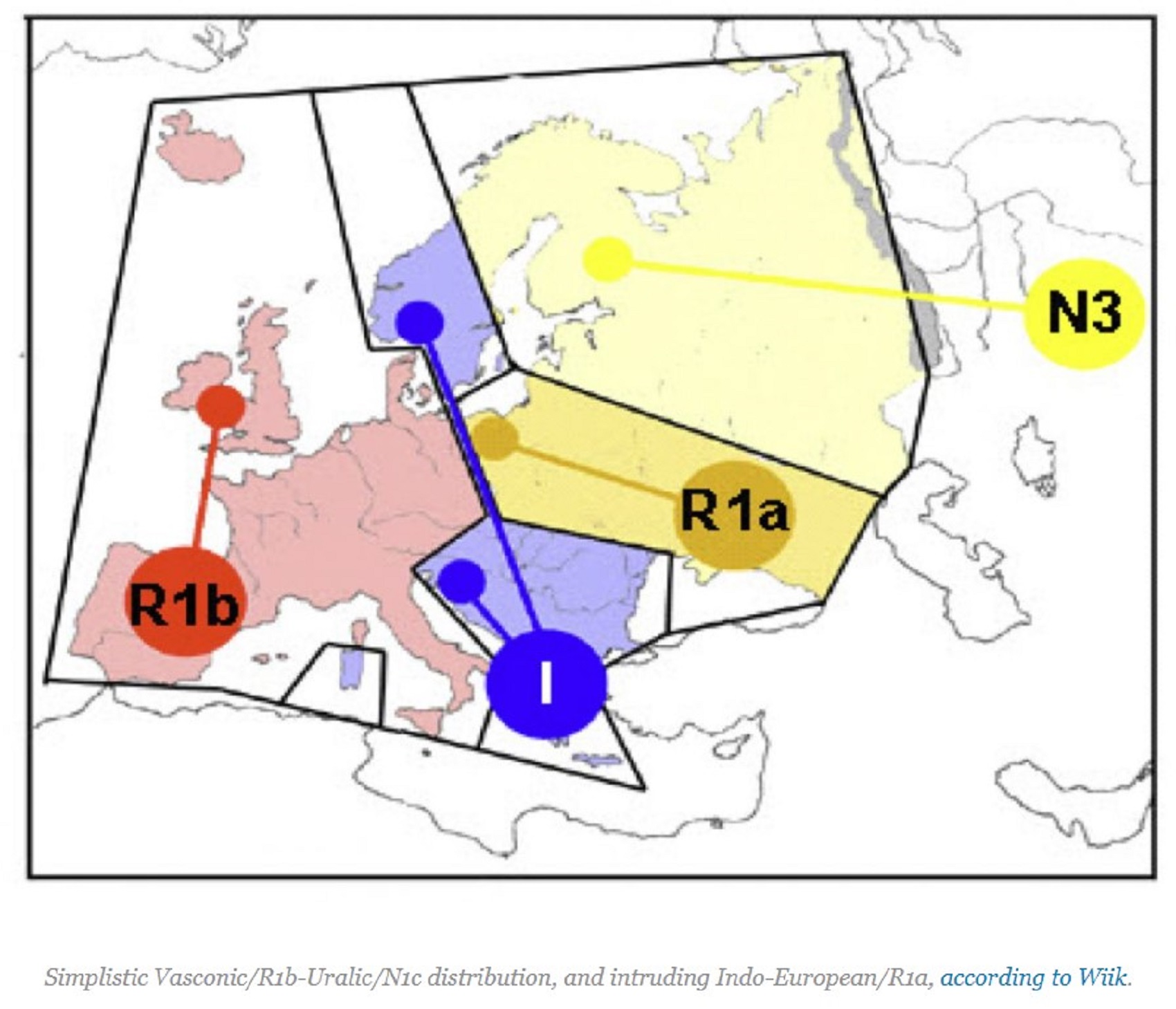
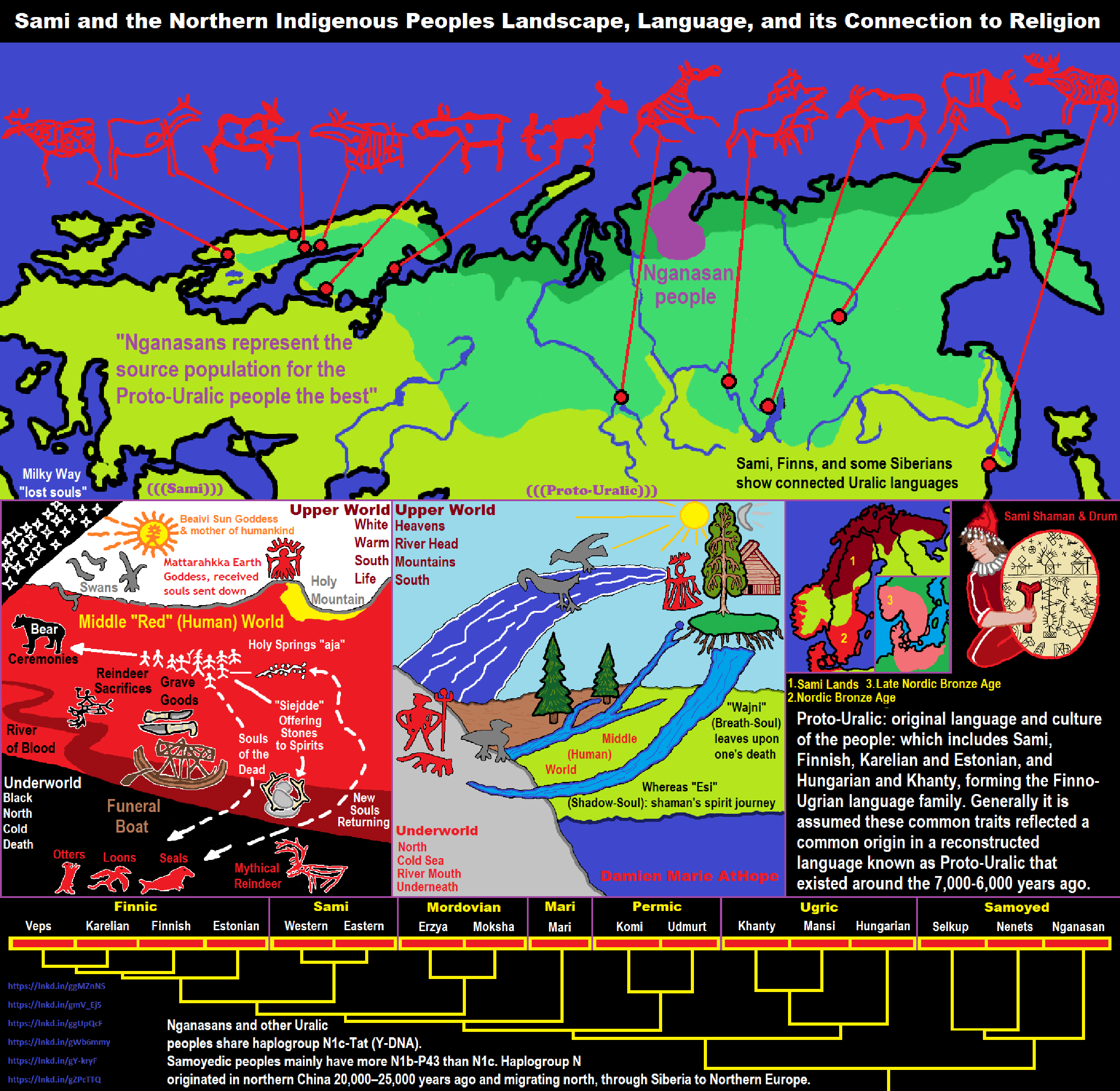
ref, ref, ref, ref, ref, ref, ref, ref, ref, ref, ref, ref, ref, ref, ref, ref, ref, ref, ref
Shamanistic Paganism with Totemism (similar to Nordic mythology and Proto-Indo-European mythology like themes)
Sami and the Northern Indigenous Peoples Landscape, Language, and its Connection to Religion
Sacred Land, Hills, and Mountains: Sami Mythology (Paganistic Shamanism)
Steppe-Anatolian-Kurgan hypothesis (by Damien Marie AtHope)
To me, Proto-Indo-European starts in the steppe after leaving North Asia, then one-part heads to #1 Turkey/Anatolia with “Anatolian” and the other part to #2 Ukraine/Russia and the rest of Proto-Indo-European. Mythology starts 7,000-8,000 years ago in North Aisa.
To me, along with this migration of peoples also carried with them a Paganistic-Shamanism with heavy totemism.
Understanding Proto-Indo-Europeans and Paganism Religions.Fear of Wars Violence and the Creation of Male God around 7,000 years ago? And, to me, this area and time relate to the birth of the Creation of Male God around 7,000years ago and proto-kings, such as seen in the royal nobility skeleton discovered in Grave No.43 in the Varna culture (around 6,400-6,100 years ago) Chalcolithic Necropolis together with the numerous gold artifacts dating to the middle of the 5th Millenium BCE – and is the old processed gold in the world. Which took it to a few different areas but defiantly is seen in a new way as it moved north to the step lands of Eastern Europe and the Proto-Indo-European language as well as south into Jordan and Israel by 6,500 to 6,000 years ago at which time it then moves to Egypt becoming more advanced with the emergence of an emerging nation of Egypt around 5,000 years ago as well as Mesopotamia with Progressed organized religion.
Anatolian hypothesis
“The Anatolian hypothesis of Proto-Indo-European origin is that the speakers of the Proto-Indo-European language lived in Anatolia during the Neolithic era. When the Neolithic Revolution took place in the seventh and sixth millennia BC, the speakers spread over Europe. Those who advocate this hypothesis think that the Indo-European languages originated in Anatolia. They believe that the Proto-Indo-Europeans then migrated north to the location north of the Caucasus Mountains. There is an another hypothesis, called the Kurgan hypothesis. The people who support it say the Indo-European languages came from the Caucasus. One of the best-known advocates of the Anatolian hypothesis is Colin Renfrew.” ref
Kurgan hypothesis
“The Kurgan model of Indo-European origins is about both the people and their Proto-Indo-European language. It uses both archaeology and linguistics to show the history of their culture at different stages of the Indo-European expansion. The Kurgan model is the most widely accepted theory on the origins of Indo-European. “The Kurgan solution is attractive and has been accepted by many archaeologists and linguists, in part or total. It is the solution one encounters in the Encyclopædia Britannica and the Grand Dictionnaire Encyclopédique Larousse“. “The single most popular proposal is the Pontic steppes”. When it was first suggested in 1956, Marija Gimbutas‘s answer to the question of Indo-European origins was a pioneering interdisciplinary synthesis of archaeology and linguistics. From the nineties on, new archaeological evidence from Northern European prehistoric cultures was put forward on the influence and expansion of Kurgan cultures.” ref
There is a shit ton of stuff happing in Aisa but most people are clueless, especially from around 10,000 to 4,000 years ago such as the Neolithic cultures of China. Almost all religions today relate to all this in one way or another, so yes religions today likely share mythology due to all this. From around 7,000 to 5,000 years ago, was especially a time of horror, lots of rape, and murder.
“Proto-Dené–Caucasian theory is the reconstructed hypothetical common ancestor of the Dené–Caucasian languages, a proposed language superfamily to which Basque, North Caucasian, Burushaski, Sino-Tibetan, Yeniseian, Na-Dené and possibly also other language families may belong.” ref
“The earliest known written records of the history of China date from as early as 1250 BCE, from the Shang dynasty (c. 1600–1046 BCE), during the king Wu Ding‘s reign, who was mentioned as the twenty-first Shang king by the same. Ancient historical texts such as the Book of Documents (early chapters, 11th century BCE), the Bamboo Annals (c. 296 BCE), and the Records of the Grand Historian (c. 91 BCE) mention and describe a Xia dynasty (c. 2070–1600 BCE) before the Shang, but no writing is known from the period, and Shang writings do not indicate the existence of the Xia. The Shang ruled in the Yellow River valley, which is commonly held to be the cradle of Chinese civilization. However, Neolithic civilizations originated at various cultural centers along both the Yellow River and Yangtze River. These Yellow River and Yangtze civilizations arose millennia before the Shang. With thousands of years of continuous history, China is among the world’s oldest civilizations and is regarded as one of the cradles of civilization.” ref
“Dené–Yeniseian is a proposed language family consisting of the Yeniseian languages of central Siberia and the Na-Dené languages of northwestern North America. Reception among experts has been somewhat favorable; thus, Dené–Yeniseian has been called “the first demonstration of a genealogical link between Old World and New World language families that meets the standards of traditional comparative–historical linguistics,” besides the Eskimo–Aleut languages spoken in far eastern Siberia and North America.” ref
“In 2012, linguist George Starostin questioned the validity of the macrofamily, citing the fact that “Vajda’s ‘regular correspondences’ are not… properly ‘regular’ in the classic comparative-historical sense of the word”. He also notes that Vajda’s “treatment of the verbal morphology” involves “a tiny handful of intriguing isomorphisms… surrounded by an impenetrable sea of assumptions and highly controversial internal reconstructions that create an illusion of systemic reconstruction where there really is none”. Nonetheless, Starostin concedes that Vajda’s work “is, by all means, a step forward”, and that it “may eventually point the way towards research on grammaticalization paths in Yeniseian and Na-Dené.” ref
“Instead of forming a separate family, Starostin believes that both Yeniseian and Na-Dené are part of a much larger grouping called Dene-Caucasian. So Starostin states that the two families are related in a large sense, but there is no special relationship between them that would suffice to create a separate family between these two language families. In 2015, linguist Paul Kiparsky endorsed Dené–Yeniseian, saying that “the morphological parallelism and phonological similarities among corresponding affixes is most suggestive, but most compelling evidence for actual relationship comes from those sound correspondences which can be accounted for by independently motivated regular sound changes.” ref
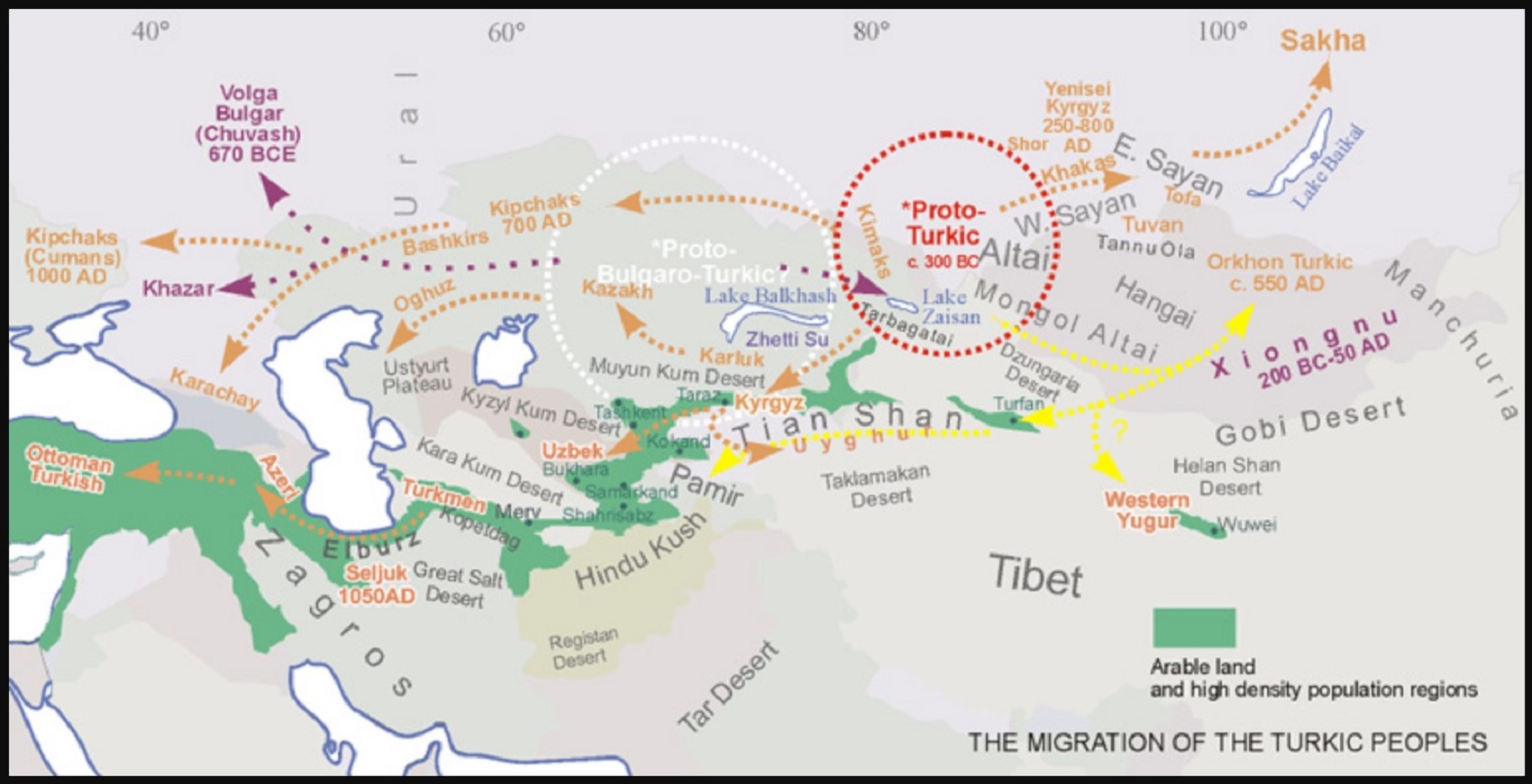
“It is believed that Proto-Turkic began in the Neolithic Period, placing it around 4500 – 4000 BCE or 6,522-6,022 years ago. Proto-Turkic must not be confused with ancient Turkic, which is not a reconstructed language and was in use until 600 CE with the formation of the First Turk Kaghanate.” ref
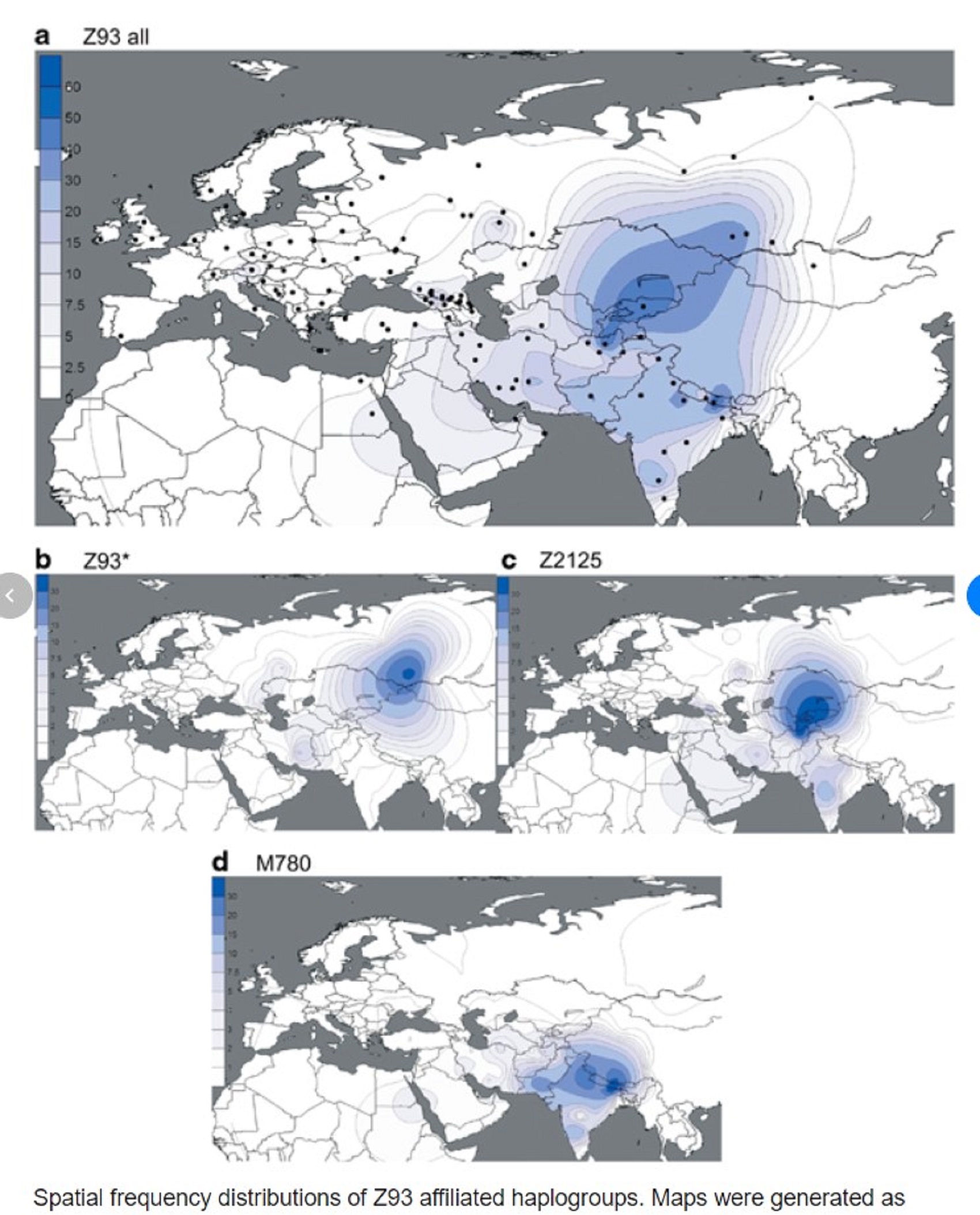
“R1a-M420 is one of the most widely spread Y-chromosome haplogroups; however, its substructure within Europe and Asia has remained poorly characterized. Using a panel of 16 244 male subjects from 126 populations sampled across Eurasia, we identified 2923 R1a-M420 Y-chromosomes and analyzed them to a highly granular phylogeographic resolution. Whole Y-chromosome sequence analysis of eight R1a and five R1b individuals suggests a divergence time of ∼25,000 (95% CI: 21,300-29.000) years ago and a coalescence time within R1a-M417 of ∼5,800 (95% CI: 4,800-6,800) years.” ref
“The spatial frequency distributions of R1a sub-haplogroups conclusively indicate two major groups, one found primarily in Europe and the other confined to Central and South Asia. Beyond the major European versus Asian dichotomy, we describe several younger sub-haplogroups. Based on spatial distributions and diversity patterns within the R1a-M420 clade, particularly rare basal branches detected primarily within Iran and eastern Turkey, we conclude that the initial episodes of haplogroup R1a diversification likely occurred in the vicinity of present-day Iran.” ref
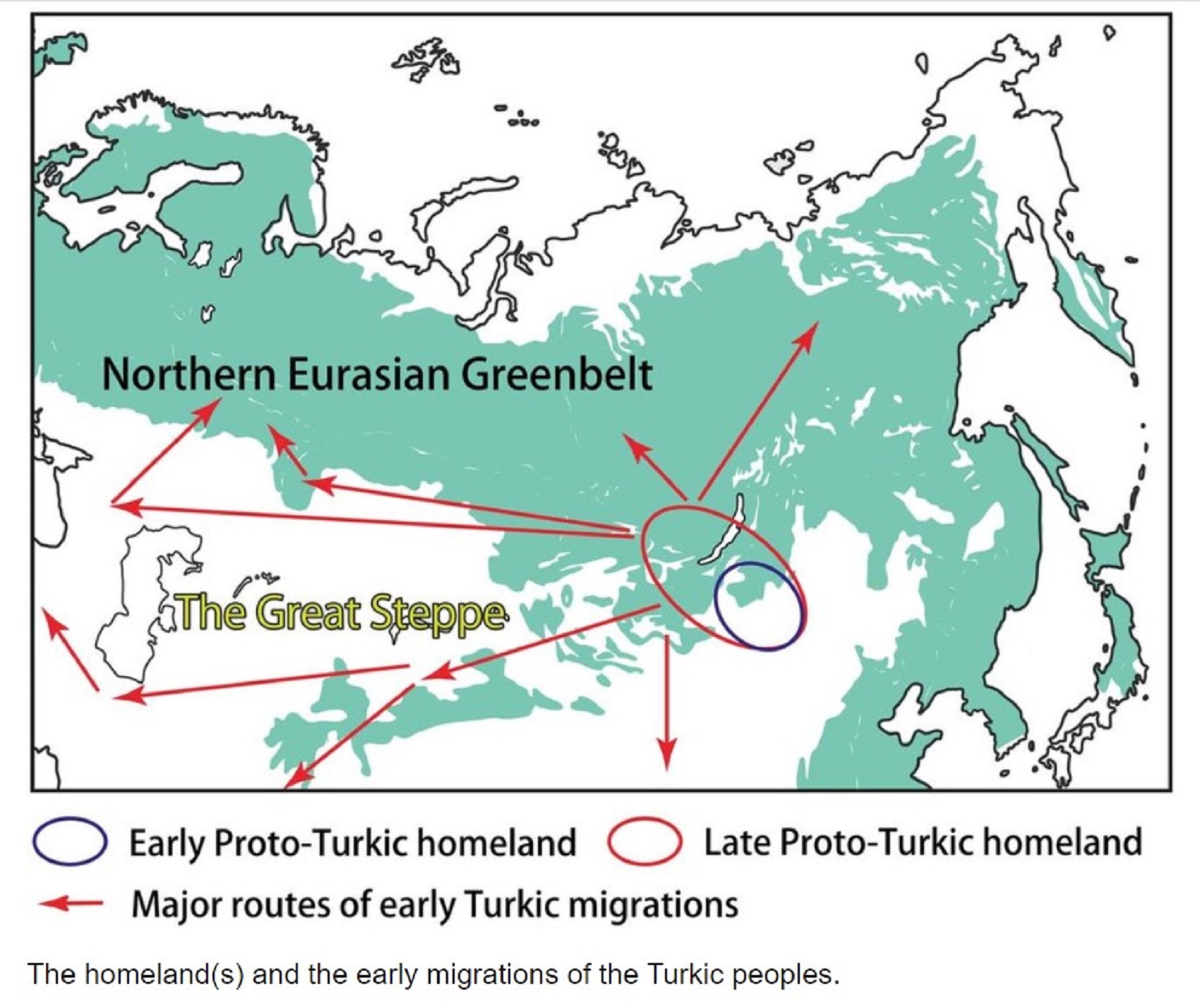
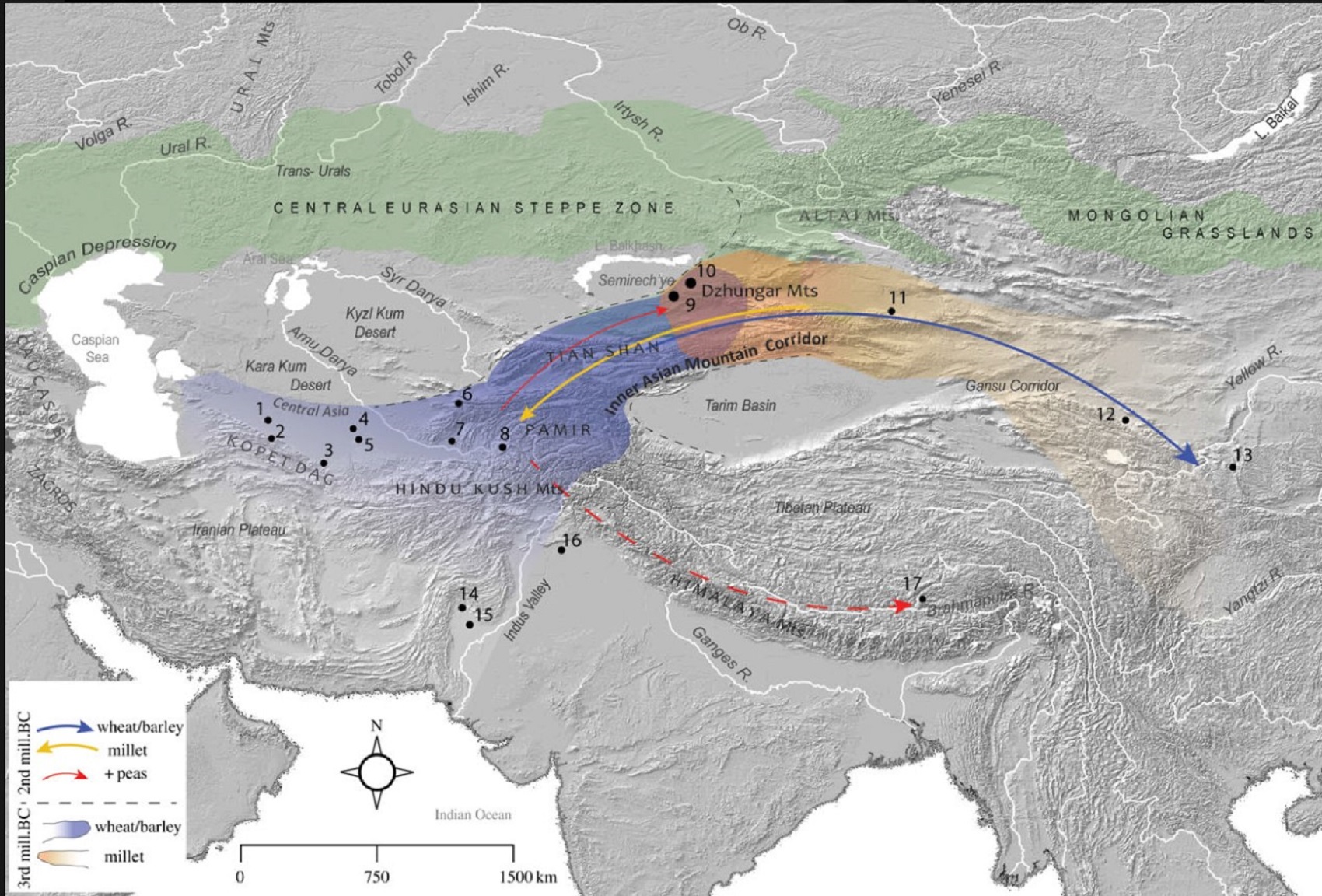
Early agriculture and crop transmission among Bronze Age mobile pastoralists of Central Eurasia
3rd millennium BCE (3000 through 2001 BCE) to the 2nd millennium BCE (2000 through 1001 BCE)
“Regional geography and spread of East Asian and southwest Asian domesticates in the third and the second millennia BCE and key regional sites: (1) Jeitun; (2) Anau, (3) Monjukli Depe, (4) Gonur Depe, (5) 1211/1219 and Ojakly, (6) Sarazm, (7) Jarkutan, (8) Shortughai, (9) Begash, (10) Tasbas, (11) Luanzagangzi, (12) Donghuishan, (13) Xishanping, (14) Mehrgarh, (15) Nausharo, (16) Harappa, (17) Changguogou.” ref
* “paganist” Believe in spirit-filled life and/or afterlife can be attached to or be expressed in things or objects and these objects can be used by special persons or in special rituals can connect to spirit-filled life and/or afterlife who are guided/supported by a goddess/god or goddesses/gods (you are a hidden paganist/Paganism: an approximately 12,000-year-old belief system) And Gobekli Tepe: “first human-made temple” as well as Catal Huyuk “first religious designed city” are both evidence of some kind of early paganism. early paganism is connected to Proto-Indo-European language and religion.
Proto-Indo-European religion can be reconstructed with confidence such as the Gods and Goddesses, the myths, the festivals, and the form of rituals with invocations, prayers, and songs of praise that make up the spoken element of religion. Much of this activity is connected to the natural and agricultural year, or at least those are the easiest elements to reconstruct because nature doesn’t change and because farmers are the most conservative members of society and are best able to keep the old ways.
Goddesses: There are at least 40 deities although the gods may be different than we think of and only evolved later to the ways we know. Such as, how a deity’s gender may not be a fixed characteristic since they are often deified forces of nature which tended to not have genders. Among the Goddesses reconstructed so far are: *Pria, *Pleto, *Devi, *Perkunos, *Aeusos, and *Yama.
Myths: There are at least 28 myths that can be reconstructed to Proto-Indo-European. Many of these myths have since been confirmed by additional research, including some in areas which were not accessible to the early writers, such as Latvian folk songs and Hittite hieroglyphic tablets. One of the most widely recognized myths of the Indo-Europeans is the myth in which *Yama is killed by his brother *Manu and the world is made from his body. Some of the forms of this myth in various Indo-European languages are given in this article about the Creation Myth of the Indo-Europeans.
The Proto-Indo-European (PIE) is estimated to have been spoken as a single language from at around 7,000/6,500 years ago, the Kurgan hypothesis relating to the construction of kurgans (mound graves). The earliest kurgans date to around the 6,000 years ago in the Caucasus and are associated with the Indo-Europeans.
Kurgans were built in the Eneolithic, Bronze, Iron, Antiquity, and Middle Ages, with ancient traditions still active in Southern Siberia and Central Asia. Kurgan cultures are divided archeologically into different sub-cultures, such as Timber Grave, Pit Grave, Scythian, Sarmatian, Hunnish, and Kuman–Kipchak. Kurgan barrows were characteristic of Bronze Age peoples, and have been found from the Altay Mountains to the Caucasus, Ukraine, Romania, and Bulgaria. Kurgans were used in the Ukrainian and Russian steppes, their use spreading with migration into eastern, central, and northern Europe in the around 5,000 yea5rs ago.
Burial mounds are complex structures with internal chambers. Within the burial chamber at the heart of the Kurgan, elite individuals were buried with grave goods and sacrificial offerings, sometimes including horses and chariots. The structures of the earlier Neolithic period from the 4th to the 3rd millenniums BCE, and Bronze Age until the 1st millennium BCE, display continuity of the archaic forming methods. They were inspired by common ritual-mythological ideas.
Whereas, the Anatolian hypothesis suggests that the speakers of Pre-Proto-Indo-European to the Proto-Indo-European (PIE) lived in Anatolia during the Neolithic era, and it associates the distribution of historical Indo-European languages with the expansion during the Neolithic revolution around 9,000 years ago, with a proposed homeland of Proto-Indo-European proper in the Balkans around 7,000 years ago, which he explicitly identified as the “Old European culture“. This hypothesis states that Indo-European languages began to spread peacefully, by demic diffusion, into Europe from Asia Minor or Turkey, the Neolithic advance of farming (wave of advance). Accordingly, most inhabitants of Neolithic Europe would have spoken Indo-European languages, and later migrations would have replaced the Indo-European varieties with other Indo-European varieties. The expansion of agriculture from the Middle East would have diffused three language families: Indo-European toward Europe, Dravidian toward Pakistan and India, and Afro Asiatic toward Arabia and North Africa. Reconstructions of a Bronze Age PIE society, based on vocabulary items like “the wheel”, do not necessarily hold for the Anatolian branch, which appears to have separated at an early stage, prior to the invention of wheeled vehicles. The Proto-Indo-European Religion seemingly stretches at least back around 6000 years ago or likely much further back I believe possibly an approximately 12,000-year-old belief system.
ref, ref, ref, ref, ref, ref, ref, ref, ref, ref, ref, ref, & ref
- “12,000 years ago: Jericho has evidence of settlement dating back to 10,000 BC. Jericho was a popular camping ground for Natufian hunter-gatherer groups, who left a scattering of crescent microlith tools behind them.
- 12,000 years ago: Earliest dates suggested for the domestication of the goat.
- 11,600 years ago: Start of the current Holocene epoch.
- 11,000 -12,00/13,000 years ago (9,000 BC): Earliest date recorded for construction of temenoi ceremonial structures at Göbekli Tepe in southern Turkey, as possibly the oldest surviving proto-religious site on Earth.
- 11,000 years ago: Emergence of Jericho, which is now one of the oldest continuously inhabited cities in the world. Giant short-faced bears and giant ground sloths go extinct. Equidae goes extinct in North America.
- 10,500 years ago: Earliest supposed date for the domestication of cattle.
- 10,000 years ago: The Quaternary extinction event, which has been ongoing since the mid-Pleistocene, concludes. Many of the ice age megafauna go extinct, including the megatherium, woolly rhinoceros, Irish elk, cave bear, cave lion, and the last of the sabre-toothed cats. The mammoth goes extinct in Eurasia and North America, but is preserved in small island populations until ~1650 BC.
- 11,000 – 9,000 years ago: Byblos appears to have been settled during the PPNB period, approximately 8800 to 7000 BC. Neolithic remains of some buildings can be observed at the site.
- 10,000 – 8,000 years ago: The post-glacial sea level rise decelerates, slowing the submersion of landmasses that had taken place over the previous 10,000 years.
- 10,000 – 9,000 years ago: In northern Mesopotamia, now northern Iraq, cultivation of barley and wheat begins. At first they are used for beer, gruel, and soup, eventually for bread. In early agriculture at this time, the planting stick is used, but it is replaced by a primitive plow in subsequent centuries. Around this time, a round stone tower, now preserved to about 8.5 meters high and 8.5 meters in diameter is built in Jericho.
- 9,500–5,900 years ago: Neolithic Subpluvial in North Africa. The Sahara desert region supports a savanna-like environment. Lake Chad is larger than the current Caspian Sea. An African culture develops across the current Sahel region.
- 9,500 years ago: Çatalhöyük urban settlement founded in Anatolia. Earliest supposed date for the domestication of the cat.
- 9,200 years ago: First human settlement in Amman, Jordan; ‘Ain Ghazal Neolithic settlement was built spanning over an area of 15 hectares.
- 9,000 years ago: Jiahu culture began in China.
- 9,000 years ago: large first fish fermentation in southern Sweden.
- 8,200–8,000 years ago: 8.2 kiloyear event: a sudden decrease of global temperatures, likely caused by the final collapse of the Laurentide Ice Sheet, which leads to drier conditions in East Africa and Mesopotamia.
- 8,000-5,000 years ago: development of proto-writing in China, Southeast Europe (Vinca symbols) and West Asia (proto-literate cuneiform).
- 8,000 years ago: Evidence of habitation at the current site of Aleppo dates to about c. 8,000 years ago, although excavations at Tell Qaramel, 25 kilometers north of the city show the area was inhabited about 13,000 years ago, Carbon-14 dating at Tell Ramad, on the outskirts of Damascus, suggests that the site may have been occupied since the second half of the seventh millennium BC, possibly around 6300 BC. However, evidence of settlement in the wider Barada basin dating back to 9000 BC exists.
- 7,500 years ago: Copper smelting in evidence in Pločnik and other locations.
- 7,200–6,000 years ago: 5200–4000 BC:Għar Dalam phase on Malta. First farming settlements on the island.
- 6,100–5,800 years ago: Żebbuġ phase. Malta.
- 6,070–6,000 years ago: Trypillian build in Nebelivka (Ukraine) settlement which reached 15,000—18,000 inhabitants.
- 6,500 years ago: The oldest known gold hoard deposited at Varna Necropolis, Bulgaria.
- 6,000 years ago: Civilizations develop in the Mesopotamia/Fertile Crescent region (around the location of modern-day Iraq). Earliest supposed dates for the domestication of the horse and for the domestication of the chicken, invention of the potter’s wheel.
- 5,900 years ago: 5.9 kiloyear event: a rapid and intense aridification event, which likely started the current Sahara Desert dry phase and a population increase in the Nile Valley due to migrations from nearby regions. It is also believed this event contributed to the end of the Ubaid period in Mesopotamia.
- 5,800 years ago: The Post Track and Sweet Track causeways are constructed in the Somerset Levels.
- 5,800 years ago: Trypillian build in Talianki (Ukraine) settlement which reached 15,600—21,000 inhabitants.
- 5,800–5,600 years ago: Mġarr phase A short transitional period in Malta’s prehistory. It is characterized by pottery consisting of mainly curved lines.
- 5,700 years ago: starts mass graves at Tell Brak in Syria.
- 5,700 years ago: Trypillian build in Maidanets (Ukraine) settlement which reached 12,000—46,000 inhabitants and built 3-story building.
- 5,700 years ago: Minoan culture begins on Crete.
- 5,600–5,200 years ago: Ġgantija phase on Malta. Characterized by a change in the way the prehistoric inhabitants of Malta lived.
- 5,500 years ago: Uruk period in Sumer. The first evidence of mummification in Egypt.
- 5,500 years ago: the oldest known depiction of a wheeled vehicle (Bronocice pot, Funnelbeaker culture)
- 5,300 years ago: Bronze Age begins in the Near East, Newgrange is built in Ireland. Hakra Phase of the Indus Valley Civilisation begins in the Indian subcontinent.
- 5,300–5,000 years ago: Saflieni phase in Maltese prehistory.” ref
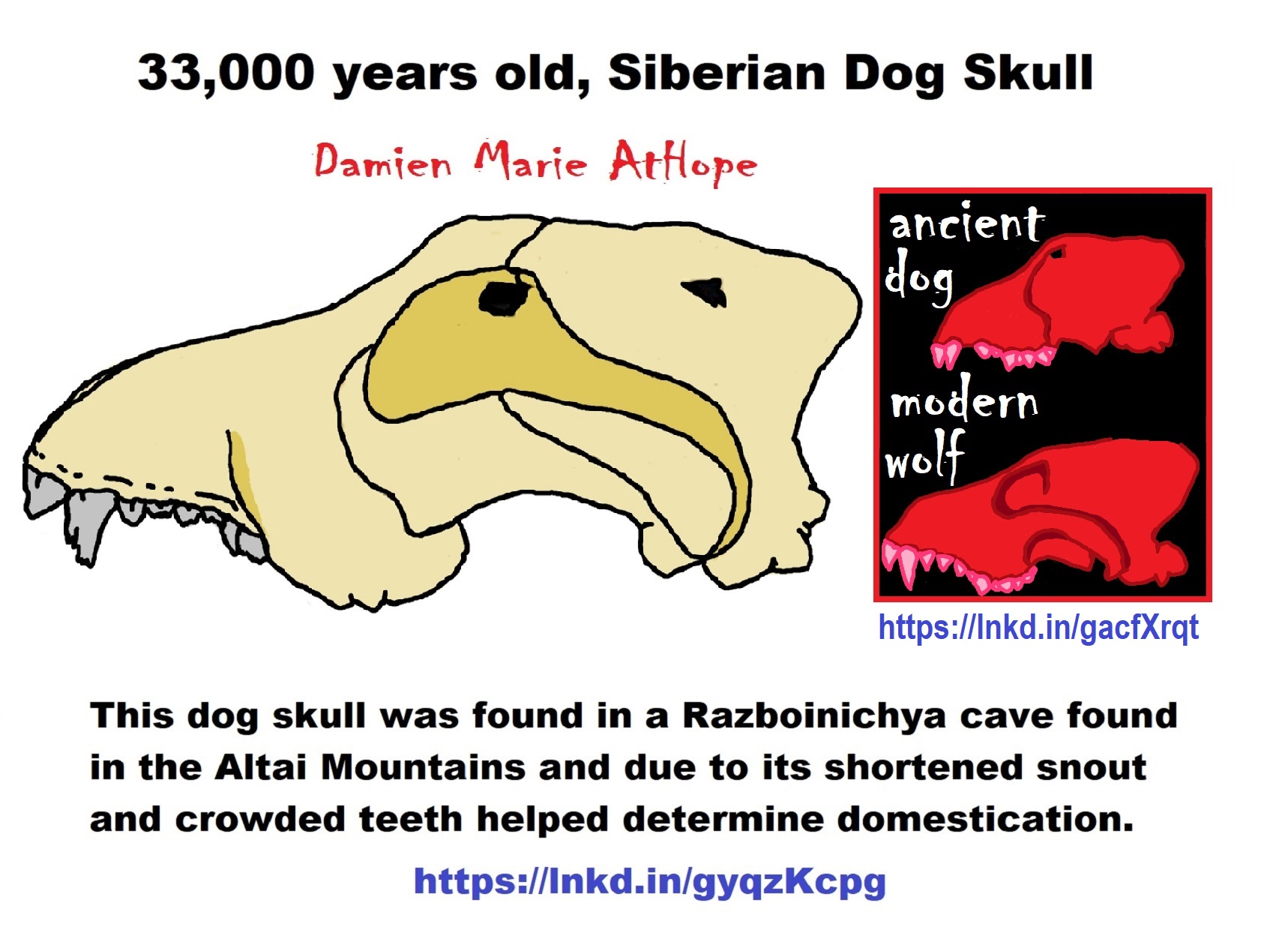
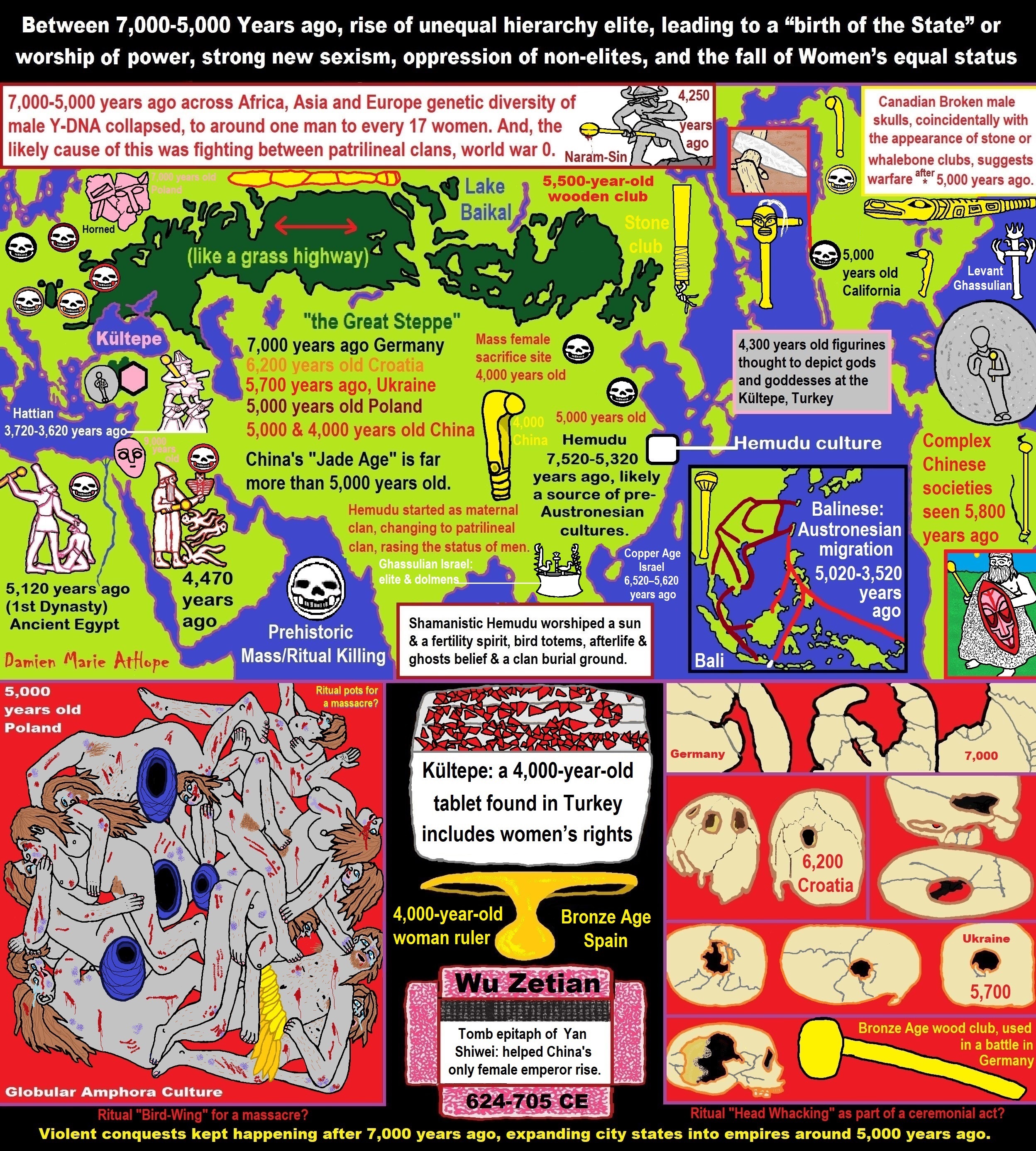
ref, ref, ref, ref, ref, ref, ref, ref, ref, ref, ref, ref, ref, ref, ref, ref, ref, ref, ref, ref, ref, ref, ref, ref, ref, ref, ref, ref, ref, ref, ref, ref, ref, ref, ref, ref, ref, ref, ref, ref, ref, ref, ref, ref, ref, ref, ref, ref, ref, ref, ref, ref, ref, ref, ref, ref, ref, ref, ref, ref, ref, ref, ref, ref, ref, ref, ref, ref, ref, ref, ref, ref, ref, ref, ref, ref, ref, ref, ref, ref, ref, ref, ref, ref, ref, ref, ref, ref, ref, ref
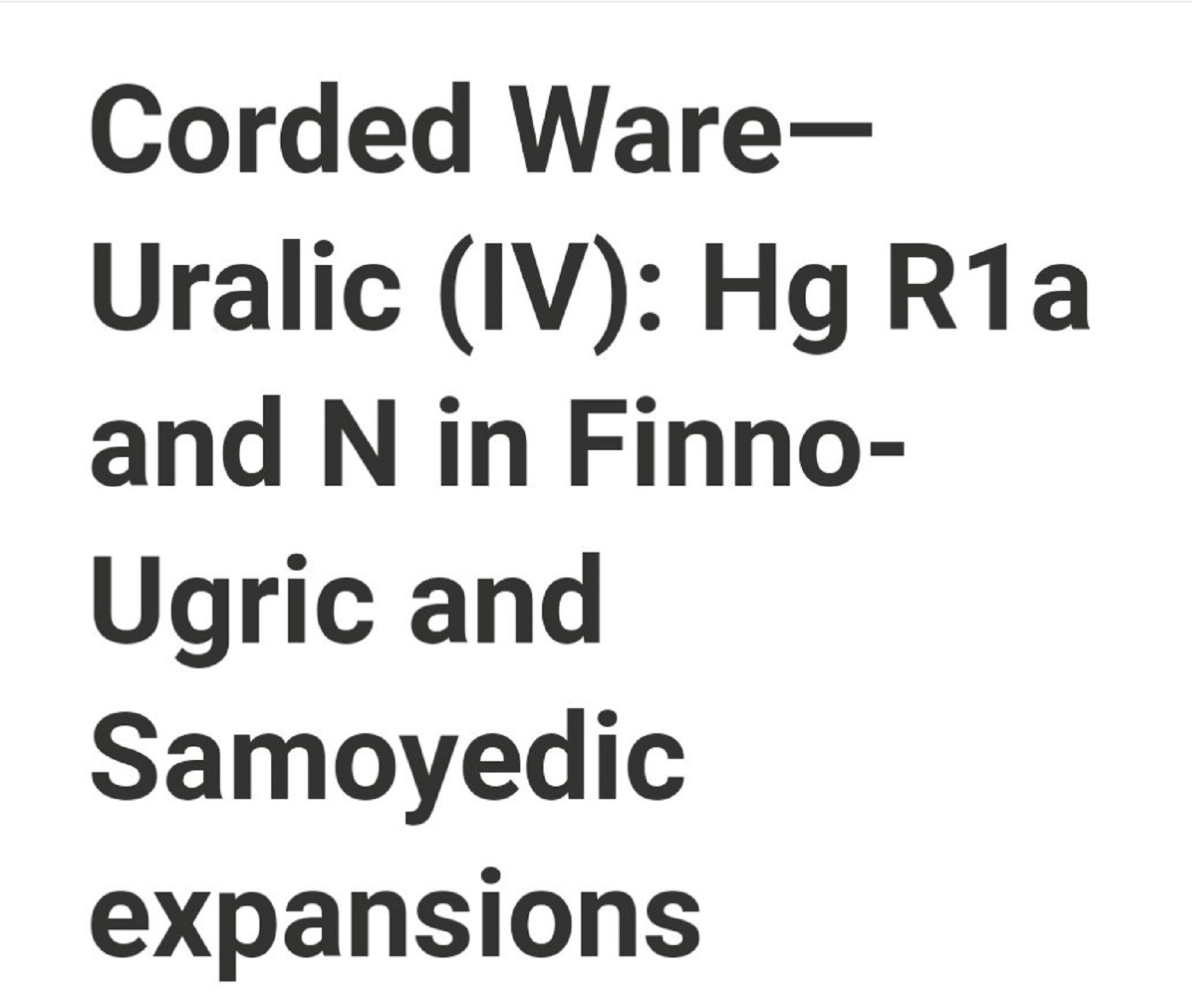
“This is the fourth of four posts on the Corded Ware—Uralic identification:
- Corded Ware—Uralic (I): Differences and similarities with Yamna
- Corded Ware—Uralic (II): Finno-Permic and the expansion of N-L392/Siberian ancestry
- Corded Ware—Uralic (III): “Siberian ancestry” and Ugric-Samoyedic expansions
- Corded Ware—Uralic (IV): Haplogroups R1a and N in Finno-Ugric and Samoyedic
“Let me begin this final post on the Corded Ware—Uralic connection with an assertion that should be obvious to everyone involved in ethnolinguistic identification of prehistoric populations but, for one reason or another, is usually forgotten. In the words of David Reich, in Who We Are and How We Got Here (2018): Human history is full of dead ends, and we should not expect the people who lived in any one place in the past to be the direct ancestors of those who live there today.” ref
Haplogroup N
“Another recurrent argument – apart from “Siberian ancestry” – for the location of the Uralic homeland is “haplogroup N”. This is as serious as saying “haplogroup R1” to refer to Indo-European migrations, but let’s explore this possibility anyway.” ref
Ancient haplogroups
“We have now a better idea of how many ancient migrations (previously hypothesized to be associated with westward Uralic migrations) look like in genetic terms. From Damgaard et al. (Science 2018):
These serial changes in the Baikal populations are reflected in Y-chromosome lineages (Fig. SA; figs. S24 to S27, and tables S13 and SI4). MAI carries the R haplogroup, whereas the majority of Baikal_EN males belong to N lineages, which were widely distributed across Northern Eurasia (29), and the Baikal_LNBA males all carry Q haplogroups, as do most of the Okunevo_EMBA as well as some present-day Central Asians and Siberians.” ref
“The only N1c1 sample comes from Ust’Ida Late Neolithic, 180km to the north of Lake Baikal, which – together with the Bronze Age sample from the Kola peninsula, and the medieval sample from Ust’Ida – gives a good idea of the overall expansion of N subclades and Siberian ancestry among the Circum-Arctic peoples of Eurasia, speakers of Palaeo-Siberian languages.” ref
“What we should expect from Uralic peoples expanding with haplogroup N – seeing how Yamna expands with R1b-L23, and Corded Ware expands with R1a-Z645 – is to find a common subclade spreading with Uralic populations. Let’s see if it works like that for any N-X subclade, in data from Ilumäe et al. (2016). Within the Eurasian circum-Arctic spread zone, N3 and N2a reveal a well-structured spread pattern where individual sub-clades show very different distributions:
N1a1-M46 (or N-TAT), formed ca. 13900 BCE, TMRCA 9800 BCE
N1a1a2-B187, formed ca. 9800 BCE, TMRCA 1050 CE: The sub-clade N3b-B187 is specific to southern Siberia and Mongolia, whereas N3a-L708 is spread widely in other regions of northern Eurasia.” ref
N1a1a1a-L708, formed ca. 6800 BCE, TMRCA 5400 BCE.
N1a1a1a2-B211/Y9022, formed ca. 5400 BCE, TMRCA 1900 BCE: The deepest clade within N3a is N3a1-B211, mostly present in the Volga-Uralic region and western Siberian Khanty and Mansi populations.
N1a1a1a1a-L392/L1026), formed ca. 4400 BCE, TMRCA 2800 BCW: The neighbor clade, N3a3’6-CTS6967, spreads from eastern Siberia to the eastern part of Fennoscandia and the Baltic States” ref
N1a1a1a1a1a-CTS2929/VL29, formed ca. 2100 BCE, TMRCA 1600 BCE: In Europe, the clade N3a3-VL29 encompasses over a third of the present-day male Estonians, Latvians, and Lithuanians but is also present among Saami, Karelians, and Finns (Table S2 and Figure 3). Among the Slavic-speaking Belarusians, Ukrainians, and Russians, about three-fourths of their hg N3 Y chromosomes belong to hg N3a3.” ref
“In the post on Finno-Permic expansions, I depicted what seems the most likely way of infiltration of N1c-L392 lineages with Akozino warrior-traders into the western Finno-Ugric populations, with an origin around the Barents sea.” ref
“This includes the potential spread of (a minority of) N1c-B211 subclades due to contacts with Anonino on both sides of the Urals, through a northern route of forest and forest-steppe regions (equivalent to the distribution of Cherkaskul compared to Andronovo), given the spread of certain subclades in Ugric populations.” ref
N”OTE. An alternative possibility is the association of certain B211 subclades with a southern route of expansion with Pre-Scythian and Scythian populations, under whose influence the Ananino culture emerged -which would imply a very quick infiltration of certain groups of haplogroup N everywhere among Finno-Ugrics on both sides of the Urals – , and also the expansion of some subclades with Turkic-speaking peoples, who apparently expanded with alliances of different peoples. Both (Scythian and Turkic) populations expanded from East Asia, where haplogroup N (including N1c) was present since the Neolithic. I find this a worse model of expansion for upper clades, but – given the YFull estimates and the presence of this haplogroup among Turkic peoples – it is a possibility for many subclades.” ref
N1a1a1a1a2-Z1936, formed ca. 2800 BCE, TMRCA 2400 BCE: The only notable exception from the pattern are Russians from northern regions of European Russia, where, in turn, about two-thirds of the hg N3 Y chromosomes belong to the hg N3a4-Z1936—the second west Eurasian clade. Thus, according to the frequency distribution of this clade, these Northern Russians fit better among other non-Slavic populations from northeastern Europe. N3a4 tends to increase in frequency toward the northeastern European regions but is also somewhat unexpectedly a dominant hg N3 lineage among most Turcic-speaking Volga Tatars and South-Ural Bashkirs.” ref
“The expansion of N1a-Z1936 in Fennoscandia is most likely associated with the expansion of Saami into asbestos ware-related territory (like the Lovozero culture) during the Late Iron Age – and mixture with its population – , and with the later Fennic expansion to the east and north, replacing their language, as well as with Arctic and forest populations assimilated during Permic, Ugric, and Samoyedic expansions to the north.” ref
N1a1a1a1a4-M2019 (previously N3a2), formed ca. 4400 BCE, TMRCA 1700 BCE: Sub-hg N3a2-M2118 is one of the two main bifurcating branches in the nested cladistic structure of N3a2’6-M2110. It is predominantly found in populations inhabiting present-day Yakutia (Republic of Sakha) in central Siberia and at lower frequencies in the Khanty and Mansi populations, which exhibit a distinct Y-STR pattern (Table S7) potentially intrinsic to an additional clade inside the sub-hg N3a2.” ref
The second widespread sub-clade of hg N is N2a. (…):
N1a2b-P43 (B523/FGC10846/Y3184), formed ca. 6800 BC, TMRCA ca. 2700 BC: The absolute majority of N2a individuals belong to the second sub-clade, N2a1-B523, which diversified about 4.7 kya (95% CI = 4.0–5.5 kya). Its distribution covers the western and southern parts of Siberia, the Taimyr Peninsula, and the Volga-Uralic region with frequencies ranging from 10% to 30% and does not extend to eastern Siberia (…)” ref
The “European” branch suggested earlier from Y-STR patterns turned out to consist of two clades
N1a2b2a-Y3185/FGC10847, formed ca. 2200 BCE, TMRCA 800 BCE: N2a1-L1419, spread mainly in the northern part of that region.” ref
N1a2b2b1-B528/Y24382, formed ca. 900 BCE, TMRCA ca. 900 BCE: N2a1-B528, spread in the southern Volga-Uralic region.” ref
Haplogroup R1a
“We also have a good idea of the distribution of haplogroup R1a-Z645 in ancient samples. Its subclades were associated with the Corded Ware expansion, and some of them fit quite well the early expansion of Finno-Permic, Ugric, and Samoyedic peoples to the east.” ref
“This is how the modern distribution of R1a among Uralians looks like, from the latest report in Tambets et al. (2018):
- Among Fennic populations, Estonians and Karelians (ca. 1.1 million) have not suffered the greatest bottleneck of Finns (ca. 6-7 million), and show thus a greater proportion of R1a-Z280 than N1c subclades, which points to the original situation of Fennic peoples before their expansion. To trust Finnish Y-DNA to derive conclusions about the Uralic populations is as useful as relying on the Basque Y-DNA for the language spread by R1b-P312…
- Among Volga-Finnic populations, Mordovians (the closest to the original Uralic cluster, see above) show a majority of R1a lineages (27%).
- Hungarians (ca. 13-15 million) represent the majority of Ugric (and Finno-Ugric) peoples. They are mainly R1a-Z280, also R1a-Z2123, have little N1c, and lack Siberian ancestry, and represent thus the most likely original situation of Ugric peoples in 4th century AD (read more on Avars and Hungarians).
- Among Samoyedic peoples, the Selkup, the southernmost ones and latest to expand – that is, those not heavily admixed with Siberian populations – , also have a majority of R1a-Z2123 lineages (see also here for the original Samoyedic haplogroups to the south).” ref
“To understand the relevance of Hungarians for Ugric peoples, as well as Estonians, Karelians, and Mordovians (and northern Russians, Finno-Ugric peoples recently Russified) for Finno-Permic peoples, as opposed to the Circum-Arctic and East Siberian populations, one has to put demographics in perspective.” ref
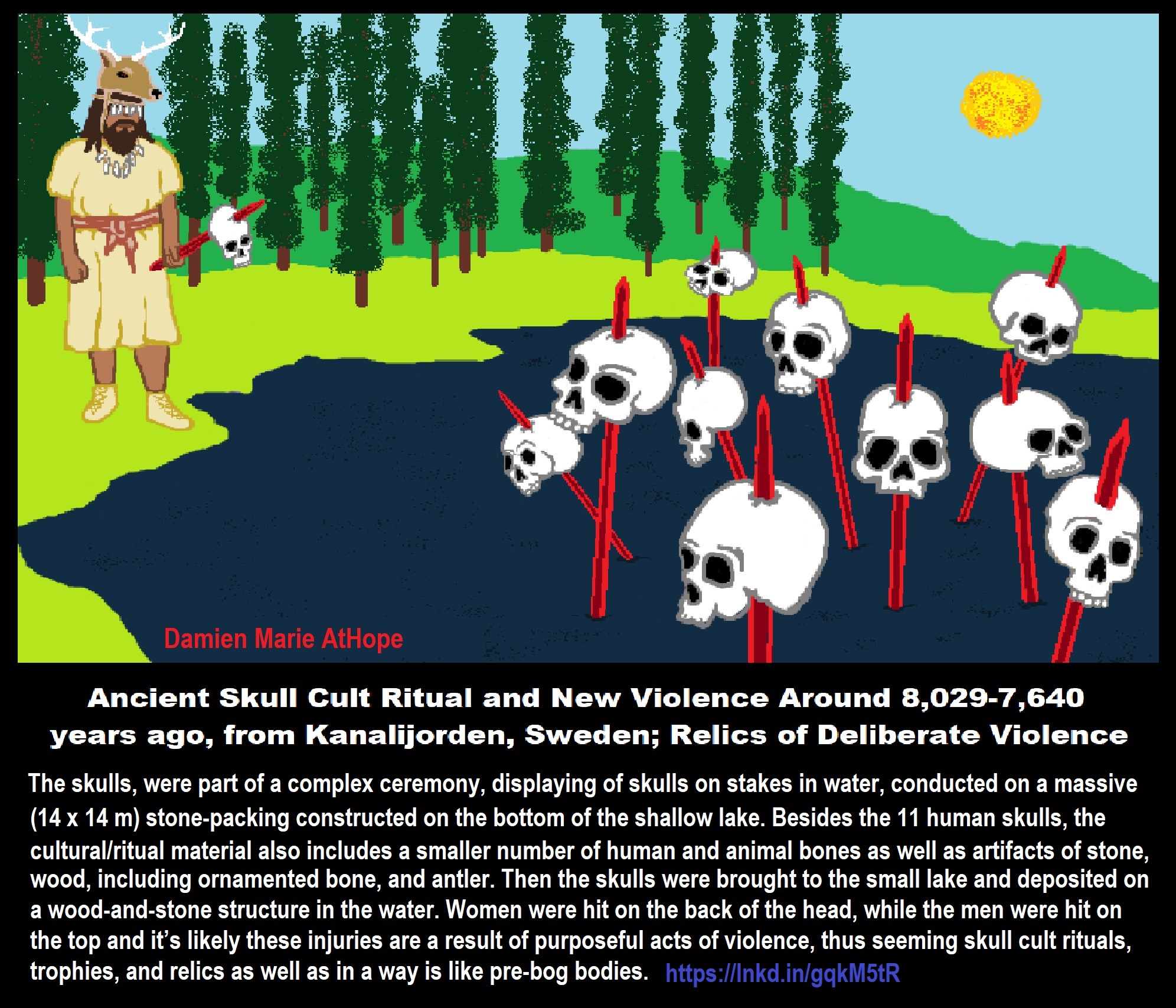
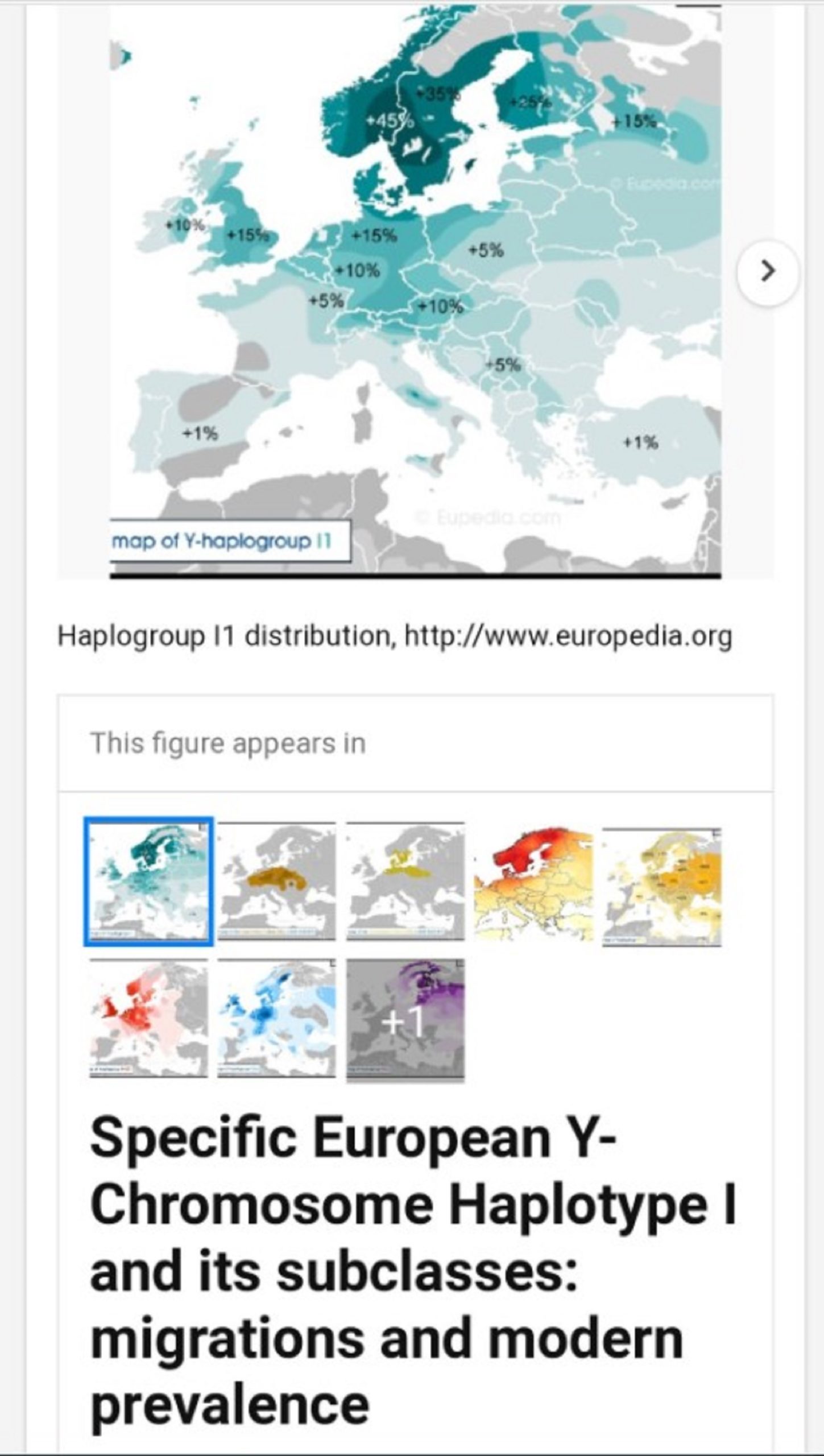
Specific European Y-Chromosome Haplotype I and its subclasses: migrations and modern prevalence
“Haplogroup I1 is the most common I subclade in northern Europe. It is found mostly in Scandinavia and Finland, where it typically represents over 35% of the male Y-chromosomes. Associated with the Norse ethnicity, I1 is found in all places invaded by ancient Germanic tribes and the Vikings. Other parts of Europe speaking Germanic languages come next in frequency. Germany, Austria, the Low Countries, England, and the Scottish Lowlands all have between 10% and 20% of I1 lineages.” ref
“The I1 branch is estimated to have split away from the rest of haplogroup I some 20,000 years ago. I1 is defined by at least 25 unique mutations, which indicates that this lineage experienced a serious population bottleneck. Men belonging to this haplogroup all descend from a single ancestor who lived between 10,000 and 8,000 years ago.” ref
“It has been speculated that I1 evolved in isolation in Scandinavia during the late Upper Paleolithic and Mesolithic periods, when hunter-gatherers from southern Europe recolonized the northern half of the continent from their LGM refugia. The oldest attested evidence of postglacial resettlement of Scandinavia dates from 11,000 BCE with the appearance of the Ahrensburg culture.” ref
“However, evidence emerged (Scécsényi-Nagy et al. 2014) from the testing of Early Neolithic Y-DNA from western Hungary that haplogroup I1 was in fact present in central Europe at the time of evidence from the Neolithic samples of the Early Neolithic Starčevo and Cardium Pottery cultures that haplogroup I2a lived alongside G2a farmers both in south-east and south-west Europe.” ref
“The most likely hypothesis at present is that I1 and I2 lineages were dispersed around Europe during the Mesolithic, and that some branches prospered more than others thanks to an early adoption of agriculture upon contact with the Near Eastern farmers who were slowly making their way across the Balkans and the Mediterranean shores. The small group of farmers from the early LBK culture from Hungary might have formed a blend of I1 and G2a men.” ref
“Yet distinct families would have spread in different directions and met varying successes in their expansion. It would appear that a founder effect in the northern LBK population led to a sudden explosion of I1 lineages, perhaps in part thanks to their better knowledge of the Central European terrain and fauna (since hunting was typically practiced side by side to agriculture to complement the farmers’ diet). I1 would later have spread to Scandinavia from northern Germany.” ref
“Five Mesolithic samples from Scandinavia dating from c. 6000 BCE or 8,022 years ago were reported by Lazaridis et al. (2014), and yielded two I*, one I2*, one I2a1b, and one undetermined sample. Haplogroup I1 wasn’t part of them. Likewise, other samples from the same period from Luxembourg and northern Spain turned out to be I2a1b and C1a2.” ref
“This data is consistent with a Neolithic dispersal of I1 from Hungary with the LBK culture and the subsequent Funnelbeaker culture (4000-2700 BCE) in northern Germany and southern Scandinavia. One Swedish sample from the late Mesolithic Pitted Ware culture (3200-2300 BCE) also turned out to belong to I2a1 and not I1.” ref
“Both the Funnelbeaker and Pitted Ware cultures represent a merger between the Neolithic (farming) and Mesolithic (hunter-gatherer) lifestyles. Neolithic farmers from Germany penetrated late into Scandinavia and in small numbers. There is archeological evidence that Neolithic farmers settled in southern Scandinavia and lived side by side with hunter-gatherers for several centuries during the Funnelbeaker culture.” ref
“Skoglund et al. 2012 tested and compared the DNA of one Neolithic farmer and three hunter-gatherers from Sweden dating from 5,000 years ago. It turned out that the farmer was much closer genetically to modern Mediterranean people, especially the Sardinians, who are generally considered the best proxy population to Neolithic European farmers. The hunter-gatherers’s DNA resembled that of modern Northeast Europeans, and perhaps even more that of the Finns and Samis than Scandinavians.” ref
“Scandinavian hunter-gatherers would have adopted the new Neolithic lifestyle little by little, using pottery and keeping domesticated animals (sheep, cattle, pigs, and goats) to complement their traditional diet of fishing and game hunting. The cultivation of wheat, barley, and legumes was fairly limited due to the cold climate. The cold climate was actually a barrier to the expansion of farmers from the continent. This is why Scandinavians retained a greater percentage of Mesolithic ancestry than virtually all other Europeans, apart from the Samis, Finns, Balts, and Russians.” ref
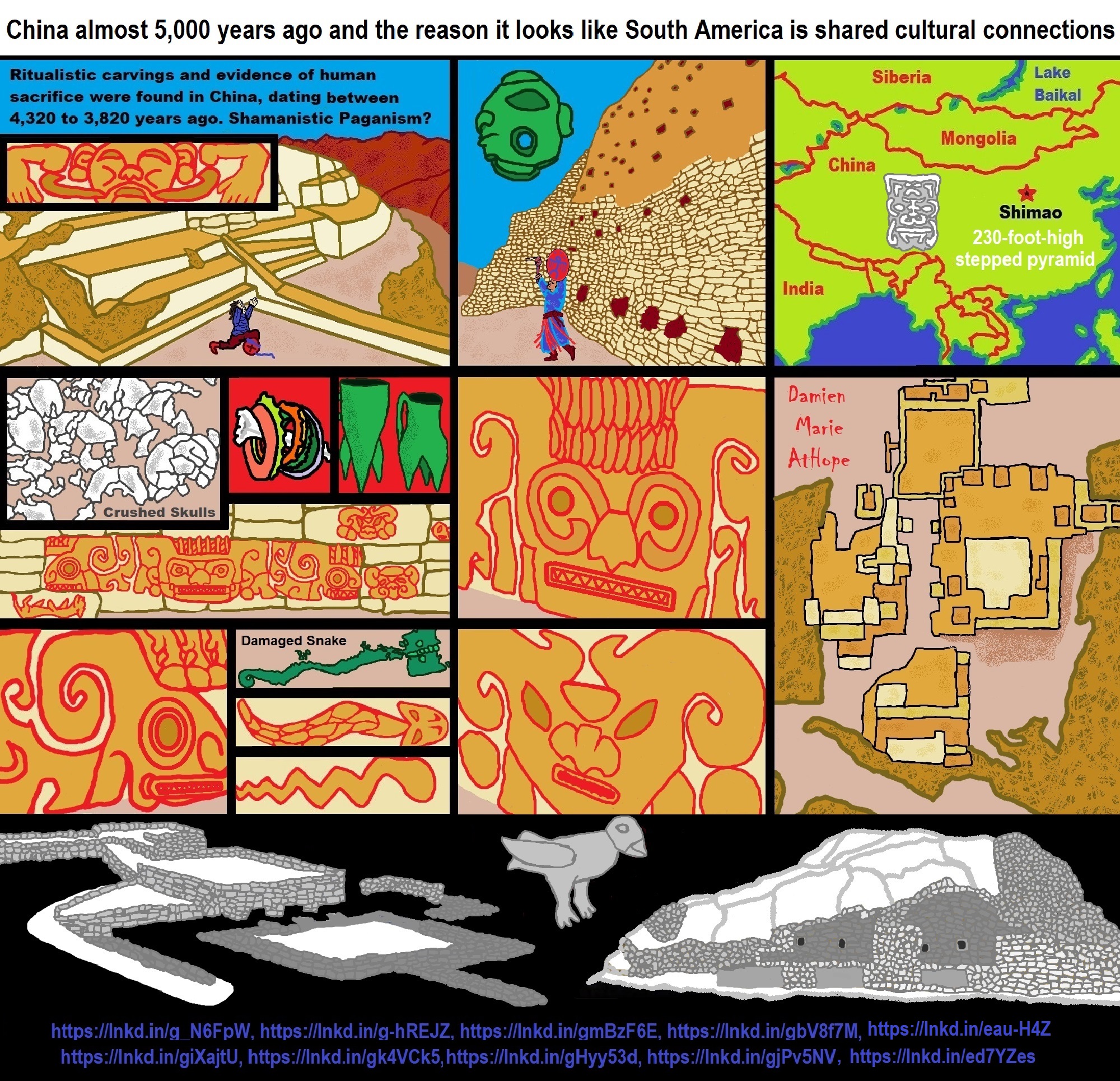
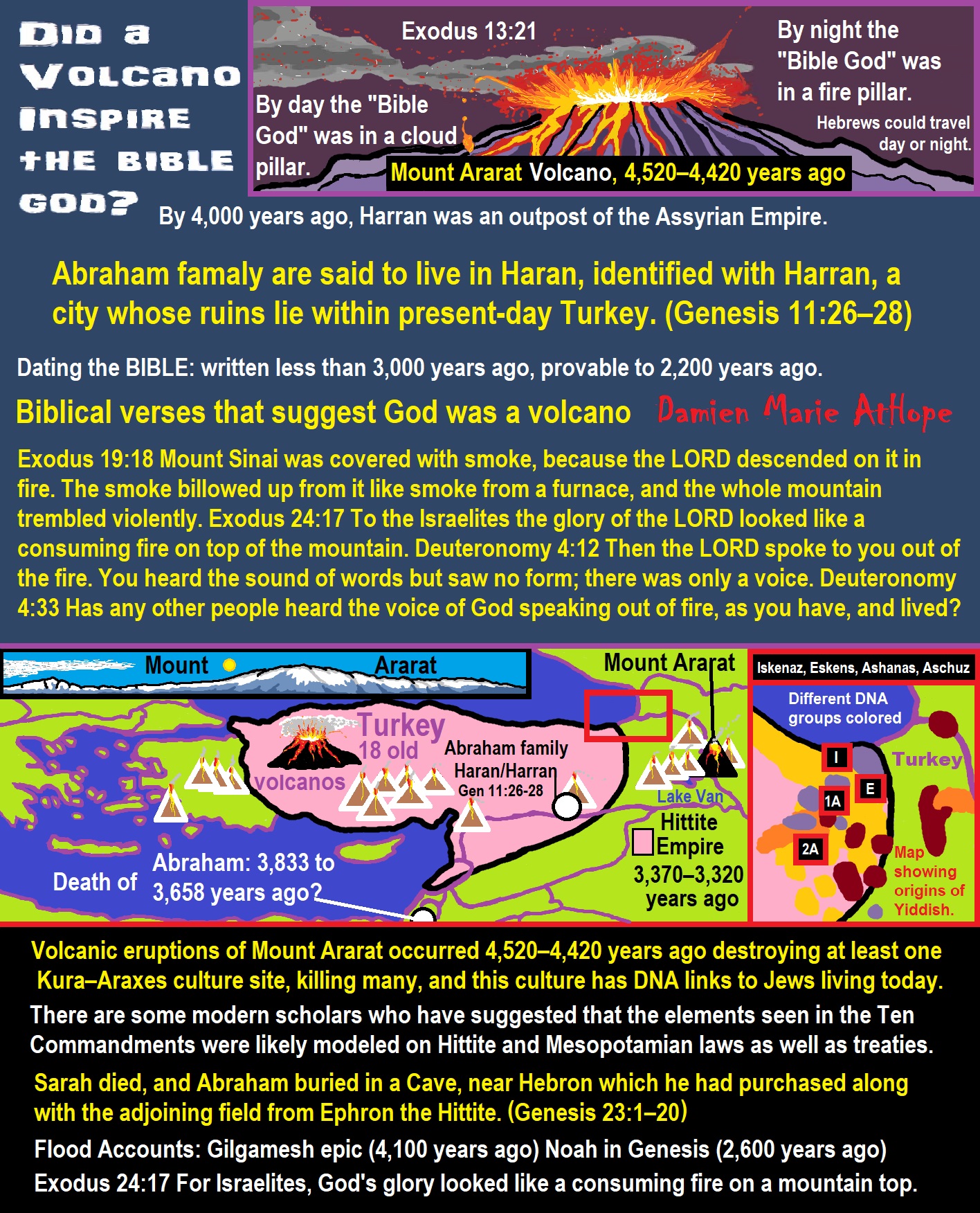
ref, ref, ref, ref, ref, ref, ref, ref, ref, ref, ref, ref, ref
By day the LORD went ahead of them in a pillar of cloud to guide them on their way and by night in a pillar of fire to give them light, so that they could travel by day or night.
- By day the “Bible God” was in a cloud pillar.
- By night the “Bible God” was in a fire pillar.
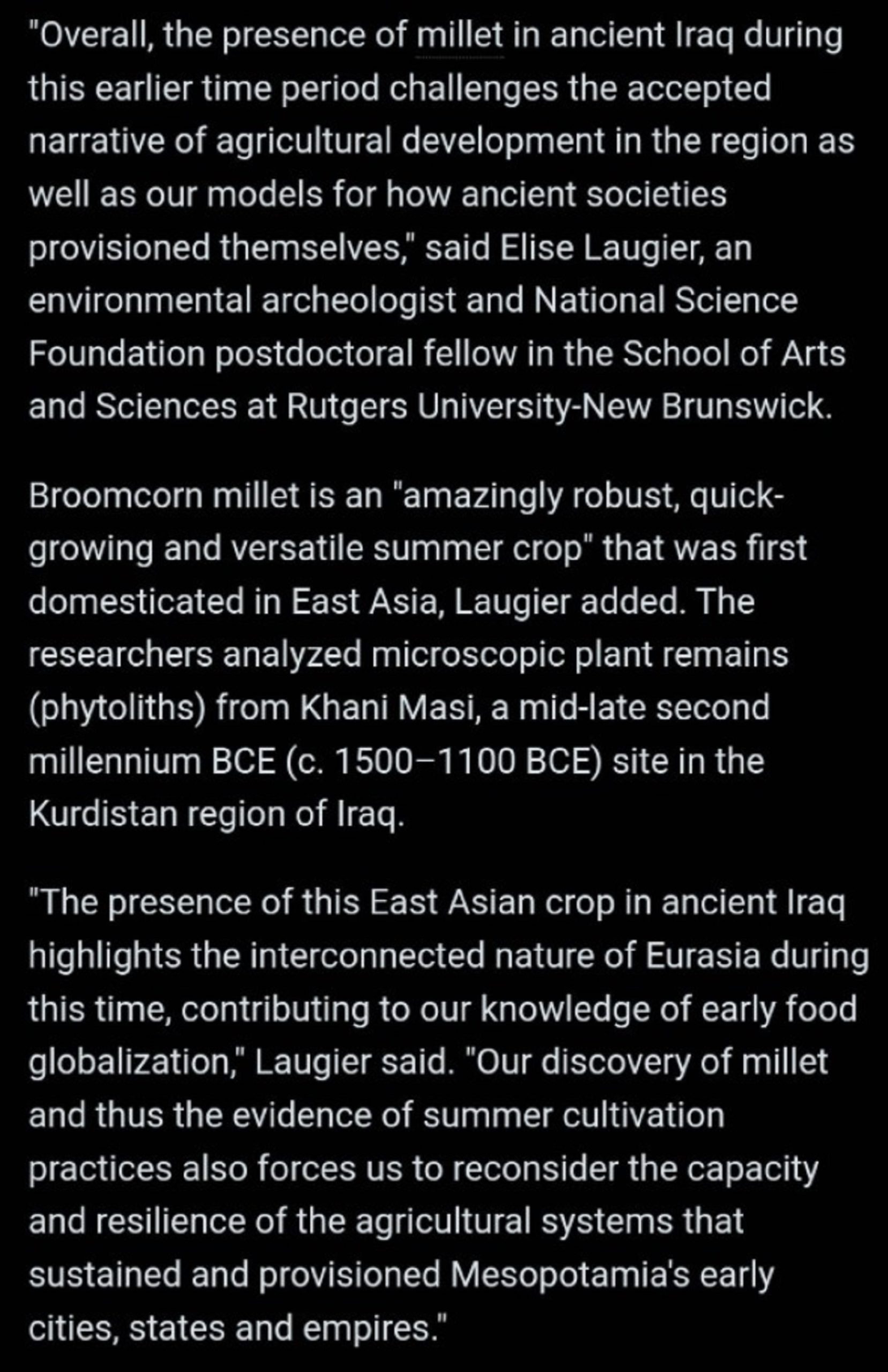
(From North China) Millet is seen in the earliest of Iraq or Mesopotamia farming. ref
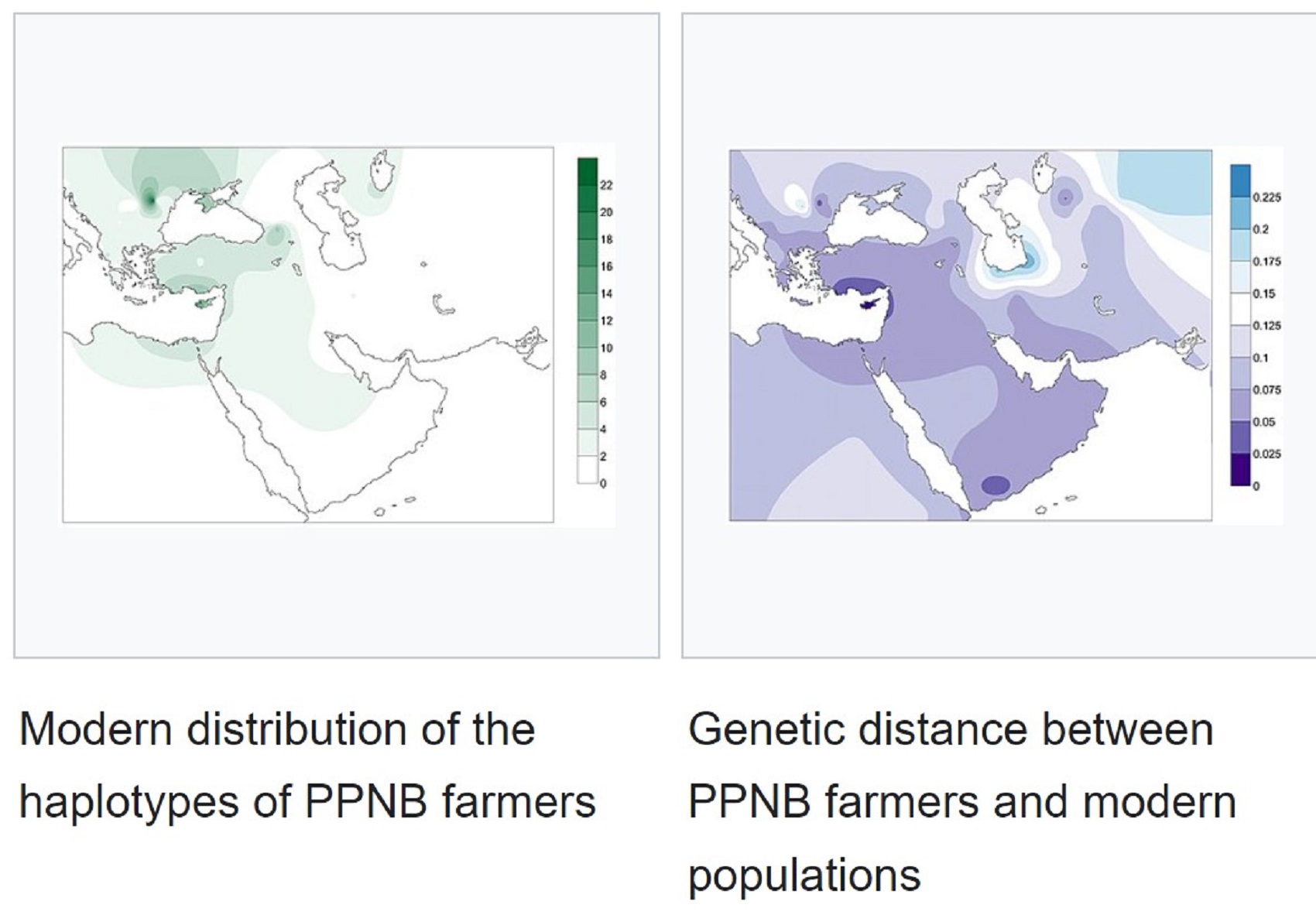
“Agricultural and husbandry practices originated 10,000 years ago in a region of the Near East known as the Fertile Crescent. According to the archaeological record this phenomenon, known as “Neolithic”, rapidly expanded from these territories into Europe.” ref
“However, whether this diffusion was accompanied or not by human migrations is greatly debated. Mitochondrial DNA –a type of maternally inherited DNA located in the cell cytoplasm- was recovered from the remains of Pre-Pottery Neolithic B (PPNB) farmers in the Near East and then compared to available data from other Neolithic populations in Europe and also to modern populations from South-Eastern Europe and the Near East.” ref
“The obtained results show that substantial human migrations were involved in the Neolithic spread and suggest that the first Neolithic farmers entered Europe following a maritime route through Cyprus and the Aegean Islands.” ref
The Pre-Pottery Neolithic is divided into Pre-Pottery Neolithic A (PPNA 10,000 – 8,800 BCE) and the following Pre-Pottery Neolithic B (PPNB 8,800 – 6,500 BCE).” ref
“The Pre-Pottery Neolithic culture of the Middle East came to an end around the time of the 8.2 kiloyear event, a cool spell centered on 6200 BCE or around 8,222 years ago that lasted several hundred years. It is succeeded by the Pottery Neolithic.” ref
“The Pre-Pottery Neolithic precedes the ceramic Neolithic (Yarmukian culture, 6400 – 6200 BCE). At ‘Ain Ghazal, in Jordan, the culture continued a few more centuries as the so-called Pre-Pottery Neolithic C culture. Work at the site of ‘Ain Ghazal in Jordan has indicated a later Pre-Pottery Neolithic C period.” ref
“Juris Zarins has proposed that a Circum Arabian Nomadic Pastoral Complex developed in the period from the climatic crisis of 6200 BCE or 8,222 years ago, partly as a result of an increasing emphasis in PPNB cultures upon domesticated animals, and a fusion with Harifian hunter-gatherers in the Southern Levant, with affiliate connections with the cultures of Fayyum and the Eastern Desert of Egypt. Cultures practicing this lifestyle spread down the Red Sea shoreline and moved east from Syria into southern Iraq.” ref

The ʿAin Ghazal Statues are a number of large-scale lime plaster and reed statues discovered at the archeological site of ʿAin Ghazal in Jordan, dating back to approximately 9000 years ago (made between 7,200 and 6,500 BCE), from the Pre-Pottery Neolithic C period. A total of 15 statues and 15 busts were discovered in 1983 and 1985 in two underground caches, created about 200 years apart.
The statues are among the earliest large-scale representations of the human form, and are regarded to be among the most remarkable specimens of prehistoric art from the Pre-Pottery Neolithic B or C period. Their purpose remains uncertain.
“The figures are of two types, full statues, and busts. Some of the busts are two-headed. Great effort was put into modeling the heads, with wide-open eyes and bitumen-outlined irises. The statues represent men, women, and children; women are recognizable by features resembling breasts and slightly enlarged bellies, but neither male nor female sexual characteristics are emphasized, and none of the statues have genitals, the only part of the statue fashioned with any amount of detail being the faces.” ref
“The statues were formed by modeling moist plaster from limestone on a reed core using plants that grew along the banks of the Zarqa River. The reed decayed over the millennia, leaving plaster shells with a hollow interior. Lime plaster is formed by heating limestone to temperatures between 600 and 900 °C (1,100 and 1,700 °F) the product, hydrated lime is then combined with water to make a dough, which was then modeled. Plaster becomes a water-resistant material when it dries and hardens. Heads, torsos, and legs were formed from separate bundles of reeds which were then assembled and covered in plaster. The irises were outlined with bitumen and the heads were covered with some sort of wig.” ref
“They are comparatively tall, but not human-sized, the tallest statues having a height of close to 1 m (3 ft). They are disproportionately flat, about 10 cm (4 in) in thickness. They were nevertheless designed to stand up, probably anchored to the floor in enclosed areas and intended to be seen only from the front. The way the statues were made would not have permitted them to last long.” ref
“And since they were buried in pristine condition it is possible that they were never on display for any extended period of time, but rather produced for the purpose of intentional burial. The site was inhabited during ca. 7250–5000 BCE. In its prime era, during the first half of the 7th millennium BCE, the settlement extended over 10–15 hectares (25–37 ac) and was inhabited by ca. 3000 people.” ref
“The statues were discovered in 1983. While examining a cross section of earth in a path carved out by a bulldozer, archaeologists came across the edge of a large pit 2.5 meters (8 ft) under the surface containing plaster statues. Excavation led by Gary O. Rollefson took place in 1984/5, with a second set of excavation under the direction of Rollefson and Zeidan Kafafi during 1993–1996.” ref
“A total of 15 statues and 15 busts were found in two caches, which were separated by nearly 200 years. Because they were carefully deposited in pits dug into the floors of abandoned houses, they are remarkably well-preserved. Remains of similar statues found at Jericho and Nahal Hemar have survived only in fragmentary state.” ref
“In ‘Ain Ghazal, the early Pottery Neolithic period starts c. 6,400 BCE, and continues to 5,000 BCE. It is situated in a relatively rich environmental setting immediately adjacent to the Zarqa River (Wadi Zarqa), the longest drainage system in highland Jordan. It is located at an elevation of about 720m within the ecotone between the oak-park woodland to the west and the open steppe-desert to the east.” ref
‘”Ain Ghazal started as a typical aceramic, Neolithic village of modest size. It was set on terraced ground in a valley-side, and was built with rectangular mud-brick houses that accommodated a square main room and a smaller anteroom. Walls were plastered with mud on the outside, and with lime plaster inside that was renewed every few years.” ref
“Evidence recovered from the excavations suggests that much of the surrounding countryside was forested and offered the inhabitants a wide variety of economic resources. Arable land is plentiful within the site’s immediate environs. These variables are atypical of many major Neolithic sites in the Near East, several of which are located in marginal environments. Yet despite its apparent richness, the area of ‘Ain Ghazal is climatically and environmentally sensitive because of its proximity throughout the Holocene to the fluctuating steppe-forest border.” ref
“The people from those small villages abandoned their unproductive fields and migrated, with their domestic animals, to places with better ecological conditions, like ‘Ain Ghazal that could support larger populations. As opposed to other sites as new people migrated to ‘Ain Ghazal, probably with few possessions and possibly starving, class distinctions began to develop. The influx of new people placed stresses on the social fabric – new diseases, more people to feed from what was planted, and more animals that needed grazing.” ref
“There are pieces of evidence of mining activities as part of a production sequence conducted by craftsmen at the site of ‘Ain Ghazal, these potential part-time specialists in some way controlled access to such raw materials.” ref
Y-DNA haplogroup E1b1b1b2 has been found in 75% of the ‘Ain Ghazal population, along with 60% of PPNB populations (and is present in all three stages of PPNB) and in most Natufians.” ref
T1a (T-M70) is found among the later Middle Pre-Pottery Neolithic B (MPPNB) inhabitants from ‘Ain Ghazal, but was not found among the early and middle MPPNB populations.” ref
“It is thought, therefore, that the Pre-Pottery Neolithic B population is mostly composed of two different populations: members of early Natufian civilization and a population resulting from immigration from the north, i.e. north-eastern Anatolia.” ref
“In the earlier levels at ‘Ain Ghazal, there are small ceramic figures that seem to have been used as personal or familial ritual figures. There are figurines of both animals and people. The animal figures are of horned animals and the front part of the animal is the most clearly modeled. They all give the impression of dynamic force. Some of the animal figures have been stabbed in their vital parts; these figures have then been buried in the houses. Other figurines were burned and then discarded with the rest of the fire.” ref
“They built ritual buildings and used large figurines or statues. The actual building of them is also a way for an elite group to demonstrate and underline its authority over those who owe the community or the elite labor as service and to bond laborers together as part of a new community. In addition to the monumental statues, small clay and stone tokens, some incised with geometric or naturalistic shapes, were found at ‘Ain Ghazal.” ref
“The 195 figurines (40 human and 155 animal) recovered were from MPPNB contexts; 81% of the figurines have been found to belong to the MPPNB while only 19% belonging to the LPPNB and PPNC. The vast majority of figurines are of cattle, a species that makes up only 8% of the overall number of identified specimens (NISP) count. The importance of hunted cattle to the domestic ritual sphere of ‘Ain Ghazal is telling. It was seemingly of importance for individual households to have members who participated both the hunting of cattle – likely a group activity – and the subsequent feasting on the remains.” ref
“Ain Ghazal is renowned for a set of anthropomorphic statues found buried in pits in the vicinity of some special buildings that may have had ritual functions. These statues are half-size human figures modeled in white plaster around a core of bundled twigs. The figures have painted clothes, hair, and in some cases, ornamental tattoos or body paint. The eyes are created using cowrie shells with a bitumen pupil and dioptase highlighting. In all, 32 of those plaster figures were found in two caches, 15 of them full figures,15 busts, and 2 fragmentary heads. Three of the busts were two-headed.” ref
“Considerable evidence for mortuary practices during the PPNB period have been described in recent years. Post-mortem skull removal, commonly restricted to the cranium, but on occasion including the mandible, and apparently following preliminary primary interments of the complete corpse. Such treatment has commonly been interpreted as representing rituals connected with veneration of the dead or some form of “ancestor worship.” ref
“There is evidence of class in the way the dead are treated. Some people are buried in the floors of their houses as they would be at other Neolithic sites. After the flesh had wasted away some of the skulls were disinterred and decorated. This was either a form of respect or so that they could impart their power to the house and the people in it. However, unlike other Neolithic sites, some people were thrown on trash heaps and their bodies remain intact. Scholars have estimated that a third of adult burials were found in trash pits with their heads intact. They may have seen the newcomers as a lower class.” ref
“Ain Ghazal people buried some of their dead beneath the floors of their houses, others outside in the surrounding terrain. Of those buried inside, often the head was later retrieved and the skull buried in a separate shallow pit beneath the house floor. Also, many human remains have been found in what appear to be garbage pits where domestic waste was disposed, indicating that not every deceased was ceremoniously put to rest. Why only a small, selected portion of the inhabitants were properly buried and the majority simply disposed of remains unresolved. Burials seem to have taken place approximately every 15–20 years, indicating a rate of one burial per generation, though gender and age were not constant in this practice.” ref
Ain Ghazal people Ancient DNA
“The vast majority of modern members of haplogroup T belong to the T1a branch, which developed during the late glacial period, between 25,000 and 15,000 years ago, possibly in the vicinity of the Iranian Plateau.” ref
“T is found in approximately 10% of native Europeans. It is also common among modern-day Iranians. Based on a sample of over 400 modern-day Iranians (Kivisild and Metspalu 2003), the T haplogroup represents roughly 8.3% of the population (about 1 out of 12 individuals), with the more specific T1 subtype constituting roughly half of those.” ref
“Furthermore, the specific subtype T1 tends to be found further east and is common in Central Asian and modern Turkic populations (Lalueza-Fox 2004), who inhabit much of the same territory as the ancient Saka, Sarmatian, Andronovo, and other putative Iranian peoples of the 2nd and 1st millennia BCE.” ref
“Lalueza-Fox et al. (2004) also found several T and T1 sequences in ancient burials, including Kurgans, in the Kazakh steppe between the 14th-10th centuries BCE, as well as later into the 1st millennia BCE. These coincide with the latter part of the Andronovo period and the Saka period in the region.” ref
“The geographic distribution within subclade T2 varies greatly with the ratio of subhaplogroup T2e to T2b reported to vary 40-fold across examined populations from a low in Britain and Ireland, to a high in Saudi Arabia (Bedford 2012). Within subhaplogroup T2e, a very rare motif is identified among Sephardic Jews of Turkey and Bulgaria and suspected conversos from the New World (Bedford 2012).” ref
“Found in Svan population from Caucasus (Georgia) T* 10,4% and T1 4,2%. T1a1a1 is particularly common in countries with high levels of Y-haplogroup R1a, such as Central and Northeast Europe. The clade is also found everywhere in Central Asia and deep into North Asia, as far east as Mongolia.” ref
“T2c and T2d appear to have a Near Eastern origin around the time of the Last Glacial Maximum (LGM) and more recent dispersals into Europe. Most of T2c comprises haplogroup T2c1. Apart from a peak in Cyprus, T2c1 is most common in the Persian Gulf region but is also found in the Levant and in Mediterranean Europe, with a more far-flung distribution at very low levels. T2 is also found among the Soqotri (7.7%).” ref
Haplogroup T is found among the later Middle Pre-Pottery Neolithic B (MPPNB) inhabitants from the ‘Ain Ghazal archaeological site (in modern Jordan). It was not found among the early and middle MPPNB populations. It is thought that the Pre-Pottery Neolithic B population is mostly composed of two different populations: members of early Natufian civilization and a population resulting from immigration from the north, i.e. north-eastern Anatolia. However, Natufians have been found to belong mostly to the E1b1b1b2 lineage – which is found among 60% of the whole PPNB population and 75% of the ‘Ain Ghazal population, being present in all three MPPNB stages.” ref
“Later MPPNB populations in the Southern Levant were already witnessing severe changes in climate that would have been exacerbated by large population demands on local resources. Beginning at 8.9 cal ka BP we see a significant decrease in population in highland Jordan, ultimately leading to the complete abandonment of almost all central settlements in this region.” ref
The 9th millennium Pre-Pottery Neolithic B (PPNB) period in the Levant represents a major transformation in prehistoric lifeways from small bands of mobile hunter–gatherers to large settled farming and herding villages in the Mediterranean zone, the process having been initiated some 2–3 millennia earlier.” ref
‘”Ain Ghazal (” Spring of the Gazelles”) is situated in a relatively rich environmental setting immediately adjacent to the Wadi Zarqa, the longest drainage system in highland Jordan. It is located at an elevation of about 720m within the ecotone between the oak-park woodland to the west and the open steppe-desert to the east.” ref
“Evidence recovered from the excavations suggests that much of the surrounding countryside was forested and offered the inhabitants a wide variety of economic resources. Arable land is plentiful within the site’s immediate environs. These variables are atypical of many major neolithic sites in the Near East, several of which are located in marginal environments. Yet despite its apparent richness, the area of ‘Ain Ghazal is climatically and environmentally sensitive because of its proximity throughout the Holocene to the fluctuating steppe-forest border.” ref
“The Ain Ghazal settlement first appears in the MPPNB and is split into two MPPNB phases. Phase 1 starts 10,300 years ago and phase 2 ends 9,550 tears ago. The estimated population of the MPPNB site from ‘Ain Ghazal is of 259-1,349 individuals with an area of 3.01-4.7 ha. Is argued that at its founding at the commencement of the MPPNB ‘Ain Ghazal was likely 2 ha in size and grew to 5 ha by the end of the MPPNB. At this point in time their estimated population was 600-750 people or 125-150 people per hectare.” ref
“Although haplogroup T is more common today in East Africa than anywhere else, it almost certainly spread from the Fertile Crescent with the rise of agriculture. Indeed, the oldest subclades and the greatest diversity of T is found in the Middle East, especially around the Fertile Crescent. Lazaridis et al. (2016) identified one carrier of haplogroup T among the remains of the Pre-Pottery Neolithic B site in Jordan. A T1a sample was also found in the Early Neolithic Linear Pottery (LBK) culture in Germany by Mathieson et al. (2015). By the end of the last glacial period, 12,000 years ago, haplogroup T had already differentiated into subclades such as T1a1a, T1a2, T1a3a, and T1a3b. Deeper subclades developed in the Near East during the Early Neolithic period for several millennia before early farmers started expanding beyond the Near East.” ref
Neolithic colonization of the Arabian peninsula and East Africa
“The higher frequency of T in East Africa would be due to a founder effect among Neolithic farmers or pastoralists from the Middle East. One theory is that haplogroup T spread alongside J1 as herder-hunters in the Pre-Pottery Neolithic period, leaving the Zagros mountains between 9,000 and 10,000 BCE, reaching the Egypt and the southern Arabian peninsula around 7,000 BCE, then propagating from there to the Horn of Africa, and later on to Madagascar. However, considering that J1 peaks in Yemen and Sudan, while T1 is most common in southern Egypt, Eritrea, and Somalia, the two may not necessarily have spread together.” ref
“They might instead have spread as separate nomadic tribes of herders who colonized the Red Sea region during the Neolithic, a period than spanned over several millennia. Nevertheless, both are found in all the Arabian peninsula, all the way from Egypt to Somalia, and in Madagascar. This contrasts with other Near Eastern haplogroups like G2a and J2, which are conspicuously absent from East Africa, and rare in the Arabian peninsula. Nowadays, T1a subclades dating from the Neolithic found in East Africa include Y16247 (downstream of CTS2214) and Y16897. Other subclades dating from the Bronze Age (see below) are present as well, such as Y15711 and Y21004, both downstream of CTS2214.” ref
Neolithic colonization of Southern Europe
“Ancient DNA tests have revealed that the majority of Early Neolithic farmers who colonized Europe belonged to Y-haplogroup G2a, with a minority of other haplogroups such as C1a2, E1b1b, H2, I2, J2, and T1a. In fact, at present haplogroup T has only been identified in remains from the Linear Pottery (LBK) culture in Germany. Nevertheless, less than 100 Neolithic European Y-DNA samples have been tested to date, so it is too early to tell if G2a was dominant in all Neolithic European cultures or only in south-east and central Europe.” ref
“Nowadays haplogroup T1a is far more common in Mediterranean Europe than elsewhere on the continent. This suggests that the bulk of T1a farmers may have followed a different route from the Near East, either by boat along the coasts, and/or via North Africa. In the first hypothesis, T1a farmers would have been associated with the Cardium Pottery culture (5000-1500 BCE or 7,022-3,522 years ago).” ref
“However, none of the samples from this culture or from later Neolithic cultures in Iberia or Italy have yielded any T1a samples (once again G2a is the dominant lineage). The North African route is, therefore, more likely and would explain why the T1a subclades found in Europe, notably T1a1a1a1 (CTS2214), T1a1a1b (Y6671), T1a1a2 (Y16897), T1a2a1 (Y6055), and T1a2b1 (P322) are all found especially in the Southwest Asia (South Levant and Arabian peninsula) and Europe. Little data is available for North Africa, but some of these subclades have been confirmed in Egypt (Y6671>Y12643), Libya (Y6671>Y22559), and Morocco (Y6671>Y12643).” ref
Neolithic colonization of Northeast Europe and Siberia
“T1a2 (L131) has been found as far east as the Volga-Ural region of Russia and Xinjiang in north-west China. This branch probably penetrated into the Pontic-Caspian Steppe during the Neolithic (perhaps alongside J2b) and became integrated to the indigenous R1a peoples before their expansion to Central Asia during the Bronze Age (=> see R1a-Z93). Nour Mousa’s doctoral thesis reported the presence of haplogroup K (xN1c1-TAT, O-M175, P-M45) among Early Neolithic inhabitants of the Lake Baikal region in southern Siberia. That sample was not tested for haplogroup T, but it very probably is T1a considering its presence in the region today and the lack of other plausible alternative (besides K* and N*).” ref
“Haplogroup T has been found at a relatively high frequency among the Tatars (5%) and Maris (2%) of the Volga-Ural region as well as in north-west Russia (3%) suggesting that it may have been one of the principal lineages bringing the Neolithic to Uralic-speaking population. Autosomal DNA tests have also identified unusually high percentages of Southwest Asian admixtures among the Finns (1 to 2.5%) and Lithuanians (1.5%), who otherwise lack West Asian or Caucasian admixture and possess hardly any Middle Eastern Y-DNA. This Southwest Asian admixture could be the trace of T lineages absorbed during the Neolithic.” ref
Kura-Araxian expansion during the Bronze Age
“The P77 and CTS6507 branch underwent a major expansion during the Early Bronze Age, from approximately 2500 BCE. The phylogeny suggests that this expansion took place from the South Caucasus region, including the Armenian Highlands, and spread in various directions around the Middle East and Europe. The European branch appears to have propagated through a Mediterranean route to Greece, Italy (including Sicily and Sardinia), and Iberia. Historically the Kura-Araxes culture is the best match for this expansion.” ref
“While the Proto-Indo-Europeans (haplogroups R1a and R1b) were expanding from the Pontic-Caspian Steppe to central and northern Europe and Central Asia, the Kura-Araxes people, on the other side of the Caucasus, also developed a contemporary Bronze Age culture that expanded across West Asia, and possibly as far east as Pakistan and India. The Minoans, Europe’s oldest proper civilisation (as opposed to archeological culture), could be an offshoot from that Kura-Araxes expansion. Kura-Araxian men would have belonged primarily to Y-haplogroup J2a1, but also to a lower extent to G2a-L293, G2a-M406, J1-Z1828, L1b, T1a-P77, and R1b1-L278.” ref
Ancient civilizations associated with Y-haplogroup T
“During the Copper and Bronze Ages haplogroup T would have been an important (though probably not dominant) lineage among ancient peoples such as Sumerians, the Babylonians, and the Assyrians. The higher than average frequencies of haplogroup T in places like Cyprus, Sicily, Tunisia, Ibiza, Andalusia, and the northern tip of Morocco suggest that haplogroup T could also have been dispersed around the Mediterranean by the Phoenicians (1200-800 BCE), and that ancient Phoenicia seemingly had a higher incidence of T than Lebanon does today (5%).” ref
“Haplogroup N has a wide geographic distribution throughout northern Eurasia, and it also has been observed occasionally in other areas, including Central Asia and the Balkans.” ref
“Among the ancient samples from the Baikal Early Neolithic Kitoi culture, one of the Shamanka II samples (DA250), dated to c. 6,522 years ago, was analyzed as NO1-M214. Y-chromosomes belonging to N1b-F2930/M1881/V3743, or N1*-CTS11499/L735/M2291(xN1a-F1206/M2013/S11466), have been found in China and sporadically throughout other parts of Eurasia. N1a-F1206/M2013/S11466 is found in high numbers in Northern Eurasia.” ref
“It has been found with the greatest frequency among indigenous peoples of Russia, including Finnic peoples, Mari, Udmurt, Komi, Khanty, Mansi, Nenets, Nganasans, Turkic peoples (Yakuts, Dolgans, Khakasses, Tuvans, Tatars, Chuvashes, etc.), Buryats, Tungusic peoples (Evenks, Evens, Negidals, Nanais, etc.), Yukaghirs, Luoravetlans (Chukchis, Koryaks), and Siberian Eskimos, but certain subclades are very common in Finland, Estonia, Latvia, and Lithuania, and other subclades are found at low frequency in China (Yi, Naxi, Lhoba, Han Chinese, etc.).” ref
“Especially in ethnic Finnic peoples and Baltic-speaking peoples of northern Europe, the Ob-Ugric-speaking and Northern Samoyed peoples of western Siberia, and Turkic-speaking peoples of Russia (especially Yakuts (McDonald 2005), but also Altaians, Shors, Khakas, Chuvashes, Tatars, and Bashkirs). Nearly all members of haplogroup N among these populations of northern Eurasia belong to subclades of either haplogroup N-Tat or haplogroup N-P43.” ref
“N2-Y6503, the other primary subclade of haplogroup N, is extremely rare and is mainly represented among extant humans by a recently formed subclade that is virtually restricted to the countries making up the former Yugoslavia (Bosnia-Herzegovina, Croatia, Serbia, and Montenegro), Hungary and Austria. Other members of N2-Y6503 include a Hungarian with recent ancestry from Suceava in Bukovina, a Slovakian, a few British individuals, and an Altaian.” ref
N1(xN1a,N1c) was found in ancient bones of Liao civilization:
- Niuheliang (Hongshan Culture, 6500–5000 BP) 66.7%(=4/6)
- Halahaigou (Xiaoheyan Culture, 5000–4200 BP) 100.0%(=12/12)
- Dadianzi (Lower Xiajiadian culture, 4200–3600 BP) 60.0%(=3/5).” ref
“N-CTS4309: two people identified with this subgroup in Iraq. Very rare. In Siberia, haplogroup N-M46 reaches a maximum frequency of approximately 90% among the Yakuts, a Turkic people who live mainly in the Sakha (Yakutia) Republic. However, N-M46 is present with much lower frequency among many of the Yakuts’ neighbors, such as Evenks and Evens.” ref
“The haplogroup N-M46 has a low diversity among Yakuts suggestive of a population bottleneck or founder effect (Pakendorf 2002). This was confirmed by a study of ancient DNA which traced the origins of the male Yakut lineages to a small group of horse-riders from the Cis-Baikal area (Crubézy 2010).” ref
“N-Tat has been observed with greatly varying frequency in samples from Sweden. Karlsson et al. (2006) found N-Tat in 44.7% (17/38) of a sample of Saami nomads from Jokkmokk, 19.5% (8/41) of a sample from Västerbotten, 14.5% (8/55) of a sample from Uppsala, 10.0% (4/40) of a sample from Gotland, 9.5% (4/42) of a sample from Värmland, 7.3% (3/41) of a sample from Östergötland/Jönköping, 2.4% (1/41) of a sample from Blekinge/Kristianstad, and 2.2% (1/45) of a sample from Skaraborg.” ref
“The subclade N-M178 [Phylogenetics 3] is defined by the presence of markers M178 and P298. N-M178* has higher average frequency in Northern Europe than in Siberia, reaching frequencies of approximately 60% among Finns and approximately 40% among Latvians, Lithuanians & 35% among Estonians (Derenko 2007 and Lappalainen 2008).” ref
“Miroslava Derenko and her colleagues noted that there are two subclusters within this haplogroup, both present in Siberia and Northern Europe, with different histories. The one that they labelled N3a1 first expanded in south Siberia and spread into Northern Europe. Meanwhile, the younger subcluster, which they labelled N3a2, originated in south Siberia (probably in the Baikal region)(Derenko 2007).” ref
“N-M178 was also found in two Na-Dené speaking Tłı̨chǫs in North America. Neolithic samples from Baikal area have yielded plenty of yDNA N specimens, and one sample from Fofonovo, Buryatia, 5000-4000 BC is among the first Tat samples in the ancient record.” ref
“N1a2a-M128 and N1a2b-B523/P43 are estimated to share a most recent common ancestor in N1a2-F1008/L666 approximately 8,600 [95% CI 7,500 <-> 9,800] years before present or 9,314 [95% CI 7,419 <-> 11,264] years before present.” ref
“At least three of six tested male specimens from the Early Neolithic (ceramic-using hunter-gatherer of approximately 7200–6200 years ago) layer at the Shamanka archaeological site near the southern end of Lake Baikal have been found to belong to N1a2-L666.” ref
“N-M128 was first identified in a sample from Japan (1/23 = 4.3%) and in a sample from Central Asia and Siberia (1/184 = 0.5%) in a preliminary survey of worldwide Y-DNA variation.[47] Subsequently, it has been found with low frequency in some samples of the Manchu people, Sibe people, Evenks, Koreans, Han Chinese, Hui, Tibetans, Vietnamese, Bouyei people, Kazakhs, Uzbeks, Uyghurs, Salars, Tu, Mongols, the Buzava tribe of Kalmyks,[29] Khakas, and Komis.” ref
“A number of Han Chinese, an Ooled Mongol, a Qiang, and a Tibetan were found to belong to a sister branch (or branches) of N-M128 under paragroup N-F1154*. A neolithic sample brn002 (~5,940 BP) in Trans-Baikal was discovered to be an early offshoot upstream of N-M128.” ref
“Haplogroup N-P43[Phylogenetics 5] is defined by the presence of the marker P43. It has been estimated to be about five thousand years old (TMRCA 4,700 [95% CI 3,800 <-> 5,600] ybp or 4,727 [95% CI 3,824 <-> 5,693] years before present). It has been found very frequently among Northern Samoyedic peoples, speakers of Ob-Ugric languages, and northern Khakassians, and it also has been observed with low to moderate frequency among speakers of some other Uralic languages, Turkic peoples, Mongolic peoples, Tungusic peoples, and Siberian Yupik people.” ref
“The highest frequencies of N-P43 are observed among north-west Siberian populations: 92% (35/38) in a sample of Nganasan, 78% (7/9) in a sample of Enets, 78% (21/27) in a sample of Khants, 75% (44/59) in a sample of Tundra Nenets, 69% (29/42) in another sample of Nenets, 60% (15/25) in a sample of Mansi, 57% (64/112) in another sample of Khants, 54% (27/50) in another sample of Nganasan, 45% (40/89) in a sample of Forest Nenets, 38% (18/47) in a third sample of Khants, and 25% (7/28) in a fourth sample of Khants.” ref
“In Europe, the N-P43 types have their highest frequency of 20% among Volga-Uralic populations. The extreme western border of the spread of N-P43 is Finland, where this haplogroup occurs only at marginal frequency – 0.4%. Yet N-P43 is quite frequent among Vepsas (17.9%), a small Finnic population living in immediate proximity to Finns, Karelians and Estonians.” ref
“Haplogroup N-P43 also has been observed with very high frequency (26/29 = 89.7% of a sample from the settlement of Topanov and 19/22 = 86.4% of a sample from the settlement of Malyi Spirin) in samples of Kachins, a Turkic-speaking ethnic group or territorial subgroup of the Khakas people, from Shirinsky District of northern Khakassia.” ref
“There appears to be a cline through the Sagai (another Turkic-speaking ethnic group that is now considered to be a constituent of the Khakas people), with 46.2% (55/119) of Sagai sampled from Ust’–Es’, Esino, Ust’–Chul’, and Kyzlas settlements of Askizsky District of central Khakassia belonging to haplogroup N-P43 vs. only 13.6% (11/81) of Sagai sampled from Matur, Anchul’, Bol’shaya Seya, and Butrakhty settlements of Tashtypsky District of southern Khakassia belonging to this haplogroup.” ref
“However, other researchers’ samples of Khakas people have exhibited only moderate frequencies of N-P43 or potential N-P43. Derenko et al. (2006) examined a sample of Khakassians (n=53) collected in the settlements of Askiz, Shirinsk, Beisk and Ordzhonikidzevsk districts of Khakass Republic and found that 15 of them (28.3%) belonged to N-LLY22g(xTat).” ref
“Rootsi et al. (2007) examined a sample of Khakas (n=181) and found that 31 of them (17.1%) belonged to N-P43; Ilumae et al. (2016) retested 174 of the individuals in this sample and found that 27 of them (15.5%) belonged to the N-B478 (Asian/northern Samoyedic) subclade of N-P43 and 2 of them (1.1%) belonged to the N-L1419 (European/Volga Finnic and Chuvash) subclade of N-P43 for a total of 29 (16.7%) N-P43.” ref
“Haplogroup N-P43 forms two distinctive subclusters of STR haplotypes, Asian and European, the latter mostly distributed among Finno-Ugric-speaking peoples and related populations (Rootsi et al. 2006). Haplogroup N1b has been predominantly found in the Yi people, a Tibeto-Burman speaking ethnic group in southwestern China who originated from ancient Qiang tribes in northwestern China. However, it also has been found in people all over China and in some samples of people from Poland, Belarus, Russia, Mongolia, Korea, Japan, Vietnam, Cambodia, Bhutan, and India.” ref
“N-P189 include members from Turkey, Russia (Moscow Oblast), France (Charente-Maritime), and England (Devon[1]). The most recent common ancestor of all the aforementioned extant N-P189 lineages has been estimated to be 4,900 (95% CI 5,700 <-> 4,100) years before present. An archaeological specimen attributed to the Botai culture of northern Kazakhstan and dated to the latter half of the fourth millennium BCE belongs to N-P189*, being basal to present-day European members of N-P189.” ref
“Lineages that belong to N-Y6503(xP189) and are only distantly related (with a time to most recent common ancestor estimated to be greater than 10,000 years before present) to the aforementioned members of N-P189 have been found in an individual from the present-day Altai Republic and probably also in an archaeological specimen attributed to the Iron Age Mezőcsát culture of what is now Hungary (approx. 2,900 years before present) and in an archaeological specimen attributed to the Kitoi culture of ceramic-using foragers of the area around Lake Baikal (approx. 6,700 years before present).” ref
N-Lineages related to Ancient peoples
“A sample was excavated at the Houtaomuga site in the Yonghe neighborhood of Honggangzi Township, Da’an, Jilin, China dating back to 7430–7320 years ago (Phase II of the Early Neolithic) has been found to belong to Y-DNA haplogroup N and mtDNA haplogroup B4c1a2. This sample is autosomally identical with the Neolithic Amur River Basin populations, of which Nivkh people are the closest modern representative.
As the paper detected this ancestry in terminal Pleistocene USR1 specimen in Alaska, it is, therefore, postulated that there was gene flow from Amur to America of a population belonging to a hypothetical Chukotko-Kamchatkan–Nivkh linguistic family. N has also been found in many samples of Neolithic human remains exhumed from Liao civilization in northeastern China, and in the circum-Baikal area of southern Siberia.
It is suggested that yDNA N, reached southern Siberia from 12,000-14,000. From there it reached southern Europe 8,000-10,000 years ago.
N-BY158 Russia (Voronezh Oblast, Smolensk Oblast, Tatarstan), Belarus (Vitebsk Region), Lithuania (Vilnius County, Šiauliai County, Panevėžys County), Poland (Podlaskie), Ukraine (Poltava Oblast), Kazakhstan (Jambyl Region)” ref
N-Z16976* Belarus (Grodno Region), Ukraine (Khmelnytskyi Oblast) N-Y6075 Poland (Małopolskie, Mazowieckie), Ukraine (Lviv Oblast), Slovakia, Czech Republic (Moravian-Silesian Region), United States (New Jersey)” ref
“N1a became particularly prominent in this debate when a team led by Wolfgang Haak analyzed skeletons from Linear Pottery Culture sites. The Linear Pottery Culture is credited with the first farming communities in Central Europe, marking the beginning of Neolithic Europe in the region some 7500 years ago.” ref
“Critics of these studies claim that the LBK N1a specimens could have derived from local communities established in Europe before the introduction of farming. Ammerman’s team voiced concern due to some of the LBK specimens coming from communities several hundred years after farming was first established in the region; a rebuttal was given.” ref
“In 2010, researchers led by Palanichamy conducted a genetic and phylogeographic analysis of N1a. Based on the results, they conclude that some of the LBK samples were indigenous to Europe while others may have resulted from ‘leapfrog’ colonization. Deguilloux’s team agreed with Haak’s conclusion on a genetic discontinuity between ancient and modern Europeans. However, they consider demic diffusion, cultural diffusion, and long-distance matrimonial exchanges all equally plausible explanations for the current genetic findings.” ref
“N1a was also identified in skeletal remains within a 6200-year-old megalithic long mound near Prissé-la-Charrière, France. A 2500-year-old fossil of a Scytho-Siberian in the Altai Republic, easternmost representative of the Scythians, was found to be a member of N1a1. A study of 10th and 11th century Hungarians found that N1a1a1 was present in high-status individuals but absent from commoners.” ref
“The N1 subclade has also been found in various other fossils that were analyzed for ancient DNA, including specimens associated with the Starčevo (N1a1a1, Alsónyék-Bátaszék, Mérnöki telep, 1/3 or 33%), Linearbandkeramik (N1a1a1a3, Szemely-Hegyes, 1/1 or 100%; N1a1b/N1a1a3/N1a1a1a2/N1a1a1/N1a1a1a, Halberstadt-Sonntagsfeld, 6/22 or ~27%), Alföld Linear Pottery (N1a1a1, Hejőkürt-Lidl, 1/2 or 50%), Transdanubian Late Neolithic (N1a1a1a, Apc-Berekalja, 1/1 or 100%), Protoboleráz (N1a1a1a3, Abony, Turjányos-dűlő, 1/4 or 25%), Iberia Early Neolithic cultures (N1a1a1, Els Trocs, 1/4 or 25%), Rinaldone–Gaudo Eneolithic cultures (N1a1a1a3, Monte San Biagio, 1/1 or 100%).” ref
“Relatively high frequencies of N1a are found in the modern population of Saudi Arabia. Estimates range from 2.4%to 4%. Regional analysis revealed that the haplogroup was most common in the center of the country. Haplotype diversity is noted for being higher here than elsewhere. Frequencies of N1a in Yemen are relatively high, with estimates varying by study: 3.6%, 5.2%, and 6.9%. Yemen is noted for high haplotype diversity within the population.” ref
“Elsewhere in the Near East, prevalence of N1a is lower. A 2008 article cited population frequencies of 1.1% in Qatar, 0.3% in Iran, and 0.2% in Turkey. The tree of N1a has two distinct branches: Africa/South Asia and Europe with a Central Asian subcluster. However, the African branch has members in southern Europe, and the European branch has members in Egypt and the Near East. The Africa/South Asia branch is characterized by the 16147G mutation, whereas the European branch is characterized by 16147A, 3336, and 16320. The Central Asian subcluster is an offshoot of the European branch that is characterized by marker 16189.” ref
N1a1a1a1a2-Z1936, CTS10082 Found with high frequency among Finns, Vepsa, Karelians, Swedish Saami, northwestern Russians, Bashkirs, and Volga Tatars, moderate frequency among other Russians, Komis, Nenetses, Ob-Ugrians, Dolgans, and Siberian Tatars, and low frequency among Mordva, Nganasans, Chuvashes, Estonians, Latvians, Ukrainians, and Karanogays” ref
N1a1a1a1a3a-F4205 Found with high frequency among Buryats and Tsaatans, moderate frequency among Karanogays, Tuvans, Todjins, and Mongols, and low frequency among Altaians, Siberian Tatars, Kazakhs, Evenks, Crimean Tatars, Karakalpaks, Uzbeks, and Ukrainians” ref
N-Y16221N-Y16221* China (Inner Mongolia) N-Y16220N-Y16220* Russia (Buryat Republic) N-Y65550 Uzbekistan, Turk N-F22331 Turkey (Mersin), Poland (Małopolskie)” ref
N-Y16312N-Y16312* Uzbekistan, N-Y16320 Kazakhstan, N1a1a1a1a3b-B202 Found with high frequency among Chukchis, Koryaks, and Siberian Eskimos N1a1a1a1b-M2118N1a1a1a1b-M2118* Estonia” ref
N-M2016
N1a1a1a1b1-M1982/M1993 Yakutia (Yakut, Even, Evenk) N-M1932 Yakutia (Yakut, Even)” ref
N-M1991N-M1988 Yakutia (Yakut) N-Y25011 Yakutia (Yakut, Evenki)” ref
N1a1a1a1b2-A9408 Lebanon N-Y70200 Korean, China” ref
N-PH1612N-A9416 Hungary (Szabolcs-Szatmár-Bereg), Croatia (Zadar County), Russia (Chuvash Republic)
N-PH1896 Hungary (Borsod-Abaúj-Zemplén), Turkey (Hatay)” ref
N1a1a1a2-B211 (Y9022) Udmurt, Komi, Chuvash, Ob-Ugrians, Mari, Mordva, Altaian, Belarusian, Karanogay, Karelian, Bashkir, Tatar, Russian, Khakas N1a1a1a2a-B181N-Y182299 Russia (Kirov Oblast, etc.) N-Y23788 Russia (Bashkortostan, Komi Republic, etc.)” ref
N1a1a1a2b-Y23181N-Y23183 Russia (Tatarstan, Mordovia, Penza Oblast)[1]
N-Y143277 Russia (Tatarstan, Bashkortostan)” ref
N-Y24317N-Y24317*(xB187) India (Andhra Muslim) N1a1a1b-B187 Khakas,[3][1] Shors,[3][49] Altaians, Tuvinians, Tozhu Tuvan, Tatar, Bashkir” ref
N1a1a2-Y23747 Japan (Sado Island), Daur N1a1a2a-Y23749 Japan (Aichi, Hokkaidō)” ref
N1a1a2b-Y125664N-Y125664* Shanghai N-MF16376N1a1a2b1-MF38607 Anhui, Hunan” ref
“N1a1a2b2-F22150N-F22150* Hebei, Oroqen N-MF15288 Heilongjiang, Korean N-MF55680 Korean, Shigatse (Tibetan)” ref
“N1a2b3-B525 Turkey, Tatars, Bashkirs, Kazakhs, Mongols (Xinjiang Kalmyk, Mongolian Torgut), Slovakia, Bulgaria, Ukrainians, Belarusians, RussiansN-B525* Afghanistan, Arab N-BY173686 Russia (Voronezh Oblast)” ref
N-VL83 Turkey N-Y136502 Russia (Tatarstan), Bulgaria (Dobrich) N-Y37153N-Y37153* Russia (Tatarstan)” ref
N-BY29131N-BY29131* Turkey (Konya), Slovakia (Žilina Region)
N-BY30476 Russia (Tatarstan, Penza Oblast)” ref
“N1a2b2-FGC10872/Y3195N1a2b2a-FGC10847/Y3185 (L1419) Vepsas, Maris, Russians (Arkhangelsk Oblast), Komis, Perm Krai, Komi Republic, Ob-Ugrians, Chuvashes, Tatars, Bashkirs, Karelians, Western Finland Province, Tuvans, Buryats, Khakasses, Nganasans, Asian Eskimos” ref
N2-Y6503* Altai Republic
“N2a1a-Y7310N2a1a-Y7310* Romania (Hungarian from Suceava) N2a1a1-Y7313N2a1a1-Y7313* N2a1a1a-BY35494 Russia (Rostov Oblast)” ref
“N2a1a1b-FGC28435N2a1a1b-FGC28435* Turkey (Istanbul), Serbia, Montenegro (Plužine), Bosnia and Herzegovina (Republika Srpska), Croatia N2a1a1b1-FGC28483 Serbia” ref
“N2a2-Y111068N2a2a-FT352925 France (Charente-Maritime), Turkey
N2a2b-Y101945 United Kingdom (Devon), Russia (Moscow Oblast)” ref
Haplogroup N1b – found in Middle East, Egypt (Gurna), Caucasus, and Europe.” ref
“N1a’c’d’e’I Haplogroup N1c – Northern Saudi Arabia, Turkey N1a’d’e’IHaplogroup N1d – India” ref
“N1a’e’IHaplogroup N1a – Arabian Peninsula and Northeast Africa. Found also in Central Asia and Southern Siberia. This branch is well attested in ancient people from various cultures of Neolithic Europe, from Hungary to Spain, and among the earliest farmers of Anatolia.” ref
“N1e’I Haplogroup N1e – found in Balochs, Burushos, and Buryats Haplogroup I – West Eurasia and South Asia.
Haplogroup N5 – found in India.” ref
Haplogroup N2 Haplogroup N2a – small clade found in West Europe.” ref
“Haplogroup N9a3a – Japan, Korean (Seoul), Taiwan (incl. Paiwan), Thailand (Mon from Lopburi Province and Kanchanaburi Province[36]), China, Uyghur, Kyrgyz (Tashkurgan), Kazakhstan, Buryat, Russia (Belgorod, Chechen Republic, etc.), Ukraine, Moldova, Belarus, Lithuania, Poland, Czech (West Bohemia), Hungary, Austria, Germany [TMRCA 8,280.9 ± 5,124.4 years ago)” ref
Haplogroup N9a2a1 – Japan [TMRCA 4,200 (95% CI 1,850 <-> 8,400 years ago)” ref
Haplogroup N9a2a2 – Japan, Korea, Volga-Ural region (Tatar)[40] [TMRCA 5,700 (95% CI 3,500 <-> 8,900 years ago)” ref
Haplogroup N9a2a3 – Japan, Hulun-Buir region (Barghut)[40] [TMRCA 4,700 (95% CI 2,400 <-> 8,400 years ago)” ref
Haplogroup N9a2a4 – Japan [TMRCA 2,800 (95% CI 600 <-> 7,900 years ago)” ref
- “Haplogroup O or N12- found among Indigenous Australians and the Floresians of Indonesia.
- Haplogroup N13 – Aboriginal Australians
- Haplogroup N14 – Aboriginal Australians
- Haplogroup N21 – In ethnic Malays from Malaysia and Indonesia.
- Haplogroup N22 – Southeast Asia, Bangladesh, India, Japan.” ref
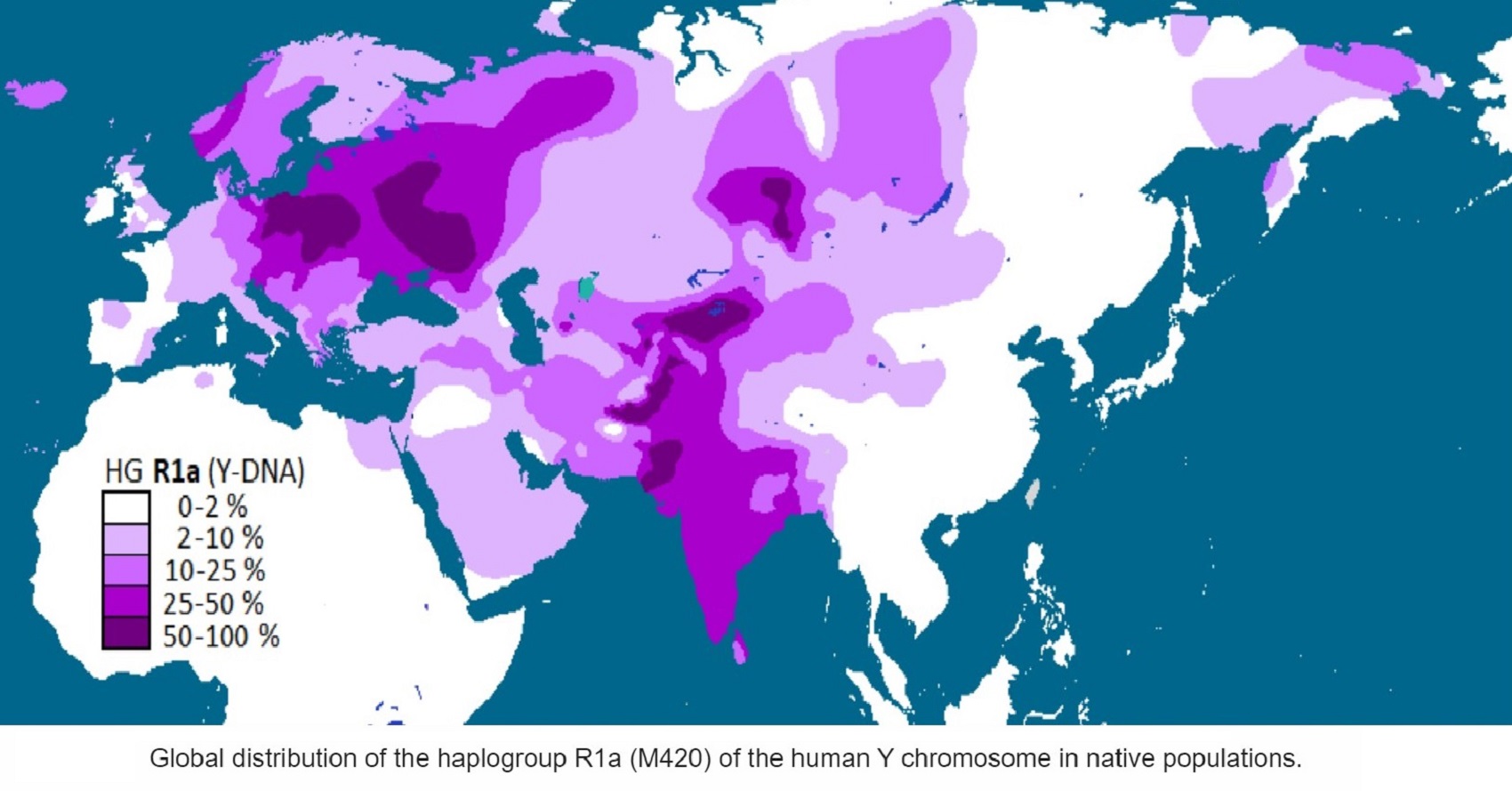
Diversification of R1a1a1 (M417) and ancient migrations and Proto-Indo-Europeans
“Haplogroup R1a, or haplogroup R-M420, is a human Y-chromosome DNA haplogroup which is distributed in a large region in Eurasia, extending from Scandinavia and Central Europe to southern Siberia and South Asia. While R1a originated ca. 22,000 to 25,000 years ago, its subclade M417 (R1a1a1) diversified ca. 5,800 years ago. The place of origin of the subclade plays a role in the debate about the origins of Proto-Indo-Europeans.” ref
“The SNP mutation R-M420 was discovered after R-M17 (R1a1a), which resulted in a reorganization of the lineage in particular establishing a new paragroup (designated R-M420*) for the relatively rare lineages which are not in the R-SRY10831.2 (R1a1) branch leading to R-M17.” ref
“According to Underhill et al. (2014), the downstream R1a-M417 subclade diversified into Z282 and Z93 circa 5,800 years ago “in the vicinity of Iran and Eastern Turkey.” Even though R1a occurs as a Y-chromosome haplogroup among various languages such as Slavic and Indo-Iranian, the question of the origins of R1a1a is relevant to the ongoing debate concerning the urheimat of the Proto-Indo-European people, and may also be relevant to the origins of the Indus Valley Civilization.” ref
“R1a shows a strong correlation with Indo-European languages of Southern and Western Asia, Central and Eastern Europe, and to some extent, Scandinavia being most prevalent in Eastern Europe, West Asia, and South Asia. In Europe, Z282 is prevalent, particularly while in Asia Z93 dominates. The connection between Y-DNA R-M17 and the spread of Indo-European languages was first noted by T. Zerjal and colleagues in 1999.” ref
“Semino et al. (2000) proposed Ukrainian origins, and a postglacial spread of the R1a1 gene during the Late Glacial Maximum, subsequently magnified by the expansion of the Kurgan culture into Europe and eastward. Spencer Wells proposes Central Asian origins, suggesting that the distribution and age of R1a1 points to an ancient migration corresponding to the spread by the Kurgan people in their expansion from the Eurasian steppe.” ref
“According to Pamjav et al. (2012), R1a1a diversified in the Eurasian Steppes or the Middle East and Caucasus region: Inner and Central Asia is an overlap zone for the R1a1-Z280 and R1a1-Z93 lineages [which] implies that an early differentiation zone of R1a1-M198 conceivably occurred somewhere within the Eurasian Steppes or the Middle East and Caucasus region as they lie between South Asia and Central- and Eastern Europe.” ref
“Three genetic studies in 2015 gave support to the Kurgan theory of Gimbutas regarding the Indo-European Urheimat. According to those studies, haplogroups R1b and R1a, now the most common in Europe (R1a is also common in South Asia) would have expanded from the Pontic–Caspian steppes, along with the Indo-European languages; they also detected an autosomal component present in modern Europeans which was not present in Neolithic Europeans, which would have been introduced with paternal lineages R1b and R1a, as well as Indo-European languages.” ref
Source of R1a1a1 in Corded Ware culture
“David Anthony considers the Yamnaya culture to be the Indo-European Urheimat. According to Haak et al. (2015), a massive migration from the Yamnaya culture northwards took place ca. 2,500 BCE, accounting for 75% of the genetic ancestry of the Corded Ware culture, noting that R1a and R1b may have “spread into Europe from the East after 3,000 BCE” Yet, all their seven Yamnaya samples belonged to the R1b-M269 subclade, but no R1a1a has been found in their Yamnaya samples. This raises the question where the R1a1a in the Corded Ware culture came from, if it was not from the Yamnaya culture.” ref
Transcaucasia & West Asian origins and possible influence on Indus Valley Civilization
See also: Kura–Araxes culture, Uruk period, and Origins of the Indus Valley Civilisation
“Part of the South Asian genetic ancestry derives from west Eurasian populations, and some researchers have implied that Z93 may have come to India via Iran and expanded there during the Indus Valley Civilization.” ref
“Mascarenhas et al. (2015) proposed that the roots of Z93 lie in West Asia, and proposed that “Z93 and L342.2 expanded in a southeasterly direction from Transcaucasia into South Asia,” noting that such an expansion is compatible with “the archeological records of the eastward expansion of West Asian populations in the 4th millennium BCE culminating in the so-called Kura-Araxes migrations in the post-Uruk IV period.” Yet, Lazaridis noted that sample I1635 of Lazaridis et al. (2016), their Armenian Kura-Araxes sample, carried Y-haplogroup R1b1-M415(xM269) (also called R1b1a1b-CTS3187).” ref
“According to Underhill et al. (2014) the diversification of Z93 and the “early urbanization within the Indus Valley […] occurred at [5,600 years ago] and the geographic distribution of R1a-M780 may reflect this.” Poznik et al. (2016) note that ‘striking expansions’ occurred within R1a-Z93 at ~4,500–4,000 years ago, which “predates by a few centuries the collapse of the Indus Valley Civilisation.” However, according to Narasimhan et al. (2018), steppe pastoralists are a likely source for R1a in India.” ref
Proposed South Asian origins
“Kivisild et al. (2003) have proposed either South or West Asia, while Mirabal et al. (2009) see support for both South and Central Asia. Sharma et al.(2009) showcased the existence of R1a in India beyond 18,000 years to possibly 44,000 years in origin.” ref
“South Asian populations have the highest STR diversity within R1a1a, and subsequent older TMRCA datings, and R1a1a is present among both higher (Brahmin) castes and lower castes, although the presence is higher among Brahmin castes. From these findings some researchers have concluded that R1a1a originated in South Asia, excluding a substantial genetic influx from Indo-European migrants.” ref
“However, this diversity, and the subsequent older TMRCA-datings, can also be explained by the historically high population numbers, which increases the likelihood of diversification and microsatellite variation.” ref
“According to Sengupta et al. (2006), “[R1a1 and R2] could have actually arrived in southern India from a southwestern Asian source region multiple times.” Silva et al. (2017) noted that R1a in South Asia most “likely spread from a single Central Asian source pool, there do seem to be at least three and probably more R1a founder clades within the Subcontinent, consistent with multiple waves of arrival.” ref
“According to Martin P. Richards, co-author of Silva et al. (2017), “[the prevalence of R1a in India was] very powerful evidence for a substantial Bronze Age migration from central Asia that most likely brought Indo-European speakers to India.” ref
Phylogeny
“The R1a family tree now has three major levels of branching, with the largest number of defined subclades within the dominant and best known branch, R1a1a (which will be found with various names such as “R1a1″ in relatively recent but not the latest literature).” ref
Topology
“The topology of R1a is as follows (codes [in brackets] non-isogg codes): Tatiana et al. (2014) “rapid diversification process of K-M526 likely occurred in Southeast Asia, with subsequent westward expansions of the ancestors of haplogroups R and Q.” ref
“In Mesolithic Europe, R1a is characteristic of Eastern Hunter-Gatherers (EHGs). A male EHG of the Veretye culture buried at Peschanitsa near Lake Lacha in Arkhangelsk Oblast, Russia ca. 10,700 BCE was found to be a carrier of the paternal haplogroup R1a5-YP1301 and the maternal haplogroup U4a.” ref
“A Mesolithic male from Karelia ca. 8,800 BCE to 7950 BCE has been found to be carrying haplogroup R1a. A Mesolithic male buried at Deriivka ca. 7000 BCE to 6700 BCE carried the paternal haplogroup R1a and the maternal U5a2a.” ref
“Another male from Karelia from ca. 5,500 to 5,000 BCE, who was considered an EHG, carried haplogroup R1a. A male from the Comb Ceramic culture in Kudruküla ca. 5,900 BCE to 3,800 BCE has been determined to be a carrier of R1a and the maternal U2e1.” ref
“Various subdivisions may be called Karelia. Finnish Karelia was a historical province of Finland, and is now divided between Finland and Russia, often called just Karjala in Finnish.” ref
“According to archaeologist David Anthony, the paternal R1a-Z93 was found at Alexandria, Ukraine ca. 4000 BCE, Sredny Stog culture, “the earliest known sample to show the genetic adaptation to lactase persistence (I3910-T).” R1a has been found in the Corded Ware culture, in which it is predominant. Examined males of the Bronze Age Fatyanovo culture belong entirely to R1a, specifically subclade R1a-Z93.” ref
“Haplogroup R1a has later been found in ancient fossils associated with the Urnfield culture; as well as the burial of the remains of the Sintashta, Andronovo, the Pazyryk, Tagar, Tashtyk, and Srubnaya cultures, the inhabitants of ancient Tanais, in the Tarim mummies, and the aristocracy Xiongnu.” ref
“The skeletal remains of a father and his two sons, from an archaeological site discovered in 2005 near Eulau (in Saxony-Anhalt, Germany) and dated to about 2600 BCE, tested positive for the Y-SNP marker SRY10831.2. The Ysearch number for the Eulau remains is 2C46S. The ancestral clade was thus present in Europe at least 4600 years ago, in association with one site of the widespread Corded Ware culture.” ref
Europe
“In Europe, the R1a1 sub-clade is found at highest levels among peoples of Central and Eastern European descent, with results ranging from 35-65% among Czechs, Hungarians, Poles, Slovaks, western Ukrainians (particularly Rusyns), Belarusians, Moldovans, and Russians. In the Baltics, R1a1a frequencies decrease from Lithuania (45%) to Estonia (around 30%).” ref
“There is a significant presence in peoples of Scandinavian descent, with highest levels in Norway and Iceland, where between 20 and 30% of men are in R1a1a. Vikings and Normans may have also carried the R1a1a lineage further out; accounting for at least part of the small presence in the British Isles, the Canary Islands, and Sicily. In East Germany, where Haplogroup R1a1a reaches a peak frequency in Rostock at a percentage of 31.3%, it averages between 20 and 30%.” ref
“In Southern Europe, R1a1a is not common, but significant levels have been found in pockets, such as in the Pas Valley in Northern Spain, areas of Venice, and Calabria in Italy. The Balkans shows wide variation between areas with significant levels of R1a1a, for example 36–39% in Slovenia, 27%-34% in Croatia, and over 30% in Greek Macedonia, but less than 10% in Albania, Kosovo and parts of Greece south of Olympus gorge.” ref
“R1a is virtually composed only of the Z284 subclade in Scandinavia. In Slovenia, the main subclade is Z282 (Z280 and M458), although the Z284 subclade was found in one sample of a Slovenian. There is a negligible representation of Z93 in each region other than Turkey.” ref
“West Slavs and Hungarians are characterized by a high frequency of the subclade M458 and a low Z92, a subclade of Z280. Hundreds of Slovenian samples and Czechs lack the Z92 subclade of Z280, while Poles, Slovaks, Croats and Hungarians only show a very low frequency of Z92.” ref
“The Balts, East Slavs, Serbs, Macedonians, Bulgarians, and Romanians demonstrate a ratio Z280>M458 and a high, up to a prevailing share of Z92. Balts and East Slavs have the same subclades and similar frequencies in a more detailed phylogeny of the subclades.” ref
‘The Russian geneticist Oleg Balanovsky speculated that there is a predominance of the assimilated pre-Slavic substrate in the genetics of East and West Slavic populations, according to him the common genetic structure which contrasts East Slavs and Balts from other populations may suggest the explanation that the pre-Slavic substrate of the East Slavs consisted most significantly of Baltic-speakers, which at one point predated the Slavs in the cultures of the Eurasian steppe according to archaeological and toponymic references.” ref
Central Asia
Zerjal et al. (2002) found R1a1a in 64% of a sample of the Tajiks of Tajikistan and 63% of a sample of the Kyrgyz of Kyrgyzstan. Haber et al. (2012) found R1a1a-M17(xM458) in 26.0% (53/204) of a set of samples from Afghanistan, including 60% (3/5) of a sample of Nuristanis, 51.0% (25/49) of a sample of Pashtuns, 30.4% (17/56) of a sample of Tajiks, 17.6% (3/17) of a sample of Uzbeks, 6.7% (4/60) of a sample of Hazaras, and in the only sampled Turkmen individual.” ref
“Di Cristofaro et al. (2013) found R1a1a-M198/M17 in 56.3% (49/87) of a pair of samples of Pashtuns from Afghanistan (including 20/34 or 58.8% of a sample of Pashtuns from Baghlan and 29/53 or 54.7% of a sample of Pashtuns from Kunduz), 29.1% (37/127) of a pool of samples of Uzbeks from Afghanistan (including 28/94 or 29.8% of a sample of Uzbeks from Jawzjan, 8/28 or 28.6% of a sample of Uzbeks from Sar-e Pol, and 1/5 or 20% of a sample of Uzbeks from Balkh), 27.5% (39/142) of a pool of samples of Tajiks from Afghanistan (including 22/54 or 40.7% of a sample of Tajiks from Balkh, 9/35 or 25.7% of a sample of Tajiks from Takhar, 4/16 or 25.0% of a sample of Tajiks from Samangan, and 4/37 or 10.8% of a sample of Tajiks from Badakhshan), 16.2% (12/74) of a sample of Turkmens from Jawzjan, and 9.1% (7/77) of a pair of samples of Hazara from Afghanistan (including 7/69 or 10.1% of a sample of Hazara from Bamiyan and 0/8 or 0% of a sample of Hazara from Balkh).” ref
“Malyarchuk et al. (2013) found R1a1-SRY10831.2 in 30.0% (12/40) of a sample of Tajiks from Tajikistan. Ashirbekov et al. (2017) found R1a-M198 in 6.03% (78/1294) of a set of samples of Kazakhs from Kazakhstan. R1a-M198 was observed with greater than average frequency in the study’s samples of the following Kazakh tribes: 13/41 = 31.7% of a sample of Suan, 8/29 = 27.6% of a sample of Oshaqty, 6/30 = 20.0% of a sample of Qozha, 4/29 = 13.8% of a sample of Qypshaq, 1/8 = 12.5% of a sample of Tore, 9/86 = 10.5% of a sample of Jetyru, 4/50 = 8.0% of a sample of Argyn, 1/13 = 7.7% of a sample of Shanyshqyly, 8/122 = 6.6% of a sample of Alimuly, 3/46 = 6.5% of a sample of Alban. R1a-M198 also was observed in 5/42 = 11.9% of a sample of Kazakhs of unreported tribal affiliation.” ref
South Asia
“In South Asia, R1a1a has often been observed in a number of demographic groups. In India, high frequencies of this haplogroup is observed in West Bengal Brahmins (72%) to the east, Gujarat Lohanas (60%) to the west, Khatris (67%) in the north, and Iyengar Brahmins (31%) in the south.” ref
“It has also been found in several South Indian Dravidian-speaking Adivasis including the Chenchu (26%) and the Valmikis of Andhra Pradesh, Kota (22.58%), and the Kallar of Tamil Nadu suggesting that R1a1a is widespread in Tribal Southern Indians. Besides these, studies show high percentages in regionally diverse groups such as Manipuris (50%) to the extreme North East and among Punjabis (47%) to the extreme North West.” ref
“In Pakistan, it is found at 71% among the Mohanna tribe in Sindh province to the south and 46% among the Baltis of Gilgit-Baltistan to the north. Among the Sinhalese of Sri Lanka, 23% were found to be R1a1a (R-SRY1532) positive. Hindus of Chitwan District in the Terai region Nepal show it at 69%.” ref
East Asia
“The frequency of R1a1a is comparatively low among some Turkic-speaking groups like Yakuts, yet levels are higher (19 to 28%) in certain Turkic or Mongolic-speaking groups of Northwestern China, such as the Bonan, Dongxiang, Salar, and Uyghurs.” ref
“A Chinese paper published in 2018 found R1a-Z94 in 38.5% (15 / 39) of a sample of Keriyalik Uyghurs from Darya Boyi / Darya Boye Village, Yutian County, Xinjiang, R1a-Z93 in 28.9% (22/76) of a sample of Dolan Uyghurs from Horiqol township, Awat County, Xinjiang, and R1a-Z93 in 6.3% (4/64) of a sample of Loplik Uyghurs from Karquga / Qarchugha Village, Yuli County, Xinjiang. R1a(xZ93) was observed only in one of 76 Dolan Uyghurs.” ref
“Note that Darya Boyi Village is located in a remote oasis formed by the Keriya River in the Taklamakan Desert. A 2011 Y-dna study found Y-dna R1a1 in 10% of a sample of southern Hui people from Yunnan, 1.6% of a sample of Tibetan people from Xizang (Tibet Autonomous Region), 1.6% of a sample of Xibe people from Xinjiang, 3.2% of a sample of northern Hui from Ningxia, 9.4% of a sample of Hazak (Kazakhs) from Xinjiang, and rates of 24.0%, 22.2%, 35.2%, 29.2% in 4 different samples of Uyghurs from Xinjiang, 9.1% in a sample of Mongols from Inner Mongolia, 10% of a sample of Northern Han Chinese from Gansu and 8.9% of a sample of Northern Han from western Henan. A different subclade of R1 was also found in 1.5% of a sample of northern Hui from Ningxia.” ref
“In the same study, there were no cases of R1a detected at all in 6 samples of Han Chinese in Yunnan, 1 sample of Han in Guangxi, 5 samples of Han in Guizhou, 2 samples of Han in Guangdong, 2 samples of Han in Fujian, 2 samples of Han in Zhejiang, 1 sample of Han in Shanghai, 1 samples of Han in Jiangxi, 2 samples of Han in Hunan, 1 sample of Han in Hubei, 2 samples of Han in Sichuan, 1 sample of Han in Chongqing, 3 samples of Han in Shandong, 5 samples of Han in Gansu, 3 samples of Han in Jilin and 2 samples of Han in Heilongjiang. T-M70, R-M207 (a subclade of R1a), Q-M242, L-M20, J-P209, I-M170, H-M69, G-M201, C5-M356 and E-SRY4064 collectively make up only 6.79% of the total male population of East Asia (from samples in North Korea and China).” ref
“The vast majority of East Asia is N-M231, C-M130 except C5-M356, D-M174, and O-M175 which is 92.87% of the population and are all East Eurasian male haplogroups. R-M207 (a subclade of R1a) came into East Asia via the north from the Central South Asia region (CSA) during paleolithic times in the post glacial period, especially R1a1a.” ref
R1a1a in East Asia is an extremely ancient subclade from the Central Asia-South Asia region and is older than the Western Eurasian (European_ and Central Asian-South Asian (CSA) R1a1*-M17, rivaling the R1a1*-M17 of IWest India in age from testing on variations in STR. The Europe and West Asian R1a1*-M17 split into 7 subbranches only after R1a1 came to North East Asia, indicating R1a1 in East Asia is an extremely ancient one dating back 15,370 years ago judging from variation in STR (predating the more recent Aryan and Indo-European expansions).” ref
“18%-32% of Muslim Salars, Dongxiang, Bonan, and Hui ethnic minorities in northwest China have R1a1 subclades many of which show a huge allele variation indicating their R1a is extremely old. This R1a in northwest China among those ethnic minorities is extremely ancient and is older than the newer R1a subclades from the more recent “Aryan”, Indo-European expansion, having nothing to do with it.” ref
“A date of 6,900 years before present is given for the common ancestors of the R1a1 carried by the Bonan, Salar, Yugur, Uyghur, Tatar, Xibe and Tu (Monguor) ethnic minorities in northwest China. In a 2014 paper, R1a1a has been detected in 1.8% (2/110) of Chinese samples. These two samples (R-M17, R-M198, R-M434, R-M458 for both) belonged to Han individuals from Fujian and Shanxi provinces.” ref
“40% of Salars, 45.2% of Tajiks of Xinjiang, 54.3% of Dongxiang, 60.6% of Tatars, and 68.9% of Kyrgyz in Xinjiang in northwestern China tested in one sample had R1a1-M17. Bao’an (Bonan) had the most haplogroup diversity of 0.8946±0.0305 while the other ethnic minorities in northwestern China had a high haplogroup diversity like Central Asians, of 0.7602±0.0546. In Eastern Siberia, R1a1a is found among certain indigenous ethnic groups including Kamchatkans and Chukotkans, and peaking in Itel’man at 22%.” ref
West Asia
“R1a1a has been found in various forms, in most parts of Western Asia, in widely varying concentrations, from almost no presence in areas such as Jordan, to much higher levels in parts of Kuwait and Iran. The Shimar (Shammar) Bedouin tribe in Kuwait show the highest frequency in the Middle East at 43%.” ref
“Wells 2001, noted that in the western part of the country, Iranians show low R1a1a levels, while males of eastern parts of Iran carried up to 35% R1a1a. Nasidze et al. 2004 found R1a1a in approximately 20% of Iranian males from the cities of Tehran and Isfahan. Regueiro 2006 in a study of Iran, noted much higher frequencies in the south than the north.” ref
“A newer study has found 20.3% R-M17* among Kurdish samples which were taken in the Kurdistan Province in western Iran, 19% among Azerbaijanis in West Azerbaijan, 9.7% among Mazandaranis in North Iran in the province of Mazandaran, 9.4% among Gilaks in province of Gilan, 12.8% among Persian and 17.6% among Zoroastrians in Yazd, 18.2% among Persians in Isfahan, 20.3% among Persians in Khorasan, 16.7% Afro-Iranians, 18.4% Qeshmi “Gheshmi”, 21.4% among Persian Speaking Bandari people in Hormozgan and 25% among the Baloch people in Sistan and Baluchestan Province.” ref
“Di Cristofaro et al. (2013) found haplogroup R1a in 9.68% (18/186) of a set of samples from Iran, though with a large variance ranging from 0% (0/18) in a sample of Iranians from Tehran to 25% (5/20) in a sample of Iranians from Khorasan and 27% (3/11) in a sample of Iranians of unknown provenance. All Iranian R1a individuals carried the M198 and M17 mutations except one individual in a sample of Iranians from Gilan (n=27), who was reported to belong to R1a-SRY1532.2(xM198, M17).” ref
“Malyarchuk et al. (2013) found R1a1-SRY10831.2 in 20.8% (16/77) of a sample of Persians collected in the provinces of Khorasan and Kerman in eastern Iran, but they did not find any member of this haplogroup in a sample of 25 Kurds collected in the province of Kermanshah in western Iran.” ref
“Further to the north of these Middle Eastern regions on the other hand, R1a1a levels start to increase in the Caucasus, once again in an uneven way. Several populations studied have shown no sign of R1a1a, while highest levels so far discovered in the region appears to belong to speakers of the Karachay-Balkar language among whom about one quarter of men tested so far are in haplogroup R1a1a.” ref


Animism: Respecting the Living World by Graham Harvey
“How have human cultures engaged with and thought about animals, plants, rocks, clouds, and other elements in their natural surroundings? Do animals and other natural objects have a spirit or soul? What is their relationship to humans? In this new study, Graham Harvey explores current and past animistic beliefs and practices of Native Americans, Maori, Aboriginal Australians, and eco-pagans. He considers the varieties of animism found in these cultures as well as their shared desire to live respectfully within larger natural communities. Drawing on his extensive casework, Harvey also considers the linguistic, performative, ecological, and activist implications of these different animisms.” ref


My thoughts on Religion Evolution with external links for more info:
- (Pre-Animism Africa mainly, but also Europe, and Asia at least 300,000 years ago), (Pre-Animism – Oxford Dictionaries)
- (Animism Africa around 100,000 years ago), (Animism – Britannica.com)
- (Totemism Europe around 50,000 years ago), (Totemism – Anthropology)
- (Shamanism Siberia around 30,000 years ago), (Shamanism – Britannica.com)
- (Paganism Turkey around 12,000 years ago), (Paganism – BBC Religion)
- (Progressed Organized Religion “Institutional Religion” Egypt around 5,000 years ago), (Ancient Egyptian Religion – Britannica.com)
- (CURRENT “World” RELIGIONS after 4,000 years ago) (Origin of Major Religions – Sacred Texts)
- (Early Atheistic Doubting at least by 2,600 years ago) (History of Atheism – Wikipedia)
“Religion is an Evolved Product” and Yes, Religion is Like Fear Given Wings…
Atheists talk about gods and religions for the same reason doctors talk about cancer, they are looking for a cure, or a firefighter talks about fires because they burn people and they care to stop them. We atheists too often feel a need to help the victims of mental slavery, held in the bondage that is the false beliefs of gods and the conspiracy theories of reality found in religions.
Understanding Religion Evolution:
- Pre-Animism (at least 300,000 years ago)
- Animism (Africa: 100,000 years ago)
- Totemism (Europe: 50,000 years ago)
- Shamanism (Siberia: 30,000 years ago)
- Paganism (Turkey: 12,000 years ago)
- Progressed organized religion (Egypt: 5,000 years ago), (Egypt, the First Dynasty 5,150 years ago)
- CURRENT “World” RELIGIONS (after 4,000 years ago)
- Early Atheistic Doubting (at least by 2,600 years ago)
“An Archaeological/Anthropological Understanding of Religion Evolution”
It seems ancient peoples had to survived amazing threats in a “dangerous universe (by superstition perceived as good and evil),” and human “immorality or imperfection of the soul” which was thought to affect the still living, leading to ancestor worship. This ancestor worship presumably led to the belief in supernatural beings, and then some of these were turned into the belief in gods. This feeble myth called gods were just a human conceived “made from nothing into something over and over, changing, again and again, taking on more as they evolve, all the while they are thought to be special,” but it is just supernatural animistic spirit-belief perceived as sacred.
Quick Evolution of Religion?
Pre-Animism (at least 300,000 years ago) pre-religion is a beginning that evolves into later Animism. So, Religion as we think of it, to me, all starts in a general way with Animism (Africa: 100,000 years ago) (theoretical belief in supernatural powers/spirits), then this is physically expressed in or with Totemism (Europe: 50,000 years ago) (theoretical belief in mythical relationship with powers/spirits through a totem item), which then enlists a full-time specific person to do this worship and believed interacting Shamanism (Siberia/Russia: 30,000 years ago) (theoretical belief in access and influence with spirits through ritual), and then there is the further employment of myths and gods added to all the above giving you Paganism (Turkey: 12,000 years ago) (often a lot more nature-based than most current top world religions, thus hinting to their close link to more ancient religious thinking it stems from). My hypothesis is expressed with an explanation of the building of a theatrical house (modern religions development). Progressed organized religion (Egypt: 5,000 years ago) with CURRENT “World” RELIGIONS (after 4,000 years ago).
Historically, in large city-state societies (such as Egypt or Iraq) starting around 5,000 years ago culminated to make religion something kind of new, a sociocultural-governmental-religious monarchy, where all or at least many of the people of such large city-state societies seem familiar with and committed to the existence of “religion” as the integrated life identity package of control dynamics with a fixed closed magical doctrine, but this juggernaut integrated religion identity package of Dogmatic-Propaganda certainly did not exist or if developed to an extent it was highly limited in most smaller prehistoric societies as they seem to lack most of the strong control dynamics with a fixed closed magical doctrine (magical beliefs could be at times be added or removed). Many people just want to see developed religious dynamics everywhere even if it is not. Instead, all that is found is largely fragments until the domestication of religion.
Religions, as we think of them today, are a new fad, even if they go back to around 6,000 years in the timeline of human existence, this amounts to almost nothing when seen in the long slow evolution of religion at least around 70,000 years ago with one of the oldest ritual worship. Stone Snake of South Africa: “first human worship” 70,000 years ago. This message of how religion and gods among them are clearly a man-made thing that was developed slowly as it was invented and then implemented peace by peace discrediting them all. Which seems to be a simple point some are just not grasping how devastating to any claims of truth when we can see the lie clearly in the archeological sites.
I wish people fought as hard for the actual values as they fight for the group/clan names political or otherwise they think support values. Every amount spent on war is theft to children in need of food or the homeless kept from shelter.
Here are several of my blog posts on history:
- To Find Truth You Must First Look
- (Magdalenian/Iberomaurusian) Connections to the First Paganists of the early Neolithic Near East Dating from around 17,000 to 12,000 Years Ago
- Natufians: an Ancient People at the Origins of Agriculture and Sedentary Life
- Possible Clan Leader/Special “MALE” Ancestor Totem Poles At Least 13,500 years ago?
- Jewish People with DNA at least 13,200 years old, Judaism, and the Origins of Some of its Ideas
- Baltic Reindeer Hunters: Swiderian, Lyngby, Ahrensburgian, and Krasnosillya cultures 12,020 to 11,020 years ago are evidence of powerful migratory waves during the last 13,000 years and a genetic link to Saami and the Finno-Ugric peoples.
- The Rise of Inequality: patriarchy and state hierarchy inequality
- Fertile Crescent 12,500 – 9,500 Years Ago: fertility and death cult belief system?
- 12,400 – 11,700 Years Ago – Kortik Tepe (Turkey) Pre/early-Agriculture Cultic Ritualism
- Ritualistic Bird Symbolism at Gobekli Tepe and its “Ancestor Cult”
- Male-Homosexual (female-like) / Trans-woman (female) Seated Figurine from Gobekli Tepe
- Could a 12,000-year-old Bull Geoglyph at Göbekli Tepe relate to older Bull and Female Art 25,000 years ago and Later Goddess and the Bull cults like Catal Huyuk?
- Sedentism and the Creation of goddesses around 12,000 years ago as well as male gods after 7,000 years ago.
- Alcohol, where Agriculture and Religion Become one? Such as Gobekli Tepe’s Ritualistic use of Grain as Food and Ritual Drink
- Neolithic Ritual Sites with T-Pillars and other Cultic Pillars
- Paganism: Goddesses around 12,000 years ago then Male Gods after 7,000 years ago
- First Patriarchy: Split of Women’s Status around 12,000 years ago & First Hierarchy: fall of Women’s Status around 5,000 years ago.
- Natufians: an Ancient People at the Origins of Agriculture and Sedentary Life
- J DNA and the Spread of Agricultural Religion (paganism)
- Paganism: an approximately 12,000-year-old belief system
- Paganism 12,000 years old: related to “Anarchism and Socialism” (Pre-Capitalism)
- Shaman burial in Israel 12,000 years ago and the Shamanism Phenomena
- Need to Mythicized: gods and goddesses
- 12,000 – 7,000 Years Ago – Paleo-Indian Culture (The Americas)
- 12,000 – 2,000 Years Ago – Indigenous-Scandinavians (Nordic)
- Norse did not wear helmets with horns?
- Pre-Pottery Neolithic Skull Cult around 11,500 to 8,400 Years Ago?
- 10,400 – 10,100 Years Ago, in Turkey the Nevail Cori Religious Settlement
- 9,000-6,500 Years Old Submerged Pre-Pottery/Pottery Neolithic Ritual Settlements off Israel’s Coast
- Catal Huyuk “first religious designed city” around 9,500 to 7,700 years ago (Turkey)
- Cultic Hunting at Catal Huyuk “first religious designed city”
- Special Items and Art as well as Special Elite Burials at Catal Huyuk
- New Rituals and Violence with the appearance of Pottery and People?
- Haplogroup N and its related Uralic Languages and Cultures
- Ainu people, Sámi people, Native Americans, the Ancient North Eurasians, and Paganistic-Shamanism with Totemism
- Ideas, Technology and People from Turkey, Europe, to China and Back again 9,000 to 5,000 years ago?
- First Pottery of Europe and the Related Cultures
- 9,000 years old Neolithic Artifacts Judean Desert and Hills Israel
- 9,000-7,000 years-old Sex and Death Rituals: Cult Sites in Israel, Jordan, and the Sinai
- 9,000-8500 year old Horned Female shaman Bad Dürrenberg Germany
- Neolithic Jewelry and the Spread of Farming in Europe Emerging out of West Turkey
- 8,600-year-old Tortoise Shells in Neolithic graves in central China have Early Writing and Shamanism
- Swing of the Mace: the rise of Elite, Forced Authority, and Inequality begin to Emerge 8,500 years ago?
- Migrations and Changing Europeans Beginning around 8,000 Years Ago
- My “Steppe-Anatolian-Kurgan hypothesis” 8,000/7,000 years ago
- Around 8,000-year-old Shared Idea of the Mistress of Animals, “Ritual” Motif
- Pre-Columbian Red-Paint (red ochre) Maritime Archaic Culture 8,000-3,000 years ago
- 7,522-6,522 years ago Linear Pottery culture which I think relates to Arcane Capitalism’s origins
- Arcane Capitalism: Primitive socialism, Primitive capital, Private ownership, Means of production, Market capitalism, Class discrimination, and Petite bourgeoisie (smaller capitalists)
- 7,500-4,750 years old Ritualistic Cucuteni-Trypillian culture of Moldova, Romania, and Ukraine
- Roots of a changing early society 7,200-6,700 years ago Jordan and Israel
- Agriculture religion (Paganism) with farming reached Britain between about 7,000 to 6,500 or so years ago and seemingly expressed in things like Western Europe’s Long Barrows
- My Thoughts on Possible Migrations of “R” DNA and Proto-Indo-European?
- “Millet” Spreading from China 7,022 years ago to Europe and related Language may have Spread with it leading to Proto-Indo-European
- Proto-Indo-European (PIE), ancestor of Indo-European languages: DNA, Society, Language, and Mythology
- The Dnieper–Donets culture and Asian varieties of Millet from China to the Black Sea region of Europe by 7,022 years ago
- Kurgan 6,000 years ago/dolmens 7,000 years ago: funeral, ritual, and other?
- 7,020 to 6,020-year-old Proto-Indo-European Homeland of Urheimat or proposed home of their Language and Religion
- Ancient Megaliths: Kurgan, Ziggurat, Pyramid, Menhir, Trilithon, Dolman, Kromlech, and Kromlech of Trilithons
- The Mytheme of Ancient North Eurasian Sacred-Dog belief and similar motifs are found in Indo-European, Native American, and Siberian comparative mythology
- Elite Power Accumulation: Ancient Trade, Tokens, Writing, Wealth, Merchants, and Priest-Kings
- Sacred Mounds, Mountains, Kurgans, and Pyramids may hold deep connections?
- Between 7,000-5,000 Years ago, rise of unequal hierarchy elite, leading to a “birth of the State” or worship of power, strong new sexism, oppression of non-elites, and the fall of Women’s equal status
- Paganism 7,000-5,000 years old: related to “Anarchism and Socialism” (Capitalism) (World War 0) Elite & their slaves
- Hell and Underworld mythologies starting maybe as far back as 7,000 to 5,000 years ago with the Proto-Indo-Europeans?
- The First Expression of the Male God around 7,000 years ago?
- White (light complexion skin) Bigotry and Sexism started 7,000 years ago?
- Around 7,000-year-old Shared Idea of the Divine Bird (Tutelary and/or Trickster spirit/deity), “Ritual” Motif
- Nekhbet an Ancient Egyptian Vulture Goddess and Tutelary Deity
- 6,720 to 4,920 years old Ritualistic Hongshan Culture of Inner Mongolia with 5,000-year-old Pyramid Mounds and Temples
- First proto-king in the Balkans, Varna culture around 6,500 years ago?
- 6,500–5,800 years ago in Israel Late Chalcolithic (Copper Age) Period in the Southern Levant Seems to Express Northern Levant Migrations, Cultural and Religious Transfer
- KING OF BEASTS: Master of Animals “Ritual” Motif, around 6,000 years old or older…
- Around 6000-year-old Shared Idea of the Solid Wheel & the Spoked Wheel-Shaped Ritual Motif
- “The Ghassulian Star,” a mysterious 6,000-year-old mural from Jordan; a Proto-Star of Ishtar, Star of Inanna or Star of Venus?
- Religious/Ritual Ideas, including goddesses and gods as well as ritual mounds or pyramids from Northeastern Asia at least 6,000 years old, seemingly filtering to Iran, Iraq, the Mediterranean, Europe, Egypt, and the Americas?
- Maykop (5,720–5,020 years ago) Caucasus region Bronze Age culture-related to Copper Age farmers from the south, influenced by the Ubaid period and Leyla-Tepe culture, as well as influencing the Kura-Araxes culture
- 5-600-year-old Tomb, Mummy, and First Bearded Male Figurine in a Grave
- Kura-Araxes Cultural 5,520 to 4,470 years old DNA traces to the Canaanites, Arabs, and Jews
- Minoan/Cretan (Keftiu) Civilization and Religion around 5,520 to 3,120 years ago
- Evolution Of Science at least by 5,500 years ago
- 5,500 Years old birth of the State, the rise of Hierarchy, and the fall of Women’s status
- “Jiroft culture” 5,100 – 4,200 years ago and the History of Iran
- Stonehenge: Paganistic Burial and Astrological Ritual Complex, England (5,100-3,600 years ago)
- Around 5,000-year-old Shared Idea of the “Tree of Life” Ritual Motif
- Complex rituals for elite, seen from China to Egypt, at least by 5,000 years ago
- Around 5,000 years ago: “Birth of the State” where Religion gets Military Power and Influence
- The Center of the World “Axis Mundi” and/or “Sacred Mountains” Mythology Could Relate to the Altai Mountains, Heart of the Steppe
- Progressed organized religion starts, an approximately 5,000-year-old belief system
- China’s Civilization between 5,000-3,000 years ago, was a time of war and class struggle, violent transition from free clans to a Slave or Elite society
- Origin of Logics is Naturalistic Observation at least by around 5,000 years ago.
- Paganism 5,000 years old: progressed organized religion and the state: related to “Anarchism and Socialism” (Kings and the Rise of the State)
- Ziggurats (multi-platform temples: 4,900 years old) to Pyramids (multi-platform tombs: 4,700 years old)
- Did a 4,520–4,420-year-old Volcano In Turkey Inspire the Bible God?
- Finland’s Horned Shaman and Pre-Horned-God at least 4,500 years ago?
- 4,000-year-Old Dolmens in Israel: A Connected Dolmen Religious Phenomenon?
- Creation myths: From chaos, Ex nihilo, Earth-diver, Emergence, World egg, and World parent
- Bronze Age “Ritual” connections of the Bell Beaker culture with the Corded Ware/Single Grave culture, which were related to the Yamnaya culture and Proto-Indo-European Languages/Religions
- Low Gods (Earth/ Tutelary deity), High Gods (Sky/Supreme deity), and Moralistic Gods (Deity enforcement/divine order)
- The exchange of people, ideas, and material-culture including, to me, the new god (Sky Father) and goddess (Earth Mother) religion between the Cucuteni-Trypillians and others which is then spread far and wide
- Koryaks: Indigenous People of the Russian Far East and Big Raven myths also found in Tlingit, Haida, Tsimshian, and other Indigenous People of North America
- 42 Principles Of Maat (Egyptian Goddess of the justice) around 4,400 years ago, 2000 Years Before Ten Commandments
- “Happy Easter” Well Happy Eostre/Ishter
- 4,320-3,820 years old “Shimao” (North China) site with Totemistic-Shamanistic Paganism and a Stepped Pyramid
- 4,250 to 3,400 Year old Stonehenge from Russia: Arkaim?
- 4,100-year-old beaker with medicinal & flowering plants in a grave of a woman in Scotland
- Early European Farmer ancestry, Kelif el Boroud people with the Cardial Ware culture, and the Bell Beaker culture Paganists too, spread into North Africa, then to the Canary Islands off West Africa
- Flood Accounts: Gilgamesh epic (4,100 years ago) Noah in Genesis (2,600 years ago)
- Paganism 4,000 years old: related to “Anarchism and Socialism” (First Moralistic gods, then the Origin time of Monotheism)
- When was the beginning: TIMELINE OF CURRENT RELIGIONS, which start around 4,000 years ago.
- Early Religions Thought to Express Proto-Monotheistic Systems around 4,000 years ago
- Kultepe? An archaeological site with a 4,000 years old women’s rights document.
- Single God Religions (Monotheism) = “Man-o-theism” started around 4,000 years ago with the Great Sky Spirit/God Tiān (天)?
- Confucianism’s Tiān (Shangdi god 4,000 years old): Supernaturalism, Pantheism or Theism?
- Yes, Your Male God is Ridiculous
- Mythology, a Lunar Deity is a Goddess or God of the Moon
- Sacred Land, Hills, and Mountains: Sami Mythology (Paganistic Shamanism)
- Horse Worship/Sacrifice: mythical union of Ruling Elite/Kingship and the Horse
- The Amorite/Amurru people’s God Amurru “Lord of the Steppe”, relates to the Origins of the Bible God?
- Bronze Age Exotic Trade Routes Spread Quite Far as well as Spread Religious Ideas with Them
- Sami and the Northern Indigenous Peoples Landscape, Language, and its Connection to Religion
- Prototype of Ancient Analemmatic Sundials around 3,900-3,150 years ago and a Possible Solar Connection to gods?
- Judaism is around 3,450 or 3,250 years old. (“Paleo-Hebrew” 3,000 years ago and Torah 2,500 years ago)
- The Weakening of Ancient Trade and the Strengthening of Religions around 3000 years ago?
- Are you aware that there are religions that worship women gods, explain now religion tears women down?
- Animistic, Totemistic, and Paganistic Superstition Origins of bible god and the bible’s Religion.
- Myths and Folklore: “Trickster gods and goddesses”
- Jews, Judaism, and the Origins of Some of its Ideas
- An Old Branch of Religion Still Giving Fruit: Sacred Trees
- Dating the BIBLE: naming names and telling times (written less than 3,000 years ago, provable to 2,200 years ago)
- Did a Volcano Inspire the bible god?
- The Amorite/Amurru people’s God Amurru “Lord of the Steppe”, relates to the Origins of the Bible God?
- Dené–Yeniseian language, Old Copper Complex, and Pre-Columbian Mound Builders?
- No “dinosaurs and humans didn’t exist together just because some think they are in the bible itself”
- Sacred Shit and Sacred Animals?
- Everyone Killed in the Bible Flood? “Nephilim” (giants)?
- Hey, Damien dude, I have a question for you regarding “the bible” Exodus.
- Archaeology Disproves the Bible
- Bible Battle, Just More, Bible Babble
- The Jericho Conquest lie?
- Canaanites and Israelites?
- Accurate Account on how did Christianity Began?
- Let’s talk about Christianity.
- So the 10 commandments isn’t anything to go by either right?
- Misinformed christian
- Debunking Jesus?
- Paulism vs Jesus
- Ok, you seem confused so let’s talk about Buddhism.
- Unacknowledged Buddhism: Gods, Savior, Demons, Rebirth, Heavens, Hells, and Terrorism
- His Foolishness The Dalai Lama
- Yin and Yang is sexist with an ORIGIN around 2,300 years ago?
- I Believe Archaeology, not Myths & Why Not, as the Religious Myths Already Violate Reason!
- Archaeological, Scientific, & Philosophic evidence shows the god myth is man-made nonsense.
- Aquatic Ape Theory/Hypothesis? As Always, Just Pseudoscience.
- Ancient Aliens Conspiracy Theorists are Pseudohistorians
- The Pseudohistoric and Pseudoscientific claims about “Bakoni Ruins” of South Africa
- Why do people think Religion is much more than supernaturalism and superstitionism?
- Religion is an Evolved Product
- Was the Value of Ancient Women Different?
- 1000 to 1100 CE, human sacrifice Cahokia Mounds a pre-Columbian Native American site
- Feminist atheists as far back as the 1800s?
- Promoting Religion as Real is Mentally Harmful to a Flourishing Humanity
- Screw All Religions and Their Toxic lies, they are all fraud
- Forget Religions’ Unfounded Myths, I Have Substantiated “Archaeology Facts.”
- Religion Dispersal throughout the World
- I Hate Religion Just as I Hate all Pseudoscience
- Exposing Scientology, Eckankar, Wicca and Other Nonsense?
- Main deity or religious belief systems
- Quit Trying to Invent Your God From the Scraps of Science.
- Archaeological, Scientific, & Philosophic evidence shows the god myth is man-made nonsense.
- Ancient Alien Conspiracy Theorists: Misunderstanding, Rhetoric, Misinformation, Fabrications, and Lies
- Misinformation, Distortion, and Pseudoscience in Talking with a Christian Creationist
- Judging the Lack of Goodness in Gods, Even the Norse God Odin
- Challenging the Belief in God-like Aliens and Gods in General
- A Challenge to Christian use of Torture Devices?
- Yes, Hinduism is a Religion
- Trump is One of the Most Reactionary Forces of Far-right Christian Extremism
- Was the Bull Head a Symbol of God? Yes!
- Primate Death Rituals
- Christian – “God and Christianity are objectively true”
- Australopithecus afarensis Death Ritual?
- You Claim Global Warming is a Hoax?
- Doubter of Science and Defamer of Atheists?
- I think that sounds like the Bible?
- History of the Antifa (“anti-fascist”) Movements
- Indianapolis Anti-Blasphemy Laws #Free Soheil Rally
- Damien, you repeat the golden rule in so many forms then you say religion is dogmatic?
- Science is a Trustable Methodology whereas Faith is not Trustable at all!
- Was I ever a believer, before I was an atheist?
- Atheists rise in reason
- Mistrust of science?
- Open to Talking About the Definition of ‘God’? But first, we address Faith.
- ‘United Monarchy’ full of splendor and power – Saul, David, and Solomon? Most likely not.
- Is there EXODUS ARCHAEOLOGY? The short answer is “no.”
- Lacking Proof of Bigfoots, Unicorns, and Gods is Just a Lack of Research?
- Religion and Politics: Faith Beliefs vs. Rational Thinking
- Hammer of Truth that lying pig RELIGION: challenged by an archaeologist
- “The Hammer of Truth” -ontology question- What do You Mean by That?
- Navigation of a bad argument: Ad Hominem vs. Attack
- Why is it Often Claimed that Gods have a Gender?
- Why are basically all monotheistic religions ones that have a male god?
- Shifting through the Claims in support of Faith
- Dear Mr. AtHope, The 20th Century is an Indictment of Secularism and a Failed Atheist Century
- An Understanding of the Worldwide Statistics and Dynamics of Terrorist Incidents and Suicide Attacks
- Intoxication and Evolution? Addressing and Assessing the “Stoned Ape” or “Drunken Monkey” Theories as Catalysts in Human Evolution
- Sacred Menstrual cloth? Inanna’s knot, Isis knot, and maybe Ma’at’s feather?
- Damien, why don’t the Hebrews accept the bible stories?
- Dealing with a Troll and Arguing Over Word Meaning
- Knowledge without Belief? Justified beliefs or disbeliefs worthy of Knowledge?
- Afrocentrism and African Religions
- Crecganford @crecganford offers history & stories of the people, places, gods, & culture
- Empiricism-Denier?
I am not an academic. I am a revolutionary that teaches in public, in places like social media, and in the streets. I am not a leader by some title given but from my commanding leadership style of simply to start teaching everywhere to everyone, all manner of positive education.







ref, ref, ref, ref, ref, ref, ref, ref, ref, ref, ref, ref, ref, ref, ref, ref, ref, ref, ref, ref, ref
Low Gods “Earth” or Tutelary deity and High Gods “Sky” or Supreme deity
“An Earth goddess is a deification of the Earth. Earth goddesses are often associated with the “chthonic” deities of the underworld. Ki and Ninhursag are Mesopotamian earth goddesses. In Greek mythology, the Earth is personified as Gaia, corresponding to Roman Terra, Indic Prithvi/Bhūmi, etc. traced to an “Earth Mother” complementary to the “Sky Father” in Proto-Indo-European religion. Egyptian mythology exceptionally has a sky goddess and an Earth god.” ref
“A mother goddess is a goddess who represents or is a personification of nature, motherhood, fertility, creation, destruction or who embodies the bounty of the Earth. When equated with the Earth or the natural world, such goddesses are sometimes referred to as Mother Earth or as the Earth Mother. In some religious traditions or movements, Heavenly Mother (also referred to as Mother in Heaven or Sky Mother) is the wife or feminine counterpart of the Sky father or God the Father.” ref
“Any masculine sky god is often also king of the gods, taking the position of patriarch within a pantheon. Such king gods are collectively categorized as “sky father” deities, with a polarity between sky and earth often being expressed by pairing a “sky father” god with an “earth mother” goddess (pairings of a sky mother with an earth father are less frequent). A main sky goddess is often the queen of the gods and may be an air/sky goddess in her own right, though she usually has other functions as well with “sky” not being her main. In antiquity, several sky goddesses in ancient Egypt, Mesopotamia, and the Near East were called Queen of Heaven. Neopagans often apply it with impunity to sky goddesses from other regions who were never associated with the term historically. The sky often has important religious significance. Many religions, both polytheistic and monotheistic, have deities associated with the sky.” ref
“In comparative mythology, sky father is a term for a recurring concept in polytheistic religions of a sky god who is addressed as a “father”, often the father of a pantheon and is often either a reigning or former King of the Gods. The concept of “sky father” may also be taken to include Sun gods with similar characteristics, such as Ra. The concept is complementary to an “earth mother“. “Sky Father” is a direct translation of the Vedic Dyaus Pita, etymologically descended from the same Proto-Indo-European deity name as the Greek Zeûs Pater and Roman Jupiter and Germanic Týr, Tir or Tiwaz, all of which are reflexes of the same Proto-Indo-European deity’s name, *Dyēus Ph₂tḗr. While there are numerous parallels adduced from outside of Indo-European mythology, there are exceptions (e.g. In Egyptian mythology, Nut is the sky mother and Geb is the earth father).” ref
Tutelary deity
“A tutelary (also tutelar) is a deity or spirit who is a guardian, patron, or protector of a particular place, geographic feature, person, lineage, nation, culture, or occupation. The etymology of “tutelary” expresses the concept of safety and thus of guardianship. In late Greek and Roman religion, one type of tutelary deity, the genius, functions as the personal deity or daimon of an individual from birth to death. Another form of personal tutelary spirit is the familiar spirit of European folklore.” ref
“A tutelary (also tutelar) in Korean shamanism, jangseung and sotdae were placed at the edge of villages to frighten off demons. They were also worshiped as deities. Seonangshin is the patron deity of the village in Korean tradition and was believed to embody the Seonangdang. In Philippine animism, Diwata or Lambana are deities or spirits that inhabit sacred places like mountains and mounds and serve as guardians. Such as: Maria Makiling is the deity who guards Mt. Makiling and Maria Cacao and Maria Sinukuan. In Shinto, the spirits, or kami, which give life to human bodies come from nature and return to it after death. Ancestors are therefore themselves tutelaries to be worshiped. And similarly, Native American beliefs such as Tonás, tutelary animal spirit among the Zapotec and Totems, familial or clan spirits among the Ojibwe, can be animals.” ref
“A tutelary (also tutelar) in Austronesian beliefs such as: Atua (gods and spirits of the Polynesian peoples such as the Māori or the Hawaiians), Hanitu (Bunun of Taiwan‘s term for spirit), Hyang (Kawi, Sundanese, Javanese, and Balinese Supreme Being, in ancient Java and Bali mythology and this spiritual entity, can be either divine or ancestral), Kaitiaki (New Zealand Māori term used for the concept of guardianship, for the sky, the sea, and the land), Kawas (mythology) (divided into 6 groups: gods, ancestors, souls of the living, spirits of living things, spirits of lifeless objects, and ghosts), Tiki (Māori mythology, Tiki is the first man created by either Tūmatauenga or Tāne and represents deified ancestors found in most Polynesian cultures). ” ref, ref, ref, ref, ref, ref, ref
Mesopotamian Tutelary Deities can be seen as ones related to City-States
“Historical city-states included Sumerian cities such as Uruk and Ur; Ancient Egyptian city-states, such as Thebes and Memphis; the Phoenician cities (such as Tyre and Sidon); the five Philistine city-states; the Berber city-states of the Garamantes; the city-states of ancient Greece (the poleis such as Athens, Sparta, Thebes, and Corinth); the Roman Republic (which grew from a city-state into a vast empire); the Italian city-states from the Middle Ages to the early modern period, such as Florence, Siena, Ferrara, Milan (which as they grew in power began to dominate neighboring cities) and Genoa and Venice, which became powerful thalassocracies; the Mayan and other cultures of pre-Columbian Mesoamerica (including cities such as Chichen Itza, Tikal, Copán and Monte Albán); the central Asian cities along the Silk Road; the city-states of the Swahili coast; Ragusa; states of the medieval Russian lands such as Novgorod and Pskov; and many others.” ref
“The Uruk period (ca. 4000 to 3100 BCE; also known as Protoliterate period) of Mesopotamia, named after the Sumerian city of Uruk, this period saw the emergence of urban life in Mesopotamia and the Sumerian civilization. City-States like Uruk and others had a patron tutelary City Deity along with a Priest-King.” ref
“Chinese folk religion, both past, and present, includes myriad tutelary deities. Exceptional individuals, highly cultivated sages, and prominent ancestors can be deified and honored after death. Lord Guan is the patron of military personnel and police, while Mazu is the patron of fishermen and sailors. Such as Tu Di Gong (Earth Deity) is the tutelary deity of a locality, and each individual locality has its own Earth Deity and Cheng Huang Gong (City God) is the guardian deity of an individual city, worshipped by local officials and locals since imperial times.” ref
“A tutelary (also tutelar) in Hinduism, personal tutelary deities are known as ishta-devata, while family tutelary deities are known as Kuladevata. Gramadevata are guardian deities of villages. Devas can also be seen as tutelary. Shiva is the patron of yogis and renunciants. City goddesses include: Mumbadevi (Mumbai), Sachchika (Osian); Kuladevis include: Ambika (Porwad), and Mahalakshmi. In NorthEast India Meitei mythology and religion (Sanamahism) of Manipur, there are various types of tutelary deities, among which Lam Lais are the most predominant ones. Tibetan Buddhism has Yidam as a tutelary deity. Dakini is the patron of those who seek knowledge.” ref
“A tutelary (also tutelar) The Greeks also thought deities guarded specific places: for instance, Athena was the patron goddess of the city of Athens. Socrates spoke of hearing the voice of his personal spirit or daimonion:
You have often heard me speak of an oracle or sign which comes to me … . This sign I have had ever since I was a child. The sign is a voice which comes to me and always forbids me to do something which I am going to do, but never commands me to do anything, and this is what stands in the way of my being a politician.” ref
“Tutelary deities who guard and preserve a place or a person are fundamental to ancient Roman religion. The tutelary deity of a man was his Genius, that of a woman her Juno. In the Imperial era, the Genius of the Emperor was a focus of Imperial cult. An emperor might also adopt a major deity as his personal patron or tutelary, as Augustus did Apollo. Precedents for claiming the personal protection of a deity were established in the Republican era, when for instance the Roman dictator Sulla advertised the goddess Victory as his tutelary by holding public games (ludi) in her honor.” ref
“Each town or city had one or more tutelary deities, whose protection was considered particularly vital in time of war and siege. Rome itself was protected by a goddess whose name was to be kept ritually secret on pain of death (for a supposed case, see Quintus Valerius Soranus). The Capitoline Triad of Juno, Jupiter, and Minerva were also tutelaries of Rome. The Italic towns had their own tutelary deities. Juno often had this function, as at the Latin town of Lanuvium and the Etruscan city of Veii, and was often housed in an especially grand temple on the arx (citadel) or other prominent or central location. The tutelary deity of Praeneste was Fortuna, whose oracle was renowned.” ref
“The Roman ritual of evocatio was premised on the belief that a town could be made vulnerable to military defeat if the power of its tutelary deity were diverted outside the city, perhaps by the offer of superior cult at Rome. The depiction of some goddesses such as the Magna Mater (Great Mother, or Cybele) as “tower-crowned” represents their capacity to preserve the city. A town in the provinces might adopt a deity from within the Roman religious sphere to serve as its guardian, or syncretize its own tutelary with such; for instance, a community within the civitas of the Remi in Gaul adopted Apollo as its tutelary, and at the capital of the Remi (present-day Rheims), the tutelary was Mars Camulus.” ref
Household deity (a kind of or related to a Tutelary deity)
“A household deity is a deity or spirit that protects the home, looking after the entire household or certain key members. It has been a common belief in paganism as well as in folklore across many parts of the world. Household deities fit into two types; firstly, a specific deity – typically a goddess – often referred to as a hearth goddess or domestic goddess who is associated with the home and hearth, such as the ancient Greek Hestia.” ref
“The second type of household deities are those that are not one singular deity, but a type, or species of animistic deity, who usually have lesser powers than major deities. This type was common in the religions of antiquity, such as the Lares of ancient Roman religion, the Gashin of Korean shamanism, and Cofgodas of Anglo-Saxon paganism. These survived Christianisation as fairy-like creatures existing in folklore, such as the Anglo-Scottish Brownie and Slavic Domovoy.” ref
“Household deities were usually worshipped not in temples but in the home, where they would be represented by small idols (such as the teraphim of the Bible, often translated as “household gods” in Genesis 31:19 for example), amulets, paintings, or reliefs. They could also be found on domestic objects, such as cosmetic articles in the case of Tawaret. The more prosperous houses might have a small shrine to the household god(s); the lararium served this purpose in the case of the Romans. The gods would be treated as members of the family and invited to join in meals, or be given offerings of food and drink.” ref
“In many religions, both ancient and modern, a god would preside over the home. Certain species, or types, of household deities, existed. An example of this was the Roman Lares. Many European cultures retained house spirits into the modern period. Some examples of these include:
- Brownie (Scotland and England) or Hob (England) / Kobold (Germany) / Goblin / Hobgoblin
- Domovoy (Slavic)
- Nisse (Norwegian or Danish) / Tomte (Swedish) / Tonttu (Finnish)
- Húsvættir (Norse)” ref
“Although the cosmic status of household deities was not as lofty as that of the Twelve Olympians or the Aesir, they were also jealous of their dignity and also had to be appeased with shrines and offerings, however humble. Because of their immediacy they had arguably more influence on the day-to-day affairs of men than the remote gods did. Vestiges of their worship persisted long after Christianity and other major religions extirpated nearly every trace of the major pagan pantheons. Elements of the practice can be seen even today, with Christian accretions, where statues to various saints (such as St. Francis) protect gardens and grottos. Even the gargoyles found on older churches, could be viewed as guardians partitioning a sacred space.” ref
“For centuries, Christianity fought a mop-up war against these lingering minor pagan deities, but they proved tenacious. For example, Martin Luther‘s Tischreden have numerous – quite serious – references to dealing with kobolds. Eventually, rationalism and the Industrial Revolution threatened to erase most of these minor deities, until the advent of romantic nationalism rehabilitated them and embellished them into objects of literary curiosity in the 19th century. Since the 20th century this literature has been mined for characters for role-playing games, video games, and other fantasy personae, not infrequently invested with invented traits and hierarchies somewhat different from their mythological and folkloric roots.” ref
“In contradistinction to both Herbert Spencer and Edward Burnett Tylor, who defended theories of animistic origins of ancestor worship, Émile Durkheim saw its origin in totemism. In reality, this distinction is somewhat academic, since totemism may be regarded as a particularized manifestation of animism, and something of a synthesis of the two positions was attempted by Sigmund Freud. In Freud’s Totem and Taboo, both totem and taboo are outward expressions or manifestations of the same psychological tendency, a concept which is complementary to, or which rather reconciles, the apparent conflict. Freud preferred to emphasize the psychoanalytic implications of the reification of metaphysical forces, but with particular emphasis on its familial nature. This emphasis underscores, rather than weakens, the ancestral component.” ref
“William Edward Hearn, a noted classicist, and jurist, traced the origin of domestic deities from the earliest stages as an expression of animism, a belief system thought to have existed also in the neolithic, and the forerunner of Indo-European religion. In his analysis of the Indo-European household, in Chapter II “The House Spirit”, Section 1, he states:
The belief which guided the conduct of our forefathers was … the spirit rule of dead ancestors.” ref
“In Section 2 he proceeds to elaborate:
It is thus certain that the worship of deceased ancestors is a vera causa, and not a mere hypothesis. …
In the other European nations, the Slavs, the Teutons, and the Kelts, the House Spirit appears with no less distinctness. … [T]he existence of that worship does not admit of doubt. … The House Spirits had a multitude of other names which it is needless here to enumerate, but all of which are more or less expressive of their friendly relations with man. … In [England] … [h]e is the Brownie. … In Scotland this same Brownie is well known. He is usually described as attached to particular families, with whom he has been known to reside for centuries, threshing the corn, cleaning the house, and performing similar household tasks. His favorite gratification was milk and honey.” ref

Hinduism around 3,700 to 3,500 years old. ref
Judaism around 3,450 or 3,250 years old. (The first writing in the bible was “Paleo-Hebrew” dated to around 3,000 years ago Khirbet Qeiyafa is the site of an ancient fortress city overlooking the Elah Valley. And many believe the religious Jewish texts were completed around 2,500) ref, ref
Judaism is around 3,450 or 3,250 years old. (“Paleo-Hebrew” 3,000 years ago and Torah 2,500 years ago)
“Judaism is an Abrahamic, its roots as an organized religion in the Middle East during the Bronze Age. Some scholars argue that modern Judaism evolved from Yahwism, the religion of ancient Israel and Judah, by the late 6th century BCE, and is thus considered to be one of the oldest monotheistic religions.” ref
“Yahwism is the name given by modern scholars to the religion of ancient Israel, essentially polytheistic, with a plethora of gods and goddesses. Heading the pantheon was Yahweh, the national god of the Israelite kingdoms of Israel and Judah, with his consort, the goddess Asherah; below them were second-tier gods and goddesses such as Baal, Shamash, Yarikh, Mot, and Astarte, all of whom had their own priests and prophets and numbered royalty among their devotees, and a third and fourth tier of minor divine beings, including the mal’ak, the messengers of the higher gods, who in later times became the angels of Judaism, Christianity and Islam. Yahweh, however, was not the ‘original’ god of Israel “Isra-El”; it is El, the head of the Canaanite pantheon, whose name forms the basis of the name “Israel”, and none of the Old Testament patriarchs, the tribes of Israel, the Judges, or the earliest monarchs, have a Yahwistic theophoric name (i.e., one incorporating the name of Yahweh).” ref
“El is a Northwest Semitic word meaning “god” or “deity“, or referring (as a proper name) to any one of multiple major ancient Near Eastern deities. A rarer form, ‘ila, represents the predicate form in Old Akkadian and in Amorite. The word is derived from the Proto-Semitic *ʔil-, meaning “god”. Specific deities known as ‘El or ‘Il include the supreme god of the ancient Canaanite religion and the supreme god of East Semitic speakers in Mesopotamia’s Early Dynastic Period. ʼĒl is listed at the head of many pantheons. In some Canaanite and Ugaritic sources, ʼĒl played a role as father of the gods, of creation, or both. For example, in the Ugaritic texts, ʾil mlk is understood to mean “ʼĒl the King” but ʾil hd as “the god Hadad“. The Semitic root ʾlh (Arabic ʾilāh, Aramaic ʾAlāh, ʾElāh, Hebrew ʾelōah) may be ʾl with a parasitic h, and ʾl may be an abbreviated form of ʾlh. In Ugaritic the plural form meaning “gods” is ʾilhm, equivalent to Hebrew ʾelōhîm “powers”. In the Hebrew texts this word is interpreted as being semantically singular for “god” by biblical commentators. However the documentary hypothesis for the Old Testament (corresponds to the Jewish Torah) developed originally in the 1870s, identifies these that different authors – the Jahwist, Elohist, Deuteronomist, and the Priestly source – were responsible for editing stories from a polytheistic religion into those of a monotheistic religion. Inconsistencies that arise between monotheism and polytheism in the texts are reflective of this hypothesis.” ref
Jainism around 2,599 – 2,527 years old. ref
Confucianism around 2,600 – 2,551 years old. ref
Buddhism around 2,563/2,480 – 2,483/2,400 years old. ref
Christianity around 2,o00 years old. ref
Shinto around 1,305 years old. ref
Islam around 1407–1385 years old. ref

Knowledge to Ponder:
Stars/Astrology:
- Possibly, around 30,000 years ago (in simpler form) to 6,000 years ago, Stars/Astrology are connected to Ancestors, Spirit Animals, and Deities.
- The star also seems to be a possible proto-star for Star of Ishtar, Star of Inanna, or Star of Venus.
- Around 7,000 to 6,000 years ago, Star Constellations/Astrology have connections to the “Kurgan phenomenon” of below-ground “mound” stone/wood burial structures and “Dolmen phenomenon” of above-ground stone burial structures.
- Around 6,500–5,800 years ago, The Northern Levant migrations into Jordon and Israel in the Southern Levant brought new cultural and religious transfer from Turkey and Iran.
- “The Ghassulian Star,” a mysterious 6,000-year-old mural from Jordan may have connections to the European paganstic kurgan/dolmens phenomenon.
“Astrology is a range of divinatory practices, recognized as pseudoscientific since the 18th century, that claim to discern information about human affairs and terrestrial events by studying the apparent positions of celestial objects. Different cultures have employed forms of astrology since at least the 2nd millennium BCE, these practices having originated in calendrical systems used to predict seasonal shifts and to interpret celestial cycles as signs of divine communications. Most, if not all, cultures have attached importance to what they observed in the sky, and some—such as the Hindus, Chinese, and the Maya—developed elaborate systems for predicting terrestrial events from celestial observations. Western astrology, one of the oldest astrological systems still in use, can trace its roots to 19th–17th century BCE Mesopotamia, from where it spread to Ancient Greece, Rome, the Islamicate world and eventually Central and Western Europe. Contemporary Western astrology is often associated with systems of horoscopes that purport to explain aspects of a person’s personality and predict significant events in their lives based on the positions of celestial objects; the majority of professional astrologers rely on such systems.” ref
Around 5,500 years ago, Science evolves, The first evidence of science was 5,500 years ago and was demonstrated by a body of empirical, theoretical, and practical knowledge about the natural world. ref
Around 5,000 years ago, Origin of Logics is a Naturalistic Observation (principles of valid reasoning, inference, & demonstration) ref
Around 4,150 to 4,000 years ago: The earliest surviving versions of the Sumerian Epic of Gilgamesh, which was originally titled “He who Saw the Deep” (Sha naqba īmuru) or “Surpassing All Other Kings” (Shūtur eli sharrī) were written. ref
Hinduism:
- 3,700 years ago or so, the oldest of the Hindu Vedas (scriptures), the Rig Veda was composed.
- 3,500 years ago or so, the Vedic Age began in India after the collapse of the Indus Valley Civilization.
Judaism:
- around 3,000 years ago, the first writing in the bible was “Paleo-Hebrew”
- around 2,500 years ago, many believe the religious Jewish texts were completed
Myths: The bible inspired religion is not just one religion or one myth but a grouping of several religions and myths
- Around 3,450 or 3,250 years ago, according to legend, is the traditionally accepted period in which the Israelite lawgiver, Moses, provided the Ten Commandments.
- Around 2,500 to 2,400 years ago, a collection of ancient religious writings by the Israelites based primarily upon the Hebrew Bible, Tanakh, or Old Testament is the first part of Christianity’s bible.
- Around 2,400 years ago, the most accepted hypothesis is that the canon was formed in stages, first the Pentateuch (Torah).
- Around 2,140 to 2,116 years ago, the Prophets was written during the Hasmonean dynasty, and finally the remaining books.
- Christians traditionally divide the Old Testament into four sections:
- The first five books or Pentateuch (Torah).
- The proposed history books telling the history of the Israelites from their conquest of Canaan to their defeat and exile in Babylon.
- The poetic and proposed “Wisdom books” dealing, in various forms, with questions of good and evil in the world.
- The books of the biblical prophets, warning of the consequences of turning away from God:
- Henotheism:
- Exodus 20:23 “You shall not make other gods besides Me (not saying there are no other gods just not to worship them); gods of silver or gods of gold, you shall not make for yourselves.”
- Polytheism:
- Judges 10:6 “Then the sons of Israel again did evil in the sight of the LORD, served the Baals and the Ashtaroth, the gods of Aram, the gods of Sidon, the gods of Moab, the gods of the sons of Ammon, and the gods of the Philistines; thus they forsook the LORD and did not serve Him.”
- 1 Corinthians 8:5 “For even if there are so-called gods whether in heaven or on earth, as indeed there are many gods and many lords.”
- Monotheism:
- Isaiah 43:10 “You are my witnesses,” declares the LORD, “and my servant whom I have chosen, so that you may know and believe me and understand that I am he. Before me no god was formed, nor will there be one after me.
Around 2,570 to 2,270 Years Ago, there is a confirmation of atheistic doubting as well as atheistic thinking, mainly by Greek philosophers. However, doubting gods is likely as old as the invention of gods and should destroy the thinking that belief in god(s) is the “default belief”. The Greek word is apistos (a “not” and pistos “faithful,”), thus not faithful or faithless because one is unpersuaded and unconvinced by a god(s) claim. Short Definition: unbelieving, unbeliever, or unbelief.

Expressions of Atheistic Thinking:
- Around 2,600 years ago, Ajita Kesakambali, ancient Indian philosopher, who is the first known proponent of Indian materialism. ref
- Around 2,535 to 2,475 years ago, Heraclitus, Greek pre-Socratic philosopher, a native of the Greek city Ephesus, Ionia, on the coast of Anatolia, also known as Asia Minor or modern Turkey. ref
- Around 2,500 to 2,400 years ago, according to The Story of Civilization book series certain African pygmy tribes have no identifiable gods, spirits, or religious beliefs or rituals, and even what burials accrue are without ceremony. ref
- Around 2,490 to 2,430 years ago, Empedocles, Greek pre-Socratic philosopher and a citizen of Agrigentum, a Greek city in Sicily. ref
- Around 2,460 to 2,370 years ago, Democritus, Greek pre-Socratic philosopher considered to be the “father of modern science” possibly had some disbelief amounting to atheism. ref
- Around 2,399 years ago or so, Socrates, a famous Greek philosopher was tried for sinfulness by teaching doubt of state gods. ref
- Around 2,341 to 2,270 years ago, Epicurus, a Greek philosopher known for composing atheistic critics and famously stated, “Is God willing to prevent evil, but not able? Then he is not omnipotent. Is he able, but not willing? Then he is malevolent. Is he both able and willing? Then whence cometh evil? Is he neither able nor willing? Then why call him god?” ref
This last expression by Epicurus, seems to be an expression of Axiological Atheism. To understand and utilize value or actually possess “Value Conscious/Consciousness” to both give a strong moral “axiological” argument (the problem of evil) as well as use it to fortify humanism and positive ethical persuasion of human helping and care responsibilities. Because value-blindness gives rise to sociopathic/psychopathic evil.



While hallucinogens are associated with shamanism, it is alcohol that is associated with paganism.
The Atheist-Humanist-Leftist Revolutionaries Shows in the prehistory series:
Show two: Pre-animism 300,000 years old and animism 100,000 years old: related to “Anarchism and Socialism”
Show tree: Totemism 50,000 years old: related to “Anarchism and Socialism”
Show four: Shamanism 30,000 years old: related to “Anarchism and Socialism”
Show five: Paganism 12,000 years old: related to “Anarchism and Socialism”
Show six: Emergence of hierarchy, sexism, slavery, and the new male god dominance: Paganism 7,000-5,000 years old: related to “Anarchism and Socialism” (Capitalism) (World War 0) Elite and their slaves!
Prehistory: related to “Anarchism and Socialism” the division of labor, power, rights, and recourses: VIDEO
Pre-animism 300,000 years old and animism 100,000 years old: related to “Anarchism and Socialism”: VIDEO
Totemism 50,000 years old: related to “Anarchism and Socialism”: VIDEO
Shamanism 30,000 years old: related to “Anarchism and Socialism”: VIDEO
Paganism 12,000 years old: related to “Anarchism and Socialism” (Pre-Capitalism): VIDEO
Paganism 7,000-5,000 years old: related to “Anarchism and Socialism” (Capitalism) (World War 0) Elite and their slaves: VIEDO
Paganism 5,000 years old: progressed organized religion and the state: related to “Anarchism and Socialism” (Kings and the Rise of the State): VIEDO
Paganism 4,000 years old: related to “Anarchism and Socialism” (First Moralistic gods, then the Origin time of Monotheism): VIEDO
I do not hate simply because I challenge and expose myths or lies any more than others being thought of as loving simply because of the protection and hiding from challenge their favored myths or lies.
The truth is best championed in the sunlight of challenge.
An archaeologist once said to me “Damien religion and culture are very different”
My response, So are you saying that was always that way, such as would you say Native Americans’ cultures are separate from their religions? And do you think it always was the way you believe?
I had said that religion was a cultural product. That is still how I see it and there are other archaeologists that think close to me as well. Gods too are the myths of cultures that did not understand science or the world around them, seeing magic/supernatural everywhere.
I personally think there is a goddess and not enough evidence to support a male god at Çatalhöyük but if there was both a male and female god and goddess then I know the kind of gods they were like Proto-Indo-European mythology.
This series idea was addressed in, Anarchist Teaching as Free Public Education or Free Education in the Public: VIDEO
Our 12 video series: Organized Oppression: Mesopotamian State Force and the Politics of power (9,000-4,000 years ago), is adapted from: The Complete and Concise History of the Sumerians and Early Bronze Age Mesopotamia (7000-2000 BC): https://www.youtube.com/watch?v=szFjxmY7jQA by “History with Cy“
Show #1: Mesopotamian State Force and the Politics of Power (Samarra, Halaf, Ubaid)
Show #2: Mesopotamian State Force and the Politics of Power (Eridu “Tell Abu Shahrain”)
Show #3: Mesopotamian State Force and the Politics of Power (Uruk and the First Cities)
Show #4: Mesopotamian State Force and the Politics of Power (First Kings)
Show #5: Mesopotamian State Force and the Politics of Power (Early Dynastic Period)
Show #6: Mesopotamian State Force and the Politics of Power (King/Ruler Lugalzagesi)
Show #7: Mesopotamian State Force and the Politics of Power (Sargon and Akkadian Rule)
Show #9: Mesopotamian State Force and the Politics of Power (Gudea of Lagash and Utu-hegal)
Show #12: Mesopotamian State Force and the Politics of Power (Aftermath and Legacy of Sumer)

The “Atheist-Humanist-Leftist Revolutionaries”
Cory Johnston ☭ Ⓐ Atheist Leftist @Skepticallefty & I (Damien Marie AtHope) @AthopeMarie (my YouTube & related blog) are working jointly in atheist, antitheist, antireligionist, antifascist, anarchist, socialist, and humanist endeavors in our videos together, generally, every other Saturday.
Why Does Power Bring Responsibility?
Think, how often is it the powerless that start wars, oppress others, or commit genocide? So, I guess the question is to us all, to ask, how can power not carry responsibility in a humanity concept? I know I see the deep ethical responsibility that if there is power their must be a humanistic responsibility of ethical and empathic stewardship of that power. Will I be brave enough to be kind? Will I possess enough courage to be compassionate? Will my valor reach its height of empathy? I as everyone, earns our justified respect by our actions, that are good, ethical, just, protecting, and kind. Do I have enough self-respect to put my love for humanity’s flushing, over being brought down by some of its bad actors? May we all be the ones doing good actions in the world, to help human flourishing.
I create the world I want to live in, striving for flourishing. Which is not a place but a positive potential involvement and promotion; a life of humanist goal precision. To master oneself, also means mastering positive prosocial behaviors needed for human flourishing. I may have lost a god myth as an atheist, but I am happy to tell you, my friend, it is exactly because of that, leaving the mental terrorizer, god belief, that I truly regained my connected ethical as well as kind humanity.
Cory and I will talk about prehistory and theism, addressing the relevance to atheism, anarchism, and socialism.
At the same time as the rise of the male god, 7,000 years ago, there was also the very time there was the rise of violence, war, and clans to kingdoms, then empires, then states. It is all connected back to 7,000 years ago, and it moved across the world.
Cory Johnston: https://damienmarieathope.com/2021/04/cory-johnston-mind-of-a-skeptical-leftist/?v=32aec8db952d
The Mind of a Skeptical Leftist (YouTube)
Cory Johnston: Mind of a Skeptical Leftist @Skepticallefty
The Mind of a Skeptical Leftist By Cory Johnston: “Promoting critical thinking, social justice, and left-wing politics by covering current events and talking to a variety of people. Cory Johnston has been thoughtfully talking to people and attempting to promote critical thinking, social justice, and left-wing politics.” http://anchor.fm/skepticalleft
Cory needs our support. We rise by helping each other.
Cory Johnston ☭ Ⓐ @Skepticallefty Evidence-based atheist leftist (he/him) Producer, host, and co-host of 4 podcasts @skeptarchy @skpoliticspod and @AthopeMarie
Damien Marie AtHope (“At Hope”) Axiological Atheist, Anti-theist, Anti-religionist, Secular Humanist. Rationalist, Writer, Artist, Poet, Philosopher, Advocate, Activist, Psychology, and Armchair Archaeology/Anthropology/Historian.
Damien is interested in: Freedom, Liberty, Justice, Equality, Ethics, Humanism, Science, Atheism, Antiteism, Antireligionism, Ignosticism, Left-Libertarianism, Anarchism, Socialism, Mutualism, Axiology, Metaphysics, LGBTQI, Philosophy, Advocacy, Activism, Mental Health, Psychology, Archaeology, Social Work, Sexual Rights, Marriage Rights, Woman’s Rights, Gender Rights, Child Rights, Secular Rights, Race Equality, Ageism/Disability Equality, Etc. And a far-leftist, “Anarcho-Humanist.”
I am not a good fit in the atheist movement that is mostly pro-capitalist, I am anti-capitalist. Mostly pro-skeptic, I am a rationalist not valuing skepticism. Mostly pro-agnostic, I am anti-agnostic. Mostly limited to anti-Abrahamic religions, I am an anti-religionist.
To me, the “male god” seems to have either emerged or become prominent around 7,000 years ago, whereas the now favored monotheism “male god” is more like 4,000 years ago or so. To me, the “female goddess” seems to have either emerged or become prominent around 11,000-10,000 years ago or so, losing the majority of its once prominence around 2,000 years ago due largely to the now favored monotheism “male god” that grow in prominence after 4,000 years ago or so.
My Thought on the Evolution of Gods?
Animal protector deities from old totems/spirit animal beliefs come first to me, 13,000/12,000 years ago, then women as deities 11,000/10,000 years ago, then male gods around 7,000/8,000 years ago. Moralistic gods around 5,000/4,000 years ago, and monotheistic gods around 4,000/3,000 years ago.

Damien Marie AtHope (Said as “At” “Hope”)/(Autodidact Polymath but not good at math):
Axiological Atheist, Anti-theist, Anti-religionist, Secular Humanist, Rationalist, Writer, Artist, Jeweler, Poet, “autodidact” Philosopher, schooled in Psychology, and “autodidact” Armchair Archaeology/Anthropology/Pre-Historian (Knowledgeable in the range of: 1 million to 5,000/4,000 years ago). I am an anarchist socialist politically. Reasons for or Types of Atheism
My Website, My Blog, & Short-writing or Quotes, My YouTube, Twitter: @AthopeMarie, and My Email: damien.marie.athope@gmail.com

